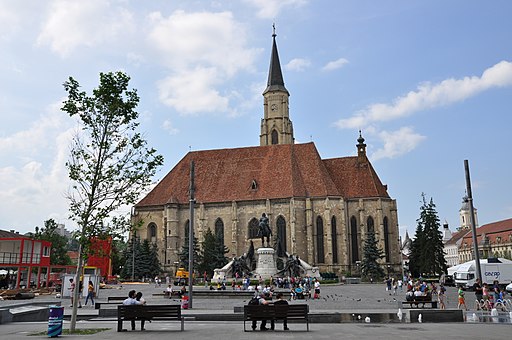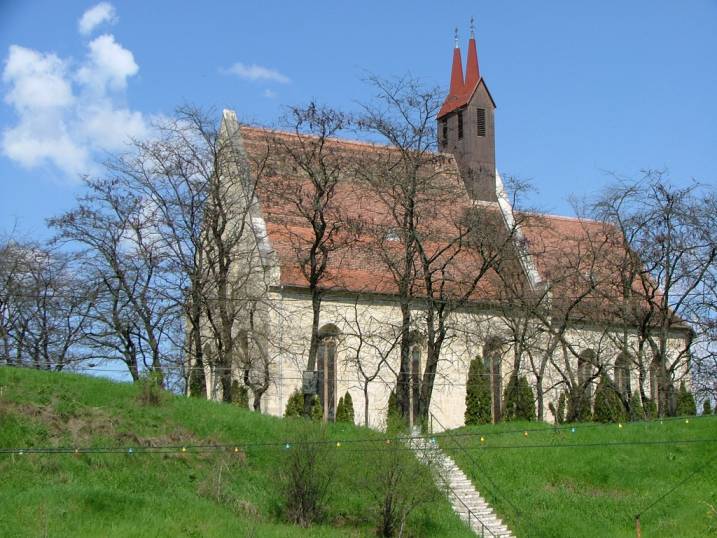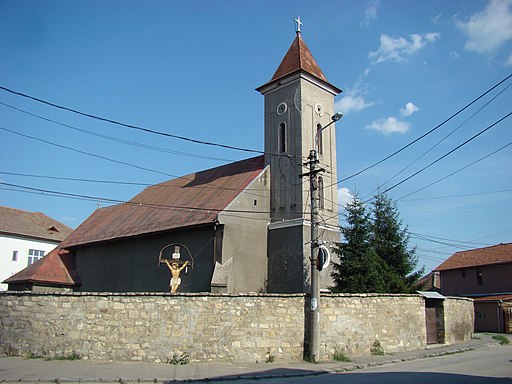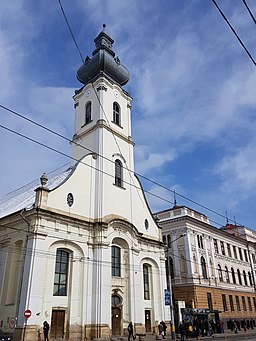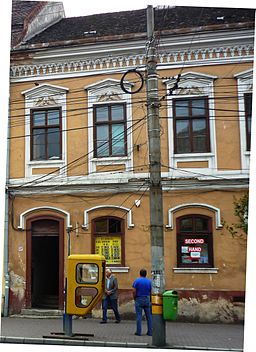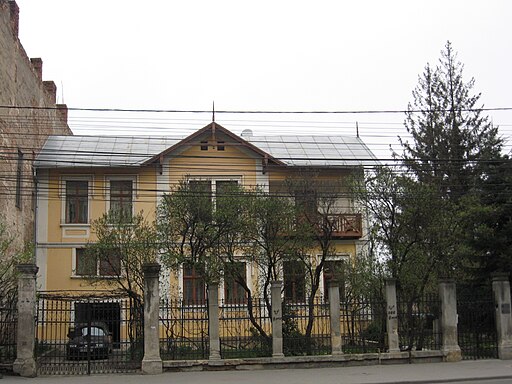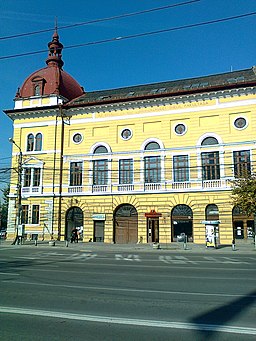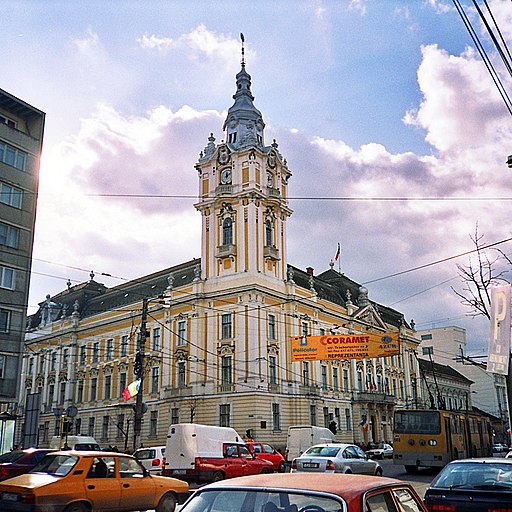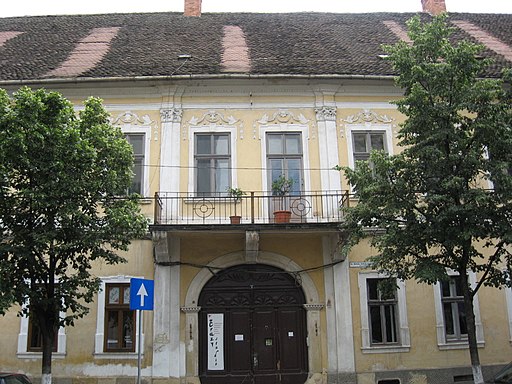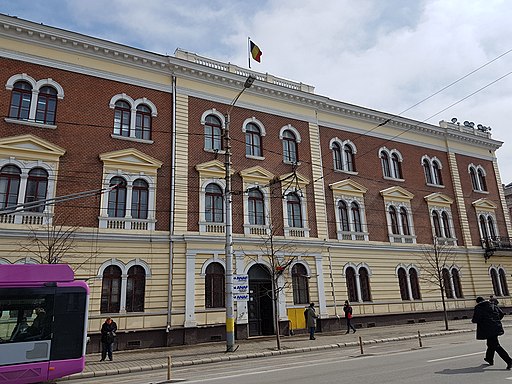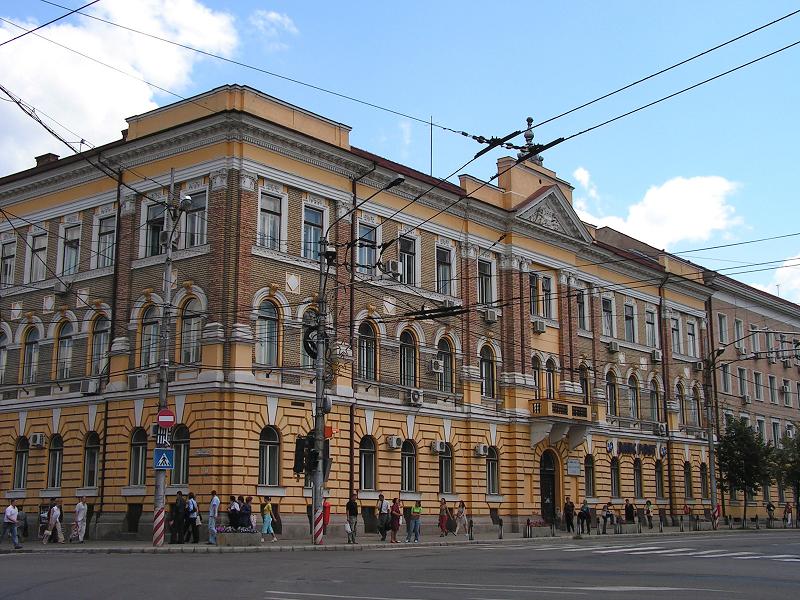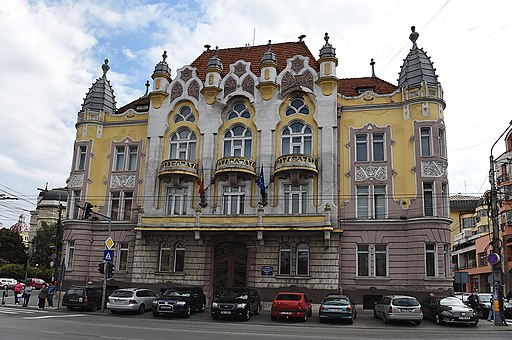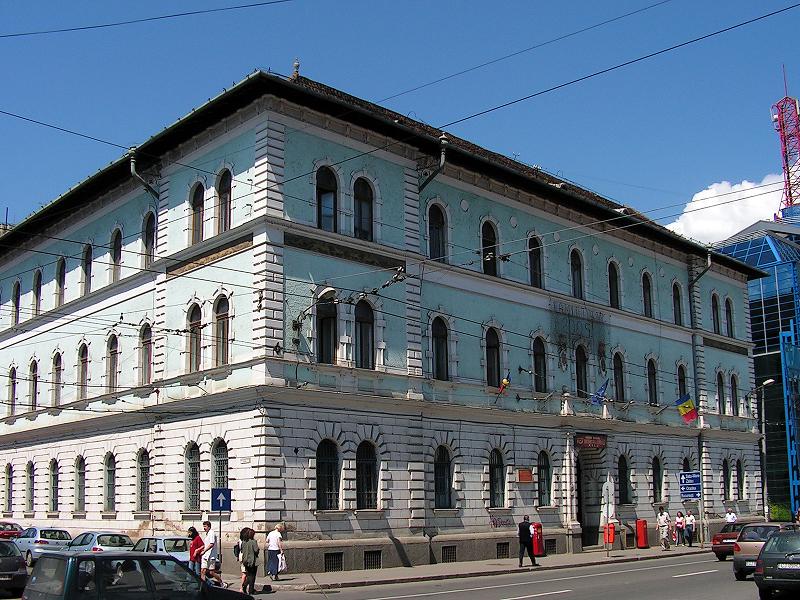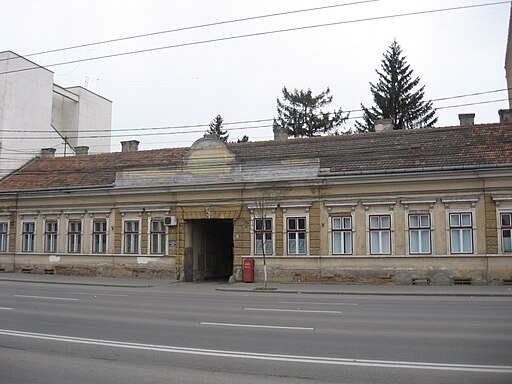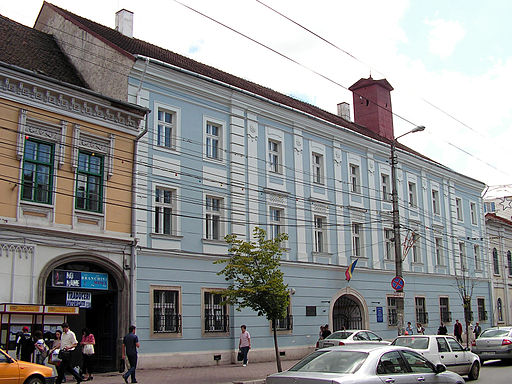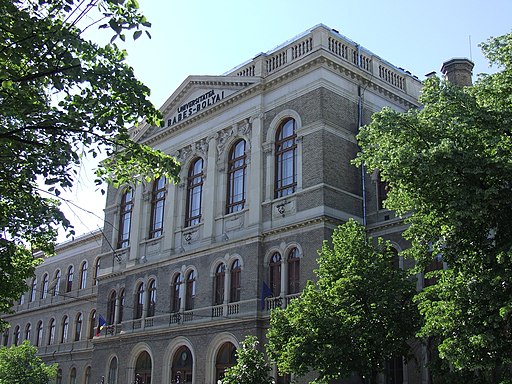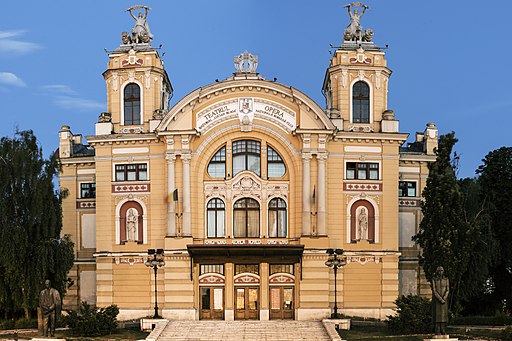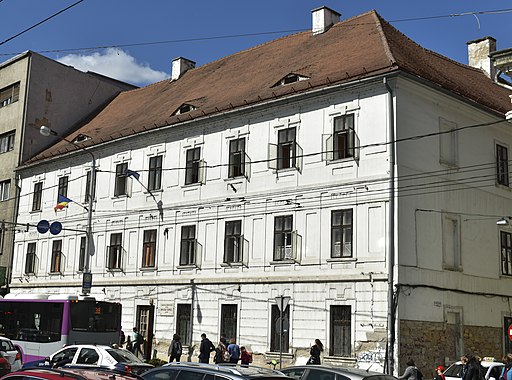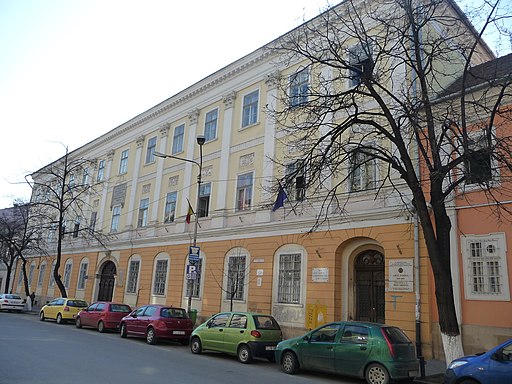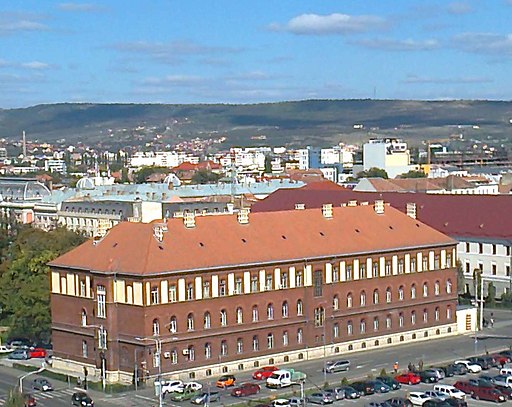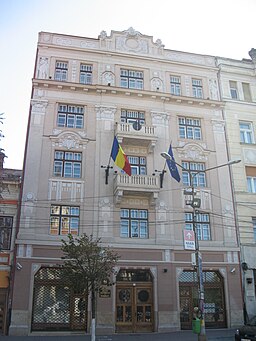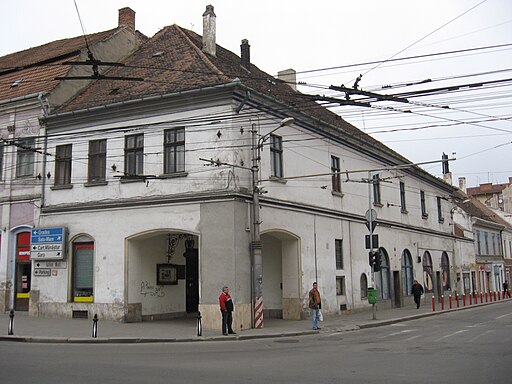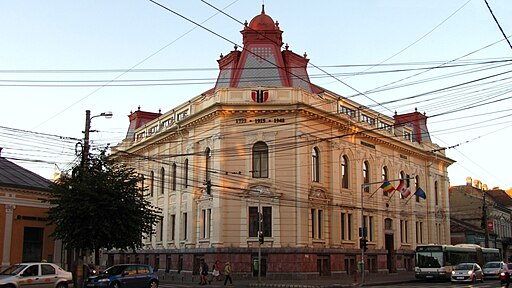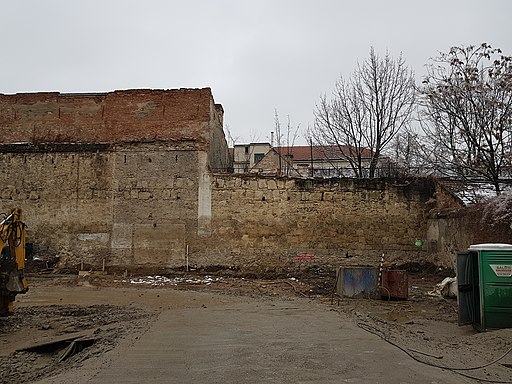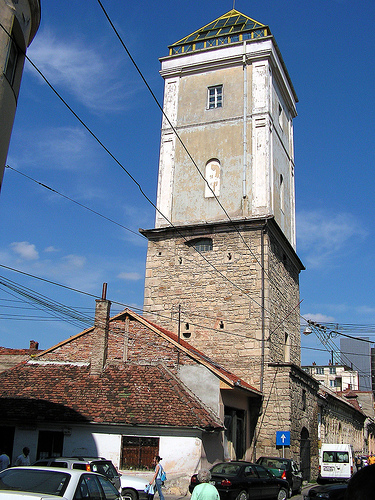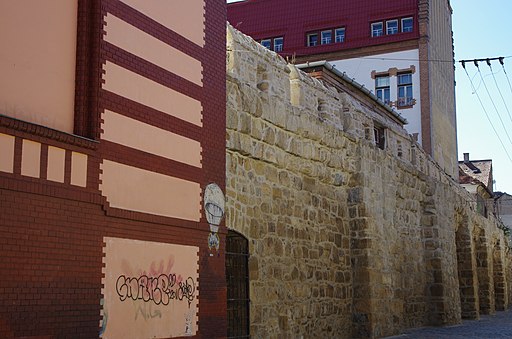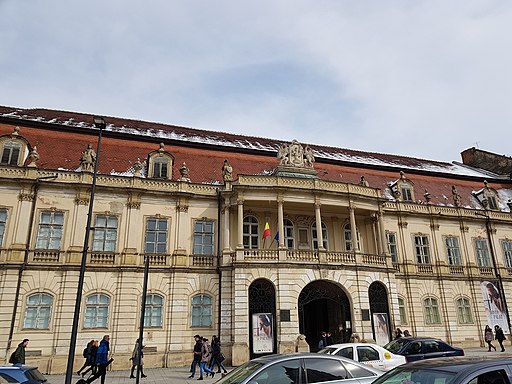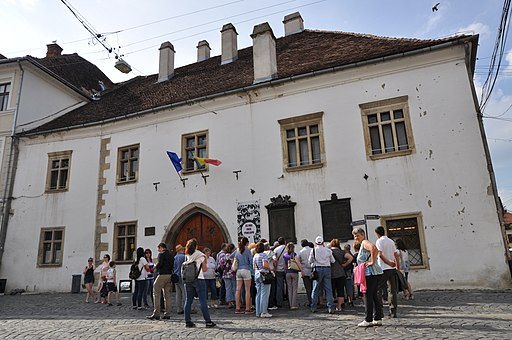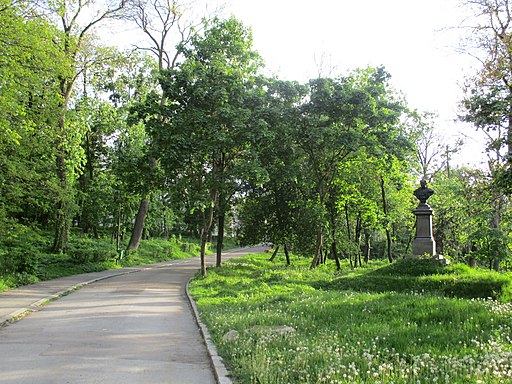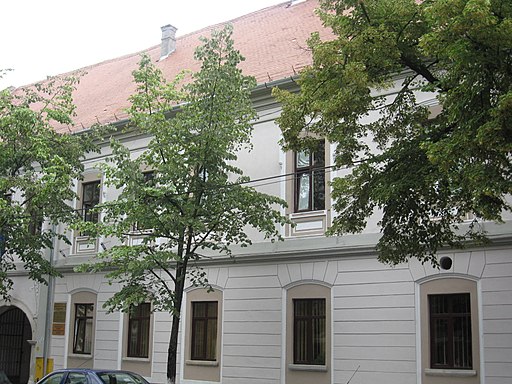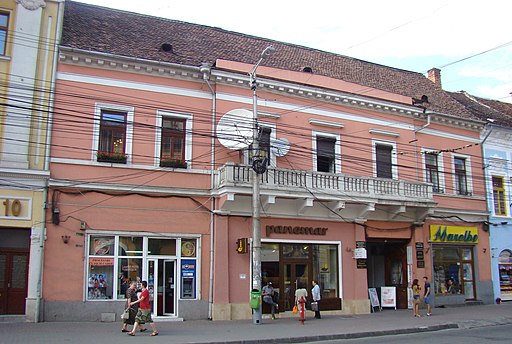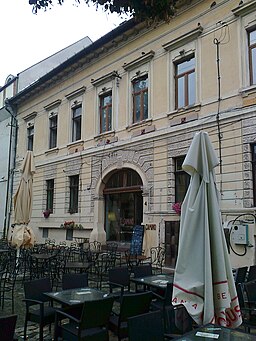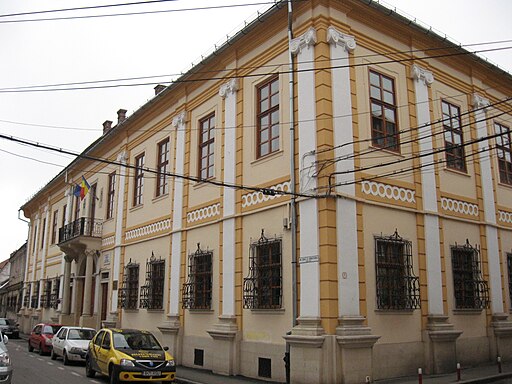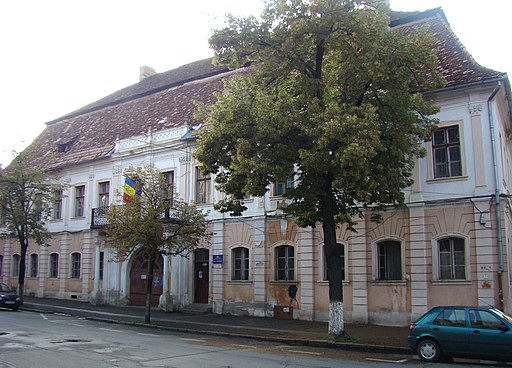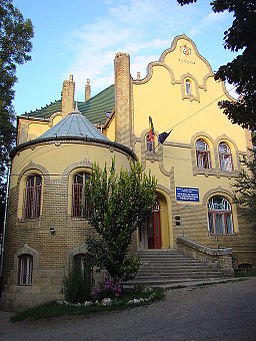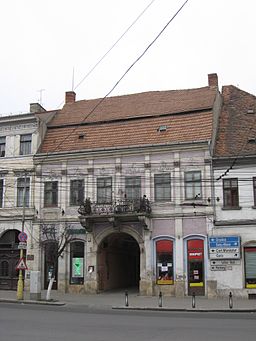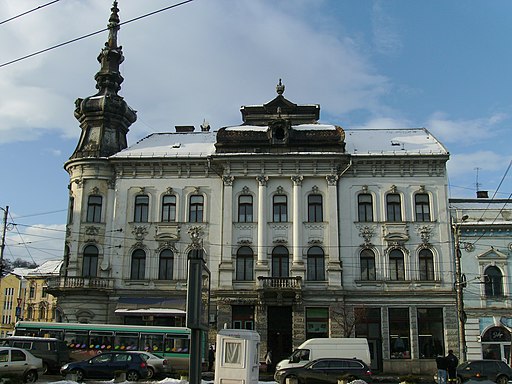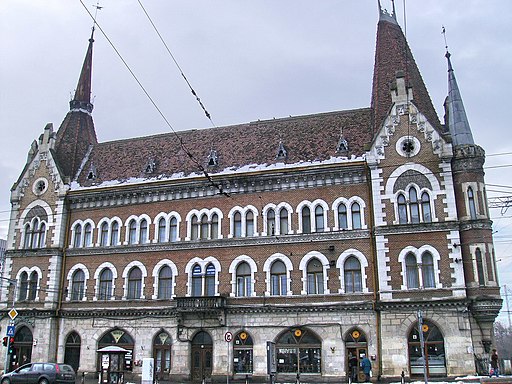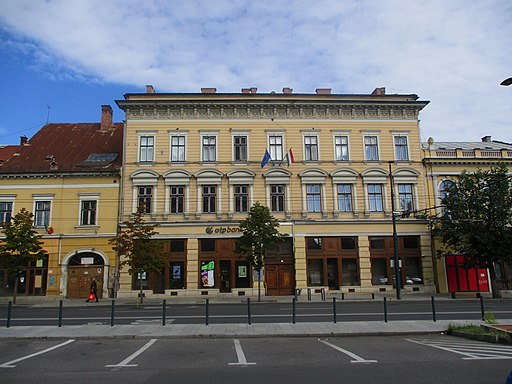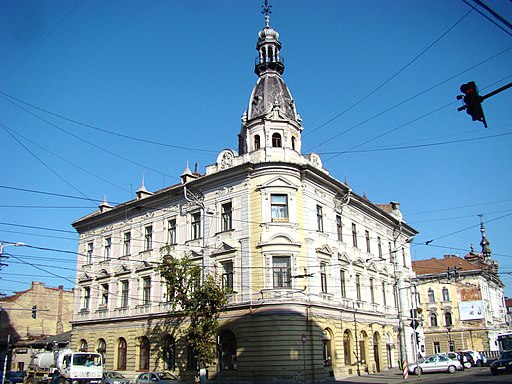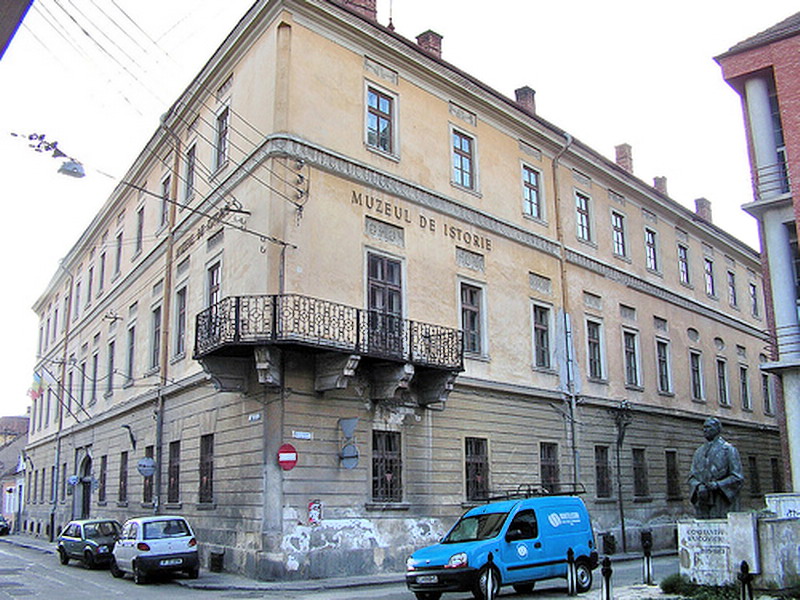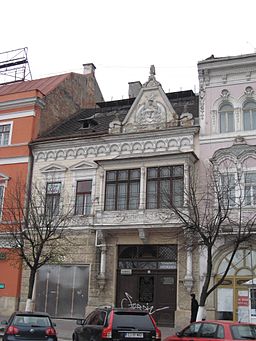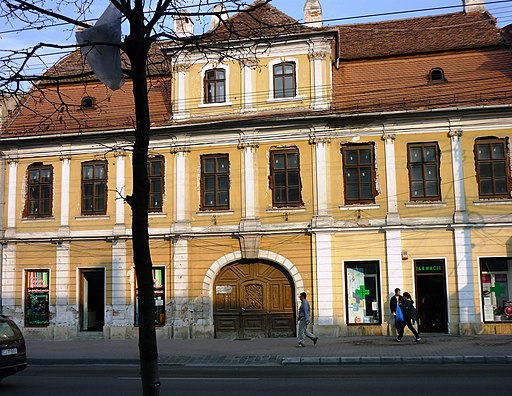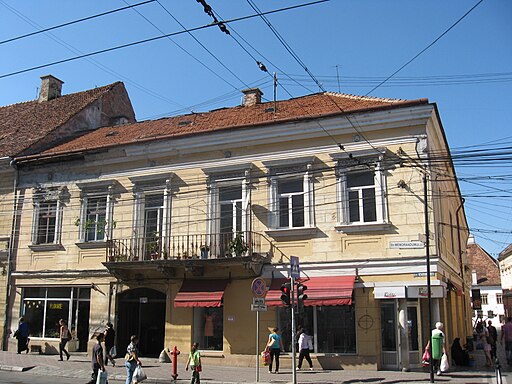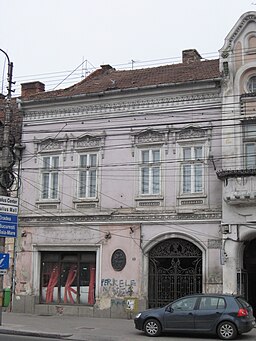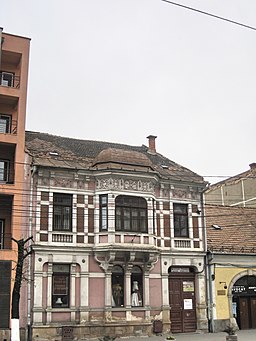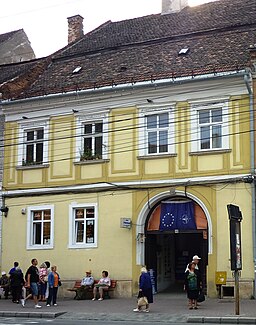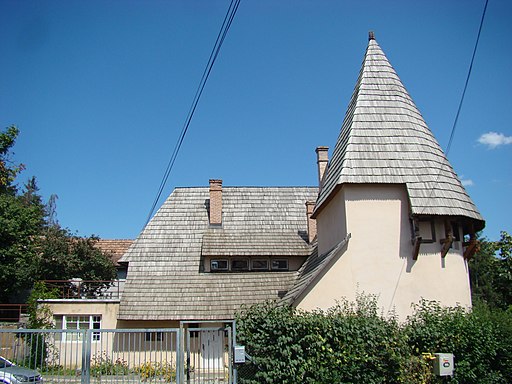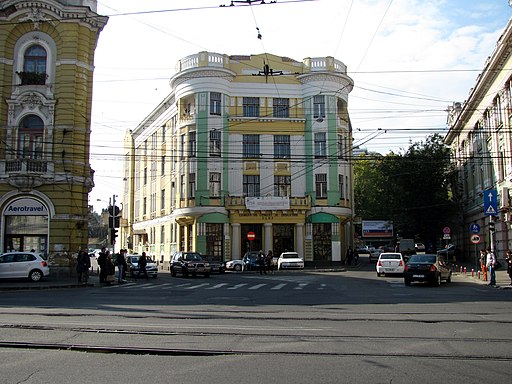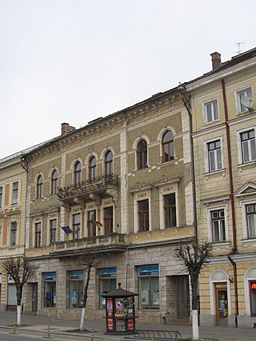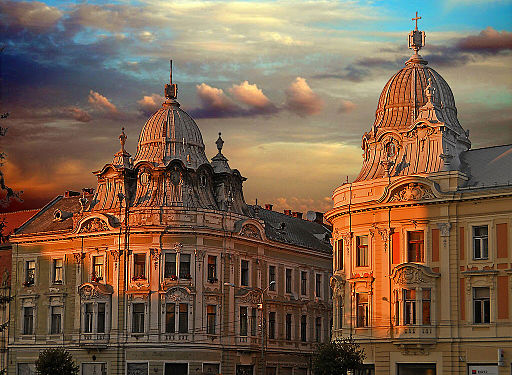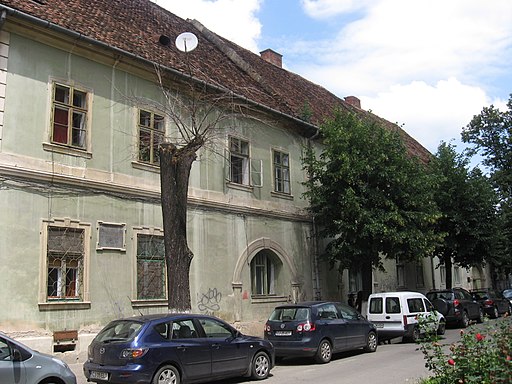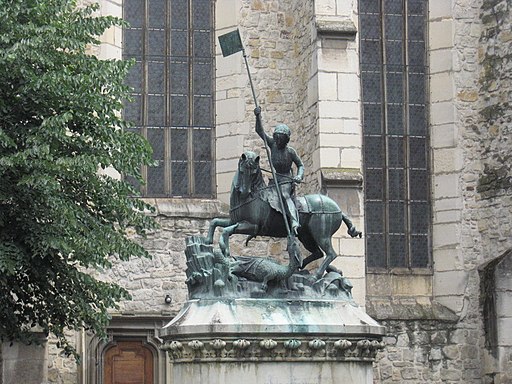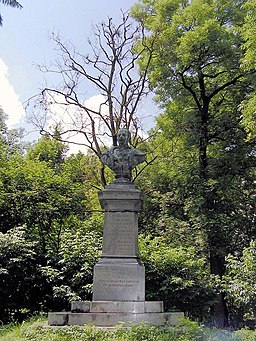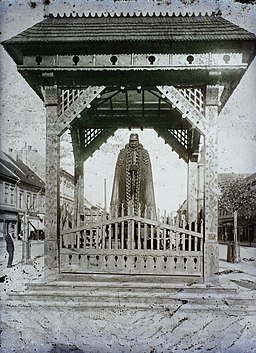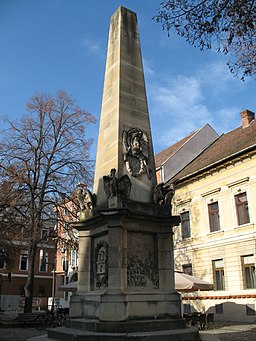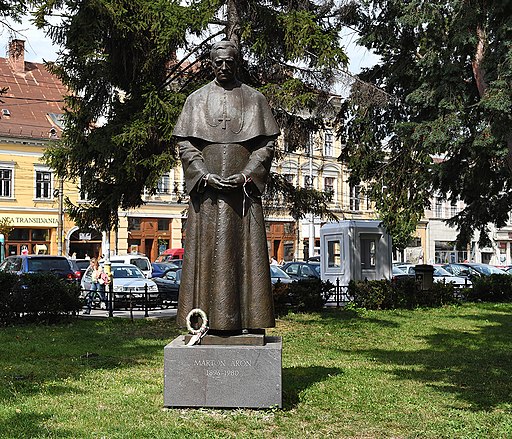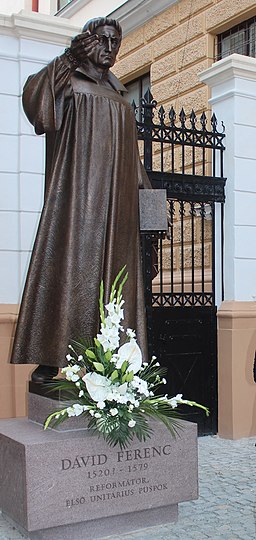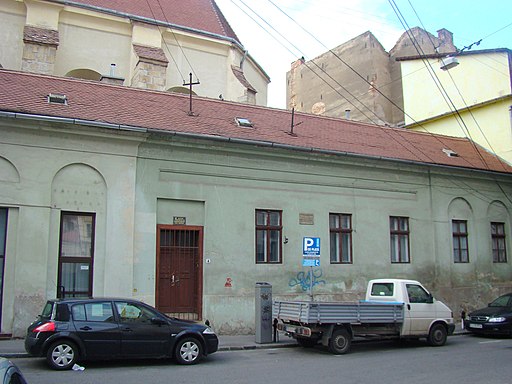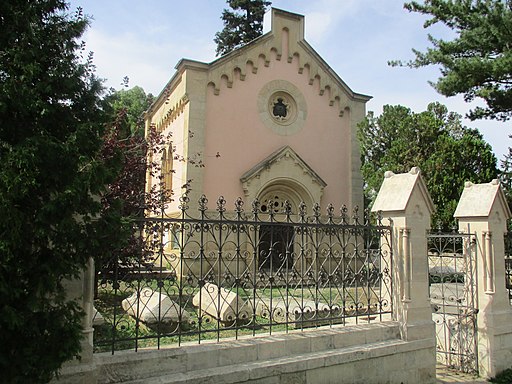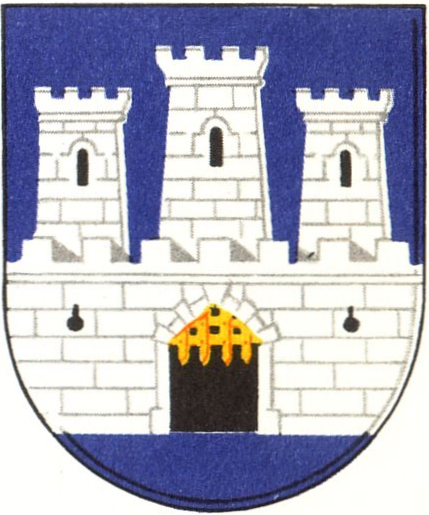Kolozsvár
Historical Hungarian county:
Kolozs
GPS coordinates:
46.769481, 23.590177
Population
Population in 1910
| Total |
60808 |
| Hungarian |
83.38% |
| German |
2.76% |
| Vlach |
12.44% |
Kolozsvár was founded by Hungarians in the 11th century and was made a county seat by St Stephen of Hungary. In the mid-13th century, Saxons settled in Kolozsvár. It received its town privileges from King Charles I of Hungary in 1316 for helping the monarch to defeat the oligarch Kán László, who ruled Transylvania. The church of St. Michael was also built at this time. In 1405, King Sigismund of Hungary made Kolozsvár a free royal town and allowed it to be surrounded by walls to deal with the Turkish threat. In the 15th century the population of the town was half Hungarian and half Saxon. The town was the birthplace of two prominent figures in Hungarian history, King Matthias in 1443 and Bocskai István in 1557, who later became Prince of Transylvania and Hungary. It was during the period of the Principality of Transylvania that Kolozsvár became a truly important city, from which the appellation 'Treasure Kolozsvár' derives. Although the capitol of the Principality was always Gyulafehérvár, the first city (civitas primaria) of the Principality was Kolozsvár, where many Diets were held. After the defeat of the 1703-1711 Hungarian War of Independence led by Prince Rákóczi Ferenc II, the Austrians built a citadel near the city, despite the protests of the inhabitants. It became the capital of Transylvania in 1790, when the Government moved here from Nagyszeben. It was here that the Transylvanian Diet declared reunification with Hungary in 1848 and again in 1865. Its status as a capital was effectively abolished with the 1867 Austro-Hungarian Compromise, when Transylvania was actually reunited with Hungary after 297 years. In 1902, the statue of King Matthias made by Fadrusz János was unveiled in the Main Square. In December 1918, the Hungarian population of 26 counties protested here against the annexation to Romania. The town was still Hungarian-majority in the 1950s, but gradually became Romanian-majority as a result of the massive settlements.
Check out other towns in Hungary as well!
895
Arrival of the Hungarians
Little more...
895
The alliance of the seven Hungarian tribes took possession of the then largely uninhabited Carpathian Basin. Until then, the sparse Slavic population of the north-western Carpathians had lived under Moravian rule for a few decades after the collapse of the Avar Khaganate in the early 9th century.
after 895
Hungarians settled down in the area.
1000
Foundation of the Hungarian Kingdom
Little more...
1000
The Kingdom of Hungary was established with the coronation of King Stephen I. He converted the Hungarians to Christianity and created two archdioceses (Esztergom and Kalocsa) and ten dioceses. He divided Hungary into counties led by ispáns, who were appointed by the king.
1000
King Stephen I of Hungary established Kolozs County and Kolozsvár became its seat.
first half of the 11th century
The town evolved at that time. Its castle was located in the north-eastern part of today's downtown, one of its towers still stand.
late 11th century
King László I of Hungary established the Benedictine Abbey of Kolozsmonostor. Because the abbey was directly under the authority of the Archbishop of Esztergom, the bishops of Transylvania attacked and plundered it several times. The church was destroyed in the Mongol invasion. The abbey became a place of authentication (providing notarial services) around 1288.
1213
The town was mentioned for the first time by the name de castro Clus.
1241-1242
Mongol Invasion
Little more...
1241-1242
The hordes of the Mongol Empire invaded Hungary and almost completely destroyed it. One third to one half of the population was destroyed. The Mongols also suffered heavy losses in the battle of Muhi and they could not hunt down the king. After their withdrawal, King Béla IV reorganized Hungary. He allowed the feudal lords to build stone castles because they were able to successfully resist the nomadic Mongols. The vast majority of stone castles were built after this. The king called in German, Vlach (Romanian) and Slavic settlers to replace the destroyed population.
1241
The Mongols sacked the town. The Old Castle was built subsequently.
1257
The settlement was mentioned by the name Kulusuar for the first time. According to the linguistics, the town's name comes from a personal name. It is likely that the son of King Béla IV of Hungary, Stephen younger king (later King Stephen V) brought Saxons to the town.
1270-72
King Stephen V of Hungary put the castle and the village under the authority of the Bishop of Transylvania.
1275
King László IV confirmed the authority of the Bishop of Transylvania over the settlement.
1301
The extinction of the House of Árpád
Little more...
1301
The House of Árpád, the first Hungarian royal dynasty, died out with the death of King Andrew III. Hungary was ruled by oligarchs, the most powerful of whom was Csák Máté, whose main ally was the Aba family. King Charles I (1308-1342), supported by the Pope, eventually emerged as the most prominent of the contenders for the Hungarian throne. But it took decades to break the power of the oligarchs.
1316
King Charles I of Hungary granted Kolozsvár town status because its inhabitants helped him to defeat the oligarch Kán László. The town gained right to elect its own judge and priest and also exemption from duty for the territory of entire country. The construction of St. Michael's church began.
1331
Kolozsvár was removed from the authority of the vajda of Transylvania.
1366
A hospital was established from the donation of King Louis I of Hungary.
1373
The Kolozsvári brothers, Márton and György made the bronze equestrian statue of St. George Szent, which has been standing in the castle of Prague since 1428. Its copy can be seen in Kolozsvár since 1904.
1390
The Dominican Order settled down in Kolozsvár.
July 2, 1405
Kolozsvár became a free royal town thanks to King Sigismund of Hungary. The king granted its burghers all the privileges of the burghers of Buda, which included staple right as well. The king also allowed the town to be surrounded with walls, towers, bastions, moats and other defences with regard to the Turkish threat. The fortification of the town quarter called Óvár (Old Castle) started. The constructions continued during the reign of King László V and finished under King Matthias of Hungary. The 3 kilometres long town wall was made ready by the late 1470's. Some of the walls of Óvár were preserved and incorporated into the new town wall.
1437
Kolozsvár opened its gates for the peasant army of Budai Nagy Antal and its burghers also took part in the uprising. They looted the Abbey of Kolozsmonostor, but they were defeated in the decisive battle near Kolozsvár on 10-14 December.
January 8, 1438
Kolazsvár was captured from the rebels and the uprising was quelled.
1438
The town lost all its privileges because of its participation in the uprising.
February 23, 1443
Hunyadi Mátyás (later King Matthias of Hungary) was born in Kolozsvár.
around 1444
The construction of St. Michael's church was finished. King Ulászló I of Hungary gave back the town's privileges.
1446
The coin mint and gold changer of Kolozsvár was mentioned for the first time.
1458
Half the population was Hungarian and half was Saxon. According to the decree of Governor Szilágyi Mihály of Hungary, the governing body of the town, the council of hundred men (centumvirátus), consisted of 50 Hungarian and 50 Saxon men, and the judge was elected every year alternately from the two nations. Most of the burghers were craftsmen organized in guilds. There was also a small, but strong group of traders.
1466
The country assembly of Hungary took place in Kolozsvár for the first time. More than 70 country assemblies were held in the town.
January 19, 1468
The leaders of the plot against King Matthias were executed on the main square.
1470
The town wall was finished. In the 15th century 20 guilds were already in operation in the town. The strongest and most influential of all was the Butcher's Guild. They protected the main gate of the town and they maintained the largest bastion, the Butcher's Tower, which could host 16 canons.
around 1480
The construction of St. Michael's church was completed.
1506
Kolozsvár was granted right to hold fairs freely.
1514
The peasant army of the priest Lőrinc was defeated by the army of the nobility here. Lőrinc was burned on the main square at the end of July.
1526
Battle of Mohács and the splitting of Hungary into two parts
Little more...
1526
Sultan Suleiman I launched a war against Vienna, instigated by the French. Ferdinand I, Duke of Austria, was the brother-in-law of King Louis II of Hungary. The army of the Ottoman Empire defeated the much smaller Hungarian army at Mohács, and King Louis II died in the battle. A group of the barons elected Ferdinand I of the House of Habsburg to the throne, who promised to defend Hungary from the Turks. He was the younger brother of the most powerful European monarch Emperor Charles V. But the nobility chose the most powerful Hungarian baron, Szapolyai János, who was also crowned as King John I. The country was split in two and a decades-long struggle for power began.
September 18, 1538
King John I of Hungary held a country assembly in the town.
1541
The Turkish occupation of the capital, Buda, and the division of Hungary into three parts
Little more...
1541
The Turks conquered Buda, the capital of Hungary, after the death of King John I. The central part of the country was under Turkish rule for 150 years. The western and northern parts (including present-day Slovakia) formed the Kingdom of Hungary ruled by the Habsburg emperors. The eastern parts (now mainly under Romanian rule) were ruled by the successors of King John I of Hungary, who later established the Principality of Transylvania.
1541
Kolozsvár became part of the Eastern Hungarian Kingdom, which was transformed to the Principality of Transylvania in 1570. This boosted the town's development, and the appellation Kincses Kolozsvár (Treasure Kolozsvár) comes from this era. Although the capitol of the Principality was Gyulafehérvár, Kolozsvár hosted 37 country assemblies during its existance and it became its prime city (civitas primaria).
1550
Heltai Gáspár and Hoffgreff György established a printing house in the town. This marks the beginning of the Hungarian language book printing.
1551
The child John Sigismund's guardian, George Martinuzzi, with Castaldo's imperial army, forced Queen Isabella to surrender the Eastern Hungarian Kingdom (including Transylvania) to King Ferdinand I. Isabella left for Poland with her child, the heir to the throne. The Turks then launched a punitive campaign against Hungary.
June 4, 1551
Imperial forces marched into Kolozsvár and Queen Isabella handed over the crown to General Castaldo (according to the report of Castaldo, this event took place in Torda).
July 11, 1552
The mercenary army of General Castaldo revolted and set Kolozsvár on fire.
July 27, 1553
The imperial mercenaries left the town after having looted it.
1556
The Estates of Transylvania, dissatisfied with Habsburg rule, recalled Queen Isabella to the throne, to which the Sultan gave his consent. On her return, she regained control of eastern Hungary.
April 26, 1556
Influenced by Protestantism, the country assembly in Kolozsvár decided on the confiscation of church properties. The Abbey of Kolozsmonostor ceased to function.
October 23, 1556
The Estates of Transylvania received Queen Isabella returning from Poland.
November 25, 1556
In Kolozsvár the Estates of Transylvania accepted John II as their ruler and his mother, Queen Isabella, as governor for 5 years until his coming of age.
January 1, 1557
Bocskai István was born in Kolozsvár. He later became Prince of Transylvania and of Hungary. Bocskai's birthplace is just a few steps away from the birthplace of King Matthias.
middle of the 16th century
Reformation gained significant influence in the town.
January 6-13, 1568
In Torda, the country assembly of Transylvania was the first in the world to declare the freedom of religion and conscience. The Antitrinitarian (later Unitarian) Church was established with the leadership of Dávid Ferenc. In the subsequent synod of Gyulafehérvár, Dávid Ferenc was considered victorious and even the ruler, John II converted to the Unitarian faith. Dávid Ferenc returned to Kolozsvár, converted the entire town to his faith and became the first bishop of his church. The town rapidly became Hungarian and even the Saxon priests were working on boosting Hungarian intellectual life. An outstanding person of this movement was Heltai Gáspár, the Unitarian pastor of Kolozsvár. The town is still the centre of Unitarism.
1570
The establishment of the Principality of Transylvania
Little more...
1570
John II (John Sigismund), the son of King John I of Hungary, renounced the title of King of Hungary in favor of King Maximilian of the House of Habsburg, and henceforth held the title of Prince. This formally created the Principality of Transylvania, which was the eastern half of Hungary not ruled by the Habsburgs and was also a vassal of the Ottoman Empire. John II died in 1571, after which the three nations of Transylvania (the Hungarian nobility, the Székelys and the Saxons) elected the prince.
1574
Plague devastated the town.
August 8, 1575
Prince Báthory István of Transylvania had the leaders of movement of Bekes Gáspár, a pretender to the throne of Transylvania, executed on the main square.
1579
Prince Báthory István of Transylvania and King of Poland established a Jesuit school in the building of the former Abbey of Kolozsmonostor.
1581
Prince Báthory István of Transylvania moved the Jesuit school to Kolozsvár and converted it to a university. In 1582 Pope Gregory XIII confirmed the establishment of the university.
1581
Báthory Kristóf had the walls of Óvár facing towards the town demolished. The new town wall was irregular shaped and had 18 towers and 4 bastions. The towers were square shaped with two to four storeys and the bastions were semi-circular. Stone stairs with wooden railings led to the top of the wall, and a wooden protective corridor (a wall-walk) run along the inner side of the top of the wall. Each tower was owned, maintained and defended by a guild.
1585-1586
Plague decimated the population.
1591-1606
Fifteen Years' War
Little more...
1591-1606
The Ottoman Empire started a war against the Habsburg Empire. The war was waged in the territory of Hungary. The Turks defeated the combined armies of the Habsburg Empire and the Principality of Transylvania in the battle of Mezőkeresztes in 1596, but their victory was not decisive. The war devastated the Principality of Transylvania, which was occupied by the Habsburg army, and General Basta introduced a reign of terror.
August 31, 1594
Prince Báthory Zsigmond of Transylvania had the rebellious nobles, who wanted to prevent him from handing Transylvania over to the Habsburg emperor, beheaded in Kolozsvár.
October 17, 1599
Instigated by Emperor Rudolf, Voivode Mihai (Viteazul) of Wallachia broke into Transylvania through the Bodza Pass, after Prince Báthory Zsigmond, contrary to his promise, hand over power over Transylvania to his cousin Cardinal Báthory András instead of Emperor Rudolf. Voivode Mihai sided with the Székelys, who were dissatisfied with the Báthory dynasty, by promising to restore their rights, and with their help he defeated the army of Prince Báthory András at Sellenberk on 28 October.
November 1, 1599
Voivode Mihai Viteazul of Wallachia marched into Gyulafehérvár, the capitol of Transylvania, and took over power as governor appointed by Emperor Rudolf. But soon he started to act on his own behalf and introduced a reign of terror. He arbitrarily appointed Wallachian boyars to every position, looted the treasury and his unpaid mercenaries plundered and murdered throughout the land. The Vlach peasants rose up and started to exterminate Hungarian and Saxon population in Transylvania, which had a Hungarian majority at that time.
September 18, 1600
Voivode Mihai of Wallachia was defeated in the battle of Miriszló and driven out by the combined armies of the Transylvanian nobility led by Báthory Zsigmond and General Basta’s imperial mercenaries. At the beginning of next year, the Estates of Transylvanian broke with the Emperor and Báthory Zsigmond was elected prince once more.
April 3, 1601
After the Estates of Transylvania ended the Wallachian usurper Mihai Viteazul's reign of terror with the assistance of General Basta, the country assembly elected Báthori Zsigmond Prince of Transylvania for the second time in Kolozsvár. During the reign of the Báthory family, the town's defences, which have been neglected since the death of King Matthias of Hungary, were repaired and reinforced. The Bridge Gate tower (Hídkapu-torony), the Monastery Gate (Monostori-kapu) and the towers of the Middle Gate (Közép-kapu) were rebuilt.
August 3, 1601
The combined armies of General Basta and Voivode Mihai of Wallachia defeated the Transylvanian army of Prince Báthory Zsigmond in the battle of Goroszló. After that, the army of Voivode Mihai sacked and burned the towns of Torda, Nagyenyed and Gyulafehérvár, where they robbed the tombs of the Hunyadi family, King John II of Hungary and his mother Queen Isabella. Then, on 19 August, Voivode Mihai was assassinated by the mercenaries of General Basta, because Mihai tried to usurp the throne of Transylvania once again. Genral Basta also introduced a reign of terror in Transylvania and let his mercenaries ravage freely throughout the land.
July 2, 1602
General Giorgio Basta defeated the army of Székely Mózes at Tövis. Székely Mózes became the leader of the Transylvanian uprising against the Habsburg Empire after the battle of Goroszló.
1603
General Basta left Transylvania with his imperial army. Székely Mózes set out from Temesvár with Székely and Turkish armies to liberate Transylvania. The estates of Transylvania, having enough of Basta’s terror, welcomed him in Gyulafehérvár and elected him Prince of Transylvania on 9 May.
June 9, 1603
Prince Székely Mózes of Transylvania marched into Kolozsvár as soon as the German mercenaries left. The Hungarian inhabitants greeted the Prince and his army with delight. Being overjoyed, they even chased the Jesuits away, which sorrowfully put an end to the Hungarian university established by Prince Báthory István.
middle of June, 1603
Prince Székely Mózes of Transylvania minted strong coins in Kolozsvár, which are among the most beautiful coins minted by the Principality of Transylvania.
17 July, 1603
Mobilized by the Habsburgs, Voivode Radu Serban of Wallachia attacked the camp of Székely Mózes at Brassó at night. The Prince was killed and General Basta returned to Transylvania.
1604-1606
Uprising of Bocskai István
Little more...
1604-1606
The alliance of the Habsburgs and the Principality of Transylvania was defeated by the Ottoman Empire in the Fifteen Years' War. The war devastated Transylvania, which was occupied by the Habsburg imperial army, and General Basta introduced a reign of terror. The nobility and the burghers were upset about the terror, the plundering mercenaries and the violent Counter-Reformation. Bocskai István decided to lead their uprising after the Habsburg emperor tried to confiscate his estates. Bocskai also rallied the hajdú warriors to his side. He was elected Prince of Transylvania and soon liberated the Kingdom of Hungary from the Habsburgs. In 1605 Bocskai István was crowned King of Hungary with the crown he received from the Turks.
23 June 1606
Peace of Vienna
Little more...
23 June 1606
Bocski István made peace with Emperor Rudolf. Their agreement secured the constitutional rights of the Estates of Hungary, and the freedom of religion. The counties of Szatmár, Bereg and Ugocsa were annexed to the Principality of Transylvania. Bocskai died of illness in the same year, leaving to his successors the idea of unifying Hungary from Transylvania.
October 23, 1613
Bethlen Gábor was elected Prince of Transylvania in Kolozsvár.
1618-19, 1622-23
Plague decimated the population.
1619
The campaign of Prince Bethlen Gábor of Transylvania in the Thirty Years' War
Little more...
1619
At the beginning of the Thirty Years' War (1618-1648), Prince Bethlen Gábor of Transylvania went to war against the Habsburg emperor as an ally of the rebelling Czech-Moravian-Austrian estates. The whole Kingdom of Hungary joined him, only the Austrian defenders of Pozsony had to be put to the sword. With his allies, he laid siege to Vienna. However, he was forced to abandon the siege because the Habsburg-loyal Hungarian aristocrat Homonnai Drugeth György attacked his heartland with Polish mercenaries. On 25 August 1620, the Diet of Besztercebánya elected Bethlen Gábor King of Hungary as vassal of the Turks. He continued to fight after the defeat of the Czechs at White Mountain on 8 November 1620, but without real chance to achieve decisive victory, he decided to come to an agreement with Emperor Ferdinand II.
31 December 1621
Peace of Nikolsburg
Little more...
31 December 1621
Prince Bethlen Gábor of Transylvania made peace with Emperor Ferdinand II. Their agreement secured the constitutional rights of the Estates of Hungary, and later it was supplemented with the freedom of religion. Bethlen renounced the title of King of Hungary in exchange for seven counties of the Upper Tisza region (Szabolcs, Szatmár, Bereg, Ugocsa, Zemplén, Borsod, Abaúj) for the rest of his life, other estates in Hungary as his private property and the imperial title of Duke of Oppeln and Ratibor (Opole and Racibórz), one of the Duchies of Silesia. Prince Bethlen went to war against the Habsburgs in 1623 and 1626, but was unable to negotiate more favourable terms.
June 18, 1623
Prince Bethlen Gábor issued a diploma in Kolozsvár, which allowed the Jews to settle in Transylvania and also to trade freely and practice their religion. He even relieved them of wearing the common distinctive sign of the Jews.
1627
The tower at the south-eastern corner of the town used for storing gunpowder exploded due to a lightning strike. Prince Bethlen Gábor had it rebuilt by 1629 and it was named after him. This square shaped bastion, together with the Middle Gate not far to the north and the adjacent walls, was the strongest section of the town wall. The Bethlen Bastion is also the best preserved part of the medieval defences. Bethlen Gábor reconstructed the church of St. Michael as well.
1630 – 1648
During the reign of Prince Rákóczi György I of Transylvania, the town walls and bastions were repaired and aristocratic buildings were constructed in the town. Prince Rákóczi György II also took great care of the maintenance of the town's defences.
1644-1645
The campaign of Prince Rákóczi György I of Transylvania in the Thirty Years' War
Little more...
1644-1645
Prince Rákóczi György I of Transylvania allied with the Swedes and the French in the Thirty Years' War and went to war against the Habsburg Emperor Ferdinand III. On 18 July 1645 his army joined forces with Torstenson's Swedish army under Brno (Moravia). The excellent artillery of Transylvania opened fire on the city walls. However, Rákóczi had to give up the siege, having been informed that the Turks were planning a punitive campaign against Transylvania, because he went to war against the Sultan's prohibition.
16 December 1645
Peace of Linz
Little more...
16 December 1645
Prince Rákóczi György I of Transylvania made peace with Emperor Ferdinand III. It secured the freedom of religion for the Protestants and extended it also to the serfs. Rákóczi received the same seven Hungarian counties that Prince Bethlen Gábor had also held (Abauj, Zemplén, Borsod, Bereg, Ugocsa, Szabolcs, Szatmár) until his death, and the counties of Szabolcs and Szatmár were also to be inherited by his sons. The Rákóczi family also received several new estates.
1655
Fire destroyed most of the town.
1657-59
The town renovated the walls and the bastions.
1657
Prince Rákóczi György II of Transylvania launched a campaign for the crown of Poland in alliance with Carl X Gustaf of Sweden. His aim was to unite the Hungarian-Polish-Wallachian forces against the Turks. The campaign started successfully with the prince taking Kraków and Warsawa, but then the King of Sweden abandoned him. The vengeful Poles invaded northern Transylvania, burning defenceless villages, destroying churches and castles. Soon the punitive campaign of Turkish and Tatar armies devastated Transylvania, as the prince launched his Polish campaign against the Sultan's will.
September 1658
The Turks encircled the town, looted the neighbourhood and forced the town to pay a large tribute.
1658
The Tartars ravaged and plundered throughout Transylvania and Grand Vizier Köprülü Mehmed captured Jenő Castle. The Estates of Transylvania sent Barcsay Ákos to the camp of the grand vizier to beg for mercy. In return, the Grand Vizier demanded that the annual tax be raised from 15 to 40 thousand forints (gold coins) and that Lugos and Karansebes be ceded. This was the price for the Turks to leave Transylvania. The grand vizier appointed Barcsay prince on 14 September.
1659
Prince Rákóczi György II returned to Transylvania and forced Barcsay Ákos to retreat to Szeben and besieged him.
May 22, 1660
In the battle of Sászfenes, Pasha Shejdi Ahmed of Buda defeated Rákóczi György II, who lost his life. The Tatar armies invaded Transylvania for the second time.
1660
Town judge Linczigh János saved Kolozsvár from the Turks. Pasha Seydi Ahmet of Buda appeared before the gates of the town during his campaign to remove Prince Rákóczi György II from the throne of Transylvania. The judge visited the Turkish camp with two companions. The pasha sent Linczigh back to the town's gate in the company of 50 janissaries to open it. But the judge shouted to the guards ordering them not to open the gate. The pasha sent the judge back to the gate three more times, when finally the judge told the guards that he had to die, but they must not open the gate for the Turks, but they should pay tribute to the grand vizier to reconcile him. The pasha then gave mercy to the judge and allowed him to return to Kolozsvár.
November 1660
Kemény János, the former commander of Rákóczi György II, defeated the army of Gáspár, the brother of Prince Barcsay András, at Örményes. Barcsay Gáspár fell in the battle. Then, on 31 December, Barcsay Ákos renounced the throne. In 1661 Kemény János had Barcsay Ákos captured and murdered.
1661
The army of Pasha Seydi Ahmed of Buda marched into Transylvania, after the country assembly held in Beszterce on 23 April declared the independence of Transylvania from the Ottoman Empire and placed the country under the protection of Emperor Leopold I. On 14 September, Pasha Ali forced the country assembly to elect Apafi Mihály Prince of Transylvania in Marosvásárhely.
September 17, 1661
Prince Kemény János of Transylvania occupied the town with the help of the imperial army and placed a German garrison in it.
January 23, 1662
The deposed prince Kemény János, having been abandoned by his imperial allies, was defeated by the Turks at Nagyszőlős (near Segesvár), where he fell.
1662
Prince Apafi Mihály of Transylvania besieged Kolozsvár with the army of Bey Kücsük Mehmed of Jenő. The siege ended with the armistice signed with the agents of Emperor Leopold I.
January 1664
The unpaid German garrison revolted and switched to the side of Prince Apafy Mihály of Transylvania. Kolozsvár was put under the authority of the ispán of Kolozs County. The town temporarily lost its municipality and it became possible for the nobility to settle in the town.
1683
Turkish defeat at Vienna and the formation of the Holy League
Little more...
1683
The combined armies of the Habsburg Empire and the Kingdom of Poland defeated the Turkish army besieging Vienna. Emperor Leopold I wanted to make peace with the Turks, but was refused by Sultan Mehmed IV. In 1684, at the persistent urging of Pope Innocent XI, the Holy League, an alliance of the Kingdom of Poland, the Habsburg Empire, the Republic of Venice and the Papal States, was formed to expel the Turks from Hungary. Thököly Imre, who had allied himself with the Turks, was gradually driven out of northern Hungary.
1686
Recapture of Buda and the liberation of Hungary from the Turks
Little more...
1686
The army of the Holy League recaptured Buda from the Turks by siege. In 1687, the Imperial army invaded the Principality of Transylvania. The liberation was hindered by the French breaking their promise of peace in 1688 and attacking the Habsburg Empire. By 1699, when the Peace of Karlóca was signed, all of Hungary and Croatia had been liberated from the Ottoman Empire with the exception of Temesköz, the area bounded by the Maros, the Tisza and the Danube rivers. It was not until the Peace of Požarevac in 1718 that Temesköz was liberated from the Turks. However, the continuous war against the Turkish invaders and the Habsburg autocracy, which lasted for more than 150 years, wiped out large areas of the Hungarian population, which had previously made up 80% of the country's population, and was replaced by Vlachs (Romanians), Serbs and other Slavic settlers and Germans. The Habsburgs also favoured the settlement of these foreign peoples over the 'rebellious' Hungarians.
October 18, 1687
The town surrendered without a fight to General Friedrich Veterani under the command of Charles, Duke of Lorraine.
1690
Transylvania became part of the Kingdom of Hungary again, with internal autonomy and freedom of religion
Little more...
1690
According to the Diploma Leopoldinum issued by Emperor Leopold I, Transylvania became part of the Kingdom of Hungary again and Hungarian law remained in force. The three nations (the Hungarians, the Székelys – who are also Hungarians –, and the Saxons) administered its internal affairs with autonomy and the freedom of religion was also preserved. The incorporation of Transylvania into the Habsburg Empire was prevented by the temporary election of Thököly Imre as Prince of Transylvania in 1690 with Turkish help.
1690
After Transylvania lost its independence due to the Diploma Leopoldinum, a decree of Emperor Leopold I, Kolozsvár started to decline.
1695-1696
The Government of Transylvania (Főkormányszék, Gubernium) was seated in Kolozsvár. It was then moved to Gyulafehérvár due to an instruction from Vienna.
1697
Two thirds of the town was destroyed by fire.
by the late 17th century
Due to constant wars, epidemics and fires, the town lost most of its wealth and population.
October 8, 1704
Rabutin's imperial army, which broke out of Nagyszenben, occupied Kolozsvár and destroyed its bastions.
end of October 1704 - November 1705
The town was in the hands of the Hungarian insurgents.
1707
Rákóczi Ferenc II visited Kolozsvár after having been elected Prince of Transylvania in Marosvásárhely.
August 10, 1709
Kolozsvár regained its free royal town status from Emperor Joseph I.
1710
Plague devastated the population.
1703-1711
Hungarian War of Independence led by Prince Rákóczi Ferenc II
Little more...
1703-1711
After the expulsion of the Turks, the Habsburgs treated Hungary as a newly conquered province and did not respect its constitution. The serfs rose up against the Habsburg ruler because of the sufferings caused by the war and the heavy burdens, and they invited Rákóczi Ferenc II to lead them. Trusting in the help promised by King Louis XIV of France, he accepted. Rákóczi rallied the nobility to his side, and soon most of the country was under his control. The rebels were called the kurucs. In 1704, the French and the Bavarians were defeated at the Battle of Blenheim, depriving the Hungarians of their international allies. The Rusyn, Slovak and Vlach peasants and the Saxons of Szepes supported the fight for freedom, while the Serbs in the south and the Saxons in Transylvania served the Habsburgs. Due to lack of funds Rákóczi could not raise a strong regular army, and in 1710, Hungary was also hit by a severe plague. Rákóczi tried unsuccessfully to forge an alliance with Tsar Peter the Great of Russia. In his absence, without his knowledge, his commander-in-chief, Károlyi Sándor, accepted Emperor Joseph I's peace offer. The Peace of Szatmár formally restored the Hungarian constitution and religious freedom and granted amnesty, but did not ease the burden of serfdom. Rákóczi refused to accept the pardon and went into exile. He died in Rodosto, Turkey.
between 1713 and 1716
After the fall of the Hungarian War of Independence, an imperial fortress, the Citadel, was built on top of the hill called Kőmál in spite of the protest of the town. According to the historian Kőváry László, the architect Murando asked for an aid of 5000 forints from Kolozsvár in order to start the construction, but the town refused it. The fortress was completed by Count Wirmond between 1721 and 1723. The elongated rectangular shape fortress with bastions at its corners functioned as military storage and prison as well. Stairs led to its gate from the town, the cart road went around the hill. It was famous for its deep well.
between 1719 and 1732
Kolozsvár was the seat of the Government and the Diet of Transylvania. After 1732 Nagyszeben became the capitol of Transylvania.
1738-1739
Plague decimated the population.
1776
Empress Maria Theresia settled Piarists in the town, who converted the former Jesuit school to a college.
1782
Emperor Joseph II closed the Citadel, which was purchased by the town.
1784-1786
Kolozsvár became county seat due to administrative reforms.
1790-1848
Kolozsvár was the capitol of Transylvania, after the seat of the Government (Gubernium) was moved from Nagyszeben back to Kolozsvár in 1790.
December 1792
The Transylvanian Hungarian Noble Theatre Company gave its first performance in the ball room of the Rhédey Palace. This marked the beginning of the professional Hungarian national theatre.
1798
A great fire devastated the town. After the fire, the town began to grow and develop. The walls, bastions and gates were demolished. Now only some sections of the south walls exist.
1802
Bolyai János, one of the greatest Hungarian mathematicians, was born.
March 12, 1821
The theatre built from stone was opened in Farkas Street (ma Kogălniceanu). It was the first Hungarian theatre building. On 26 December 1822, the first Hungarian opera that has been preserved was performed here. The Flight of Béla was written by Ruzitska József.
December 31, 1827
Public lighting started on the market square and the main streets.
1848-1849
Hungarian Revolution and War of Independence
Little more...
1848-1849
Following the news of the Paris Revolution on 22 February 1848, the Hungarian liberal opposition led by Kossuth Lajos demanded the abolition of serfdom, the abolition of the tax exemption of the nobility, a parliament elected by the people, and an independent and accountable national government. The revolution that broke out in Pest on 15 March expressed its demands in 12 points, which, in addition to the above mentioned, included the freedom of the press, equality before the law, the release of the political prisoners and the union with Transylvania. A Hungarian government was formed, Batthyány Lajos became prime minister, and on 11 April Emperor Ferdinand V ratified the reform laws. On August 31 the Emperor demanded the repeal of the laws threatening with military intervention. In September the Emperor unleashed the army of Jelacic, Ban of Croatia, on Hungary, but they were defeated by the Hungarians in the Battle of Pákozd on 29 September. An open war began for the independence of Hungary. The Habsburgs incited the nationalities against the Hungarians. The Rusyns, the Slovenes and most of the Slovaks and Germans supported the cause persistently, but the Vlachs (Romanians) and the Serbians turned against the Hungarians. The glorious Spring Campaign in 1849 led by General Görgei Artúr liberated almost all of Hungary. On 1 May 1849, Emperor Franz Joseph, effectively admitting defeat, asked for the help of Tsar Nicholas I of Russia, who sent an intervention army of 200,000 soldiers against Hungary. The resistance became hopeless against the overwhelming enemy forces and on 13 August Görgei Artúr surrendered to the Russians at Világos. Bloody reprisals followed, and on 6 October 1849, 12 generals and a colonel of the Hungarian Revolution, the martyrs of Arad, were executed in Arad. On the same day, Batthyány Lajos, the first Hungarian Prime Minister, was executed by firing squad in Pest. The Habsburgs introduced total authoritarianism in Hungary, but they also failed to fulfil their promises to the nationalities that had betrayed the Hungarians.
May 30, 1848
The reunion of Hungary and Transylvania was proclaimed in Kolozsvár.
November 17, 1848
Imperial forces invaded the town.
December 25, 1848
Hungarian forces under the command of General Bem József liberated Kolozsvár.
August 24-25, 1849
The Hungarian army outnumbered by the invading Russian and Austrian forces gave up the town.
1851
A distillery was established.
1853
The first steam mill of Kolozsvár and also Transylvania was established.
December 6, 1865
The country assembly of Transylvania proclaimed the reunion of Transylvania with Hungary based on the law passed in 1848, but Emperor Franz Joseph postponed its execution.
1867
Austro-Hungarian Compromise
Little more...
1867
The Habsburg Empire was weakened by the defeats it suffered in the implementation of Italian and German unity. The Hungarians wanted to return to the reform laws of 1848, but they did not have the strength to do so. Emperor Franz Joseph and the Hungarian opposition, led by Deák Ferenc, finally agreed to restructure the Empire and abolish absolutism. Hungary was given autonomy in its internal affairs, with its own government and parliament, which was essential for the development of its economy and culture. However, foreign and military affairs remained in the hands of the Habsburgs and served their aspiration for becoming a great power. The majority wanted Hungary's independence, but they were excluded from political power.
after 1867
With the Austro-Hungarian Compromise, the union of Transylvania and Hungary was finally restored. Kolozsvár was a capitol no more, but it was a county seat. Its industrial development fell behind that of Temesvár, Nagyvárad and Arad (however these three towns never belonged to the historical Transylvania, because they belonged to Hungary), but it remained a cultural and scientific centre. After the Citadel was built, the medieval defences of the town lost their significance and hindered the development of the town. The Treasury put the burden of their maintenance on the town, which tried to get rid of them.
1867
There were three important factories in operation in Kolozsvár: the tobacco factory, Sigmond's distillery and a machine factory.
1869
The kerosene lamps were replaced by gas lighting.
1870
The railway reached the town from the direction of Nagyvárad. A rail car repair facility was established by the MÁV (Hungarian State Railways), which became one of the most significant industrial plants of the town.
1872
A modern university was founded in Kolozsvár.
1873
The railway line between Kolozsvár and Brassó was opened.
1876
Kolozsvár became the seat of Kolozs County.
1893
Modern telephone network was installed.
between May 17 and 25, 1894
The so called Memorandum trial took place in Kolozsvár against the leaders of the extremist Romanian National Party, which had separatist aspirations. The leaders were sentenced to a couple of years of imprisonment, but received amnesty in 1895.
1899
The Reitter cigarette factory was established.
1902
The statue of King Matthias of Hungary made by Fadrusz János was unveiled in the main square.
1906
A Belgian company built a hydroelectric power plant on the Hideg-Szamos River, which enabled the introduction of electric lighting in 1907.
1910
Out of its 60,808 inhabitants, 50,704 were Hungarians, 7,562 were Romanians and 1,676 were Germans.
1911
The Renner tannery was established.
1914-1918
World War I
Little more...
1914-1918
As part of the Austro-Hungarian Monarchy, Hungary took part in the war on the side of the Central Powers.
1916
On 27 August, Romania declared war on the Austro-Hungarian Monarchy and launched an attack against Hungary. This triggered a huge wave of refugees from Transylvania, as the population feared a repeat of the Romanian ethnic cleansing of 1848-49. Austro-Hungarian and German forces drove the invaders out of the country by mid-October and occupied Bucharest on 6 December. Romania surrendered and signed a peace treaty with the central powers on 7 May 1918 (Treaty of Bucharest).
1918
On 3 November, the Austro-Hungarian Monarchy signed the Armistice of Padua. The already defeated Romania then declared war on Germany on 10 November, just one day before the Germans signed the armistice near Compiègne. The Romanians then launched an offensive against Hungary, which had already unconditionally ceased fighting at the demand of the Entente. Romania was only recognised by the Entente powers as one of the victors of WWI only later.
November 1918 - January 1919
The Czech, Romanian and Serbian occupation of Hungary
Little more...
November 1918 - January 1919
In Hungary, the freemasonic subversion brought the pro-Entente Károlyi Mihály to power. The new government, naively trusting the Entente powers, met all their demands and disbanded the Hungarian military, which rendered the country completely defenseless in the most dire need. Under French and Italian command, Czech, Romanian and Serbian troops invaded large parts of Hungary, where they immediately began the takeover. They fired Hungarian railway workers, officials and teachers, banned the use of the Hungarian language, abolished Hungarian education, and disposed of everything that reminded them of the country's Hungarian past. Hundreds of thousands of Hungarians were forced to leave their homeland, and the forcible assimilation of the remaining Hungarians was begun.
December 1, 1918
Without any legitimacy, 1228 delegates of the Vlach minority declared the union of eastern Hungary (including Transylvania) with Romania in Gyulafehérvár. To this day, Romanians interpret this as a unanimous vote in favour of unification by the people of Transylvania, when it was only a meeting of Vlach separatists, with no representatives of other nationalities present. They did not allow a referendum to be held on which country the territory should belong to, because they knew that the separatists would surely lose.
December 1, 1918
In Kolozsvár, on the initiative of retired Lieutenant General Lukács Béla, the Székely Division was created to defend against the Romanian troops invading Transylvania. It was the only well-equipped, combat-ready Hungarian military force to fight against the Romanian conquerors. At its peak it numbered about 12,000. In Hungary, the political power was usurped by the pro-Entente left-wing government of Károlyi Mihály, which let down the Székely Division and disbanded the Hungarian military. The communists, to whom Károlyi Mihály conceded the power, were also hostile towards the Székely Division. Later most of its soldiers took part in the North Campaign that temporarily liberated a significant part of northern Hungary from the Czech invaders.
December 22, 1918
In the main square of Kolozsvár, a crowd of 50 thousand people, representing the Hungarian population of 26 counties, protested against unification with Romania.
December 24, 1918
The army of Romania invaded Kolozsvár.
from 1918
By 1922, 197,000 Hungarians were forced to leave the Romanian-occupied part of the country. By 1939 a further 169,000 Hungarians had left Transylvania, mostly aristocrats, intellectuals and a significant number of farmers. Most of them moved to Hungary. Before the Romanian invasion, 1,662,000 Hungarians lived in Transylvania, 32 percent of the population.
January 19, 1919
The mayor of Kolozsvár and all the 138 officials of the town hall refused to swear loyalty to the king of Romania, for which all of them were displaced by the invaders.
May 7, 1919
Young Romanians tore down the statue of Count Széchenyi István, who earned the appellation 'the greatest Hungarian' for his role in modernizing Hungary.
May 9, 1919
The teaching staff of the university also refused to swear loyalty to the king of Romania, for which they were fired and the university was taken over by Romanians. The displaced university of Kolozsvár operated temporarily in Budapest, then it moved to Szeged (Hungary).
October 1, 1919
The theatre was taken from the Hungarian company by force, and Romanians took over the building.
4 June 1920
Trianon Dictate
Little more...
4 June 1920
Hungary was forced to sign the Treaty of Trianon, although the country was not invited to the peace talks. Hungary lost two thirds of its territory that had belonged to it for more than 1000 years. One-third of the Hungarian population came under foreign rule. On the basis of the national principle, countries with a more mixed and less ethnically balanced composition than the former Hungary were created, such as Czechoslovakia and the Kingdom of Serbs, Croats and Slovenes (later Yugoslavia). For example, while 48% of the population of the territory ceded to Czechoslovakia was Slovak and 30% Hungarian, 54% of the population of the former Hungary was Hungarian and 10.6% Slovak. And in the territory that is now part of Serbia, the Hungarians outnumbered the Serbs. The part of the territory allocated to Romania from Hungary was larger than the remaining territory of Hungary, despite the fact that there were 10 million Hungarians and less than 3 million Romanians in the former Hungary. While Hungary used to have the most liberal nationality policy in Europe, the successor states had no respect at all for the national and cultural rights of the indigenous Hungarians and engaged in forced assimilation. The Trianon Dictate destroyed the organic economic unity of the region. Before the First World War, Hungary had a dynamic economy, more advanced than Spain's. After 1920, the successor states formed the so-called "Little Entente", putting Hungary under an economic blockade and sabotaging it on the international stage.
after 1920
The invaders started an aggressive Romanianization in the overwhelmingly Hungarian town. A statue donated by Rome was erected in 1921 depicting two children suckled by a wolf (a copy of the Capitoline Wolf). This repulsive statue symbolized the nature of the Romanian conquest over native Hungarians. The foundation of the statue of King Matthias of Hungary got an inscription in 1932 lying about the Romanian origin of the ruler. The construction of a gigantic orthodox cathedral was also started although hardly any orthodox lived in the town.
December 1920
The streets were renamed to Romanian names.
March 1, 1921
The Hungarian language plaque was removed from the house where King Matthias of Hungary was born.
30 August 1940
Second Vienna Award
Little more...
30 August 1940
Under the Second Vienna Award, Hungary regained 43,492 km2 of Hungarian-majority territory from Romania (Northern Transylvania). In Southern Transylvania, a further 400,000 Hungarians remained under Romanian rule.
August 30, 1940
The town returned to Hungary thanks to the Second Vienna Award. Hungarians still formed the significant majority in the town at that time.
September 11, 1940
Hungarian forces entered Kolozsvár. The university returned to the town from Szeged.
March 27, 1944
German troops marched into Kolozsvár.
June 2, 1944
The railway station and its neighbourhood were hit by a bombing. Hundreds of people died. A train carrying wounded under the sign of the Red Cross also got hit.
October 10, 1944
Hungarian forces gave up Kolozsvár and the next day the Soviet army under the command of Marshal Malinovsky invaded the town.
after 1945
Since the majority of the town was still Hungarian after the Second World War, a great many of Romanian families were settled in Kolozsvár, most of them from Moldova. This changed the ethnic characteristics of the town.
1946
Romanian students terrorized the Hungarian inhabitants of Kolozsvár.
1947
Paris Dictate
Little more...
1947
The Paris Dictate, in accordance with Soviet interests, did not recognise the just territorial revisions made by the two Vienna decisions and handed the reclaimed Hungarian-majority territories back to Czechoslovakia, Romania and Yugoslavia, where the Hungarians were subjected to severe atrocities, expulsions and deprivation of rights. It also seceded three more villages south of Pozsony from Hungary to Czechoslovakia.
1956
The anti-communist and anti-soviet revolution in Hungary was welcomed in Kolozsvár, which still had a Hungarian majority. The threat of a possible uprising gave an excuse for the Romanian authorities to merge the Hungarian Bolyai University with the Romanian Babeș University.
from the 1950s
800,000 Romanians were settled in Transylvania from Moldavia, but many also came from Wallachia. The aim was to Romanianize the still majorly Hungarian towns and to break up the ethnic Hungarian blocks. While previously there was a Romanian majority in only a few small towns, this has been reversed by now.
1960's
Along with the forced industrialization, masses of Romanians were settled in the town, most of whom were fresh migrants from the historical Vlach regions over the Carpathians.
1974
The Romanians added the prefix Napoca to the Romanian name, the town was thus renamed to Cluj-Napoca. Cluj comes from the Hungarian name of the town, so it wasn't good enough for the Romanians. Some even suggested that they left the Cluj part entirely. In the Ancient times, during the short Roman period, a settlement named Napoca was located on the site of the present town. Napoca was founded by Emperor Traian, and promoted to the rank of municipality by Hadrian in 124. It became the seat of Northern Dacia (Dacia Porolissensis). Marcus Aurelius made it a colony, but it was completely abandoned by the Romans in 271 just as the entire Dacia province. The Romans and their colonists moved south of the Danube. No settlement stood on its site until the arrival of the Hungarians at the end of the 9th century.
1992-2004
The Romanian migrants elected Gheorghe Funar mayor of the town. He was infamous for being extremely anti-Hungarian and provoked the Hungarian natives on a regular basis. This significantly restrained the economic development of the town as well.
2002
7.2 million people lived in Transylvania, including 1.42 million Hungarians. There were 1.65 million Hungarians out of 5.2 million in 1910. The proportion of the Romanians increased from 53.78% to 74.69%, while the proportion of the Hungarians decreased from 31.64% to 19.6%. The proportion of the Germans dropped from 10.75% to below 1%. These changes were mainly the results of migration and the persecution of Hungarians and Saxons. Transylvania here refers to the entire territory that once belonged to Hungary, which is much larger than historical Transylvania.
Castles
Kolozsvár Citadel
Cetățuia
Show on map
Visit
Sights
All
Churches, religious buildings
Public buildings
Cultural facilities
Commerce, industry, hospitality
Town infrastructure
Private buildings
Memorials
Museums and Galleries
Churches, religious buildings
St. Michael Roman Catholic Church
Biserica Romano-Catolică Sfântul Mihail
Show on map
Visit
St. Michael Roman Catholic Church
History
Its 76-metre tower (80 metres including the cross) is the tallest church tower in Transylvania. Its nave is 50 m long and 24 m wide; the sanctuary is 20 m long and 10 m wide.
A church dedicated to Saint Michael also stood on the site in the 13th century. By a charter of 19 August 1316, King Charles I of Hungary confirmed the privileges granted to the town by King Stephen V of Hungary, including its right to elect its parish priests and judges freely. Within a few years, construction of a new, spacious church was begun to accommodate the town's increased population. It took more than a hundred years to build, with funds provided partly by the donating citizenry and partly by those seeking indulgence. The earliest surviving document dates from 1349, when the Archbishop of Avignon and fifteen bishops granted indulgence for those who donated to the lighting and furnishing of the church of St Michael and the chapel of St James.
At the end of the 14th century, the church and the cemetery were surrounded by a defensive wall due to the growing Turkish threat.
The construction was completed during the reign of King Sigismund of Hungary, between 1419 and 1437, as indicated by the royal coat of arms of the Hungarian king, German emperor and Czech king above the main western gate.
In 1437, as a punishment for opening the gates to the peasant uprising, the privileges of the town were abolished and only restored on St Michael's Day in 1444. The statue of St Michael above the coat of arms is a reference to this. Completion of the facade and construction of the tower continued into the 1450s.
The church was damaged by fire in 1489 and restored with the help of King Matthias of Hungary. The vault of the sanctuary was rebuilt in 1498. The tower was built between 1511 and 1545, and of the two planned towers, only the northern one was built. The tower was destroyed by fire in 1697 and was rebuilt in Baroque style only between 1742 and 1744. This tower was damaged by lightning and an earthquake in 1763 and had to be demolished. The foundation stone of the neo-Gothic tower, which can still be seen today, was laid in 1837 and completed in 1859. Originally there was a passageway under the tower, which was removed at the beginning of the 20th century.
After the great plague epidemic of 1738-1744, a votive gate was erected in front of the main entrance. The three-entrance gate, decorated with statues of the Archangel Michael and the saints who defended against the plague (St John the Baptist, St John the Evangelist, St Sebastian, St Roch, St John of Nepomuk and St Charles of Borromeo), was moved to the front of the church of St Peter during the 1899 renovation.
The organ was built in 1763 by Johannes Hahn, a master craftsman from Nagyszeben, but it has been rebuilt several times.
The church was used by the Protestants from 1545, and by the Unitarians from 1566 to 1716, with an interruption of two years. At that time the original furnishings were destroyed and the walls were whitewashed. In 1604-1605, the imperial commander Giorgio Basta gave the church to the Jesuits in place of the destroyed church in Farkas Street. On 30 March 1716, on the orders of the imperial commander-in-chief Stephan von Steinville, the church was taken by military force from the Unitarians and reverted to the Catholic Church. Under the Protestants the liturgical equipment was destroyed and replaced in the 18th century. The Baroque altar was erected in 1725.
By 1898 a paved walkway was built around the church, and the church garden was surrounded by a cast iron fence designed by Pákey Lajos. In 2009, a statue of Bishop Márton Áron, sculpted by Bocskay Vince, was erected in the church garden.
Throughout its history, St Michael's Church has been the scene of many notable historical events. Most of the time it has been the venue of the nearly fifty or so Transylvanian country assemblies convened in Kolozsvár. Among the Transylvanian princes, Báthory Zsigmond was inaugurated here for the third time (27 March 1601) and Rákóczi Zsigmond (12 February 1607), Báthory Gábor (7 March 1608) and Bethlen Gábor (13 October 1613) were elected princes in the church.
Abbey of Kolozsmonostor
Biserica Romano-Catolică Calvaria
Originally:
church and monastery
Show on map
Visit
Abbey of Kolozsmonostor
History
The Benedictine Abbey was founded in honour of the Blessed Virgin Mary during the reign of King Béla I of Hungary (1061-1063) at the earliest, and during the reign of King László I (1077-1095) at the latest. According to Kelemen Lajos, it was founded by the same ispán who founded the town of Kolozsvár. The earliest buildings of the Benedictines are dated to the second half of the 11th century.
The monastery was not subordinate to the bishop of Transylvania, but directly to the Archbishop of Esztergom, which led to several armed attacks against the monastery, because the Transylvanian bishops tried to extend their authority to the abbey. After Bishop Adorján (1187-1202), Bishop Vilmos (1204-1221) also sent armed men against the abbey, who ransacked the monastery and the church, arrested the abbot, burnt the papal documents and threw the documents confirming royal privileges into the Szamos River. Pope Honorius III ordered an investigation in 1222. In 1225, at the request of KingvAndrew II of Hungary, the Pope authorised the abbot of Kolozsmonostor to wear a mitre and a ring. The church was destroyed during the Mongol invasion and rebuilt in the second half of the 13th century. Only the sanctuary remains from that period. After the Mongol invasion, the jurisdictional struggles ceased.
Around 1288, the abbey was granted the right of authentication. Initially, charters were issued occasionally, and it was Abbot János, who headed the abbey from 1338, who put the activities of the authenticator on an organised basis.
In 1362, some of the burghers of Kolozsvár, in conflict with a nobleman from neighbouring Szucság, Chuey's son Paul, stormed the abbey of Kolozsmonostor and took the head of their opponent who had fled there. The incident is believed to have been sparked by the abbey's troubled property affairs; shortly afterwards Abbot Otto and Deacon István, the abbey's notary, forged several deeds to recover the monastery's properties. Abbot Otto disappeared, and Deacon István was sentenced to death by burning for forgery in 1383, the authentication was suspended, and the seal used in the forgeries was broken. The place resumed its activities the following year with a new seal, but public confidence was difficult to restore, despite the fact that Queen Mary confirmed the abbey's right to deliver justice and its independence from Kolozsvár on 14 February 1384 and allowed them to have a new public seal made in May.
Abbot Antal (1424-1451) gained great prestige for the monastery. He did an inventory of the library containing 42 volumes and the archives (1427), and reorganised the authentication office. To protect and recover the abbey's properties, he brought several lawsuits against, among others, the Transylvanian bishop Lépes György, the Bebek family of Pelsőc, the Transylvanian vajda Csáki László, and the former Székely ispán Mihály, son of Nádasdi Salamon. He was also in constant dispute with the town of Kolozsvár, on the one hand over the ownership of the bordering territories, and on the other over the mountain toll (hegyvám) to be paid by the burghers of Kolozsvár on the monastery vineyards.
In 1437, during the peasant uprising led by Budai Nagy Antal, the monastery was robbed and its notary, Deacon Balázs was killed. After Abbot Antal, the abbey was mostly managed by governors or commendators appointed by the monarch, who had the same status as abbots but were not members of the order.
Under King Matthias of Hungary, Abbot Pécsváradi Péter fortified the abbey without permission in 1465. The fortress was demolished by King Matthias in 1466. In 1492 the church was decorated with frescoes and coloured windows. On 26 April 1556, the Diet of Kolozsvár decreed the confiscation of the church property, thus ending the monastery's existence. (The last entry in the minutes of the authentication office is dated 30 June 1556.) From 1575 onwards, the functions of the authentication office were reorganised on a secular basis and the archives were transferred to the town.
In 1579 it was donated by Prince Báthory István of Transylvania to the Jesuits, together with the villages of Kolozsmonostor, Bács, Jegenye, Tiburc, Kajántó and Bogártelke. The building was struck by lightning in 1596 and its roof burnt down. Although Princess Maria Christina ordered the restoration, the church was still in ruins in 1614 and was only restored around 1620-1622 at the expense of Somkeréki Erdélyi István. In 1609, the estate passed into the hands of Kamuti Balázs, who had the abbey converted into a castle. The estate was later taken over by the Treasury of Transylvania. The Turkish-Tatar raids of 1658-1661 finally destroyed the church. After the end of the independent Principality of Transylvania, the estate was again in the hands of the Jesuits, but since the order had in the meantime built a new church, a monastery and a school in Kolozsvár, the importance of this church declined.
In the period 1658-1661, the building was again severely damaged by the Tatar raids, and was subsequently restored by Kemény Simon's widow, Perényi Katalin. In 1704, during the War of Independence led by Rákóczi Ferenc II, the building deteriorated again, the church burned down, leaving only the sanctuary intact. After the dissolution of the Jesuit order in 1773, the church became a military storehouse in 1782 and was used as a granary in 1787. The roof was repaired in 1794-95, but in the following century, from 1818, with the permission of Bishop Rudnay Sándor, most of its stones were removed and used in the construction of the Royal Lyceum. All that remained of the building was the sanctuary, which was converted into a chapel in 1819. The nave of the church was rebuilt in 1896 by the Transylvanian Roman Catholic State in neo-Gothic style. The belfry, designed by Kós Károly, was built in 1922.
On 27 April 1924, the Transylvanian Roman Catholic State ceded the church to the Greek Catholics for 25 years, until 1 May 1949, for a symbolic rent of 100 lei per year, with the right of ownership reserved, for worship and ecclesiastical use only. After the Greek Catholic Church was dissolved on 1 December 1948 and its property was taken over by the Romanian State, it was used as a Romanian Orthodox church from 1948 to 1994. From 1991 to 1994, Roman Catholics were allowed to worship here, and from July 1994 it became the full property of the Roman Catholic Church. The outstanding restoration after 1994, carried out without state support, has resulted in a Europa Nostra award. The restored church was consecrated to the Blessed Virgin Mary on 20 June 1997 by Archbishop Jakubinyi György of Gyulafehérvár. The church is now the parish church of the Kolozsmonostor.
Reformed Church in Farkas Street
Show on map
Visit
Reformed Church in Farkas Street
History
On 9 September 1486, by order of King Matthias of Hungary and with the approval of Báthory István, vajda of Transylvania, the town council and judge Szabó Ambrus donated the area next to the Tailor's Bastion to the Franciscan friars. The building work was led by Brother János, probably the same brother who, as head of the royal workshop, was also involved in the construction of the royal place in Visegrád. The costs of the works were borne by King Matthias. After the death of King Matthias, King Ulászló II supported the construction with funds: in 1494, he ordered three hundred gold florins worth of rock salt from the salt chamber of Torda for the church and monastery. The donation later became a permanent endowment, confirmed by King Louis II in 1520. The church, dedicated to the Blessed Virgin Mary, was completed in 1503, and its organ was completed in 1534. Originally there were two monasteries next to the church, of which only the northern part of the cloister of the men's monastery remains.
As a result of the spread of Protestantism, the Franciscan Order had to leave Kolozsvár, according to the decision of the Diet of Szászsebes on 8 March 1556. On 15 March, the Reformed mob invaded the church and demanded the surrender of the church and the order house. Father Mikola Boldizsár stood at the church gate and, according to legend, with his hand on his heart and two fingers raised, vowed never to leave the building. The people cut him down with swords and broke into the church, destroying the sacred objects there. During a restoration in 1958, a completely intact 16th century skeleton was uncovered in the courtyard of the monastery, with the left hand resting on the chest and the right arm pointing upwards with two outstretched fingers.
The church then stood abandoned for twenty-five years. In 1579, Prince Báthory István of Transylvania donated the building to the Jesuits, and also provided the building materials for its restoration. The nunnery was then converted into a school. In 1588, the Diet of Medgyes expelled the Jesuits from Transylvania, but Prince Báthory Zsigmond called them back and they took possession of the church again in 1595. During the Fifteen Years' War, the troops of Székely Mózes drove the Jesuits out and the people, incensed by the Unitarian superintendent Toroczkai Kovács Máté and the preacher Göczi Nyírő Pál, stormed the church on 9 June 1603, without the intervention of Royal Judge Bogner-Gellyén Imre. The church door was smashed in, the altar and statues were slashed with axes, the pews were smashed to pieces and part of the vault was also knocked down, killing fourteen people. The stones from the abandoned building were then used to repair other buildings in the town, and the sanctuary was used as a warehouse.
In 1622, the Reformed received the ruined church and the land from Prince Bethlen Gábor of Transylvania for a college, but eventually the college was transferred to the capitol Gyulafehérvár. The rebuilding of the church started only under Prince Rákóczi György I, after the decision of the Diet of Gyulafehérvár in 1638 and with the financial support of the Prince. The major part of the construction was completed by 1640, when the prince brought in an Italian architect and - after much research - craftsmen from Courland, who completed the star vault by the end of 1643. In the 1640s the church was furnished. The new church was consecrated by Bishop Geleji Katona István on 30 June 1647.
Prince Rákóczi György II initiated the restoration of the monastery for the Reformed College, which was destroyed by fire in 1798.
After the fire of 1798, the church was restored under the leadership of Josef Leder. Between 1910-13, the church was completely restored under the direction of Lux Kálmán, who completed the neo-Gothic loft, where the organ by made Angster József from Pécs was installed. The next restoration took place between 1958 and 1961, this time under the direction of Bágyuj Lajos.
The church contains the tombs of Prince Apafi Mihály I of Transylvania and his wife Bornemisza Anna, and Apafi Mihály II and his wife Bethlen Kata, whose remains were transferred from the church in Almakerék in 1942. The monument was designed by Kós Károly.
The acoustics of the church are excellent, and since the 1960s it has regularly hosted organ recitals. The older upper part of the organ is inscribed as dating from 1766.
In front of the church is a statue of St George the Dragonslayer. The original sculpture, which stands in Prague Castle, was made by the brothers Márton and György of Kolozsvár in 1373.
St. Elisabeth of Hungary Roman Catholic Church
Biserica Sfânta Elisabeta
Visit
St. Elisabeth of Hungary Roman Catholic Church
History
Holy Trinity Piarist Church
Originally:
church and monastery
Show on map
Visit
Holy Trinity Piarist Church
History
After the Diploma Leopoldinum of 1690 allowed the resettlement of the previously expelled monastic orders, and Emperor Leopold I returned the Jesuits' previously confiscated properties, the Diet of Nagyszeben in 1692 gave them the buildings of the church and monastery in the old castle. As these buildings were soon outgrown, around 1700 they purchased the plot of land at the corner of Farkas Street and Inner Torda Street, where they built their complex of buildings for both religious and educational purposes.
Construction of the church began in 1718. The Transylvanian Catholic parishioners supported the construction with donations, and the Transylvanian Parliament, on the basis of the opinion of the Reformed Wesselényi István, also voted in favour of the church. The church was opened on 10 August 1724 and the solemn consecration was performed by Bishop Antalfi János on 13 May 1725.
After Pope Clement XIV abolished the Jesuit Order on 21 July 1773, Maria Theresa called in the Piarists, and the building was later known as the Piarist Church or the Academy Church.
The organ was made by Maywald Antal in 1849, based on the plans of Ruzitska György.
After 1948, when the Romanian state abolished the Greek Catholic Church, masses were held here in their mother tongue for the Romanian Catholic faithful who were left without a church.
On the main altar of the church is the picture of Our Lady from Füzesmikola. It was painted by an Orthodox priest named Lukács, who worked in the village of Nagyiklód. It was bought by a believer named Kopcsa János and donated to the Vlach Orthodox church in Mikola, where it shed tears for 26 days from 15 February 1699. On the news of this miraculous event, the landowner Count Korniss Zsigmond took it to his own castle, but a dispute arose over the ownership of the property, and finally Archbishop Kollonich Lipót of Esztergom donated it to the church in Kolozsmonostor. Before Pentecost 1699, it was transferred with great ceremony to the chapel of Kolozsmonostor, and a few days later to the Jesuit church in the town centre.
Franciscan Church and Monastery
Originally:
church and monastery
Currently:
church and monastery
Show on map
Visit
Franciscan Church and Monastery
History
The first mention of the Dominicans in Kolozsvár was in 1397. The church and the monastery were built in the second half of the 15th century in late Gothic style, using an earlier building, probably from the early 15th century. In 1455, Hunyadi János made a donation of salt for its construction. As a result of the Reformation, the Dominicans had to leave the town, but the building continued to house the town school. In 1556 Queen Isabella of Hungary stayed here temporarily. In 1609, Prince Báthory Gábor of Transylvania ceded the church to the Calvinists, who later ran a Calvinist school in the monastery alongside the Unitarian school. A significant number of wall scribbles from this period have been preserved. It was reacquired by the Catholics in the late 17th century. First the Jesuits and then the Franciscans moved in in 1725. In the 18th century, the church and the monastery were rebuilt in the Baroque style. Between 1902 and 1908 the church gained its present-day appearance during a restoration carried out by the architects Miller István and Lux Kálmán.
Our Lady of Sorrows Church
Biserica Sfânta Fecioară Îndurerată
Show on map
Visit
Our Lady of Sorrows Church
History
After Prince Báthory István of Transylvania bought back the Benedictine abbey of Kolozsmonostor and entrusted it to the Jesuits, he built a castle from the ruins of the monastery of St. Benedict, including a chapel in honour of the Virgin Mary of Sorrows. The Jesuits moved here in 1579. The chapel of Our Lady of Sorrows was housed in the Báthori House until 1902. Since the building had already become the property of the Academy of Economics in 1894, the chapel was also shut down in 1902, and Kolin István, the parish priest and Holy See councillor, had the Chapel of Our Lady of Sorrows built opposite the Báthori House, together with the parish house. The new parish church was consecrated by Bishop Majláth Gusztáv Károly on 14 June 1902. Due to the gradual population growth in the area, the sanctuary part of the chapel was demolished in 1942 and a wider, more spacious nave with a new semicircular apse was built in its place.
St. Peter Parish Church in Szentpéter
Biserica Sfântul Petru
Visit
St. Peter Parish Church in Szentpéter
History
In the past, the village of Szentpéter existed in this area of the town. According to documents dated 1416, its church was built in honour of Saints Peter and Paul. The present neo-Gothic church was built between 1844 and 1848 on the remains of the former church. Its interior paintings were painted by Szatmáry Károly in 1926.
Calvinist Church in Hídelve
Show on map
Visit
Calvinist Church in Hídelve
History
Lower Town Reformed Church, Two Branches Church
Biserica Reformată II Două turnuri
Show on map
Visit
Lower Town Reformed Church, Two Branches Church
History
The church was first called the Reformed Outer Church (i.e. the church outside the town wall, in the suburbs), then it was mostly referred to as the two-towered church, and was officially called the Lower Town Church.
A significant number of Reformed (Calvinist) Christians living outside the town walls began to build a new wooden church on this site around 1695, replacing the small church on the site of the present Theological Institute, which was destroyed by the Tatars in 1690. The stone pulpit, dated 1672, must have been found among the ruins of the previous church. The church organ dates from 1771, a gift from Mrs Farkas János.
In the first half of the 19th century, the number of Reformed Christians increased significantly. In view of the large number of believers living in Hóstát, it was decided to build a new church. The plans for the new church were drawn up in 1827 by Georg Winkler on the model of the great church in Debrecen. In 1828, the collection was started. The foundation stone was laid on 3 October 1829, next to the old church. Under the foundation stone, tin tablets in Latin and Hungarian were placed. Due to lack of funds, the new church was not consecrated until 12 October 1851. The wooden church was demolished in 1845.
Upper Town Reformed Church, Rooster Church
Biserica Reformată IV cu Cocoş
Show on map
Visit
Upper Town Reformed Church, Rooster Church
History
Known as the Rooster Church, the Upper Town Reformed Church on Monostori Street is a church designed in the Hungarian Art Nouveau style in Kolozsvár.
The Count Nemes noble family opened part of the site to the public under the name of People's Garden. In the 1840s, open-air theatre performances were also held here. In 1903 the Reformed Church bought most of the Nemes Garden. The simplified version of the plan of local master builder Spáda János for a neo-Gothic church was accepted by the presbytery in 1910. Over the objections of the parochial council, the architect Kós Károly finally made his own plans. Construction started on 1 June 1913 and the church was consecrated on 22 March 1914. The interior of the church is decorated with motifs from Kalotaszeg, and the church has painted coffered ceilings. The coffers were designed by Muhits Sándor, a teacher of applied arts, and painted by Szántó Gergely. On the top of the tower on the south side of the church there is a rooster, hence the name of the church.
Lutheran Church
Biserica Evanghelică Luterană
Show on map
Visit
Lutheran Church
History
The Saxon Lutheran congregation started building the church in 1816, but it was not consecrated until 29 November 1829. A school was built next to the vestry in 1817-18.
Unitarian church
Biserica Unitariană
Show on map
Visit
Unitarian church
History
It was built between 1792 and 1796 on the basis of the plans of Türk Antal, master mason, commissioned by Bishop Lázár István.
The roof was replaced by the onion Döme designed by Pákei Lajos in 1908.
Former Minorite Church, Transfiguration Greek Catholic Church
Catedrala Greco-Catolică Schimbarea la Faţă
Show on map
Visit
Former Minorite Church, Transfiguration Greek Catholic Church
History
The Minorites arrived in the town in the 15th century and built a monastery and church on Farkas Street, from where they were driven out by the Protestants. They returned only in the mid-18th century. In 1766 they bought the Henter House, which is still the core of the monastery wing. The church and monastery were built between 1778 and 1779. Its tower collapsed in 1779 due to poor foundations and had to be rebuilt. The Minorites ceded it to the Greek Catholic Church in 1924, who used it as an episcopal cathedral from 1930. In 1948, it was forcibly taken from them and given to the Orthodox, from whom it was only recovered in 1998 after a long legal battle.
Resurrection of the Lord Greek Catholic Church
Biserica Greco-Catolică Învierea Domnului

AttilaB88, Public domain, via Wikimedia Commons
Show on map
Visit
Resurrection of the Lord Greek Catholic Church
History
The church was built between 1800 and 1801 by Bishop Ioan Bob in the late Baroque style. The architect was Leder József.
Dormition of the Mother of God Orthodox Cathedral
Catedrala Mitropolitană Adormirea Maicii Domnului
Show on map
Visit
Dormition of the Mother of God Orthodox Cathedral
History
Construction began in 1923, after the Romanian occupation in 1919, and was not completed until 1933 due to lack of funds. In 1993 a statue of Avram Iancu, who is responsible for a genocide against Hungarians, was erected in front of it.
Köpeczi House, House of the Polish Ecclesia
Originally:
parish, chapel
Show on map
Visit
Köpeczi House, House of the Polish Ecclesia
History
The most puritanical Polish followers of Protestantism, after being driven from their homeland, tried to settle in Transylvania. In 1661, about seven hundred of them managed to settle in Kolozsvár thanks to a letter of protection from Prince Kemény János. They acquired this house in 1680 and set up a prayer room within its walls, but it was also the pastor's residence. Their religious leader was Lachovius András. Many of the members of the congregation died in one of the plague epidemics of the time, and the young people who remained integrated into the Hungarian population. The Lachovius, for example, later took the name Lászlóczky. When the Unitarians were given the opportunity to build their own church (replacing the one on Main Square, which had been taken away in 1716) by a decree of Emperor Joseph II in 1781, the remnants of the Polish community sold the house in 1784 and donated the proceeds to the construction of a church for the Hungarian brethren.
Former St. Francis and St. Elizabeth of Hungary Poor House for the Old
Centrul de îngrijire și asistență Cluj-Napoca
Originally:
parish, workhouse
Currently:
hospital / clinic / sanatorium / doctor's office
Visit
Former St. Francis and St. Elizabeth of Hungary Poor House for the Old
History
Its predecessor was the town hospital, which moved to the Main Square in 1671. As it was a permanent focus of infection, in 1768 the Catholic Bishop ordered its removal to the former Minorite convent in Szentpéter. In 1818, the administration of parish of Szentpéter and the home for the elderly were united. It was then that it took the name of St. Francis and St. Elizabeth Home for the Poor Elderly. After the opening of the Karolina Hospital, from 1820, only the old people stayed here. The construction of the present building begun in 1855 and took its present form in 1870. A statue of St. Elizabeth can be seen in the niche of the tower above the street entrance of the symmetrical building. The parish was house in the west wing. From 1912, the Sisters of Mercy of Szarmár took care of the elderly, and in 1948 it became a state institution. At present the building is a state home for old people.
Roman Catholic Parish, Exhibition of Sculptures by Servátius Jenő
Show on map
Visit
Roman Catholic Parish, Exhibition of Sculptures by Servátius Jenő
History
The part facing the corner was built in 1450. Above the doorway, marked 1799, is a relief of St Michael. A plaque with a Latin inscription dating from 1773 commemorates the visit of Joseph II to Kolozsvár on 25-27 June and his stay here as a guest of Canon Benkő Mihály. The inner courtyard houses a permanent exhibition of sculptures by Szervátiusz Jenő. More than 80 sculptures are on display in the parish courtyard.
Calvinist Parish
Show on map
Visit
Calvinist Parish
History
It was built in 1872 according to the plans of Ferdinand Hottner. It was a single-storey building until 1912, when an upper floor was added.
Former Piarist Monastery
Originally:
monastery / nunnery / canon's house / provost residence, barracks, court, school
Show on map
Visit
Former Piarist Monastery
History
It was originally built by the Jesuits as a dormitory for noble youths, then after the dissolution of the order, Empress Maria Theresa handed it over to the Piarists. The building was probably completed in 1735, as this date is inscribed above the baroque main gate, alongside the coat of arms of the founders, Báthory István and Count Apor István, and the inscription I(esus)H(ominum)S(alvator) CON(victus) NOB(ilium). In the 18th century, the eastern wing of the dormitory was the first two-storey building in the town.
During the 1848-49 Revolution and War of Independence, it was first used by refugees, then converted into a barracks, and later a military tailor's workshop. The building was left empty around 1860 and after renovation was used by the Royal Transylvanian Court of Justice. From 1866 onwards it was again used as a dormitory.
In 1948, when the Piarist order was dissolved, the building was used by the university as a dormitory and canteen, and later as offices and a doctor's surgery. The former refectory was used as a club room.
Báthory-Apor Seminary, St. Joseph's Boy's School
Liceul Teoretic Báthory István
Originally:
seminary, university / college, school
Note:
It belongs to the neighboring Hungarian Báthory István High School.
Show on map
Visit
Báthory-Apor Seminary, St. Joseph's Boy's School
History
In 1579, Prince Báthory István of Transylvania founded a Jesuit school in Kolozsmonostor. A few years later, he moved the Jesuits to Kolozsvár. In 1580, the order received the buildings of the former Franciscan monastery, also on Farkas Street. In 1603 the Jesuits were expelled from Kolozsvár. In 1615 they returned to Kolozsmonostor.
When Emperor Leopold I returned the Jesuits their properties, the order reopened their school in Kolozsvár and began large-scale building works. The seminary building, which was completed in 1728, was erected from a donation by Apor István.
After the Jesuit order was dissolved by the Pope in 1773, the college became a state institution under the name Collegium Theresianum. By decree of Empress Maria Theresa of 7 June 1776, the scool was taken over by the Piarists. The official name of the institution became the Royal Academic Lyceum, which functioned as a university with faculties of law and medicine. The lectures were held in a building on the site of the present lyceum.
On 28 August 1784, Emperor Joseph II downgraded the college to a lyceum, in common with the universities of Austria. In 1787, when the decree came into force, the theological faculty was moved to Gyulafehervár, while the faculties of humanities, law and medicine and surgery continued to function unchanged. The Faculty of Law was abolished in 1849, the Faculty of Humanities in 1850, the Faculty of Medicine became an independent institution, and the Academic Lyceum continued its activities as a Catholic grammar school from 1850. On 3 August 1948, the monastic orders were abolished and denominational schools were nationalised. Since April 1999 it officially bears the name of its founder, Báthory István.
After the fire of 1798, the building had to be demolished. The present building was built between 1817 and 1821, designed by the engineer Friedrich Thallinger.
On the facade of the building is a baroque statue of St Joseph in a niche, with the inscription "Tu Eris Super Domum Meam". It is the work of Johannes Nachtigall. To the left of the dark, narrow entrance corridor is a plaque commemorating the Armenian merchant Bulbuk Emánuel (1821-1897), who made a donation for the education of boys. In the courtyard, in a niche above an inner gate, there is a statue of the founder, Báthory István, by Vágó Gábor from 1933. The inner gate is a miniature copy of the Renaissance gate of the Báthory Castle in Silágysomlyó.
Protestant Theological Institute
Show on map
Visit
Protestant Theological Institute
History
In the 17th century, the first Reformed church outside the town walls stood on the site of the building. It was probably built around 1672 on the foundations of an earlier chapel. On 16 December 1690, the Tatar raiders coming from the direction of Kajántó burnt down Külső Magyar Street, including the church. Construction of the new church began in 1695 on a plot of land further from the town wall, on the site of the present two-tower church.
The abandoned plot was bought from the Calvinists by Pataki István on the condition that it would revert to the Church after his and his wife's death. He first turned it into a garden and then built an inn under the name of Three Lilies. In 1781 Mrs Pataki died and the land reverted to the church with the inn. However, the inn soon became one of the town's notorious drinking places.
The relocation of the Reformed theology from Nagyenyed to Kolozsvár had been on the agenda since the 1870s. The competition for the new theology building was won in January 1894 by the architect Feszty Gyula from Budapest. The building was inaugurated in September 1895, with the opening ceremony taking place on 2-3 November in the presence of Prime Minister Bánffy Dezső and Minister of Religion and Public Education Wlassics Gyula.
Under the agreement with the Ministry, the theologians were also considered students of the University of Kolozsvár and could take certain courses at its various faculties. The new building housed not only theologians, but also Reformed students of the humanities departments of the university.
Within its walls, renowned Transylvanian bishops, scholars, writers and editors studied, many of whom lived here for decades: the Bible translator Kecskemét István, the historian Pokoly József and Révész Imre, the philosopher Ravasz László, Bartók György, Makkai Sándor and Tavaszy Sábdor, etc.
The new Education Act, which came into force in 1948, gave the Protestant churches in Transylvania a choice: merge the Reformed and Unitarian theological academies or become secondary schools. The five Protestant bishops (Vásárhelyi János, Arday Aladár, Argay György, Kiss Elek and Friedrich Müller) decided in favour of unification.
Reformed Diocese of Transylvania
Originally:
Bishop's / Archbishop's Palace
Currently:
Bishop's / Archbishop's Palace
Show on map
Visit
Reformed Diocese of Transylvania
History
The Reformation had already taken root among the Hungarian population of Transylvania in the fifth decade of the 16th century and Reformed (Calvinist) theology soon became dominant. In 1559, the Synod of Marosvásárhely adopted the Reformed doctrine of the Lord's Supper, and in 1564, at the Synod of Nagyenyed, the Helvetic and Lutheran Reformations diverged. This is the date from which the Transylvanian Reformed Church came into being.
House of the Freedom of Religion
Originally:
Bishop's / Archbishop's Palace
Show on map
Visit
House of the Freedom of Religion
History
The 14th-century Gothic building was one of the oldest residential buildings in the town. It is thought to have been built by a wealthy citizen of the town, or by crusaders. At the beginning of the 18th century it became the property of the Wesselényi family, and in 1851 it became the property of the merchant Biasini Domonkos. The Unitarian Church bought the building in 1883 and converted it into a bishop's residence. In 2009, on the initiative of Bishop Bálint Benczédi Ferenc, the church decided to renovate the building. As an exhibition space, it displays the historical monuments of the Unitarian Church; as a cultural community space, it hosts literary meetings, workshops, concerts and other events. The aim of the institution is to promote, study and defend the idea of religious freedom.
Neolog Synagogue
Sinagoga
Show on map
Visit
Neolog Synagogue
History
Jews were allowed to settle in Kolozsvár in 1848. By 1887, the Neologue synagogue, decorated with oriental style elements, was built according to the plans of Hagner Isidor. The Romanian Iron Guard plundered the synagogue on 13 September 1927. It is currently the only functioning synagogue in the town.
First Synagogue
Currently:
restaurant / confectionery / café
Show on map
Visit
First Synagogue
History
The synagogue was built in 1851. Today, only the facade of the synagogue is original.
Public buildings
Former County Hall, Town Hall
Show on map
Visit
Former County Hall, Town Hall
History
The building was built in 1896-1897 as the seat of Kolozs County, based on the plans of Alpár Ignác in eclectic style. It became the seat of a Romanian prefecture after the Romanian occupation in 1919. Between 1940 and 1944, when the town was part of Hungary again, it served again as the county hall. In 1991, the town hall was moved into it on the initiative of the notoriously Hungarian-hating Romanian mayor of Kolozsvár, Gheorghe Funar.
Old Town Hall
Primăria
Show on map
Visit
Old Town Hall
History
The town's first town hall stood on its site. In 1537, it was already mentioned as a council house. The Renaissance-style building housed the Council of Hundred Men on the ground floor and the Senators on the first floor. It was badly damaged by fire in 1798. After the earthquake of 1826 it was in such a state that it had to be demolished. The new town hall was built from 1840 to 1845 to the design of Kagerbauer Antal.
Former Forest Administration, Orthodox Archdiocese
Palatul Arhiepiscopiei Ortodoxe
Originally:
public administration
Currently:
Bishop's / Archbishop's Palace
Show on map
Visit
Former Forest Administration, Orthodox Archdiocese
History
Former Seat of the Government of Transylvania
Originally:
public administration
Show on map
Visit
Former Seat of the Government of Transylvania
History
Former Financial Directorate
Administrația Finanțelor Publice pentru Contribuabili Mijlocii
Originally:
public administration
Currently:
public administration
Show on map
Visit
Former Financial Directorate
History
It was built in 1880 on the corner of Bocskai Square and Honvéd Street, according to the plans of Maetz Frigyes.
Former Craftsmen's Association of Kolozsvár
Originally:
seat of an institution
Show on map
Visit
Former Craftsmen's Association of Kolozsvár
History
The house was built in 1884 for the Industrial Association of Kolozsvár, based on the plans of the architect Maetz Frigyes from Kolozsvár. Its predecessor, the Industrial Readers' Association, was founded in 1860 with the aim of providing a place of entertainment and newspaper reading for the industrial class. In 1922, after the Romanian occupation, the Hungarian Party was founded here under the presidency of Baron Jósika Sámuel. The eight sculptures on the facade of the building, in the niches, were made by local sculptors Bertha Mihály and Klösz József. The four full-length sculptures decorating the attic represent the ancient gods of Industry (Hephaestus), Commerce (Hermes), Art (Apollo) and Science (Athena).
Palace of the Transylvanian Hungarian Public Cultural Association (EMKE)
Originally:
seat of an institution
Currently:
seat of an institution
Show on map
Visit
Palace of the Transylvanian Hungarian Public Cultural Association (EMKE)
History
The EMKE palace was built on the plot of land of Count Bánffy György in 1890-91, according to the needs of the tenant, the Hungarian State Railways. The offices of EMKE (Transylvanian Hungarian Cultural Association) occupied only on the ground floor of the square-facing part. The year 1885 in the timpanon facing the square is the year of EMKE's foundation and 1891 on the other wing is the year of the building's handover. EMKE was forced to sell it to MÁV (Hungarian State Railways) in 1906 due to maintenance costs. The building was stolen from them by the Romanian State Railways CFR after the Romanian occupation following the First World War.
Former Chamber of Commerce and Industry
Prefectura Cluj
Originally:
seat of an institution
Show on map
Visit
Former Chamber of Commerce and Industry
History
The house was built in 1910 in an eclectic style with Gothic, Renaissance, Moorish and Art Nouveau elements. It was designed by Huber József. Today it is the seat of the Prefecture of Kolozs County.
Palace of Justice
Show on map
Visit
Palace of Justice
History
A significant building in the square once named after Hunyadi. It was built between 1898 and 1902 in eclectic style, designed by Wagner Gyula and inaugurated on 13 October 1902. The main wing facing the square holdas the statue of Iustitia on its facade.
Former St. George Military Barracks
Show on map
Visit
Former St. George Military Barracks
History
The house was built between 1834 and 1837. It was the first important building of the former Hunyadi Square. The building was designed by Captain Goró Lajos.
Post Palace
Show on map
Visit
Post Palace
History
The building was completed in 1898 according to the plans of Ray Rezső Vilmos. The town had already had a posta service since 1724. In 1809, the postal service between Kolozsvár and Buda became regular.
Former Mary-Elisabeth Red Cross Hospital and Sanatorium
Secția de Hematologie a Institutului Oncologic
Originally:
hospital / clinic / sanatorium / doctor's office
Currently:
hospital / clinic / sanatorium / doctor's office
Visit
Former Mary-Elisabeth Red Cross Hospital and Sanatorium
History
The house was built on the initiative of the first modern surgeon in Kolozsvár, Professor Brandt József. From 1895 onwards, the Red Cross Association's Elizabeth-Mary Hospital was housed within its walls. In 1929, the first Cancer Research Institute in Romania and the second in Europe was founded here.
University Clinics
Originally:
hospital / clinic / sanatorium / doctor's office
Currently:
hospital / clinic / sanatorium / doctor's office
Show on map
Visit
University Clinics
History
In October 1872, on the proposal of the Ministers of Culture Eötvös József and Pauler Tivadar, 4 faculties of the University of Kolozsvár opened, including the Faculty of Medicine. The first director of the university clinics was Engel Gábor, a pioneer in gynaecological surgery, who lead the institute until the Romanian occupation in 1919. Then he was removed from his post because of his resistance against the occupiers. His grave is in the Házsongárd Cemetery.
Based on Hauszmann's plans, the construction of the anatomy building was started on 12 May 1884, which housed the dissection, pathology and forensic medicine departments. The Institute of Life and Public Health was completed in 1886-1887. By the autumn of 1899, the buildings for surgery, internal medicine, obstetrics, gynaecology and the directorate building were completed; patients were moved from the old hospital building on 24 September. The ophthalmology clinic opened on 1 July 1900 and the dermatology and venereology clinic on 1 October 1900. On 13 June 1919, the Karolina National Hospital and Clinic came under Romanian administration. The marble plaque in the courtyard of the clinics commemorating the construction was removed, and the bust of Purjesz Zsigmond was also removed.
Cultural facilities
Former Vigadó, Ethnographic Museum of Transylvania
Originally:
dancing / concert hall, parliament
Show on map
Visit
Former Vigadó, Ethnographic Museum of Transylvania
History
In the 18th century, three former houses were merged to form the White Horse Inn, the town's most important inn. In the early 19th century, the inn was extended with a spacious ballroom. The great hall was used for public meetings, negotiations, balls and concerts. Johanes Brahms, Liszt Ferenc, Bartók Béla and George Enescu also gave concerts here.
On 30 May 1848, the Parliament of Transylvania proclaimed the reunion with Hungary here, which was also blessed by the Greek Catholic Bishop Ioan Lemeni on behalf of the Transylvanian Vlachs. This was eventually thwarted by the defeat of the Hungarian War of Independence, but it was also here that the Transylvanian Parliament proclaimed reunification with Hungary on 9 December 1865. A commemorative plaque was placed on the wall in 1898. The plaque was removed by the invading Romaians in 1919. In 1859, the Transylvanian Museum Association held its inaugural meeting here. The Transylvanian Ethnographic Museum moved in in 1958.
Reformed College of Kolozsvár
Liceul Teologic Reformat
Originally:
school, university / college
Show on map
Visit
Reformed College of Kolozsvár
History
The first school of the Hungarian Protestants in Kolozsvár opened in 1545 in the monastery in the old town. Lutheran, then Calvinists, and finally Unitarians taught in the institute. The headmaster (rector) was Vizaknai Gergely.
In 1557 a school was established in the former convent of the Dominicans by the decision of the Diet of Torda and by the permission of Queen Isabella of Hungary. At the end of the century, this school ceased to exist as the town became Unitarian, and on 20 March 1609, Prince Báthory Gábor of Transylvania donated the ruined church of the old town to the Reformed (Calvinists), and the Reformed school was also established next to it.
The school was moved to its present location by order of Prince Bethlen Gábor of Transylvania: in 1622 the Reformed received the former Franciscan monastery together with the church on Farkas Street. Here the school building was commissioned by Prince Rákóczi György II of Transylvania and built between 1651 and 1653 according to the plans of the Venetian master Agostino Serena. The remains of this school building can still be seen today in the ruin garden next to the church. In 1733, the college was the first in Kolozsvár to establish a law department.
It was enlarged in the 1780s and completely destroyed in the great fire of 1798. Between 1799 and 1802, the new building, later called the "Old College", was completed under the direction of architect Leder József in late Baroque and neoclassical style.
The gymnasium was built in 1900, and the new three-storey building in Petőfi Street designed by Paulus Erika was also completed in 1902.
The college's printing press is based on the legacy of Szenczi Kertész Ábrahám. After the printer died in 1667 without heirs, his legacy was left to the Treasury of the Principality of Transylvania. On 12 October 1672, Prince Apafi Mihály I donated the printing house to the Reformed colleges of Nagyenyed and Kolozsvár, and in 1673 he also donated the prince's printing house of Gyulafehervár to the colleges. In the first half of the 17th century, the school already had half a thousand books in its library.
After the Romanian invasion and the Trianon Dictate, the school lost most of its property. In 1948, during the educational reform, the school was nationalised, the Hungarian-language Mechanical Engineering Vocational School and then the Electrical Engineering Secondary School were established in the Farkas Street school building, and the Hungarian Secondary Boy's School No. 2 was established in the Petőfi Street wing, built in 1902. In 1956, the old building was converted into a Romanian-language school, and the new building was named after Ady Endre. In the same year the two institutions were merged under the name of Ady-Șincai Lyceum. The Hungarian section of the lyceum was closed in 1990, and from 1991 onwards the institution was named after Șincai.
In 1990 the Reformed College was reopened. The school recovered the old school building on 20 December 2002. In September 2005, the school started its first science class. In June 2007, it was awarded the Hungarian Heritage Prize.
Former Hungarian Franz Joseph I University, Babeș-Bolyai University
Universitatea Babeș-Bolyai
Originally:
university / college
Currently:
university / college
Show on map
Visit
Former Hungarian Franz Joseph I University, Babeș-Bolyai University
History
In 1872, the University of Kolozsvár was founded with the support of Baron Eötvös József, Minister of Religion and Public Education, and from 1881 it bore the name of Franz Joseph I. The neo-Renaissance building of the university complex was designed by Alpár Ignác. The eastern wing was built between 1893-95 and the western wing in 1897. The main connecting building was completed in 1902. It was inaugurated at the same time as the statue of King Matthias of Hungary. During the Romanian invasion of 1919, most of the Hungarian professors were dismissed because they refused to swear loyalty to Romania, and the university was renamed after the Romanian King Ferdinand I. The Hungarian University of Kolozsvár continued teaching in Szeged from 1921. After the town returned to Hungary in 1940, the Hungarian university was re-established in Kolozsvár.
From 1945, it continued teaching under the name of Bolyai University, sharing the building with the Romanian Babes University. In the 1950s, the Romanian chauvinists in communist clothing merged the two universities, and Hungarian education was slowly dismantled. After 1989, some Hungarian faculties were re-established and the university was renamed Babes-Bolyai.
Former Hungarian National Theatre, Romanian National Theatre
Teatrul Național Lucian Blaga
Show on map
Visit
Former Hungarian National Theatre, Romanian National Theatre
History
The theatre was built to replace the earlier theatre, built between 1804 and 1821, on the square once named after Hunyadi. The plans were drawn up in 1903 by the Viennese firm Fellner
Old Unitarian High School, Brassai Sámuel High School
Originally:
school, seminary
Show on map
Visit
Old Unitarian High School, Brassai Sámuel High School
History
In 1718, the Unitarians, displaced from the church and school in the main square, moved to a two-storey house on Magyar Street, which they had probably bought earlier from the Unitarian goldsmith Huszár Mihály. The building was enlarged in 1721-1722, and in 1725 the neighbouring house, which had been purchased and was located at the corner of Magyar Street and Szappany Street alley, was added. Additional plots were purchased in 1726 and 1742. As the school building became unsafe, it was decided to completely renovate it in 1779. In 1780 the facade was renovated. The Unitarian General Council asked the engineer Ugrai László and the master builder Leder József to design the school. However, only Leder's name appears on the final plans. Construction began in the spring of 1801 and lasted until the autumn of 1806. When the new school building was completed at the end of the 1900-1901 school year, the school moved out of the building and the church then rented it out for apartments, workshops, offices and the ground floor for shops, with minor alterations.
Former Girl's High School
Currently:
university / college
Show on map
Visit
Former Girl's High School
History
The Upper Girls' School moved in 1900 to the new building in Sétatér, designed by Alpár Ignác (today the chemistry faculty of the university is located here).
Former Industrial School and College, Technical University
Universitatea Tehnică Facultatea de Automatică și Calculatoare
Originally:
school, university / college
Currently:
university / college
Show on map
Visit
Former Industrial School and College, Technical University
History
From 1884, the town had workshops for construction, woodworking and metalworking. In the same year, a technical drawing school was founded under the direction of Pákei Lajos, which was elevated to the status of an industrial college in 1887. It was at this time that Pákei Lajos, the town's chief architect, came up with the idea of creating an industrial museum. The museum opened in 1888. From 1896 to 1898, the construction of the new building of the Franz Joseph Museum of Industry and Technology, which also housed an industrial school, took place. The director was Pákei Lajos. Between 1903 and 1904, the museum's independent building was constructed on the other side of the street. Both buildings were designed by Pákei Lajos.
Marianum, Former Catholic Girl's School
Facultatea de Litere UBB
Currently:
university / college
Show on map
Visit
Marianum, Former Catholic Girl's School
History
The institute was built in 1910-1911 according to the plans of Hübner Jenő. In the pre-war period, it was one of the most modern school buildings in Transylvania (one of the first reinforced concrete buildings in Kolozsvár). The building was consecrated by Bishop Majláth Gusztáv on 10 December 1911. In 1914, construction of a dormitory was begun, which was consecrated in 1916, and a house for teachers and priests was built behind the Marianum in 1924.
In 1948, the Marianum ceased to exist after the nationalisation of the ecclesiastical schools, and the building was given to Bolyai University, which moved its humanities departments here.
István Báthory Theoretical High School
Liceul Teoretic Báthory István
Originally:
university / college, school
Show on map
Visit
István Báthory Theoretical High School
History
In 1579, Prince Báthory István of Transylvania founded a Jesuit school in Kolozsmonostor. A few years later, he moved the Jesuits to Kolozsvár. In 1580, the order received the buildings of the former Franciscan monastery, also on Farkas Street. From 1581 they intended to establish a college in the former Franciscan monastery. In 1603 the Jesuits were expelled from Kolozsvár. In 1615 they returned to Kolozsmonostor.
When Emperor Leopold I returned the Jesuits their properties, the order reopened their school in Kolozsvár and began large-scale building works. The seminary building, which was completed in 1728, was erected from a donation by Apor István.
After the Jesuit order was dissolved by the Pope in 1773, the college became a state institution under the name Collegium Theresianum. By decree of Empress Maria Theresa of 7 June 1776, the scool was taken over by the Piarists. The official name of the institution became the Royal Academic Lyceum, which functioned as a university with faculties of law and medicine. The lectures were held in a building on the site of the present lyceum.
On 28 August 1784, Emperor Joseph II downgraded the college to a lyceum, in common with the universities of Austria. In 1787, when the decree came into force, the theological faculty was moved to Gyulafehervár, while the faculties of humanities, law and medicine and surgery continued to function unchanged. The Faculty of Law was abolished in 1849, the Faculty of Humanities in 1850, the Faculty of Medicine became an independent institution, and the Academic Lyceum continued its activities as a Catholic grammar school from 1850. On 3 August 1948, the monastic orders were abolished and denominational schools were nationalised. Since April 1999 it officially bears the name of its founder, Báthory István.
From 1727, the present building was the site of a one-storey grammar school of the Piarists, which was so badly damaged by a fire in 1789 that it had to be demolished. The present building was built by the Transylvanian Roman Catholic State between 1817 and 1821, based on designs by Friedrich Thallinger of Vienna, under the direction of Georg Winkler and Christian Kiermayer.
New building of the former Calvinist College
Colegiul Național Gheorghe Șincai
Show on map
Visit
New building of the former Calvinist College
History
The new two-storey building of the Reformed College on Petőfi Street, designed by Paulus Erika, was built in 1902.
Apáczai Csere János High School
Apáczai Csere János Elméleti Líceum
Show on map
Visit
Apáczai Csere János High School
History
Its direct predecessor was the Reformed Girls' High School, which was established in 1898 by the Transylvanian Reformed (Calvinist) Diocese. The Transylvanian Diocese, under the leadership of Nagy Károly, decided to establish a civil girls' school, a girls' grammar school, a one-year trade school and a Reformed deaconess training school from 1 September 1919. At the beginning of the 1920s, the Romanian occupation made it difficult to provide education in the mother tongue (Hungarian), the Romanian state tried to prevent this with several laws and financial support was lacking. Since the land and buildings purchased in the previous years had been seized by the Romanian authorities, the girls' grammar school began its studies in the building of the Reformed Boys' Grammar School. In 1921, the Ministry of Public Education suspended the girls' grammar school's right of publicity on the pretext that it did not have its own building. In order to regain the school's right of publicity, and as the classrooms of the Reformed Boys' Grammar School had become overcrowded, the Diocese decided to build a new building for the Girls' High School. The Reformed society in Transylvania raised the necessary funds for the construction of the school through public donations. On 30 May 1926, the foundation stone of the building was laid on a plot of land donated by the congregation of Kolozsvár. The building was designed by Moll Elemér. Teaching in the new wing of the building started only on 8 January 1927. Between 1940 and 1944, despite the fact that Northern Transylvania was under Hungarian rule again, the teaching of Romanian did not cease in the school. In December 1944, with the new Romanian occupation, a committee appeared in the school and the jobs of teachers having Hungarian citizenship were terminated. The school was nationalised in 1948. During the communist period, the nationalist Romanian state power gradually abolished Hungarian education. In 1990, it was proposed that the school should take the name of Apáczai Csere János, in memory of the scholar who contributed so much to the development of Hungarian-language education in Transylvania. This was approved by the Ministry of Education in 1993, and from 1 September 1998 it became a fully Hungarian-language school.
János Zsigmond Unitarian High School
Liceul Unitarian János Zsigmond
Show on map
Visit
János Zsigmond Unitarian High School
History
The building was built between 1899 and 1901. It was designed by Pákei Lajos, the town's chief architect. It currently houses the János Zsigmond Unitarian College, the Unitarian kindergarten and the central offices of the Unitarian Church.
Museum of Mineralogy
Originally:
university / college
Show on map
Visit
Museum of Mineralogy
History
The extremely rich Mineralogical Museum of the University of Babeș-Bólya is based on the collection of the former Faculty of Mineralogy of the Franz Joseph University. It currently has 36 cabinets with more than 16500 specimens from 13 collections (about 12,500 minerals, more than 3,700 translucent semi-precious stones and 223 meteorites).
Teacher's House
Originally:
university / college
Currently:
university / college, public administration
Show on map
Visit
Teacher's House
History
A significant building in the square once named after Hunyadi. It was built in 1902-1903, based on the designs of Herczeg Zsigmond and Baumgarten Sándor. It was originally a dormitory for the students of the teacher training academy and also for the children of the teachers.
From 1 December 1918, the headquarters of the Székely Division was housed in the Teachers' House, which had been requisitioned for the war hospital. In 2008, it housed the University's Faculty of Environmental Protection and the County Inspectorate of Education.
University Library
Biblioteca Centrală Universitară Lucian Blaga
Show on map
Visit
University Library
History
The library was founded in 1872 at the same time as the university.The new Art Nouveau building of the library, designed by Korb Flóris and Giergl Kálmán, opened in 1909. In 1918 the university was occupied by the Romanian invaders. Today it is the seat of the Lucian Blaga Central University Library.
Former Ice Skating Rink

Roamata, Public domain, via Wikimedia Commons
Originally:
stadium / sports facility
Currently:
restaurant / confectionery / café
Show on map
Visit
Former Ice Skating Rink
History
In 1871, the Skating Association was formed in the town, which rented the pond on Sétatér and had a wooden skating rink built on the island in 1877. The skating pavilion and kiosk, designed by Pákey Lajos, were built in 1896-1897.
Former Summer Theatre, Hungarian State Theatre and Opera
Kolozsvári Magyar Opera
Note:
Now transformed in socialist style.
Show on map
Visit
Former Summer Theatre, Hungarian State Theatre and Opera
History
The theatre was built between 1909 and 1910 at the expense of Janovics Jenő, based on the designs of the architects Márkus Géza and Spiegel Frigyes from Budapest in eclectic style. It was built on the site of an older wooden building, also a theatre, built in 1874. Between 1959 and 1961 the theatre was rebuilt to its present form, based on designs by Ioan Paiu and Sóvágó János. When the occupying Romanians expropriated the Hungarian National Theatre in 1919, the Hungarian theatre company was forced to move here.
Casino in the Walking Park
Originally:
dancing / concert hall
Show on map
Visit
Casino in the Walking Park
History
The plans were drawn up by Pákey Lajos in 1896 and were inspired by the Sanssouci Palace near Potsdam. The builder was Reményik Lajos.
Former Franz Joseph Museum of Industry and Technology, Technical University
Universitatea Tehnică Facultatea De Construcții
Currently:
university / college
Show on map
Visit
Former Franz Joseph Museum of Industry and Technology, Technical University
History
From 1884, the town had workshops for construction, woodworking and metalworking. In the same year, a technical drawing school was founded under the direction of Pákei Lajos, which was elevated to the status of an industrial college in 1887. It was at this time that Pákei Lajos, the town's chief architect, came up with the idea of creating an industrial museum. The museum opened in 1888. From 1896 to 1898, the construction of the new building of the Franz Joseph Museum of Industry and Technology, which also housed an industrial school, took place. The director was Pákei Lajos. Between 1903 and 1904, the museum's independent building was constructed on the other side of the street. Both buildings were designed by Pákei Lajos.
Botanical Museum and Botanical Garden
Muzeul Botanic Alexandru Borza

© Raimond Spekking
Originally:
museum, botanic garden
Currently:
museum, botanic garden
Show on map
Visit
Botanical Museum and Botanical Garden
History
The Botanical Museum was founded by the Transylvanian Museum Society (1859).
Zoological Museum
Muzeul Zoologic
Show on map
Visit
Zoological Museum
History
The zoological section of the Transylvanian Museum Association, founded in 1859, is now the Zoological Museum and has more than 300,000 exhibits.
Commerce, industry, hospitality
Former Savings and Credit Bank of Kolozsvár
Banca Națională a României
Originally:
bank, seat of an institution
Show on map
Visit
Former Savings and Credit Bank of Kolozsvár
History
The headquarters of the Savings and Loan Bank of Kolozsvár was built in the early 1900s. In the 1920s, it was the headquarters of the Transylvanian Fine Arts Guild, and today it houses the offices of the National Bank of Romania.
Mauksch-Hintz House, Museum of Pharmacy History
Casa Hintz
Originally:
pharmacy, house
Show on map
Visit
Mauksch-Hintz House, Museum of Pharmacy History
History
The house was built in the late 15th and early 16th centuries. In the 18th century, it became the property of the Mauksch family of pharmacists from Szepesség. In 1766, Mauksch Tóbiás had it repaired and opened a public pharmacy. At the beginning of the 19th century it became the property of the Szláby family, and from 1851, by inheritance, of the Hintz family. At the end of the 19th century, the facade was remodelled. Until its nationalisation in 1949, it housed the St George's Pharmacy. In 1954, a pharmacy museum was opened in the building from the collection of Orient Gyula, a renowned professor of medicine of the early 20th century.
Keőváry House
Originally:
hotel / tavern / guesthouse, house
Show on map
Visit
Keőváry House
History
This neoclassical building was a hotel in the 1840s. It was the house where the historian Keőváry László lived and worked. It was here that the historian Dr. Keövári László of Újtorda (1829-1907), a member of the Hungarian Academy of Sciences, wrote the history of Transylvania and Hungary.
Former New York Hotel, Hotel Continental
Hotel Continental
Originally:
hotel / tavern / guesthouse
Currently:
hotel / tavern / guesthouse
Show on map
Visit
Former New York Hotel, Hotel Continental
History
The hotel was built between 1893-1894 on the site of the former National Hotel in neo-Baroque style, designed by Pákei Lajos, the chief architect of Kolozsvár. The National Hotel was built in the 1860s and was the second hotel in Kolozsvár. Several famous Hungarian, e.g. Speaker of the House Count Apponyi Albert, Molnár Ferenc, who worked as a war correspondent, the poet Ady Endre and the writer Jókai Mór stayed in the hotel. On the ground floor was the most famous literary café in Kolozsvár. Its electric lighting, central heating, and the retractable glass roof of its courtyard made it the most exclusive hotel in Transylvania. In the 1960s it became a luxury hotel, the Hotel Continental. Today it stands abandoned.
Former Biasini Hotel
Hotelul Biasini din Cluj-Napoca
Originally:
hotel / tavern / guesthouse
Show on map
Visit
Former Biasini Hotel
History
This was one of the oldest hotels in Kolozsvár. It is named after its builder, the Italian Gaetano Biasini (1790-1847). The fencing master from Milan arrived in the Kolozsvár in 1818 and married a girl from Kolozsvár. The hotel was built in 1837. Its café became the cultural centre of the town. The composer Liszt Ferenc stayed here between November and 8 December 1847, the poet Petőfi Sándor and his wife on their honeymoon from 21 to 24 October 1847, and Jókai Mór in 1853 also stayed here. From the 1860s, the hotel was pushed to the background by the opening of the Pannonia and the National Hotel. During the First World War it became a brothel and was then divided into apartments.
Former Central Hotel
Hotel Melody Central
Originally:
hotel / tavern / guesthouse
Currently:
hotel / tavern / guesthouse
Show on map
Visit
Former Central Hotel
History
It must have been built sometime in the 1820s and 1830s in the neoclassical style. During the Hungarian Reform Era it was a pub. Its name was Fiskus, which may indicate that it was built by the Treasury. In 1834, a fight broke out between the German garrison and the students, resulting in casualties. In 1867, the Fiskus House was the seat of the 'Kisegítő Pénztár', the first financial institution in Kolozsvár, founded in 1858. In 1872, local entrepreneur Plihál Ferenc leased the building and opened a hotel in it, called Pannonia. After Plihál's death in 1890, it was taken over by Nagy Gábor, who had previously rented the National Hotel. Before it was handed over, the building was renovated by the Catholic State. It was renamed the Central Hotel. It was integrated with the café and restaurant on the ground floor of the Bánffy Palace, which was also rented by Nagy Gábor. The writer Jókai Mór and his young wife stayed here when the statue of King Matthias of Hungary was unveiled. Johannes Brahms stayed here during his concert in Kolozsvár. From the 1920s, the hotel was rented by the Catholic Social Sisters' Society and under the direction of the widow of Árkosy Lajos, Wagner Irén (1871-1938), a quiet and discreet institution was established. It was nationalized in 1949. In 1995 it was renamed Melody Central and renovated. In 2020 the building was purchased by the Sapientia Foundation for the Sapientia University's Folk Dance Department. Sapientia is a private Hungarian university in Transylvania supported by Hungary. It is also planned to host the Kolozsvár branch of the Transylvanian House of Traditions Foundation.
Former Austro-Hungarian Bank
Universitatea Tehnică
Currently:
university / college
Show on map
Visit
Former Austro-Hungarian Bank
History
The former headquarters of the Austro-Hungarian Bank were built in 1904. It is now home to the Technical University of Kolozsvár.
Former Farmers' Credit Cooperative of Kolozsvár
Show on map
Visit
Former Farmers' Credit Cooperative of Kolozsvár
History
The Credit Union of Farmers of Kolozsvár was built between 1897 and 1898. Its corner tower bears a beehive, the symbol of the farmer who is constantly working and collecting like a bee.
Town infrastructure
Tailors' bastion
Bastionul Croitorilor
Originally:
town fortification
Currently:
town fortification
Show on map
Visit
Tailors' bastion
History
The bastion stood at the south-east corner of the castle, built in the 15th century. First mentioned in 1475, it was initially defended by a guild of tailors and weavers, then the tailors' guild split off in 1568. In 1601 the bastion was unsuccessfully attacked by Prince Báthory Zsigmond of Transylvania, but in 1603 it was severely damaged during a ten-day siege of Székely Mózes. On 27 August 1627, it was struck by lightning, which caused the explosion of 12 barrels of gunpowder stored there, completely destroying the bastion. It was rebuilt at the town's expense between 1627 and 1629, during the reign of Prince Bethlen Gábor of Transylvania, when it took its present form. It was damaged by fire in 1655, but successfully withstood the Turkish siege in 1662. In the autumn of 1704, it was damaged in the Hungarian War of Independence. In November 1707, the Hungarian commander Károlyi Sándor, who was leaving the town, had the bastion on the town side blown up to prevent the invading Germans from using it. It was repaired in 1709 by the imperial troops (General Georg Kriechbaum), and was then used as a military depot for a long time. In the 1920s it was used as a dwelling.
Between 2007 and 2009, the bastion was renovated and turned into a civic centre, with a seventy-seat auditorium, an exhibition hall, a library and a café.
In 1405, King Sigismund of Hungary declared Kolozsvár a free royal town and allowed it to be surrounded by a wall. Construction progressed very slowly and was completed under pressure from the increased Turkish threat during the reign of King Matthias. By the end of the 15th century, the town centre, covering 45 hectares, was surrounded by a three-kilometre-long wall with 18 towers. It had 6 gate towers and two small gates. In 1660, Várad was occupied by the Turks and Kolozsvár became a border fortress. A garrison was stationed there and the settlement was subordinated to the ispán of the county, who also held the post of the town's chief captain. As a result, Kolozsvár lost its status as a free royal town. From 1687 onwards, the town was occupied by a German army. The walls and towers were largely demolished in the 19th century and their materials used for the town's construction.
Shoemakers' Tower, Bogdánffy Bastion
Originally:
town fortification
Currently:
town fortification
Show on map
Visit
Shoemakers' Tower, Bogdánffy Bastion
History
Bricklayers' Bastion
Originally:
town fortification
Currently:
town fortification
Show on map
Visit
Bricklayers' Bastion
History
Dating back to the 16th century, it was maintained by stonemasons and stone carvers.
Weavers' Tower, Fire Tower
Originally:
town fortification, municipal tower / fire tower
Show on map
Visit
Weavers' Tower, Fire Tower
History
At the end of Szappany Street, the Szappany Bastion, or as it is known to the citizens of Kolozsvár today, the Fire Tower, was built in 1547. As this was the most fire-prone corner of the city, a fire watch was placed there as early as 1583. In the early 1870s, the tower was added a high floor, and on top of it a watch post was built with a bell to signal the fire. It bore this inscription: Fortior est qui se quam quis fortissima moenia vincit (The one who conquers himself is stronger than he who conquers the strongest walls). Because it was defended by a guild of weavers, it was also known as the Weavers' Tower. In the 1990s, the tower was restored, a glass canopy was built on top, and the Fire Museum was housed inside.
Tower, Truncated Tower, Former Town Prison
Originally:
town fortification
Note:
In the courtyard of the house.
Show on map
Visit
Tower, Truncated Tower, Former Town Prison
History
The Tower is a monumental building on the north side of Kolozsvár's Main Square (No 25), the former dungeon of the town.
In the backyard of the building is one of the oldest remains of the town, the southeast corner tower of the 13th-century fortifications of the Old Castle, known to the townspeople simply as the Tower. It was once the town's prison, as indicated by the plaque above the entrance from 1821 commemorating Kassai Mihály, the prison governor.
In the early 19th century, its condition deteriorated considerably, and the escapes became more and more frequent. On 13 October 1820, the building partially burnt down, but was rebuilt in the autumn of the following year under the leadership of Alföldi Antal. The medieval-style dungeon offered inhuman conditions, and was in use until the mid-19th century. In the 1900s, Steinfeld Ernő opened the Gambrinus restaurant and beer hall in the courtyard of the house. In the second half of the 20th century, it was the site of a restaurant with the same name. The two-storey building has been completely remodelled over the past decades, with modernised cladding raised up to the bottom of the upstairs window frames. The straight hood moulds broken in the centre suggest an early neoclassical style based on the simplicity of the window frames.
Carpenters' Tower, Wheat Bastion
Originally:
town fortification
Currently:
town fortification
Note:
In the courtyard of the house in Avram Iancu 9.
Show on map
Visit
Carpenters' Tower, Wheat Bastion
History
The tower dates back to the 15th century and was maintained by a carpenters' guild.
Clothers' Tower
Originally:
town fortification
Currently:
town fortification
Note:
In the courtyard of the Babes-Bolyai University's Faculty of Law (Facultatea de Drept).
Show on map
Visit
Walking Park
Parcul Central Simion Bărnuțiu
Show on map
Visit
Walking Park
History
Kolozsvár's Sétatér (Walking Square) is a park in the centre of the town, on the banks of the Little Szamos River. It covers an area of about 13 hectares. Its chestnut trees are over a hundred years old.
In the early 19th century the area was still marshy, known as the Ant Grove (Hangyás-berek) . The townspeople used to come here to hunt wild ducks. In 1812, the town signed a lease agreement with master furrier Meleg János, allowing him to sell wine, beer, mead, distilled spirits and food at the Hangyásberek. In 1818-19, the tenant was the butcher Benigni Éliás, under similar conditions. From 1 February 1827, the Association of Benefactresses, led by Baroness Jósika Jánosné, leased the Hangyásberek from the town to establish a pedestrian precinct. On 1 May 1838, the Municipal Walking Place Committee was established, which took over the task of developing the walking place from the association. It opened in the early 1830s, initially called the People's Garden. In 1855, the military swimming pool was built and was open to the public at certain times. From 15 September 1860, the Sétatér was run by the Sétatér Committee (chaired by Count Mikó Imre). The plans for the lake in Sétatér were made by Kagerbauer Antal at this time.
In 1862 the Choir of the Kolozsvár Youth of Commerce was formed, led by Stöger Béla, conductor of the opera department of the theatre. The choir sang in the evenings on the banks of the lake in Sétatér.
On September 2, 1865, on the initiative of Haller Károly, the Sétatér Association was established. It was a joint-stock company, which took over the organisation and maintenance of the Sétatér from the municipal committee. It had the promenades built, the pond dug and a bandstand erected. In 1871, a Skating Association was formed in the town, which rented the promenade pond and had a wooden skating rink built on its island in 1877. In 1873, a shooting gallery was built. On 13 June 1874, the wooden summer theatre, designed by Zimmermann Henrik, was opened (today it houses the Hungarian State Theatre). In 1896-1897 the skating pavilion and kiosk designed by Pákey Lajos were built. The fountain in front of the casino was also completed in 1897.
In 1900 the Upper Girls' School moved to the new building in Sétatér, designed by Alpár Ignác (today the chemistry faculty of the university is located here). In 1942-1943, the Barabás Miklós Guild Art Hall was built, designed by Kós Károly.
In 2006, a memorial to the Transylvanian victims of the 1956 Hungarian Revolution was planned to be erected in Sétatér. The monument, which depicts a prison door opened a crack, was created by Szakáts Béla, a sculptor from Temesvár. The unveiling took place only on 29 October 2009, due to delays in obtaining permits.
Railway Station
Originally:
railway station
Currently:
railway station
Show on map
Visit
Fountain in the Walking Park
Fântâna Parcul Central
Show on map
Visit
Fountain in the Walking Park
History
The fountain was built in 1897 on the basis of plans by Maetz Frigyes. It stands in front of the eclectic Casino building.
Private buildings
Bánffy Palace, Museum of Fine Arts
Muzeul de Artă
Show on map
Visit
Bánffy Palace, Museum of Fine Arts
History
The Bánffy family of Losonc appeared in the 13th century, and they had already acquired estates in Transylvania. Bánffy György became the first governor of Transylvania after 1690 (died in 1708).
The builder Bánffy György (1746-1822) was also the governor of Transylvania from 1787 until his death. In 1790 he moved the seat of the Gubernium (government of Transylvania) from Nagyszeben to Kolozsvár. He was one of the most educated aristocrats of his time. The Bánffy family already had a small house here in the 16th century, and the governor bought up the neighbouring plots of land for the construction of the palace. The plans for the palace were drawn up in 1773 by Johann Eberhard Blaumann. The most famous sculptor in Transylvania at the time, Anton Schuchbauer, was commissioned to create the sculptural decorations for the palace. Construction, which began in 1774, was completed in the spring of 1785 at a total cost of around 39-40,000 Hungarian forints, which was a heavy financial burden even for the wealthy Bánffys.
The Governor lived in the building with his wife, Countess Palm Jozefa, from 1790 until his death in 1822. After that, the palace served as the governor's residence for a time. There was also talk of buying it for the town council, but this plan was abandoned and a new town hall was built. In the 1840s, the historian Count Teleki József lived here.
Between 18 and 27 August 1817, King Franz I of Hungary, Emperor of Austria, stayed at the Bánffy Palace, accompanied by his fourth wife, Queen Karolina Auguszta. Emperor Franz Joseph I also stayed in the palace from 2-4 August 1852 and from 22-24 September 1887.
The Hungarian composer Liszt Ferenc stayed in the palace in 1879. From 1898 the palace was also home to the National Casino. In 1948 it was nationalised from Bánffy Dénes and his mother.
On 30 December 1965, the Museum of Fine Arts was opened in the palace, which had been restored to its original splendour. In 2013, the court awarded part of the palace to the Romanian-speaking descendants of one of Bánffy György's housekeepers.
Above the palace gate is the Bánffy coat of arms with the griffin. On the facade' attic are statues of mythological gods (Mars, Minerva, Apollo, Diana, Hercules, Perseus) and rococo urns. The statues were carved by Anton Schuchbauer.
Since 1956 it has been home to the Museum of Fine Arts, established in 1951.
Birthplace of King Matthias of Hungary
Casa Matia din Cluj
Show on map
Visit
Birthplace of King Matthias of Hungary
History
The oldest house in Kolozsvár that has more than one stories. In the 1440s, the house was owned by the wealthy vineyard owner Méhffi Jakab, who was unually the host of Szilágyi Erzsébet, mother of King Matthias, during her stays in the town. Hunyadi Mátyás, later King Matthias, was born in the house on 23 February 1443 (27 March, according to the inscription on the memorial plaque of his birthplace). On 28 September 1467, King Matthias of Hungary exempted the then owner of the house, Kolb István, son-in-law of Méhffi Jakab, his wife Orsolya and her sister Margit, and all their descendants from the tax on the house and the related estates. In the 1640s the house was bought by Kovács Gáspár, a town councillor. As the tax exemption applied only to Kolb István's heirs, the town authorities required the owner to pay the taxes on the house and land. Kovács Gáspár found his support in Prince Rákóczi György II of Transylvania, who in 1649 transferred the privileges to the house itself. This made the building extremely valuable and ensured its relatively unchanged survival. The eastern wing of the building was built in the 16th century, and the date 1578 is inscribed on the lintel of the doorway connecting the two wings.
Around 1740, the owner, Joó Borbála, sold the house to the town, and then the town let it for the establishment of a military hospital. Its Baroque extension towards the courtyard must also date from this period. It was a military hospital during the Hungarian War of Independence in 1848, but was badly damaged during this period.
When Emperor Franz Joseph I visited the town in 1887, the building was in a very bad condition and threatened to collapse. The Emperor scolded the town's magistrates for using King Matthias' birthplace as a military hospital and made a donation to have a plaque placed on the building. On 2 September 1889, a bronze plaque was unveiled on King Matthias's birthplace in the presence of the writer Jókai Mór and Orbán Balázs. The plaque was designed by Pákey Lajos and made by Zala György. Jókai Mór wrote a poem for the ceremony. The town restored the building around 1899. The building was then donated to the Transylvanian Carpathian Association. The association opened an ethnographic museum in it on 12 October 1902, which was evicted by the occupying Romanians in 1919. The council of the occupied Hungarian town had the Hungarian language bronze memorial plaque removed from the birthplace of King Matthias on 1 March 1921.
On 11 October 1925, the Country History and Relic Museum reopened its exhibition in two rooms of the house. Between 1945 and 1948, the Móricz Zsigmond College, which helped the education of poor young people, was located in the house. It is now the building of the University of Art and Design. There is a plaque on the building falsely claiming the Romanian origin of King Matthias of Hungary.
Eppel House, Birthplace of Bocskai István, Rectorate of the Sapientia Transylvanian Hungarian Univ.
Universitatea Sapientia Clădirea Centrală
Originally:
house, printing press
Currently:
university / college
Show on map
Visit
Eppel House, Birthplace of Bocskai István, Rectorate of the Sapientia Transylvanian Hungarian Univ.
History
It is said that Heltai Gáspár lived in this house and also ran his printing press here. Beyond the gate you can see 4 memorial plaques. One of them says that Bocskai István, Prince of Transylvania, was born here on 1 January 1557. The other tells that all the important events in the life of Bocatius János took place on a Friday. The Heltai family probably rented the upstairs of the house to the town, as it the Habsburg supporter aristocrat Bocskai György was imprisoned here. The house and the printing press were inherited by Heltai Gáspár Jr., and later his sister, Eppel János's wife. Hence the name of the house Eppel House. After the Heltai family, it was owned by the Teleki and later the Bethlen family.
Sapientia Hungarian University of Transylvania (Sapientia EMTE) is a private Hungarian-language university in Romania, founded in 2000. Its main sponsor is the Hungarian state. The university operates with campuses in Kolozsvár, Marosvásárhely and Csíkszereda. The central offices of the university, the Rector's Office, and the Sapientia Foundation, which maintains the university - are located in the house of Bocskai István in Kolozsvár.
Báthori House
Capela Greco-Catolică Buna Vestire
Originally:
palace, chapel, monastery / nunnery / canon's house / provost residence
Show on map
Visit
Báthori House
History
After Prince Báthory István of Transylvania bought back the Benedictine abbey of Kolozsmonostor and entrusted it to the Jesuits, he built a castle from the ruins of the monastery of St. Benedict, including a chapel in honour of the Virgin Mary of Sorrows. The Jesuits moved here in 1579. The chapel of Our Lady of Sorrows was housed in the Báthori House until 1902. Since the building had already become the property of the Academy of Economics in 1894, the chapel was also shut down in 1902, and Kolin István, the parish priest and Holy See councillor, had the Chapel of Our Lady of Sorrows built opposite the Báthori House, together with the parish house.
Teleki-Mikes Palace
Show on map
Visit
Teleki-Mikes Palace
History
This neoclassical palace was built by Teleki Sándor's parents, Telki János and Mikes Erzsébet. The house hosted celebrities such as Táncsics Mihály, who educated Teleki Sándor, the writer Jókai Mór, and the composed Liszt Ferenc, a friend of Teleki Sándor, who stayed here from 10-15 March 1879, listening from the balcony to the serenade of the 120-strong choir of the town's citizens. The ancient Transylvanian Hungarian aristocracy was dispossessed by the Romanian invaders in 1921. They could only keep their estates in one settlement. The Teleki family sold the house in the early 1920s.
Mikó Garden
Grădina Mikó
Originally:
palace, botanic garden, museum
Currently:
park, university / college
Show on map
Visit
Mikó Garden
History
The Mikó Garden was once the property of Count Mikó Imre of Hidvég. He donated his vast garden to the Transylvanian Museum Association, which he founded. This is commemorated by the statue of Mikó Imre in the garden. Here you can see the Count's summer residence decorated with columns, built by Count Bethlen Lajos in 1840. The property, together with the garden, became the property of Governor Count Teleki József, from whom Mikó Imre bought it. The Transylvanian Museum Association established a botanical garden in the garden, and the house was home to the Institute of Zoology. Opposite it is the Institute of Chemistry, built in 1882 based on the plans of Kollenheyer Ferenc. The botanical garden disappeared in the 1960s and was replaced by student dorms. The building behind the summer residence, erected in 1907-1908, now houses the Zoological Museum.
Bethlen Palace, Béldi Palace
Institut Francez
Currently:
seat of an institution
Show on map
Visit
Bethlen Palace, Béldi Palace
History
The palace is thought to have been built by Count Bethlen Károly (1784-1837). Built after the great fire of 1798, the palace was acquired by Count Teleki Lajos after having married Bethlen Károly's daughter Eszter. Later it was acquire by the Béldi family.
Pataki–Teleki House
Originally:
palace, restaurant / confectionery / café
Show on map
Visit
Pataki–Teleki House
History
It was built around 1790 by the Pataki family of Sárospatak. In 1807 Pataki Sámuel sold the building to the widow of Count Teleki Imre. In 1845 it was bought by Teleki Domonkos, a prominent politician and historian. At the turn of the 18th century, the Hungarian theatre company was able to hold performances in the corner hall on the first floor. The Bem József memorial plaque above the upstairs balcony on Deák Ferenc Street (formerly Közép utca, now Eroilor) recalls that the general stayed here on Christmas 1848 at the invitation of Teleki Domonkos. In the late 1950s and early 1960s, the building was added a new floor. The part of the building facing Deák Ferenc Street housed the town's famous Bernát's Paper Store and the Lukullus Restaurant.
Karacsay Houses, Kalazantinum
Originally:
palace, university / college
Show on map
Visit
Karacsay Houses, Kalazantinum
History
The plot of land of the houses destroyed by fire in 1798 was bought by two noble families: baron Bánffy László and (perhaps) the Kornis family. They built the two small palaces that still stand today. The long building was at least partially completed in 1816. Until 1822, when it was moved to the college, one of its rooms housed the archives of the Reformed General Consistory. Shortly afterwards, the two houses became the property of the Count Karacsay family. At the end of the 19th century, the Piarists bought the houses and decided to build them together. Reményik Károly, the expert who led the construction, preserved the individuality of the two buildings, beyond the inevitable alterations. In the autumn of 1894, the Kalazantinum was opened in the building in Kolozsvár. The Kalazantinum was the institute of theology and teacher training, as well as the home for the novices of the Hungarian Piarist Order. In 1916, the Kalazantinum was merged with the new institute of the Piarist Order in Budapest, and the institution in Kolozsvár ceased to exist.
The former building of the Kalazantinum was bought by the town in 1918, and various offices were housed there. After the annexation of Transylvania to Romania, in 1922, the theological institute of the Order was reopened and provided for the education of its students until 1940. It was housed in the former dormitory of the nobility and the theologians obtained their teaching qualifications at the Romanian university.
Palace of Mikes János
Show on map
Visit
Palace of Mikes János
History
The house was the home of Count Mikes János, patron of theatre and arts. He was also a politician of the liberal opposition. It was built in 1846 in the neoclassical style. In 1912, the house was bought by landowner and entrepreneur Tischler Mór, who completely rebuilt the facade of the palace.
Mikes Palace
Show on map
Visit
Mikes Palace
History
In 1790, Governor Bánffy György moved the seat of the government of Transylvania (Gubernium) from Nagyszeben to Kolozsvár. Then the late baroque palace of the aristocratic Mikes family of Székely origin was built. Mikes János, who died in 1815, was a government councillor. In the 1870s, it was converted into a tenement house in the eclectic style.
Jósika Palace

Roamata, Public domain, via Wikimedia Commons
Originally:
palace, casino
Show on map
Visit
Jósika Palace
History
The palace dates back to the 16th century, and most of the Princes of Transylvania stayed here during their stay in Kolozsvár. The date 1828 marks the construction of the second floor. From the 19th century onwards, its upper floor was used as a casino. This may be the origin of the superstition that anyone who passed under its balcony would be unlucky.
Rhédey House

Roamata, Public domain, via Wikimedia Commons
Originally:
palace, dancing / concert hall, theatre/opera
Currently:
house, restaurant / confectionery / café
Show on map
Visit
Rhédey House
History
The first known owner of the former medieval house on the site was Steffen Münich, father-in-law of Unitarian Bishop Dávid Ferenc in the mid-16th century. A memorial plaque in Hungarian on the south wing's courtyard facade commemorates its extension in 1698. At the turn of the 16th and 17th centuries, its owner, Vicei Máté, carried out major building works, which tripled its value. Between 1775 and 1777 it was converted into a Baroque palace by order of Rhédey Mihály or his wife, Countess Bánffy Terézia. Between 1777 and 1778 Bánffy Terézia had a ballroom built on the first floor, which was used for events of dubious morality. The ballroom was unique in Kolozsvár until the opening of the Vigadó in 1808. Between 1792 and 1793, it was rented by the first Hungarian theatre company, the Transylvanian Hungarian Noble Theatre Company.
It was rebuilt in the second half of the 19th century by Rhédey Mihály's grandson, Rhédey János (1799-1782). In 1892, Rhédey Johanna, Baron Petrichevich-Horváth Ödön's wife, donated 200 forints to place a commemorative plaque on the wall of her house on the centenary of the first Hungarian theatre company. In her will she bequeathed the property to the Reformed College of Debrecen. In 1899 it was converted into a tenement house. The Transylvanian Museum Association has been operating in the upstairs rooms since 2002.
Toldalagi-Korda Palace
Palatul Toldalagi-Korda
Currently:
university / college
Show on map
Visit
Toldalagi-Korda Palace
History
The palace was built by Count Toldalagi László (1748-1805) and his wife Korda Anna after the seat of the government of Transylvania (Gubernium) was moved to Kolozsvár by Governor Bánffy György in 1790. It was built from 1803 to 1808 according to the plans of Carlo Justi. The couple who built it died without children. In 1840, the inheritor of the palace, Bethlen Kata, was married to Count Bánffy Miklós. The palace was nationalised after 1945 from the writer-politician Bánffy Miklós. Today it is occupied by university offices.
Teleki Palace
Show on map
Visit
Teleki Palace
History
The palace was built by Teleki Ádám (II) (1740-1792) after 1790. It was designed by Leder József. The seat of the government of Transylvania (Gubernium) was moved to Kolozsvár by Bánffy György in 1790, after which a number of representative aristocratic palaces were built in the town.
Pákey Villa
Currently:
hospital / clinic / sanatorium / doctor's office
Show on map
Visit
Pákey Villa
History
Pákey Lajos (1853-1921), the town's chief architect, had the villa built for himself. The building is interesting in that Pákey had the door and window frames and carvings of the old town houses, which were condemned to demolition, incorporated into the villa, which became a veritable museum of architecture. The sculptor Fadrusz János was a frequent visitor to the villa during the period when the King Matthias Monument was being made. In addition to him, many other important artists of the period also stayed here. It is currently home to the Institute of Psychology.
Villa of Lechner Károly
Currently:
hospital / clinic / sanatorium / doctor's office
Show on map
Visit
Villa of Lechner Károly
History
In 1900, it was designed by the famous Hungarian architect Lechner Ödön for his brother Károly, an eminent psychiatrist, who was head of the neighbouring mental hospital. For a long time it was the living quarters of the heads of the institution. Today it is a children's hospital.
Benkő Villa

Roamata, Public domain, via Wikimedia Commons
Currently:
day nursery / kindergarten
Show on map
Visit
Wesselényi House
Show on map
Visit
Wesselényi House
History
The original building was added a second storey in the early 19th century. It gained its current form after the fire of 1876. The house was named after its former owner, the art patron Wesselényi Farkas. It was in this house that Beethoven's Waldstein Sonata was first performed on Hungarian soil in 1814, and he took part in its performance. For many years, Gibbon Albert's bookshop operated on the ground floor of the house.
Filstich-Kemény House
Show on map
Visit
Filstich-Kemény House
History
The 16th-century house became the property of Filstich Péter, ispán of the Chamber of Kolozsvár, in 1595. In 1597 it was rebuilt. In 1603, Krausenek Pál, the imperial commissioner working beside General Basta, stayed here. In 1607, Homonnai Bálint, who was nominated for the title of Prince of Transylvania by Bocskai István, stayed here, but was not granted the title. In 1608 he stayed here when he married Báthory Anna, the sister of Prince Báthory Gábor of Transylvania. In the 18th century, the place was acquire by the Kemény family. Sámuel, the son of Kemény Miklós inherited it, who was also granted the title of Count. He married Bethlen Kata of Iktár and their children inherited the palace from them. It was rebuilt in the late Baroque style in the early 19th century. Kemény Sámuel Jr. hosted the poet Vörösmarty Mihály and Deák Ferenc here in 1845. He is credited with the idea of founding the Transylvanian Museum.
Bak Palace
Show on map
Visit
Bak Palace
History
The Bak Palace was built in 1896-97 on the north-western corner of the bridge over the Szamos River, at 1 Nagy (now Horea) Street. The widow of Oriold József, born as Szigeti Anna, started to build the house in 1896, and after she became the wife of B. Bak Lajos. The tenement house, completed in 1907, was known as the Bak Palace, although it was always in his wife's property. After the death of Bak Lajos in 1907, his widow married I. Irsay József. For this reason, the tenement was also called Oriold Palace or Irsay Palace. It is also incorrectly called Berde Palace.
Nemes–Bethlen House
Originally:
house, library
Show on map
Visit
Nemes–Bethlen House
History
Its facade was built in the late 19th century in eclectic style, it bears a double coat of arms of the Count Nemes family of Hídvég and the Count Bethlen family of Bethlen. The building was built in 1781 by the grandson of Chancellor Bethlen Farkas, Bethlen Gergely, and was designed by Léder József. It was partially destroyed by fire in 1798 and rebuilt by Gergely's son Ferenc in 1799. In 1859, Bethlen Sándor gave one of the rooms free of charge to the library of the newly founded Transylvanian Museum Association (EME), managed temporarily by Mike Sándor. In 1872, the university took over the collection of the EME and the library was housed in the institution's central building. The collection of coins and antiquities had moved to the Mikó Villa earlier (1864). The archives, which had become independent of the library, were moved to the rear wing of the Nemes-Bethlen House in 1945, thanks to the wife of Baron Huszár Pál, Countess Nemes Polixénia. Soon after the EME was banned in 1949, the association's archives were taken over by the Academy of the Romanian People's Republic and, under the 1974 Archives Act, by the State Archives, which was located in the adjacent building.
Babos Palace
Palatul Babos
Show on map
Visit
Babos Palace
History
The two-storey tenement house was built by Babos Sándor in the early 1890s. Until 1944 the Transylvanian Fine Arts Guild was based on the second floor of the palace. The current owner of the building, the Transylvanian Reformed Diocese, reclaimed the property confiscated after the Second World War.
Széki Palace
Palatul Széki
Originally:
house, pharmacy
Currently:
house, pharmacy
Show on map
Visit
Széki Palace
History
In 1889, the two-lane iron bridge over the Szamos River was completed. The first of the tenement buildings around the bridgeheads was the neo-Gothic Széki Palace, built in 1893 to the design of Pecz Samu. It was built by Széki Mihály, a member of a pharmacist family from Kolozsvár. Széki Mihály opened his pharmacy, named after Hunyadi Mátyás (King Matthias of Hungary), on the ground floor.
Rucska House, Consulate General of Hungary
Magyarország Főkonzulátusa
Currently:
seat of an institution
Show on map
Visit
Rucska House, Consulate General of Hungary
History
The house was built by Rucska János, a lawyer from Kolozsvár according to the plans of Maetz Frigyes. The building was erected in 1883 on the site of two smaller buildings in eclectic style. On the ground floor was the Europe Café, popularly known as the Kikakker Café after its owner. Today it is owned by the Reformed Church and since 1997 it has been the seat of the Consulate General of Hungary in Kolozsvár.
Benigni Palace, Élián Palace
Show on map
Visit
Benigni Palace, Élián Palace
History
The Benigni Palace was built in 1891 by Benigni Sámuel (1840-1903), butcher and wine merchant, president of the Industrial Association, as the first of the four palaces around the bridge over the Samos River. The palace is located at 2 Nagy (now Horea) Street. After Benigni's death, the tenement house became the property of the flour merchant Brecher Dávid. After the First World War, it was owned by the wine merchant Élián Viktor.
Little Bánffy House
Show on map
Visit
Little Bánffy House
History
It was built in the 19th century on the site of two bourgher's houses; the ground floor and the cellar of the building on the left are Renaissance. Its builder and architect are unknown, but it is thought to have been built around 1808. After the Hungarian War of Independence of 1848-49, it was occupied by Bánffy Dániel, ispán of Kolozs County. During his stay in Kolozsvár, his son, Prime Minister of Hungary Bánffy Dezső used to stay here. From 1904 on, on the initiative of Pósta Béla, it was rented by the university canteen. From the beginning of the 20th century it was used as a tenement house, with shops on the ground floor.
Pataki–Tollas House
Show on map
Visit
Pataki–Tollas House
History
One of the two Pataki families, who had moved from Sárospatak to Kolozsvár, was the owner of the house and perhaps also the builder. Many important personalities of Transylvania were among the descendents of both families during the 17-19th centuries. Among the descendants of the master tailors Pataki István (1615-1685), there were priests and college teachers, but they were mainly known as a family of doctors. The founder of the other family was also called Pataki István (1641-1693). In his youth he excelled in the anti-Turkish wars and was granted a nobility in 1662. Among his descendants were a lawyer and a college printer, but most of them took part in public affairs as town magistrates (councilors, chief magistrates), councillors of the Reformed Church and the college. It is not possible to identify which family was the builder. In the first half of the 19th century the house became the property of the church. In the middle of the century it became the property of the Tollas family, and in the early 20th century of the university. Today it houses the social offices of the institution.
Petrichevich-Horváth Dániel House, National Museum of History of Transylvania
Muzeul Național de Istorie a Transilvaniei
Show on map
Visit
Petrichevich-Horváth Dániel House, National Museum of History of Transylvania
History
The idea of establishing a Transylvanian Museum was born in the mind of Count Kemény József (1795-1855), who in 1842 offered his own collection of books, documents and minerals for the establishment of a museum. After his death, Count Mikó Imre (1805-1876) donated his villa in a 10-acre ornamental garden for the establishment of a museum. Thus, in 1859, the Transylvanian Museum was founded and the Transylvanian Museum Society was established to expand the exhibits. The Mikó villa soon proved cramped. Some of the exhibits were kept at the university. In 1930, the Romanian state bought the house of Petrichevich-Horváth Dániel, a patron of Hungarian theatre in Kolozsvár, and gave it to the university for use. In 1962, the History Museum was established, now known as the Transylvanian National History Museum.
Gyulay Palace, Wass House
Show on map
Visit
Gyulay Palace, Wass House
History
The 15-16th century burgher house was bought by the Count Gyulay family in the 18th century. At the end of the 18th century, it was converted into a Baroque palace with two courtyards. At the beginning of the 19th century, it was renovated in the neoclassical style under the direction of Leder József.
Between 1814 and 1818, Döbrentei Gábor edited the first Hungarian-language scientific journal of Transylvania, the Transylvanian Museum, in the building. Later, Bölöni Farkas Sándor, the first Hungarian guide to North America, lived and wrote his travel diary here. Wass Ottília, the daughter of Countess Gyulai Franciska and Count Wass György, had the facade redesigned in the historicist style. In her will she bequeathed it to the Transylvanian Museum Association. In 1886, Dunky Kálmán and Ferenc opened a photographic studio on the ground floor. They also photographed the unveiling of the statue of King Matthias of Hungary.
Nemes-Knoblauch House
Scoala Ioan Bob
Show on map
Visit
Nemes-Knoblauch House
History
The house was built in the second half of the 18th century by a family who immigrated to Transylvania from the German-speaking area. At the end of the 18th century it became the property of the Count Nemes family, one of the most important families of the Transylvanian aristocracy. It was also inhabited by this family at the beginning of the 20th century. For a few years in the late 1830s, the famous actress Déryné Széppataki Róza lived in the mansard room. In the 19th century, it was significantly remodelled, with shop windows on the ground floor and an extension to the courtyard wing.
Birthplace of Bolyai János
Show on map
Visit
Birthplace of Bolyai János
History
The house where the famous Hungarian mathematician Bolyai János was born on 15 December 1802 at 9 p.m. is located in the centre of Kolozsvár, at the junction of Bel-Közép and Tivoli (today Bolyai János) streets, on the western corner. At that time, the house belonged to Benkő József, a surgeon (i.e. barber), and his wife Bachmann Julianna, who were Bolyai János's maternal grandparents. At one time the building was also owned by Vályi Gábor (1844-1926), a university professor (brother of the mathematician Vályi Gyula). The corner shop once sold porcelain sets. In 1903, when the first memorial plaque was placed on the building, it belonged to the Merchants' Society.
Bolyai's birthplace was unknown at the beginning of the 20th century, but in the context of the upcoming centenary, it was discovered by Schlesinger Lajos, a university professor. The 100th anniversary of Bolyai János's birth was celebrated on 15 January 1903 instead of 15 December 1902, due to the difficulty of travelling in mid-December for guests who had to be invited from far away. The first plaque was placed on the south side of the house, above the balcony.
Apor House
Originally:
house, restaurant / confectionery / café
Show on map
Visit
Apor House
History
The house was built in the 18th century and has Empire style features. The side wall has an old Gothic window. From 1843, the upstairs was used by the Polgári Társalkodó, which was one of the social centes of the town. In the 1850s, a café was set up on the ground floor under the name of Korona. During the renovation in 1971, hidden under the floor were found coins - gold ducats and silver coins - dating from the reign of King Matthias of Hungary and Ferdinand II, Holy-Roman Emperor and Kong of Hungary.
Sebestyén House, First Hungarian State Insurance Company
Originally:
house, insurance company
Currently:
commercial building, house
Show on map
Visit
Sebestyén House, First Hungarian State Insurance Company
History
The house of the building contractor Sebestyén Dávid was built in Art Nouveau style according to the plans of Kármán Aladár and Ullmann Gyula. It housed the offices of the First Hungarian State Insurance Company.
Rósás House
Originally:
house, inn/pub
Show on map
Visit
Rósás House
History
In the second half of the 16th century, the Rosás House in the main square belonged to town judge Petrus Minch, and later to Rósás Balázs, court surgeon to Prince Báthory Kristóf of Transylvania. In the upstairs corridor there is a memorial plaque from 1610 placed by the widow of Senator Rósás János in memory of a reconstruction. A later occupant of the house, the Czell family, converted the ground floor into a beer hall.
According to the plaque, the sculptor Fadrusz János lived in this house during the erection of the statue of King Matthias of Hungary.
Hory House
Show on map
Visit
Hory House
History
The house was owned by the Hory family until nationalisation, and is therefore known as the Hory House. In the 1880s it acquired its eclectic form, which is still visible today. Its notable tenant was Koch Antal, the first professor of mineralogy at the University of Kolozsvár, and the first mineralogical explorer of Transylvania.
Fröhlich House
Show on map
Visit
Fröhlich House
History
The house was actually created by joining two buildings. Originally a single-storey building, an additional storey was added in the early 19th century. In the doorway under the left part of the building there is an alley entrance that opens onto Kismester Street. The house belonged to the Fröhlich family, so the alleyway underneath was for a long time known as the Fröhlich alley. Between 1873 and 1875, the upstairs rooms of the Wesselényi House, and later of the Fröhlich House, were used by the Polgári Társalkodó (Civic Tavern), where the wealthier citizens of the town gathered to play cards and smoke cigars.
Vertán House
Show on map
Visit
Vertán House
History
The Vertán House is a Renaissance building with the original decorations on its facade. The date 1653 is inscribed on the keystone of the doorway and a Renaissance doorframe can be seen in one of the rooms on the ground floor facing the street.
Újhelyi House
Show on map
Visit
Újhelyi House
History
The house was built in 1724 in the Baroque style. In the late 17th or early 18th century, the master goldsmith Újhelyi Gábor was born here.
House of the parents of the Architect Kós Károly
Visit
House of the parents of the Architect Kós Károly
History
In 1909-1910, Kós Károly was asked by his mother to design a house on their plot in Brétfű Street. The architect adapted his own plan, published in the April 1908 issue of the Hungarian Applied Art magazine under the title "The Manor House of the Artist", to the local conditions. This plan contributed significantly to the development of the architect's career. The building's interior reveals the influence of Finnish and English architecture. This is Kós Károly's first completed house.
Tenement Houses in Arany János Street
Show on map
Visit
Tenement Houses in Arany János Street
History
Hirschler József, the parish priest of St. Michael's Church, had 8 tenement houses built in the style of English turn-of-the-century architecture. They were designed by the architects Károly Lajos and Markovits Sándor from Budapest. Their original plans were probably reworked by Pápai Sándor, the architect of the Transylvanian Roman Catholic State.
Pap House
Show on map
Visit
Pap House
History
The house was built in the early 1910s in the Art Nouveau style by the president of the Bar Association, Dr. Pap József.
Uránia Palace, Chamber of Commerce and Industry
Camera de Comerț și Industrie
Currently:
seat of an institution
Show on map
Visit
Uránia Palace, Chamber of Commerce and Industry
History
The palace was built in 1908 in Art Nouveau style, based on the designs of Kappéter Géza. The site was previously occupied by a blacksmith's shop, whose owner set up a cinema tent in the courtyard. The present house was built on its site, and it also housed a 400-seat cinema.
Püspöky House
Show on map
Visit
Püspöky House
History
On its site stood a Renaissance house with a stone-framed doorway dated 1571. At the beginning of the 20th century, it was bought and demolished by the linen merchant Püspöky Miklós. In its place he had the present building built, which bears the hallmarks of the Hungarian Art Nouveau of Lechner Ödön. Its architect is unknown. Some elements of the old house were incorporated into the new building.
Wolphard-Kakas House
Casa Wolphard-Kakas
Show on map
Visit
Wolphard-Kakas House
History
The house was owned by the Wolphard family in the first half of the 16th century. Wolphard Adorján was the last Catholic parish priest in the town before the Reformation, and he rebuilt the house in Renaissance style between 1534 and 1541. The work was continued between 1579 and 1581 by his heir, Wolphard István, a prominent mathematician and astrologer, who was the chief magistrate of the town. He was the victim of the plague of 1585-86. It was finished by her widow, Barát Zsófia's second husband, Kakas István, a prothonotary of the Prince, between 1590 and 1592. In 1602, the owner of the neighboring house Bogner Imre purchased the house from Kakas István, who had to flee Transylvania.
Later it became the property of the chief magistrate Linczeg János. It was inherited by the Pákei family from his descendants, and in 1894 it was bought by the goldsmith Szathmári Elek. He demolished the oldest wing facing the street and had it replaced by a three-storey eclectic tenement house. The dismantled Renaissance window and door frames were transferred to the Transylvanian Museum. In the early 20th century the building was the headquarters of the Transylvanian Bank.
Status Houses
Show on map
Visit
Status Houses
History
The houses are named after the Transylvanian Roman Catholic State, the builder of the houses. The history of the buildings is linked to the development of the Holy Church (Szentegyház) Street (now Iuliu Maniu), which until the 17th century reached only as far as Bolyai Street, and was extended to the Main Square only in 1899.
Groisz Gusztáv proposed to build new apartment buildings at the same time as the street was extended. Four Renaissance house had to be demolished to carry out the plan. In April 1898, the firm Hauszmann and Co began demolition and then construction. The new tenement houses were designed by Alpár Ignác in neo-baroque style. On the roofs of both corner houses, three bell motifs decorated with crosses - referring to the Holy Trinity - marked the buildings' affiliation.
Calvinist Teacher's Houses
Show on map
Visit
Calvinist Teacher's Houses
History
The row of houses opposite the old college building is known as the home of the Reformed teachers. One of the teachers, Szatmárnémeti Sámuel, bequeathed his house in 1717 on one of these plots to the ecclesia with the stipulation that it should serve as a teacher's residence at all times. Then, one by one, the plots of land to the east and west were bought up for teachers' homes. They were destroyed by fire in 1798. The church also had the architect of the college building, Léder József, draw up plans for four teachers' houses to be erected here. These were built between 1802 and 1827, the first one by Léder József, the others by Sommer János and Winkler György, according to the original plan. They originally housed four teachers, but the increase in the number of teachers made it necessary to add apartments on the ground floor in 1923. Many of the College's famous families of teachers lived in these houses, and many of the students also rented accommodation from them. A memorial plaque on the wall commemorates the birthplace of Professor Szilágyi Ferenc's son, the historian and academic Szilágyi Sándor(1827-1899), one of the most prominent researchers of Transylvanian history. In 1948 the teachers' apartments were nationalised and after 1996 they were sold to private owners.
Memorials
Statue of King Matthias of Hungary
Originally:
statue / memorial / relief
Currently:
statue / memorial / relief
Show on map
Visit
Statue of King Matthias of Hungary
History
The statue is the most famous work of Fadrusz János, the highlight of his career. Winner of the gold medal at the 1900 Paris World Exhibition, the group of bronze statue became one of the symbols of the hometown of King Matthias I of Hungary.
The Unitarian pastor Dr. Nagy Lajos from Kolozsvár came up with the idea of preparing the birth town of King Matthias with the erection of a large-scale statue for the upcoming millennium celebrations. As a result of a nationwide collection, by July 1892 the capital of the statue fund exceeded 120 000 crowns. The Emperor himself was at the forefront of the donation.
Although the town would have liked to have the monument ready for the celebrations of the Hungarian Millennium, Fadrusz János was still working on the monument to Maria Theresa in Pozsony, and on 30 September 1896 only the foundation stone could be laid.
The statue of King Matthias was unveiled in the main square of Kolozsvár on 12 October 1902 at 10 a.m. Some say that the Emperor was absent from the unveiling because the Habsburg flag is also displayed on the monument's pedestal among the military insignia of the defeated armies.
In 1941-42, after the Second Vienna Award, the Hungarian town administration, personally the mayor Dr. Keledy Tibor, entrusted the restoration of the statue to Kósa-Huba Ferenc. As a result of the renovation, the pedestal bore the re-carved original coat of arms of King Matthias and the original Hungarian inscription "Mátyás király".
In 2006, the Hungarian and Romanian governments decided to jointly restore the statue, with the costs estimated at €800 000 to be shared equally. However, the restoration work was delayed. The restoration was led by sculptor-restorer Kolozsi Tibor. During the restoration, the original inscription "Mátyás király", engraved in 1902, was replaced by "Mathias Rex", and the royal coat of arms was not restored.
The Romanians felt insulted by the Moldavian flag thrown on the pedestal in homage to Matthias. The conflicts over the monument can be partly explained by the different interpretations of the relationship between King Matthias and Moldavia. The most glorious period in the history of Moldavia was the reign of the Moldavian prince Stephen III, who was also referred to by his contemporaries as 'the Great'. When Stephen came to the throne, Moldavia was dependent on both the Lithuanian Principality and the Kingdom of Hungary, and paid tribute to the Ottoman Sultan. In 1467, mainly to suppress the tax rebellion of the nobility, which had broken out mainly because of Matthias' financial reforms and the increasing tax burden, Matthias marched to Transylvania and also launched a campaign against his vassal, the Moldavian prince. At the Battle of Moldvabánya, Stephen defeated Matthias's army and Matthias himself was wounded, but the Moldavian army was subsequently repulsed. In truth, the Vlachs (now Romanians) had been able to settle in Moldavia only a century earlier because Louis the Great, King of Hungary, had driven the Tatars out.
After the Romanian invasion in 1918, several memorial plaques and statues in Kolozsvár were removed. First, the royal coat of arms of King Matthias was removed from its pedestal. Several times, plans to destroy or move the group of statues were mooted. In the spring of 1919, Romanian peasants from Erdőfelek tried to pull the horse from its pedestal with oxen, and in 1921 a replica of the Capitoline Wolf, a gift from the Roman municipal authorities, was erected opposite it. In 1922, the idea of placing the statue in the courtyard of Matthias' birthplace and replacing it with a statue of Avram Iancu, whose men slaughtered thousands of Hungarian civilians, was made public, which caused a great outcry among Hungarians. The town still had a Hungarian majority at that time.
In 1932, a Romanian inscription was placed on its pedestal with the following text: "Victorious in war, defeated by his own nation in Baia, when he tried to conquer invincible Moldova." It is a reference to the Romanian origin of King Matthias falsely spread by Romanian propaganda.
In 1940, following the Second Vienna Award, which returned the town to Hungary, the statue was restored to its 1902 state; the Capitoline Wolf was removed.
In 1945, after the Soviet and Romanian occupation, King Matthias's crowned coat of army was removed and the Hungarian inscription "Mátyás király" was replaced by its Latin equivalent (Mathias rex). In 1992, Mayor Gheorghe Funar, infamous for his hatred towards Hungarian, reinstalled the 1932 plaque under the Mathias rex inscription.
After the restoration, unknown persons also placed a bronze plaque with a quote from the Romanian historian Nicolae Iorga in the grassy garden surrounding the pedestal. However, Romanian heritage protection experts have taken note of the incident and have asked the mayor to remove the plaque, which was placed without a building permit. According to the mayor of the town, Sorin Apostu, the plaque was placed legally, in compliance with the approved restoration plan, and its placement is a historical reparation. National Liberal Party (PNL) MP Horea Uioreanu said that King Matthias should be depicted on the horse with an arrow placed in the backside. The statue has since been vandalised several times by unknown persons.
According to tradition, the minor figures on the monument are said to be the leaders of the Black Army, Magyar Balázs and his son-in-law Kinizsi Pál on the left, and Szapolyai István and Báthory István on the right. The side figures paying homage to the king hold the Turkish, German, Viennese, Bosnian, Czech-Moravian, Polish and Moldavian flags won in victorious battles.
St. Michael Gate
Originally:
statue / memorial / relief
Currently:
statue / memorial / relief
Visit
St. Michael Gate
History
In 1747, after the plague had passed, Bíró József, the parish priest at the time, had this imposing Baroque votive gate erected in front of the main western entrance of the St. Michael's Church in the main square. It was made by a Bavarian sculptor, Johannes König.
In 1898, a decision was taken to reorganise the area around the church and to redesign the Main Square. The houses around the church, which had been mostly used for commercial purposes, were demolished, leaving the old baroque gateway on its own. The town council decided to dismantle the gate to widen the square and rebuild it in front of the Church of St Peter and St Paul, which stood in the southern suburbs of the town (once a separate village called Szentpéter). The original gate was larger than the one rebuilt in 1899.
At the top is the figure of St Michael the Archangel, the patron saint of Transylvania, vanquishing evil. The gate was partially damaged by a grenade explosion in October 1944 and has not been extensively restored since.
Statue of St. George the Dragon Slayer
Originally:
statue / memorial / relief
Currently:
statue / memorial / relief
Show on map
Visit
Statue of St. George the Dragon Slayer
History
The statue is a replica of the statue of St George the Dragonslayer standing in Hradčany in Prague. The original statue was made by the brothers Márton and György of Kolozsvár. Its replica was erected on 28 September 1904 in Kolozsvár. The plaster replica of the Prague statue was donated to the town by Emperor Franz Joseph, on the basis of which the statue was made by the sculptor Róna József from Budapest. Its pedestal and the iron lattice fence surrounding the statue were designed by Lux Kálmán.
Statue of Prince Bethlen Gábor of Transylvania
Originally:
statue / memorial / relief
Currently:
statue / memorial / relief
Note:
In the garden of the Lower Town Reformed (Calvinist) church.
Show on map
Visit
Statue of Prince Bethlen Gábor of Transylvania
History
The statue of the Prince of Transylvania was inaugurated on 23 October 2013, it is the work of Péterfy László.
Bust of Count Mikó Imre
Originally:
statue / memorial / relief
Currently:
statue / memorial / relief
Show on map
Visit
Bust of Count Mikó Imre
History
The bust was erected in 1889, it was the work of Vay Miklós. Count Mikó Imre of Hidvég was the founder of the Transylvanian Museum. He donated the Mikó Garden to the city. Most of the garden has been destroyed since then.
Bust of Queen Elisabeth of Hungary
Originally:
statue / memorial / relief
Show on map
Visit
Bust of Queen Elisabeth of Hungary
History
The erection of a statue in memory of Queen Elizabeth was proposed as early as 1898, after the assassination of the Empress. The statue, made by Stróbl Alajos, was unveiled on 16 June 1901 and its ornate pedestal was designed by the great Transylvanian architect Pákey Lajos. The statue was removed by the occupying Romanians in 1919. The neoclassical pedestal still stands in its original place, undeservedly abandoned and overgrown by vegetation. At the end of September 2011, the statue was discovered in the basement of the Bánffy Palace, home to the Museum of Fine Arts. In May 2012, a replica of the statue was erected in the courtyard of the Evangelical Bishopric in the town centre.
Purjesz Zsigmond Memorial
Originally:
statue / memorial / relief
Show on map
Visit
Purjesz Zsigmond Memorial
History
Dr. Purjesz Zsigmond, an internist, was appointed head of the Department of Internal Medicine in Kolozsvár in 1880. He wrote the first Hungarian textbook on internal medicine in 1885. In 1893 he was the ministerial cholera commissioner of Kolozsvár. He was awarded the Order of the Iron Crown and made an honorary citizen of Kolozsvár for his successful work. Under his direction, the new Internal Medicine Clinic was built in 1897-99 on Mikó Street. Purjesz Zsigmond retired in 1911 and moved to Budapest. On 27 May 1912, his students paid tribute to their master by erecting a bust in front of the main gate of the clinic he founded. The statue was made by Vastagh György, an artist from Kolozsvár. After the Romanian occupation in 1919, the Internal Medicine Clinic was also taken over by Romanian staff. The statue of Purjesz Zsigmond was removed by the invaders because of his Hungarian origin.
Sentinel of the Carpatians
Originally:
statue / memorial / relief
Show on map
Visit
Sentinel of the Carpatians
History
The sculpture was created by Szeszák Ferenc, born in Kolozsvár, to commemorate the soldiers that guarded the passes of the Carpathians. The origins of the Carpathian Guards can be traced back to King Stephen I of Hungary. After the First World War, it was destroyed by the Romanians who invaded and occupied Transylvania through the Carpathians.
The statue was donated by the landowner Lyka Döme to the city of Kolozsvár and was erected on the 85th birthday of Emperor Franz Joseph on 18 August 1915 on the pedestrian island of the then Deák Ferenc Street. Donors were allowed to hammer a nail into the wooden sculpture. The proceeds were used to support the widows and orphans of soldiers, WHO died in the war. The first nail, the cap's button rose, was hammered in by ispán Count Bethlen Ödön, on behalf of Franz Joseph, who donated 1,000 crowns to the charity.
Bust of St. Stephen of Hungary
Originally:
statue / memorial / relief
Currently:
statue / memorial / relief
Note:
It stands in the garden of a Roman Catholic church dedicated to King St. Stephen of Hungary.
Visit
Bust of St. Stephen of Hungary
History
András Vetró's work was unveiled on 20 August 2018.
It stands in the garden of the Roman Catholic church dedicated to King St Stephen. The foundation stone of the church was laid on 23 January 1991, but it was consecrated on 20 August 2011.
Caroline Column
Obeliscul Carolina
Originally:
statue / memorial / relief
Currently:
statue / memorial / relief
Show on map
Visit
Caroline Column
History
Emperor Franz I and his wife Caroline Augusta visited Kolozsvár in August 1817. To commemorate this visit, the town's chief magistrate, Páll Sámuel, initiated the erection of a memorial column in 1818. It was not finally erected until 1831 for lack of funds. It was moved from the Main Square to its present location before the statue of King Matthias of Hungary was erected.
Marian Column
Originally:
statue / memorial / relief
Currently:
statue / memorial / relief
Visit
Marian Column
History
It was probably erected by Count Kornis Antal, Councillor to the Government of Transylvania, and his wife Petki Anna, after the plague epidemic of 1738-1744. In 1744, they contracted the most famous sculptor of Transylvania at the time, Schuchbauer Antal. According to the contract, 15 statues of saints and 3 reclining unicorns (the heraldic beast of the Kornis family) were to be placed around the column, but it is not known whether they were ever completed. It originally stood in the centre of Kolozsvár, in a small square in front of the former Piarist church. The statue was damaged in 1944, when the war front moved in, and Mary's head was broken off, but it was restored in 1957-1958. It was dismantled by the communist authorities in 1959 and stored in the local Franciscan church, and moved to its present location in 1961.
Statue of Bishop Márton Áron of Transylvania
Originally:
statue / memorial / relief
Currently:
statue / memorial / relief
Show on map
Visit
Statue of Bishop Márton Áron of Transylvania
History
The bishop's statue was erected on 29 February 2009, it is the work of Bocskai Vince.
Statue of Dávid Ferenc
Originally:
statue / memorial / relief
Currently:
statue / memorial / relief
Show on map
Visit
Statue of Dávid Ferenc
History
In 2019, the statue of the founder of the Unitarian Church was unveiled. It is the work of Gergely Zoltán.
Plaque of Liszt Ferenc
Show on map
Visit
Plaque of Liszt Ferenc
History
Liszt Ferenc performed twice in the former Redout (Vigadó) building in the town centre. First as a young man in 1846, and later as a mature, renowned artist in 1879. His memorial plaque was unveiled on 22 October 2011.
Plaque of the Coin Mint
Show on map
Visit
Plaque of the Coin Mint
History
The mint was moved from Nagyszeben to Kolozsvár in 1527 by King John I of Hungary. The workshop was built in 1608 partly leaning against the town wall. When the street was widened, the house was demolished. Its memorial plaque was placed on this building.
Plaque of Bocskai István
Show on map
Visit
Plaque of Bocskai István
History
The plaque was inaugurated in April 2011, the work of Győrfi Lajos. Bocskai István, Prince of Transylvania and a prominent supporter of the Reformation, was born in Kolozsvár on 1 January 1557, in the Old Town, in the building next to the birthplace of King Matthias of Hungary.
Cemetery of Házsongárd
Show on map
Visit
Cemetery of Házsongárd
History
The cemetery was founded on 11 May 1585 by the Assembly of Kolozsvár, a joint meeting of the council of the hundred men and the twelve jurors, at the beginning of the plague epidemic. The cemetery was enlarged several times over the years, and in 1739 the Lutheran cemetery was created by a donation from Colonel J. F. de Gladys, followed by the old Jewish cemetery in 1840. In 1885, the cemetery was reorganised, many old gravestones were removed, the plots were marked out and the planting of trees began. At the end of the 19th century, the cemetery was extended to the south, where the new Jewish cemetery was opened in 1892 and the military cemetery in 1914. The funeral chapel and office building were built in 1897.
On the 14 hectares there are more than 400 gravestones, mostly of famous Hungarians. As the Romanian population in Kolozsvár increased, the number of Romanian graves increased with it.
In April 2010, the Házsongárd Foundation and the Kelemen Lajos Monument Protection Society applied to the (Romanian) Ministry of Culture and Education for the designation of more than 200 graves as monuments. In 2011, Kelemen Hunor, Minister of Culture and Heritage, declared 394 tombs as monuments.
Museums and Galleries
Former Vigadó, Ethnographic Museum of Transylvania
Originally:
dancing / concert hall, parliament
Show on map
Visit
Former Vigadó, Ethnographic Museum of Transylvania
History
In the 18th century, three former houses were merged to form the White Horse Inn, the town's most important inn. In the early 19th century, the inn was extended with a spacious ballroom. The great hall was used for public meetings, negotiations, balls and concerts. Johanes Brahms, Liszt Ferenc, Bartók Béla and George Enescu also gave concerts here.
On 30 May 1848, the Parliament of Transylvania proclaimed the reunion with Hungary here, which was also blessed by the Greek Catholic Bishop Ioan Lemeni on behalf of the Transylvanian Vlachs. This was eventually thwarted by the defeat of the Hungarian War of Independence, but it was also here that the Transylvanian Parliament proclaimed reunification with Hungary on 9 December 1865. A commemorative plaque was placed on the wall in 1898. The plaque was removed by the invading Romaians in 1919. In 1859, the Transylvanian Museum Association held its inaugural meeting here. The Transylvanian Ethnographic Museum moved in in 1958.
Bánffy Palace, Museum of Fine Arts
Muzeul de Artă
Show on map
Visit
Bánffy Palace, Museum of Fine Arts
History
The Bánffy family of Losonc appeared in the 13th century, and they had already acquired estates in Transylvania. Bánffy György became the first governor of Transylvania after 1690 (died in 1708).
The builder Bánffy György (1746-1822) was also the governor of Transylvania from 1787 until his death. In 1790 he moved the seat of the Gubernium (government of Transylvania) from Nagyszeben to Kolozsvár. He was one of the most educated aristocrats of his time. The Bánffy family already had a small house here in the 16th century, and the governor bought up the neighbouring plots of land for the construction of the palace. The plans for the palace were drawn up in 1773 by Johann Eberhard Blaumann. The most famous sculptor in Transylvania at the time, Anton Schuchbauer, was commissioned to create the sculptural decorations for the palace. Construction, which began in 1774, was completed in the spring of 1785 at a total cost of around 39-40,000 Hungarian forints, which was a heavy financial burden even for the wealthy Bánffys.
The Governor lived in the building with his wife, Countess Palm Jozefa, from 1790 until his death in 1822. After that, the palace served as the governor's residence for a time. There was also talk of buying it for the town council, but this plan was abandoned and a new town hall was built. In the 1840s, the historian Count Teleki József lived here.
Between 18 and 27 August 1817, King Franz I of Hungary, Emperor of Austria, stayed at the Bánffy Palace, accompanied by his fourth wife, Queen Karolina Auguszta. Emperor Franz Joseph I also stayed in the palace from 2-4 August 1852 and from 22-24 September 1887.
The Hungarian composer Liszt Ferenc stayed in the palace in 1879. From 1898 the palace was also home to the National Casino. In 1948 it was nationalised from Bánffy Dénes and his mother.
On 30 December 1965, the Museum of Fine Arts was opened in the palace, which had been restored to its original splendour. In 2013, the court awarded part of the palace to the Romanian-speaking descendants of one of Bánffy György's housekeepers.
Above the palace gate is the Bánffy coat of arms with the griffin. On the facade' attic are statues of mythological gods (Mars, Minerva, Apollo, Diana, Hercules, Perseus) and rococo urns. The statues were carved by Anton Schuchbauer.
Since 1956 it has been home to the Museum of Fine Arts, established in 1951.
Roman Catholic Parish, Exhibition of Sculptures by Servátius Jenő
Show on map
Visit
Roman Catholic Parish, Exhibition of Sculptures by Servátius Jenő
History
The part facing the corner was built in 1450. Above the doorway, marked 1799, is a relief of St Michael. A plaque with a Latin inscription dating from 1773 commemorates the visit of Joseph II to Kolozsvár on 25-27 June and his stay here as a guest of Canon Benkő Mihály. The inner courtyard houses a permanent exhibition of sculptures by Szervátiusz Jenő. More than 80 sculptures are on display in the parish courtyard.
House of the Freedom of Religion
Originally:
Bishop's / Archbishop's Palace
Show on map
Visit
House of the Freedom of Religion
History
The 14th-century Gothic building was one of the oldest residential buildings in the town. It is thought to have been built by a wealthy citizen of the town, or by crusaders. At the beginning of the 18th century it became the property of the Wesselényi family, and in 1851 it became the property of the merchant Biasini Domonkos. The Unitarian Church bought the building in 1883 and converted it into a bishop's residence. In 2009, on the initiative of Bishop Bálint Benczédi Ferenc, the church decided to renovate the building. As an exhibition space, it displays the historical monuments of the Unitarian Church; as a cultural community space, it hosts literary meetings, workshops, concerts and other events. The aim of the institution is to promote, study and defend the idea of religious freedom.
Weavers' Tower, Fire Tower
Originally:
town fortification, municipal tower / fire tower
Show on map
Visit
Weavers' Tower, Fire Tower
History
At the end of Szappany Street, the Szappany Bastion, or as it is known to the citizens of Kolozsvár today, the Fire Tower, was built in 1547. As this was the most fire-prone corner of the city, a fire watch was placed there as early as 1583. In the early 1870s, the tower was added a high floor, and on top of it a watch post was built with a bell to signal the fire. It bore this inscription: Fortior est qui se quam quis fortissima moenia vincit (The one who conquers himself is stronger than he who conquers the strongest walls). Because it was defended by a guild of weavers, it was also known as the Weavers' Tower. In the 1990s, the tower was restored, a glass canopy was built on top, and the Fire Museum was housed inside.
Mauksch-Hintz House, Museum of Pharmacy History
Casa Hintz
Originally:
pharmacy, house
Show on map
Visit
Mauksch-Hintz House, Museum of Pharmacy History
History
The house was built in the late 15th and early 16th centuries. In the 18th century, it became the property of the Mauksch family of pharmacists from Szepesség. In 1766, Mauksch Tóbiás had it repaired and opened a public pharmacy. At the beginning of the 19th century it became the property of the Szláby family, and from 1851, by inheritance, of the Hintz family. At the end of the 19th century, the facade was remodelled. Until its nationalisation in 1949, it housed the St George's Pharmacy. In 1954, a pharmacy museum was opened in the building from the collection of Orient Gyula, a renowned professor of medicine of the early 20th century.
Petrichevich-Horváth Dániel House, National Museum of History of Transylvania
Muzeul Național de Istorie a Transilvaniei
Show on map
Visit
Petrichevich-Horváth Dániel House, National Museum of History of Transylvania
History
The idea of establishing a Transylvanian Museum was born in the mind of Count Kemény József (1795-1855), who in 1842 offered his own collection of books, documents and minerals for the establishment of a museum. After his death, Count Mikó Imre (1805-1876) donated his villa in a 10-acre ornamental garden for the establishment of a museum. Thus, in 1859, the Transylvanian Museum was founded and the Transylvanian Museum Society was established to expand the exhibits. The Mikó villa soon proved cramped. Some of the exhibits were kept at the university. In 1930, the Romanian state bought the house of Petrichevich-Horváth Dániel, a patron of Hungarian theatre in Kolozsvár, and gave it to the university for use. In 1962, the History Museum was established, now known as the Transylvanian National History Museum.
Museum of Mineralogy
Originally:
university / college
Show on map
Visit
Museum of Mineralogy
History
The extremely rich Mineralogical Museum of the University of Babeș-Bólya is based on the collection of the former Faculty of Mineralogy of the Franz Joseph University. It currently has 36 cabinets with more than 16500 specimens from 13 collections (about 12,500 minerals, more than 3,700 translucent semi-precious stones and 223 meteorites).
Botanical Museum and Botanical Garden
Muzeul Botanic Alexandru Borza

© Raimond Spekking
Originally:
museum, botanic garden
Currently:
museum, botanic garden
Show on map
Visit
Botanical Museum and Botanical Garden
History
The Botanical Museum was founded by the Transylvanian Museum Society (1859).
Zoological Museum
Muzeul Zoologic
Show on map
Visit
Zoological Museum
History
The zoological section of the Transylvanian Museum Association, founded in 1859, is now the Zoological Museum and has more than 300,000 exhibits.
{"item":"town","set":{"mapcenter":{"lat":"46.7694810000","long":"23.5901770000"},"townlink":"kolozsvar-cluj-napoca","town":{"townId":61,"active":1,"name_HU":"Kolozsv\u00e1r","name_LO":"Cluj-Napoca","name_GE":"Klausenburg","name_LT":"Claudiopolis","seolink":"kolozsvar-cluj-napoca","listorder":1,"oldcounty":32,"country":4,"division":18,"altitude":"346","gps_lat":"46.7694810000","gps_long":"23.5901770000","population":325,"hungarian_2011":15.27,"population_1910":60808,"hungarian_1910":83.38,"german_1910":2.76,"slovak_1910":0,"romanian_1910":12.44,"rusin_1910":0,"serbian_1910":0,"croatian_1910":0,"slovenian_1910":0,"coatofarms":"","coatofarms_ref":"","picture":"\u003Ca title=\u0022Istv\u00e1nka, CC BY-SA 3.0 \u003Chttps:\/\/creativecommons.org\/licenses\/by-sa\/3.0\u003E, via Wikimedia Commons\u0022 href=\u0022https:\/\/commons.wikimedia.org\/wiki\/File:Kolozsvar_Fo_ter5.jpg\u0022\u003E\u003Cimg width=\u0022512\u0022 alt=\u0022Kolozsvar Fo ter5\u0022 src=\u0022https:\/\/upload.wikimedia.org\/wikipedia\/commons\/thumb\/a\/ab\/Kolozsvar_Fo_ter5.jpg\/512px-Kolozsvar_Fo_ter5.jpg\u0022\u003E\u003C\/a\u003E","picture_ref":"\u003Ca href=\u0022https:\/\/commons.wikimedia.org\/wiki\/File:Kolozsvar_Fo_ter5.jpg\u0022\u003EIstv\u00e1nka\u003C\/a\u003E, \u003Ca href=\u0022https:\/\/creativecommons.org\/licenses\/by-sa\/3.0\u0022\u003ECC BY-SA 3.0\u003C\/a\u003E, via Wikimedia Commons","georegion":"Transylvanian Basin","river":"Kis-Szamos","description":"Kolozsv\u00e1r was founded by Hungarians in the 11th century and was made a county seat by St Stephen of Hungary. In the mid-13th century, Saxons settled in Kolozsv\u00e1r. It received its town privileges from King Charles I of Hungary in 1316 for helping the monarch to defeat the oligarch K\u00e1n L\u00e1szl\u00f3, who ruled Transylvania. The church of St. Michael was also built at this time. In 1405, King Sigismund of Hungary made Kolozsv\u00e1r a free royal town and allowed it to be surrounded by walls to deal with the Turkish threat. In the 15th century the population of the town was half Hungarian and half Saxon. The town was the birthplace of two prominent figures in Hungarian history, King Matthias in 1443 and Bocskai Istv\u00e1n in 1557, who later became Prince of Transylvania and Hungary. It was during the period of the Principality of Transylvania that Kolozsv\u00e1r became a truly important city, from which the appellation 'Treasure Kolozsv\u00e1r' derives. Although the capitol of the Principality was always Gyulafeh\u00e9rv\u00e1r, the first city (civitas primaria) of the Principality was Kolozsv\u00e1r, where many Diets were held. After the defeat of the 1703-1711 Hungarian War of Independence led by Prince R\u00e1k\u00f3czi Ferenc II, the Austrians built a citadel near the city, despite the protests of the inhabitants. It became the capital of Transylvania in 1790, when the Government moved here from Nagyszeben. It was here that the Transylvanian Diet declared reunification with Hungary in 1848 and again in 1865. Its status as a capital was effectively abolished with the 1867 Austro-Hungarian Compromise, when Transylvania was actually reunited with Hungary after 297 years. In 1902, the statue of King Matthias made by Fadrusz J\u00e1nos was unveiled in the Main Square. In December 1918, the Hungarian population of 26 counties protested here against the annexation to Romania. The town was still Hungarian-majority in the 1950s, but gradually became Romanian-majority as a result of the massive settlements.","nameorigin":"","history":"#1|@after 895|Hungarians settled down in the area.@#3|@1000|King Stephen I of Hungary established Kolozs County and Kolozsv\u00e1r became its seat.@first half of the 11th century|The town evolved at that time. Its castle was located in the north-eastern part of today's downtown, one of its towers still stand.@late 11th century|King L\u00e1szl\u00f3 I of Hungary established the Benedictine Abbey of Kolozsmonostor. Because the abbey was directly under the authority of the Archbishop of Esztergom, the bishops of Transylvania attacked and plundered it several times. The church was destroyed in the Mongol invasion. The abbey became a place of authentication (providing notarial services) around 1288.@1213|The town was mentioned for the first time by the name de castro Clus.@#5|@1241|The Mongols sacked the town. The Old Castle was built subsequently.@1257|The settlement was mentioned by the name Kulusuar for the first time. According to the linguistics, the town's name comes from a personal name. It is likely that the son of King B\u00e9la IV of Hungary, Stephen younger king (later King Stephen V) brought Saxons to the town.@1270-72|King Stephen V of Hungary put the castle and the village under the authority of the Bishop of Transylvania.@1275|King L\u00e1szl\u00f3 IV confirmed the authority of the Bishop of Transylvania over the settlement.@#6|@1316|King Charles I of Hungary granted Kolozsv\u00e1r town status because its inhabitants helped him to defeat the oligarch K\u00e1n L\u00e1szl\u00f3. The town gained right to elect its own judge and priest and also exemption from duty for the territory of entire country. The construction of St. Michael's church began.@1331|Kolozsv\u00e1r was removed from the authority of the vajda of Transylvania.@1366|A hospital was established from the donation of King Louis I of Hungary.@1373|The Kolozsv\u00e1ri brothers, M\u00e1rton and Gy\u00f6rgy made the bronze equestrian statue of St. George Szent, which has been standing in the castle of Prague since 1428. Its copy can be seen in Kolozsv\u00e1r since 1904.@1390|The Dominican Order settled down in Kolozsv\u00e1r.@July 2, 1405|Kolozsv\u00e1r became a free royal town thanks to King Sigismund of Hungary. The king granted its burghers all the privileges of the burghers of Buda, which included staple right as well. The king also allowed the town to be surrounded with walls, towers, bastions, moats and other defences with regard to the Turkish threat. The fortification of the town quarter called \u00d3v\u00e1r (Old Castle) started. The constructions continued during the reign of King L\u00e1szl\u00f3 V and finished under King Matthias of Hungary. The 3 kilometres long town wall was made ready by the late 1470's. Some of the walls of \u00d3v\u00e1r were preserved and incorporated into the new town wall.@1437|Kolozsv\u00e1r opened its gates for the peasant army of Budai Nagy Antal and its burghers also took part in the uprising. They looted the Abbey of Kolozsmonostor, but they were defeated in the decisive battle near Kolozsv\u00e1r on 10-14 December.@January 8, 1438|Kolazsv\u00e1r was captured from the rebels and the uprising was quelled.@1438|The town lost all its privileges because of its participation in the uprising.@February 23, 1443|Hunyadi M\u00e1ty\u00e1s (later King Matthias of Hungary) was born in Kolozsv\u00e1r.@around 1444|The construction of St. Michael's church was finished. King Ul\u00e1szl\u00f3 I of Hungary gave back the town's privileges.@1446|The coin mint and gold changer of Kolozsv\u00e1r was mentioned for the first time.@1458|Half the population was Hungarian and half was Saxon. According to the decree of Governor Szil\u00e1gyi Mih\u00e1ly of Hungary, the governing body of the town, the council of hundred men (centumvir\u00e1tus), consisted of 50 Hungarian and 50 Saxon men, and the judge was elected every year alternately from the two nations. Most of the burghers were craftsmen organized in guilds. There was also a small, but strong group of traders.@1466|The country assembly of Hungary took place in Kolozsv\u00e1r for the first time. More than 70 country assemblies were held in the town.@January 19, 1468|The leaders of the plot against King Matthias were executed on the main square.@1470|The town wall was finished. In the 15th century 20 guilds were already in operation in the town. The strongest and most influential of all was the Butcher's Guild. They protected the main gate of the town and they maintained the largest bastion, the Butcher's Tower, which could host 16 canons.@around 1480|The construction of St. Michael's church was completed.@1506|Kolozsv\u00e1r was granted right to hold fairs freely.@1514|The peasant army of the priest L\u0151rinc was defeated by the army of the nobility here. L\u0151rinc was burned on the main square at the end of July.@#8|@September 18, 1538|King John I of Hungary held a country assembly in the town.@#9|@1541|Kolozsv\u00e1r became part of the Eastern Hungarian Kingdom, which was transformed to the Principality of Transylvania in 1570. This boosted the town's development, and the appellation Kincses Kolozsv\u00e1r (Treasure Kolozsv\u00e1r) comes from this era. Although the capitol of the Principality was Gyulafeh\u00e9rv\u00e1r, Kolozsv\u00e1r hosted 37 country assemblies during its existance and it became its prime city (civitas primaria).@1550|Heltai G\u00e1sp\u00e1r and Hoffgreff Gy\u00f6rgy established a printing house in the town. This marks the beginning of the Hungarian language book printing.@1551|The child John Sigismund's guardian, George Martinuzzi, with Castaldo's imperial army, forced Queen Isabella to surrender the Eastern Hungarian Kingdom (including Transylvania) to King Ferdinand I. Isabella left for Poland with her child, the heir to the throne. The Turks then launched a punitive campaign against Hungary.@June 4, 1551|Imperial forces marched into Kolozsv\u00e1r and Queen Isabella handed over the crown to General Castaldo (according to the report of Castaldo, this event took place in Torda).@July 11, 1552|The mercenary army of General Castaldo revolted and set Kolozsv\u00e1r on fire.@July 27, 1553|The imperial mercenaries left the town after having looted it.@1556|The Estates of Transylvania, dissatisfied with Habsburg rule, recalled Queen Isabella to the throne, to which the Sultan gave his consent. On her return, she regained control of eastern Hungary.@April 26, 1556|Influenced by Protestantism, the country assembly in Kolozsv\u00e1r decided on the confiscation of church properties. The Abbey of Kolozsmonostor ceased to function.@October 23, 1556|The Estates of Transylvania received Queen Isabella returning from Poland.@November 25, 1556|In Kolozsv\u00e1r the Estates of Transylvania accepted John II as their ruler and his mother, Queen Isabella, as governor for 5 years until his coming of age.@January 1, 1557|Bocskai Istv\u00e1n was born in Kolozsv\u00e1r. He later became Prince of Transylvania and of Hungary. Bocskai's birthplace is just a few steps away from the birthplace of King Matthias.@middle of the 16th century|Reformation gained significant influence in the town.@January 6-13, 1568|In Torda, the country assembly of Transylvania was the first in the world to declare the freedom of religion and conscience. The Antitrinitarian (later Unitarian) Church was established with the leadership of D\u00e1vid Ferenc. In the subsequent synod of Gyulafeh\u00e9rv\u00e1r, D\u00e1vid Ferenc was considered victorious and even the ruler, John II converted to the Unitarian faith. D\u00e1vid Ferenc returned to Kolozsv\u00e1r, converted the entire town to his faith and became the first bishop of his church. The town rapidly became Hungarian and even the Saxon priests were working on boosting Hungarian intellectual life. An outstanding person of this movement was Heltai G\u00e1sp\u00e1r, the Unitarian pastor of Kolozsv\u00e1r. The town is still the centre of Unitarism.@#10|@1574|Plague devastated the town.@August 8, 1575|Prince B\u00e1thory Istv\u00e1n of Transylvania had the leaders of movement of Bekes G\u00e1sp\u00e1r, a pretender to the throne of Transylvania, executed on the main square.@1579|Prince B\u00e1thory Istv\u00e1n of Transylvania and King of Poland established a Jesuit school in the building of the former Abbey of Kolozsmonostor.@1581|Prince B\u00e1thory Istv\u00e1n of Transylvania moved the Jesuit school to Kolozsv\u00e1r and converted it to a university. In 1582 Pope Gregory XIII confirmed the establishment of the university.@1581|B\u00e1thory Krist\u00f3f had the walls of \u00d3v\u00e1r facing towards the town demolished. The new town wall was irregular shaped and had 18 towers and 4 bastions. The towers were square shaped with two to four storeys and the bastions were semi-circular. Stone stairs with wooden railings led to the top of the wall, and a wooden protective corridor (a wall-walk) run along the inner side of the top of the wall. Each tower was owned, maintained and defended by a guild.@1585-1586|Plague decimated the population.@#12|@August 31, 1594|Prince B\u00e1thory Zsigmond of Transylvania had the rebellious nobles, who wanted to prevent him from handing Transylvania over to the Habsburg emperor, beheaded in Kolozsv\u00e1r.@October 17, 1599|Instigated by Emperor Rudolf, Voivode Mihai (Viteazul) of Wallachia broke into Transylvania through the Bodza Pass, after Prince B\u00e1thory Zsigmond, contrary to his promise, hand over power over Transylvania to his cousin Cardinal B\u00e1thory Andr\u00e1s instead of Emperor Rudolf. Voivode Mihai sided with the Sz\u00e9kelys, who were dissatisfied with the B\u00e1thory dynasty, by promising to restore their rights, and with their help he defeated the army of Prince B\u00e1thory Andr\u00e1s at Sellenberk on 28 October.@November 1, 1599|Voivode Mihai Viteazul of Wallachia marched into Gyulafeh\u00e9rv\u00e1r, the capitol of Transylvania, and took over power as governor appointed by Emperor Rudolf. But soon he started to act on his own behalf and introduced a reign of terror. He arbitrarily appointed Wallachian boyars to every position, looted the treasury and his unpaid mercenaries plundered and murdered throughout the land. The Vlach peasants rose up and started to exterminate Hungarian and Saxon population in Transylvania, which had a Hungarian majority at that time.@September 18, 1600|Voivode Mihai of Wallachia was defeated in the battle of Miriszl\u00f3 and driven out by the combined armies of the Transylvanian nobility led by B\u00e1thory Zsigmond and General Basta\u2019s imperial mercenaries. At the beginning of next year, the Estates of Transylvanian broke with the Emperor and B\u00e1thory Zsigmond was elected prince once more.@April 3, 1601|After the Estates of Transylvania ended the Wallachian usurper Mihai Viteazul's reign of terror with the assistance of General Basta, the country assembly elected B\u00e1thori Zsigmond Prince of Transylvania for the second time in Kolozsv\u00e1r. During the reign of the B\u00e1thory family, the town's defences, which have been neglected since the death of King Matthias of Hungary, were repaired and reinforced. The Bridge Gate tower (H\u00eddkapu-torony), the Monastery Gate (Monostori-kapu) and the towers of the Middle Gate (K\u00f6z\u00e9p-kapu) were rebuilt.@August 3, 1601|The combined armies of General Basta and Voivode Mihai of Wallachia defeated the Transylvanian army of Prince B\u00e1thory Zsigmond in the battle of Goroszl\u00f3. After that, the army of Voivode Mihai sacked and burned the towns of Torda, Nagyenyed and Gyulafeh\u00e9rv\u00e1r, where they robbed the tombs of the Hunyadi family, King John II of Hungary and his mother Queen Isabella. Then, on 19 August, Voivode Mihai was assassinated by the mercenaries of General Basta, because Mihai tried to usurp the throne of Transylvania once again. Genral Basta also introduced a reign of terror in Transylvania and let his mercenaries ravage freely throughout the land.@July 2, 1602|General Giorgio Basta defeated the army of Sz\u00e9kely M\u00f3zes at T\u00f6vis. Sz\u00e9kely M\u00f3zes became the leader of the Transylvanian uprising against the Habsburg Empire after the battle of Goroszl\u00f3.@1603|General Basta left Transylvania with his imperial army. Sz\u00e9kely M\u00f3zes set out from Temesv\u00e1r with Sz\u00e9kely and Turkish armies to liberate Transylvania. The estates of Transylvania, having enough of Basta\u2019s terror, welcomed him in Gyulafeh\u00e9rv\u00e1r and elected him Prince of Transylvania on 9 May.@June 9, 1603|Prince Sz\u00e9kely M\u00f3zes of Transylvania marched into Kolozsv\u00e1r as soon as the German mercenaries left. The Hungarian inhabitants greeted the Prince and his army with delight. Being overjoyed, they even chased the Jesuits away, which sorrowfully put an end to the Hungarian university established by Prince B\u00e1thory Istv\u00e1n.@middle of June, 1603|Prince Sz\u00e9kely M\u00f3zes of Transylvania minted strong coins in Kolozsv\u00e1r, which are among the most beautiful coins minted by the Principality of Transylvania.@17 July, 1603|Mobilized by the Habsburgs, Voivode Radu Serban of Wallachia attacked the camp of Sz\u00e9kely M\u00f3zes at Brass\u00f3 at night. The Prince was killed and General Basta returned to Transylvania.@#13|@#14|@October 23, 1613|Bethlen G\u00e1bor was elected Prince of Transylvania in Kolozsv\u00e1r.@1618-19, 1622-23|Plague decimated the population.@#15|@#16|@June 18, 1623|Prince Bethlen G\u00e1bor issued a diploma in Kolozsv\u00e1r, which allowed the Jews to settle in Transylvania and also to trade freely and practice their religion. He even relieved them of wearing the common distinctive sign of the Jews.@1627|The tower at the south-eastern corner of the town used for storing gunpowder exploded due to a lightning strike. Prince Bethlen G\u00e1bor had it rebuilt by 1629 and it was named after him. This square shaped bastion, together with the Middle Gate not far to the north and the adjacent walls, was the strongest section of the town wall. The Bethlen Bastion is also the best preserved part of the medieval defences. Bethlen G\u00e1bor reconstructed the church of St. Michael as well.@1630 \u2013 1648|During the reign of Prince R\u00e1k\u00f3czi Gy\u00f6rgy I of Transylvania, the town walls and bastions were repaired and aristocratic buildings were constructed in the town. Prince R\u00e1k\u00f3czi Gy\u00f6rgy II also took great care of the maintenance of the town's defences.@1633-34|Plague.@#17|@#18|@1645-46|Plague.@1655|Fire destroyed most of the town.@1657-59|The town renovated the walls and the bastions.@1657|Prince R\u00e1k\u00f3czi Gy\u00f6rgy II of Transylvania launched a campaign for the crown of Poland in alliance with Carl X Gustaf of Sweden. His aim was to unite the Hungarian-Polish-Wallachian forces against the Turks. The campaign started successfully with the prince taking Krak\u00f3w and Warsawa, but then the King of Sweden abandoned him. The vengeful Poles invaded northern Transylvania, burning defenceless villages, destroying churches and castles. Soon the punitive campaign of Turkish and Tatar armies devastated Transylvania, as the prince launched his Polish campaign against the Sultan's will.@September 1658|The Turks encircled the town, looted the neighbourhood and forced the town to pay a large tribute.@1658|The Tartars ravaged and plundered throughout Transylvania and Grand Vizier K\u00f6pr\u00fcl\u00fc Mehmed captured Jen\u0151 Castle. The Estates of Transylvania sent Barcsay \u00c1kos to the camp of the grand vizier to beg for mercy. In return, the Grand Vizier demanded that the annual tax be raised from 15 to 40 thousand forints (gold coins) and that Lugos and Karansebes be ceded. This was the price for the Turks to leave Transylvania. The grand vizier appointed Barcsay prince on 14 September.@1659|Prince R\u00e1k\u00f3czi Gy\u00f6rgy II returned to Transylvania and forced Barcsay \u00c1kos to retreat to Szeben and besieged him.@May 22, 1660|In the battle of S\u00e1szfenes, Pasha Shejdi Ahmed of Buda defeated R\u00e1k\u00f3czi Gy\u00f6rgy II, who lost his life. The Tatar armies invaded Transylvania for the second time.@1660|Town judge Linczigh J\u00e1nos saved Kolozsv\u00e1r from the Turks. Pasha Seydi Ahmet of Buda appeared before the gates of the town during his campaign to remove Prince R\u00e1k\u00f3czi Gy\u00f6rgy II from the throne of Transylvania. The judge visited the Turkish camp with two companions. The pasha sent Linczigh back to the town's gate in the company of 50 janissaries to open it. But the judge shouted to the guards ordering them not to open the gate. The pasha sent the judge back to the gate three more times, when finally the judge told the guards that he had to die, but they must not open the gate for the Turks, but they should pay tribute to the grand vizier to reconcile him. The pasha then gave mercy to the judge and allowed him to return to Kolozsv\u00e1r.@November 1660|Kem\u00e9ny J\u00e1nos, the former commander of R\u00e1k\u00f3czi Gy\u00f6rgy II, defeated the army of G\u00e1sp\u00e1r, the brother of Prince Barcsay Andr\u00e1s, at \u00d6rm\u00e9nyes. Barcsay G\u00e1sp\u00e1r fell in the battle. Then, on 31 December, Barcsay \u00c1kos renounced the throne. In 1661 Kem\u00e9ny J\u00e1nos had Barcsay \u00c1kos captured and murdered.@1661|The army of Pasha Seydi Ahmed of Buda marched into Transylvania, after the country assembly held in Beszterce on 23 April declared the independence of Transylvania from the Ottoman Empire and placed the country under the protection of Emperor Leopold I. On 14 September, Pasha Ali forced the country assembly to elect Apafi Mih\u00e1ly Prince of Transylvania in Marosv\u00e1s\u00e1rhely.@September 17, 1661|Prince Kem\u00e9ny J\u00e1nos of Transylvania occupied the town with the help of the imperial army and placed a German garrison in it.@January 23, 1662|The deposed prince Kem\u00e9ny J\u00e1nos, having been abandoned by his imperial allies, was defeated by the Turks at Nagysz\u0151l\u0151s (near Segesv\u00e1r), where he fell.@1662|Prince Apafi Mih\u00e1ly of Transylvania besieged Kolozsv\u00e1r with the army of Bey K\u00fccs\u00fck Mehmed of Jen\u0151. The siege ended with the armistice signed with the agents of Emperor Leopold I.@January 1664|The unpaid German garrison revolted and switched to the side of Prince Apafy Mih\u00e1ly of Transylvania. Kolozsv\u00e1r was put under the authority of the isp\u00e1n of Kolozs County. The town temporarily lost its municipality and it became possible for the nobility to settle in the town.@#23|@#25|@October 18, 1687|The town surrendered without a fight to General Friedrich Veterani under the command of Charles, Duke of Lorraine.@#26|@1690|After Transylvania lost its independence due to the Diploma Leopoldinum, a decree of Emperor Leopold I, Kolozsv\u00e1r started to decline.@1695-1696|The Government of Transylvania (F\u0151korm\u00e1nysz\u00e9k, Gubernium) was seated in Kolozsv\u00e1r. It was then moved to Gyulafeh\u00e9rv\u00e1r due to an instruction from Vienna.@1697|Two thirds of the town was destroyed by fire.@by the late 17th century|Due to constant wars, epidemics and fires, the town lost most of its wealth and population.@October 8, 1704|Rabutin's imperial army, which broke out of Nagyszenben, occupied Kolozsv\u00e1r and destroyed its bastions.@end of October 1704 - November 1705|The town was in the hands of the Hungarian insurgents.@1707|R\u00e1k\u00f3czi Ferenc II visited Kolozsv\u00e1r after having been elected Prince of Transylvania in Marosv\u00e1s\u00e1rhely.@August 10, 1709|Kolozsv\u00e1r regained its free royal town status from Emperor Joseph I.@1710|Plague devastated the population.@#27|@between 1713 and 1716|After the fall of the Hungarian War of Independence, an imperial fortress, the Citadel, was built on top of the hill called K\u0151m\u00e1l in spite of the protest of the town. According to the historian K\u0151v\u00e1ry L\u00e1szl\u00f3, the architect Murando asked for an aid of 5000 forints from Kolozsv\u00e1r in order to start the construction, but the town refused it. The fortress was completed by Count Wirmond between 1721 and 1723. The elongated rectangular shape fortress with bastions at its corners functioned as military storage and prison as well. Stairs led to its gate from the town, the cart road went around the hill. It was famous for its deep well.@between 1719 and 1732|Kolozsv\u00e1r was the seat of the Government and the Diet of Transylvania. After 1732 Nagyszeben became the capitol of Transylvania.@1738-1739|Plague decimated the population.@1776|Empress Maria Theresia settled Piarists in the town, who converted the former Jesuit school to a college.@1782|Emperor Joseph II closed the Citadel, which was purchased by the town.@1784-1786|Kolozsv\u00e1r became county seat due to administrative reforms.@1790-1848|Kolozsv\u00e1r was the capitol of Transylvania, after the seat of the Government (Gubernium) was moved from Nagyszeben back to Kolozsv\u00e1r in 1790.@December 1792|The Transylvanian Hungarian Noble Theatre Company gave its first performance in the ball room of the Rh\u00e9dey Palace. This marked the beginning of the professional Hungarian national theatre.@1798|A great fire devastated the town. After the fire, the town began to grow and develop. The walls, bastions and gates were demolished. Now only some sections of the south walls exist.@1802|Bolyai J\u00e1nos, one of the greatest Hungarian mathematicians, was born.@March 12, 1821|The theatre built from stone was opened in Farkas Street (ma Kog\u0103lniceanu). It was the first Hungarian theatre building. On 26 December 1822, the first Hungarian opera that has been preserved was performed here. The Flight of B\u00e9la was written by Ruzitska J\u00f3zsef.@December 31, 1827|Public lighting started on the market square and the main streets.@#28|@May 30, 1848|The reunion of Hungary and Transylvania was proclaimed in Kolozsv\u00e1r.@November 17, 1848|Imperial forces invaded the town.@December 25, 1848|Hungarian forces under the command of General Bem J\u00f3zsef liberated Kolozsv\u00e1r.@August 24-25, 1849|The Hungarian army outnumbered by the invading Russian and Austrian forces gave up the town.@1851|A distillery was established.@1853|The first steam mill of Kolozsv\u00e1r and also Transylvania was established.@December 6, 1865|The country assembly of Transylvania proclaimed the reunion of Transylvania with Hungary based on the law passed in 1848, but Emperor Franz Joseph postponed its execution.@#30|@after 1867|With the Austro-Hungarian Compromise, the union of Transylvania and Hungary was finally restored. Kolozsv\u00e1r was a capitol no more, but it was a county seat. Its industrial development fell behind that of Temesv\u00e1r, Nagyv\u00e1rad and Arad (however these three towns never belonged to the historical Transylvania, because they belonged to Hungary), but it remained a cultural and scientific centre. After the Citadel was built, the medieval defences of the town lost their significance and hindered the development of the town. The Treasury put the burden of their maintenance on the town, which tried to get rid of them.@1867|There were three important factories in operation in Kolozsv\u00e1r: the tobacco factory, Sigmond's distillery and a machine factory.@1869|The kerosene lamps were replaced by gas lighting.@1870|The railway reached the town from the direction of Nagyv\u00e1rad. A rail car repair facility was established by the M\u00c1V (Hungarian State Railways), which became one of the most significant industrial plants of the town.@1872|A modern university was founded in Kolozsv\u00e1r.@1873|The railway line between Kolozsv\u00e1r and Brass\u00f3 was opened.@1876|Kolozsv\u00e1r became the seat of Kolozs County.@1893|Modern telephone network was installed.@between May 17 and 25, 1894|The so called Memorandum trial took place in Kolozsv\u00e1r against the leaders of the extremist Romanian National Party, which had separatist aspirations. The leaders were sentenced to a couple of years of imprisonment, but received amnesty in 1895.@1899|The Reitter cigarette factory was established.@1902|The statue of King Matthias of Hungary made by Fadrusz J\u00e1nos was unveiled in the main square.@1906|A Belgian company built a hydroelectric power plant on the Hideg-Szamos River, which enabled the introduction of electric lighting in 1907.@1910|Out of its 60,808 inhabitants, 50,704 were Hungarians, 7,562 were Romanians and 1,676 were Germans.@1911|The Renner tannery was established.@#31|@1916|On 27 August, Romania declared war on the Austro-Hungarian Monarchy and launched an attack against Hungary. This triggered a huge wave of refugees from Transylvania, as the population feared a repeat of the Romanian ethnic cleansing of 1848-49. Austro-Hungarian and German forces drove the invaders out of the country by mid-October and occupied Bucharest on 6 December. Romania surrendered and signed a peace treaty with the central powers on 7 May 1918 (Treaty of Bucharest).@1918|On 3 November, the Austro-Hungarian Monarchy signed the Armistice of Padua. The already defeated Romania then declared war on Germany on 10 November, just one day before the Germans signed the armistice near Compi\u00e8gne. The Romanians then launched an offensive against Hungary, which had already unconditionally ceased fighting at the demand of the Entente. Romania was only recognised by the Entente powers as one of the victors of WWI only later.@#32|@December 1, 1918|Without any legitimacy, 1228 delegates of the Vlach minority declared the union of eastern Hungary (including Transylvania) with Romania in Gyulafeh\u00e9rv\u00e1r. To this day, Romanians interpret this as a unanimous vote in favour of unification by the people of Transylvania, when it was only a meeting of Vlach separatists, with no representatives of other nationalities present. They did not allow a referendum to be held on which country the territory should belong to, because they knew that the separatists would surely lose.@December 1, 1918|In Kolozsv\u00e1r, on the initiative of retired Lieutenant General Luk\u00e1cs B\u00e9la, the Sz\u00e9kely Division was created to defend against the Romanian troops invading Transylvania. It was the only well-equipped, combat-ready Hungarian military force to fight against the Romanian conquerors. At its peak it numbered about 12,000. In Hungary, the political power was usurped by the pro-Entente left-wing government of K\u00e1rolyi Mih\u00e1ly, which let down the Sz\u00e9kely Division and disbanded the Hungarian military. The communists, to whom K\u00e1rolyi Mih\u00e1ly conceded the power, were also hostile towards the Sz\u00e9kely Division. Later most of its soldiers took part in the North Campaign that temporarily liberated a significant part of northern Hungary from the Czech invaders.@December 22, 1918|In the main square of Kolozsv\u00e1r, a crowd of 50 thousand people, representing the Hungarian population of 26 counties, protested against unification with Romania.@December 24, 1918|The army of Romania invaded Kolozsv\u00e1r.@from 1918|By 1922, 197,000 Hungarians were forced to leave the Romanian-occupied part of the country. By 1939 a further 169,000 Hungarians had left Transylvania, mostly aristocrats, intellectuals and a significant number of farmers. Most of them moved to Hungary. Before the Romanian invasion, 1,662,000 Hungarians lived in Transylvania, 32 percent of the population.@January 19, 1919|The mayor of Kolozsv\u00e1r and all the 138 officials of the town hall refused to swear loyalty to the king of Romania, for which all of them were displaced by the invaders.@May 7, 1919|Young Romanians tore down the statue of Count Sz\u00e9chenyi Istv\u00e1n, who earned the appellation 'the greatest Hungarian' for his role in modernizing Hungary.@May 9, 1919|The teaching staff of the university also refused to swear loyalty to the king of Romania, for which they were fired and the university was taken over by Romanians. The displaced university of Kolozsv\u00e1r operated temporarily in Budapest, then it moved to Szeged (Hungary).@October 1, 1919|The theatre was taken from the Hungarian company by force, and Romanians took over the building.@#36|@after 1920|The invaders started an aggressive Romanianization in the overwhelmingly Hungarian town. A statue donated by Rome was erected in 1921 depicting two children suckled by a wolf (a copy of the Capitoline Wolf). This repulsive statue symbolized the nature of the Romanian conquest over native Hungarians. The foundation of the statue of King Matthias of Hungary got an inscription in 1932 lying about the Romanian origin of the ruler. The construction of a gigantic orthodox cathedral was also started although hardly any orthodox lived in the town.@December 1920|The streets were renamed to Romanian names.@March 1, 1921|The Hungarian language plaque was removed from the house where King Matthias of Hungary was born.@#39|@August 30, 1940|The town returned to Hungary thanks to the Second Vienna Award. Hungarians still formed the significant majority in the town at that time.@September 11, 1940|Hungarian forces entered Kolozsv\u00e1r. The university returned to the town from Szeged.@March 27, 1944|German troops marched into Kolozsv\u00e1r.@June 2, 1944|The railway station and its neighbourhood were hit by a bombing. Hundreds of people died. A train carrying wounded under the sign of the Red Cross also got hit.@October 10, 1944|Hungarian forces gave up Kolozsv\u00e1r and the next day the Soviet army under the command of Marshal Malinovsky invaded the town.@after 1945|Since the majority of the town was still Hungarian after the Second World War, a great many of Romanian families were settled in Kolozsv\u00e1r, most of them from Moldova. This changed the ethnic characteristics of the town.@1946|Romanian students terrorized the Hungarian inhabitants of Kolozsv\u00e1r.@#43|@1956|The anti-communist and anti-soviet revolution in Hungary was welcomed in Kolozsv\u00e1r, which still had a Hungarian majority. The threat of a possible uprising gave an excuse for the Romanian authorities to merge the Hungarian Bolyai University with the Romanian Babe\u0219 University.@from the 1950s|800,000 Romanians were settled in Transylvania from Moldavia, but many also came from Wallachia. The aim was to Romanianize the still majorly Hungarian towns and to break up the ethnic Hungarian blocks. While previously there was a Romanian majority in only a few small towns, this has been reversed by now.@1960's|Along with the forced industrialization, masses of Romanians were settled in the town, most of whom were fresh migrants from the historical Vlach regions over the Carpathians.@1974|The Romanians added the prefix Napoca to the Romanian name, the town was thus renamed to Cluj-Napoca. Cluj comes from the Hungarian name of the town, so it wasn't good enough for the Romanians. Some even suggested that they left the Cluj part entirely. In the Ancient times, during the short Roman period, a settlement named Napoca was located on the site of the present town. Napoca was founded by Emperor Traian, and promoted to the rank of municipality by Hadrian in 124. It became the seat of Northern Dacia (Dacia Porolissensis). Marcus Aurelius made it a colony, but it was completely abandoned by the Romans in 271 just as the entire Dacia province. The Romans and their colonists moved south of the Danube. No settlement stood on its site until the arrival of the Hungarians at the end of the 9th century.@1992-2004|The Romanian migrants elected Gheorghe Funar mayor of the town. He was infamous for being extremely anti-Hungarian and provoked the Hungarian natives on a regular basis. This significantly restrained the economic development of the town as well.@2002|7.2 million people lived in Transylvania, including 1.42 million Hungarians. There were 1.65 million Hungarians out of 5.2 million in 1910. The proportion of the Romanians increased from 53.78% to 74.69%, while the proportion of the Hungarians decreased from 31.64% to 19.6%. The proportion of the Germans dropped from 10.75% to below 1%. These changes were mainly the results of migration and the persecution of Hungarians and Saxons. Transylvania here refers to the entire territory that once belonged to Hungary, which is much larger than historical Transylvania.&u-szeged.hu: Egyetemt\u00f6rt\u00e9net|https:\/\/u-szeged.hu\/egyetemtortenet\nKolozsv\u00e1ri kronol\u00f3gia|http:\/\/xiid1987.rozsa-lak.hu\/kvar.html"},"castles":[{"castleId":186,"townId":61,"active":1,"name_LO":"Cet\u0103\u021buia","settlement_HU":"Kolozsv\u00e1r","settlement_LO":"Cluj-Napoca","address":"Strada Emil Racovi\u021b\u0103 60a","listorder":36,"gps_lat":"46.7754670000","gps_long":"23.5806700000","oldcounty":32,"country":4,"division":18,"cond":4,"entrance":2,"varaklink":"https:\/\/varak.hu\/latnivalo\/index\/2642-Kolozsvar-Fellegvar\/","homepage":"","openinghours":"","picture":"\u003Ca title=\u0022Ana Maria Catalina, CC BY-SA 3.0 \u003Chttps:\/\/creativecommons.org\/licenses\/by-sa\/3.0\u003E, via Wikimedia Commons\u0022 href=\u0022https:\/\/commons.wikimedia.org\/wiki\/File:Cluj-Napoca-_Cet%C4%83%C8%9Buia-cas%C4%83_%C8%99i_plac%C4%83_memorial%C4%83_-_IMG_0647.JPG\u0022\u003E\u003Cimg width=\u0022512\u0022 alt=\u0022Cluj-Napoca- Cet\u0103\u021buia-cas\u0103 \u0219i plac\u0103 memorial\u0103 - IMG 0647\u0022 src=\u0022https:\/\/upload.wikimedia.org\/wikipedia\/commons\/thumb\/1\/15\/Cluj-Napoca-_Cet%C4%83%C8%9Buia-cas%C4%83_%C8%99i_plac%C4%83_memorial%C4%83_-_IMG_0647.JPG\/512px-Cluj-Napoca-_Cet%C4%83%C8%9Buia-cas%C4%83_%C8%99i_plac%C4%83_memorial%C4%83_-_IMG_0647.JPG\u0022\u003E\u003C\/a\u003E","picture_ref":"\u003Ca href=\u0022https:\/\/commons.wikimedia.org\/wiki\/File:Cluj-Napoca-_Cet%C4%83%C8%9Buia-cas%C4%83_%C8%99i_plac%C4%83_memorial%C4%83_-_IMG_0647.JPG\u0022\u003EAna Maria Catalina\u003C\/a\u003E, \u003Ca href=\u0022https:\/\/creativecommons.org\/licenses\/by-sa\/3.0\u0022\u003ECC BY-SA 3.0\u003C\/a\u003E, via Wikimedia Commons","name":"Kolozsv\u00e1r Citadel","seolink":"kolozsvar-citadel-cluj-napoca-cetatuia","georegion":"Transylvanian Basin","description":"","nameorigin":"","history":"#1|@#3|@#5|@#8|@#9|@#10|@#12|@#13|@#14|@#15|@#16|@#17|@#18|@#23|@#25|@#26|@#27|@between 1713 and 1716|The imperial command had the fortress built after the suppression of the Hungarian War of Independence led by R\u00e1k\u00f3czi Ferenc II, despite the protests of the town of Kolozsv\u00e1r. According to the historian K\u0151v\u00e1ry L\u00e1szl\u00f3, an architect named Murando designed the site and asked the town for a 5000 forints subsidy to start the works, which Kolozsv\u00e1r refused. The fortress was completed by Count Wirmond in 1721-23. The fortress, in the shape of an elongated rectangle with bastions and casemates at its corners, served as a military storehouse and prison as well. From the town, there were stairs leading up to its gates, and a cart road leading up around the hill. It was also notable for its deep well.@1782|Emperor Joseph II abolished the military role of the citadel, and the town bought the deserted fortress.@1849|During the Hungarian War of Independence, the imperial commissioner Roth Lajos Istv\u00e1n was shot dead near the Northern Gate.@#30|@#31|@#36|&"}],"sights":[{"sightId":1378,"townId":61,"active":2,"name_LO":"Biserica Romano-Catolic\u0103 Sf\u00e2ntul Mihail","address":"Pia\u021ba Unirii","mapdata":"1|2014|1045","gps_lat":"46.7699279654","gps_long":"23.5895428379","religion":1,"oldtype":"1","newtype":"1","homepage":"https:\/\/szmk.ro\/szent-mihaly-templom\/","openinghours":"","muemlekemlink":"https:\/\/www.muemlekem.hu\/hatareset\/Szent-Mihaly-plebaniatemplom-Kolozsvar-1216","csemadoklink":"https:\/\/lexikon.adatbank.transindex.ro\/muemlek.php?id=307","picture":"\u003Ca title=\u0022Christo, CC BY-SA 4.0 \u003Chttps:\/\/creativecommons.org\/licenses\/by-sa\/4.0\u003E, via Wikimedia Commons\u0022 href=\u0022https:\/\/commons.wikimedia.org\/wiki\/File:Kolozsv%C3%A1r,_F%C5%91_t%C3%A9r,_2.jpg\u0022\u003E\u003Cimg width=\u0022512\u0022 alt=\u0022Kolozsv\u00e1r, F\u0151 t\u00e9r, 2\u0022 src=\u0022https:\/\/upload.wikimedia.org\/wikipedia\/commons\/thumb\/b\/b1\/Kolozsv%C3%A1r%2C_F%C5%91_t%C3%A9r%2C_2.jpg\/512px-Kolozsv%C3%A1r%2C_F%C5%91_t%C3%A9r%2C_2.jpg\u0022\u003E\u003C\/a\u003E","picture_ref":"\u003Ca href=\u0022https:\/\/commons.wikimedia.org\/wiki\/File:Kolozsv%C3%A1r,_F%C5%91_t%C3%A9r,_2.jpg\u0022\u003EChristo\u003C\/a\u003E, \u003Ca href=\u0022https:\/\/creativecommons.org\/licenses\/by-sa\/4.0\u0022\u003ECC BY-SA 4.0\u003C\/a\u003E, via Wikimedia Commons","name":"St. Michael Roman Catholic Church","seolink":"st-michael-roman-catholic-church","note":"","history":"Its 76-metre tower (80 metres including the cross) is the tallest church tower in Transylvania. Its nave is 50 m long and 24 m wide; the sanctuary is 20 m long and 10 m wide.@\nA church dedicated to Saint Michael also stood on the site in the 13th century. By a charter of 19 August 1316, King Charles I of Hungary confirmed the privileges granted to the town by King Stephen V of Hungary, including its right to elect its parish priests and judges freely. Within a few years, construction of a new, spacious church was begun to accommodate the town's increased population. It took more than a hundred years to build, with funds provided partly by the donating citizenry and partly by those seeking indulgence. The earliest surviving document dates from 1349, when the Archbishop of Avignon and fifteen bishops granted indulgence for those who donated to the lighting and furnishing of the church of St Michael and the chapel of St James.@\nAt the end of the 14th century, the church and the cemetery were surrounded by a defensive wall due to the growing Turkish threat.@\nThe construction was completed during the reign of King Sigismund of Hungary, between 1419 and 1437, as indicated by the royal coat of arms of the Hungarian king, German emperor and Czech king above the main western gate.@\nIn 1437, as a punishment for opening the gates to the peasant uprising, the privileges of the town were abolished and only restored on St Michael's Day in 1444. The statue of St Michael above the coat of arms is a reference to this. Completion of the facade and construction of the tower continued into the 1450s.@\nThe church was damaged by fire in 1489 and restored with the help of King Matthias of Hungary. The vault of the sanctuary was rebuilt in 1498. The tower was built between 1511 and 1545, and of the two planned towers, only the northern one was built. The tower was destroyed by fire in 1697 and was rebuilt in Baroque style only between 1742 and 1744. This tower was damaged by lightning and an earthquake in 1763 and had to be demolished. The foundation stone of the neo-Gothic tower, which can still be seen today, was laid in 1837 and completed in 1859. Originally there was a passageway under the tower, which was removed at the beginning of the 20th century.@\nAfter the great plague epidemic of 1738-1744, a votive gate was erected in front of the main entrance. The three-entrance gate, decorated with statues of the Archangel Michael and the saints who defended against the plague (St John the Baptist, St John the Evangelist, St Sebastian, St Roch, St John of Nepomuk and St Charles of Borromeo), was moved to the front of the church of St Peter during the 1899 renovation.@\nThe organ was built in 1763 by Johannes Hahn, a master craftsman from Nagyszeben, but it has been rebuilt several times.@\nThe church was used by the Protestants from 1545, and by the Unitarians from 1566 to 1716, with an interruption of two years. At that time the original furnishings were destroyed and the walls were whitewashed. In 1604-1605, the imperial commander Giorgio Basta gave the church to the Jesuits in place of the destroyed church in Farkas Street. On 30 March 1716, on the orders of the imperial commander-in-chief Stephan von Steinville, the church was taken by military force from the Unitarians and reverted to the Catholic Church. Under the Protestants the liturgical equipment was destroyed and replaced in the 18th century. The Baroque altar was erected in 1725.@\nBy 1898 a paved walkway was built around the church, and the church garden was surrounded by a cast iron fence designed by P\u00e1key Lajos. In 2009, a statue of Bishop M\u00e1rton \u00c1ron, sculpted by Bocskay Vince, was erected in the church garden.@\nThroughout its history, St Michael's Church has been the scene of many notable historical events. Most of the time it has been the venue of the nearly fifty or so Transylvanian country assemblies convened in Kolozsv\u00e1r. Among the Transylvanian princes, B\u00e1thory Zsigmond was inaugurated here for the third time (27 March 1601) and R\u00e1k\u00f3czi Zsigmond (12 February 1607), B\u00e1thory G\u00e1bor (7 March 1608) and Bethlen G\u00e1bor (13 October 1613) were elected princes in the church.@\n&\nwikipedia: Szent Mih\u00e1ly-templom (Kolozsv\u00e1r)|https:\/\/hu.wikipedia.org\/wiki\/Szent_Mih%C3%A1ly-templom_(Kolozsv%C3%A1r)"},{"sightId":1379,"townId":61,"active":2,"name_LO":"","address":"Strada Mihail Kog\u0103lniceanu 21","mapdata":"1|2743|1345","gps_lat":"46.7681152413","gps_long":"23.5957564226","religion":2,"oldtype":"1","newtype":"1","homepage":"https:\/\/www.farkasutca.ro\/","openinghours":"","muemlekemlink":"","csemadoklink":"https:\/\/lexikon.adatbank.transindex.ro\/muemlek.php?id=194","picture":"\u003Ca title=\u0022Taz666, CC BY-SA 3.0 \u003Chttps:\/\/creativecommons.org\/licenses\/by-sa\/3.0\u003E, via Wikimedia Commons\u0022 href=\u0022https:\/\/commons.wikimedia.org\/wiki\/File:Kolozsv%C3%A1r_26.JPG\u0022\u003E\u003Cimg width=\u0022256\u0022 alt=\u0022Kolozsv\u00e1r 26\u0022 src=\u0022https:\/\/upload.wikimedia.org\/wikipedia\/commons\/thumb\/9\/99\/Kolozsv%C3%A1r_26.JPG\/256px-Kolozsv%C3%A1r_26.JPG\u0022\u003E\u003C\/a\u003E","picture_ref":"\u003Ca href=\u0022https:\/\/commons.wikimedia.org\/wiki\/File:Kolozsv%C3%A1r_26.JPG\u0022\u003ETaz666\u003C\/a\u003E, \u003Ca href=\u0022https:\/\/creativecommons.org\/licenses\/by-sa\/3.0\u0022\u003ECC BY-SA 3.0\u003C\/a\u003E, via Wikimedia Commons","name":"Reformed Church in Farkas Street","seolink":"reformed-church-in-farkas-street","note":"","history":"On 9 September 1486, by order of King Matthias of Hungary and with the approval of B\u00e1thory Istv\u00e1n, vajda of Transylvania, the town council and judge Szab\u00f3 Ambrus donated the area next to the Tailor's Bastion to the Franciscan friars. The building work was led by Brother J\u00e1nos, probably the same brother who, as head of the royal workshop, was also involved in the construction of the royal place in Visegr\u00e1d. The costs of the works were borne by King Matthias. After the death of King Matthias, King Ul\u00e1szl\u00f3 II supported the construction with funds: in 1494, he ordered three hundred gold florins worth of rock salt from the salt chamber of Torda for the church and monastery. The donation later became a permanent endowment, confirmed by King Louis II in 1520. The church, dedicated to the Blessed Virgin Mary, was completed in 1503, and its organ was completed in 1534. Originally there were two monasteries next to the church, of which only the northern part of the cloister of the men's monastery remains. \nAs a result of the spread of Protestantism, the Franciscan Order had to leave Kolozsv\u00e1r, according to the decision of the Diet of Sz\u00e1szsebes on 8 March 1556. On 15 March, the Reformed mob invaded the church and demanded the surrender of the church and the order house. Father Mikola Boldizs\u00e1r stood at the church gate and, according to legend, with his hand on his heart and two fingers raised, vowed never to leave the building. The people cut him down with swords and broke into the church, destroying the sacred objects there. During a restoration in 1958, a completely intact 16th century skeleton was uncovered in the courtyard of the monastery, with the left hand resting on the chest and the right arm pointing upwards with two outstretched fingers.\nThe church then stood abandoned for twenty-five years. In 1579, Prince B\u00e1thory Istv\u00e1n of Transylvania donated the building to the Jesuits, and also provided the building materials for its restoration. The nunnery was then converted into a school. In 1588, the Diet of Medgyes expelled the Jesuits from Transylvania, but Prince B\u00e1thory Zsigmond called them back and they took possession of the church again in 1595. During the Fifteen Years' War, the troops of Sz\u00e9kely M\u00f3zes drove the Jesuits out and the people, incensed by the Unitarian superintendent Toroczkai Kov\u00e1cs M\u00e1t\u00e9 and the preacher G\u00f6czi Ny\u00edr\u0151 P\u00e1l, stormed the church on 9 June 1603, without the intervention of Royal Judge Bogner-Gelly\u00e9n Imre. The church door was smashed in, the altar and statues were slashed with axes, the pews were smashed to pieces and part of the vault was also knocked down, killing fourteen people. The stones from the abandoned building were then used to repair other buildings in the town, and the sanctuary was used as a warehouse. \nIn 1622, the Reformed received the ruined church and the land from Prince Bethlen G\u00e1bor of Transylvania for a college, but eventually the college was transferred to the capitol Gyulafeh\u00e9rv\u00e1r. The rebuilding of the church started only under Prince R\u00e1k\u00f3czi Gy\u00f6rgy I, after the decision of the Diet of Gyulafeh\u00e9rv\u00e1r in 1638 and with the financial support of the Prince. The major part of the construction was completed by 1640, when the prince brought in an Italian architect and - after much research - craftsmen from Courland, who completed the star vault by the end of 1643. In the 1640s the church was furnished. The new church was consecrated by Bishop Geleji Katona Istv\u00e1n on 30 June 1647. \nPrince R\u00e1k\u00f3czi Gy\u00f6rgy II initiated the restoration of the monastery for the Reformed College, which was destroyed by fire in 1798.\nAfter the fire of 1798, the church was restored under the leadership of Josef Leder. Between 1910-13, the church was completely restored under the direction of Lux K\u00e1lm\u00e1n, who completed the neo-Gothic loft, where the organ by made Angster J\u00f3zsef from P\u00e9cs was installed. The next restoration took place between 1958 and 1961, this time under the direction of B\u00e1gyuj Lajos. \nThe church contains the tombs of Prince Apafi Mih\u00e1ly I of Transylvania and his wife Bornemisza Anna, and Apafi Mih\u00e1ly II and his wife Bethlen Kata, whose remains were transferred from the church in Almaker\u00e9k in 1942. The monument was designed by K\u00f3s K\u00e1roly.\nThe acoustics of the church are excellent, and since the 1960s it has regularly hosted organ recitals. The older upper part of the organ is inscribed as dating from 1766.\nIn front of the church is a statue of St George the Dragonslayer. The original sculpture, which stands in Prague Castle, was made by the brothers M\u00e1rton and Gy\u00f6rgy of Kolozsv\u00e1r in 1373.\n&\nwikipedia: Farkas utcai reform\u00e1tus templom|https:\/\/hu.wikipedia.org\/wiki\/Farkas_utcai_reform%C3%A1tus_templom"},{"sightId":1380,"townId":61,"active":1,"name_LO":"","address":"Strada Universit\u0103\u021bii 5","mapdata":"1|2123|1402","gps_lat":"46.7678168262","gps_long":"23.5905419240","religion":1,"oldtype":"9","newtype":"1","homepage":"https:\/\/szmk.ro\/piarista-templom\/","openinghours":"","muemlekemlink":"","csemadoklink":"","picture":"\u003Ca title=\u0022P\u00e1szt\u00f6rperc at Hungarian Wikipedia, CC BY-SA 3.0 <https:\/\/creativecommons.org\/licenses\/by-sa\/3.0>, via Wikimedia Commons\u0022 href=\u0022https:\/\/commons.wikimedia.org\/wiki\/File:Kolozsv%C3%A1r_piarista_templom.JPG\u0022\u003E\u003Cimg width=\u0022256\u0022 alt=\u0022Kolozsv\u00e1r piarista templom\u0022 src=\u0022https:\/\/upload.wikimedia.org\/wikipedia\/commons\/thumb\/d\/de\/Kolozsv%C3%A1r_piarista_templom.JPG\/256px-Kolozsv%C3%A1r_piarista_templom.JPG\u0022\u003E\u003C\/a\u003E","picture_ref":"\u003Ca href=\u0022https:\/\/commons.wikimedia.org\/wiki\/File:Kolozsv%C3%A1r_piarista_templom.JPG\u0022\u003EP\u00e1szt\u00f6rperc at Hungarian Wikipedia\u003C\/a\u003E, \u003Ca href=\u0022https:\/\/creativecommons.org\/licenses\/by-sa\/3.0\u0022\u003ECC BY-SA 3.0\u003C\/a\u003E, via Wikimedia Commons","name":"Holy Trinity Piarist Church","seolink":"holy-trinity-piarist-church","note":"","history":"After the Diploma Leopoldinum of 1690 allowed the resettlement of the previously expelled monastic orders, and Emperor Leopold I returned the Jesuits' previously confiscated properties, the Diet of Nagyszeben in 1692 gave them the buildings of the church and monastery in the old castle. As these buildings were soon outgrown, around 1700 they purchased the plot of land at the corner of Farkas Street and Inner Torda Street, where they built their complex of buildings for both religious and educational purposes.@\nConstruction of the church began in 1718. The Transylvanian Catholic parishioners supported the construction with donations, and the Transylvanian Parliament, on the basis of the opinion of the Reformed Wessel\u00e9nyi Istv\u00e1n, also voted in favour of the church. The church was opened on 10 August 1724 and the solemn consecration was performed by Bishop Antalfi J\u00e1nos on 13 May 1725.@\nAfter Pope Clement XIV abolished the Jesuit Order on 21 July 1773, Maria Theresa called in the Piarists, and the building was later known as the Piarist Church or the Academy Church.@\nThe organ was made by Maywald Antal in 1849, based on the plans of Ruzitska Gy\u00f6rgy.@\nAfter 1948, when the Romanian state abolished the Greek Catholic Church, masses were held here in their mother tongue for the Romanian Catholic faithful who were left without a church.@\nOn the main altar of the church is the picture of Our Lady from F\u00fczesmikola. It was painted by an Orthodox priest named Luk\u00e1cs, who worked in the village of Nagyikl\u00f3d. It was bought by a believer named Kopcsa J\u00e1nos and donated to the Vlach Orthodox church in Mikola, where it shed tears for 26 days from 15 February 1699. On the news of this miraculous event, the landowner Count Korniss Zsigmond took it to his own castle, but a dispute arose over the ownership of the property, and finally Archbishop Kollonich Lip\u00f3t of Esztergom donated it to the church in Kolozsmonostor. Before Pentecost 1699, it was transferred with great ceremony to the chapel of Kolozsmonostor, and a few days later to the Jesuit church in the town centre.\n&\nwikipedia: Piarista templom (Kolozsv\u00e1r)|https:\/\/hu.wikipedia.org\/wiki\/Piarista_templom_(Kolozsv%C3%A1r)"},{"sightId":1381,"townId":61,"active":2,"name_LO":"Biserica Romano-Catolic\u0103 Calvaria","address":"Aleea Gr\u0103dini M\u0103n\u0103\u0219tur","mapdata":"3|207|604","gps_lat":"46.7612444215","gps_long":"23.5579759630","religion":1,"oldtype":"9","newtype":"1","homepage":"http:\/\/kolozsmonostor.ro\/kalvaria","openinghours":"","muemlekemlink":"https:\/\/www.muemlekem.hu\/hatareset\/Kolozsmonostor-Kolozsvar-800","csemadoklink":"https:\/\/lexikon.adatbank.transindex.ro\/muemlek.php?id=235","picture":"\u003Ca title=\u0022Roamata, CC BY-SA 3.0 \u003Chttp:\/\/creativecommons.org\/licenses\/by-sa\/3.0\/\u003E, via Wikimedia Commons\u0022 href=\u0022https:\/\/commons.wikimedia.org\/wiki\/File:Calvaria_Church_(Cluj-Napoca).jpg\u0022\u003E\u003Cimg width=\u0022512\u0022 alt=\u0022Calvaria Church (Cluj-Napoca)\u0022 src=\u0022https:\/\/upload.wikimedia.org\/wikipedia\/commons\/0\/07\/Calvaria_Church_%28Cluj-Napoca%29.jpg\u0022\u003E\u003C\/a\u003E","picture_ref":"\u003Ca href=\u0022https:\/\/commons.wikimedia.org\/wiki\/File:Calvaria_Church_(Cluj-Napoca).jpg\u0022\u003ERoamata\u003C\/a\u003E, \u003Ca href=\u0022http:\/\/creativecommons.org\/licenses\/by-sa\/3.0\/\u0022\u003ECC BY-SA 3.0\u003C\/a\u003E, via Wikimedia Commons","name":"Abbey of Kolozsmonostor","seolink":"abbey-of-kolozsmonostor","note":"","history":"The Benedictine Abbey was founded in honour of the Blessed Virgin Mary during the reign of King B\u00e9la I of Hungary (1061-1063) at the earliest, and during the reign of King L\u00e1szl\u00f3 I (1077-1095) at the latest. According to Kelemen Lajos, it was founded by the same isp\u00e1n who founded the town of Kolozsv\u00e1r. The earliest buildings of the Benedictines are dated to the second half of the 11th century.@\nThe monastery was not subordinate to the bishop of Transylvania, but directly to the Archbishop of Esztergom, which led to several armed attacks against the monastery, because the Transylvanian bishops tried to extend their authority to the abbey. After Bishop Adorj\u00e1n (1187-1202), Bishop Vilmos (1204-1221) also sent armed men against the abbey, who ransacked the monastery and the church, arrested the abbot, burnt the papal documents and threw the documents confirming royal privileges into the Szamos River. Pope Honorius III ordered an investigation in 1222. In 1225, at the request of KingvAndrew II of Hungary, the Pope authorised the abbot of Kolozsmonostor to wear a mitre and a ring. The church was destroyed during the Mongol invasion and rebuilt in the second half of the 13th century. Only the sanctuary remains from that period. After the Mongol invasion, the jurisdictional struggles ceased.@\nAround 1288, the abbey was granted the right of authentication. Initially, charters were issued occasionally, and it was Abbot J\u00e1nos, who headed the abbey from 1338, who put the activities of the authenticator on an organised basis.@\nIn 1362, some of the burghers of Kolozsv\u00e1r, in conflict with a nobleman from neighbouring Szucs\u00e1g, Chuey's son Paul, stormed the abbey of Kolozsmonostor and took the head of their opponent who had fled there. The incident is believed to have been sparked by the abbey's troubled property affairs; shortly afterwards Abbot Otto and Deacon Istv\u00e1n, the abbey's notary, forged several deeds to recover the monastery's properties. Abbot Otto disappeared, and Deacon Istv\u00e1n was sentenced to death by burning for forgery in 1383, the authentication was suspended, and the seal used in the forgeries was broken. The place resumed its activities the following year with a new seal, but public confidence was difficult to restore, despite the fact that Queen Mary confirmed the abbey's right to deliver justice and its independence from Kolozsv\u00e1r on 14 February 1384 and allowed them to have a new public seal made in May.@\nAbbot Antal (1424-1451) gained great prestige for the monastery. He did an inventory of the library containing 42 volumes and the archives (1427), and reorganised the authentication office. To protect and recover the abbey's properties, he brought several lawsuits against, among others, the Transylvanian bishop L\u00e9pes Gy\u00f6rgy, the Bebek family of Pels\u0151c, the Transylvanian vajda Cs\u00e1ki L\u00e1szl\u00f3, and the former Sz\u00e9kely isp\u00e1n Mih\u00e1ly, son of N\u00e1dasdi Salamon. He was also in constant dispute with the town of Kolozsv\u00e1r, on the one hand over the ownership of the bordering territories, and on the other over the mountain toll (hegyv\u00e1m) to be paid by the burghers of Kolozsv\u00e1r on the monastery vineyards.@\nIn 1437, during the peasant uprising led by Budai Nagy Antal, the monastery was robbed and its notary, Deacon Bal\u00e1zs was killed. After Abbot Antal, the abbey was mostly managed by governors or commendators appointed by the monarch, who had the same status as abbots but were not members of the order.@\nUnder King Matthias of Hungary, Abbot P\u00e9csv\u00e1radi P\u00e9ter fortified the abbey without permission in 1465. The fortress was demolished by King Matthias in 1466. In 1492 the church was decorated with frescoes and coloured windows. On 26 April 1556, the Diet of Kolozsv\u00e1r decreed the confiscation of the church property, thus ending the monastery's existence. (The last entry in the minutes of the authentication office is dated 30 June 1556.) From 1575 onwards, the functions of the authentication office were reorganised on a secular basis and the archives were transferred to the town.\nIn 1579 it was donated by Prince B\u00e1thory Istv\u00e1n of Transylvania to the Jesuits, together with the villages of Kolozsmonostor, B\u00e1cs, Jegenye, Tiburc, Kaj\u00e1nt\u00f3 and Bog\u00e1rtelke. The building was struck by lightning in 1596 and its roof burnt down. Although Princess Maria Christina ordered the restoration, the church was still in ruins in 1614 and was only restored around 1620-1622 at the expense of Somker\u00e9ki Erd\u00e9lyi Istv\u00e1n. In 1609, the estate passed into the hands of Kamuti Bal\u00e1zs, who had the abbey converted into a castle. The estate was later taken over by the Treasury of Transylvania. The Turkish-Tatar raids of 1658-1661 finally destroyed the church. After the end of the independent Principality of Transylvania, the estate was again in the hands of the Jesuits, but since the order had in the meantime built a new church, a monastery and a school in Kolozsv\u00e1r, the importance of this church declined.@\nIn the period 1658-1661, the building was again severely damaged by the Tatar raids, and was subsequently restored by Kem\u00e9ny Simon's widow, Per\u00e9nyi Katalin. In 1704, during the War of Independence led by R\u00e1k\u00f3czi Ferenc II, the building deteriorated again, the church burned down, leaving only the sanctuary intact. After the dissolution of the Jesuit order in 1773, the church became a military storehouse in 1782 and was used as a granary in 1787. The roof was repaired in 1794-95, but in the following century, from 1818, with the permission of Bishop Rudnay S\u00e1ndor, most of its stones were removed and used in the construction of the Royal Lyceum. All that remained of the building was the sanctuary, which was converted into a chapel in 1819. The nave of the church was rebuilt in 1896 by the Transylvanian Roman Catholic State in neo-Gothic style. The belfry, designed by K\u00f3s K\u00e1roly, was built in 1922.@\nOn 27 April 1924, the Transylvanian Roman Catholic State ceded the church to the Greek Catholics for 25 years, until 1 May 1949, for a symbolic rent of 100 lei per year, with the right of ownership reserved, for worship and ecclesiastical use only. After the Greek Catholic Church was dissolved on 1 December 1948 and its property was taken over by the Romanian State, it was used as a Romanian Orthodox church from 1948 to 1994. From 1991 to 1994, Roman Catholics were allowed to worship here, and from July 1994 it became the full property of the Roman Catholic Church. The outstanding restoration after 1994, carried out without state support, has resulted in a Europa Nostra award. The restored church was consecrated to the Blessed Virgin Mary on 20 June 1997 by Archbishop Jakubinyi Gy\u00f6rgy of Gyulafeh\u00e9rv\u00e1r. The church is now the parish church of the Kolozsmonostor.\n&\nwikipedia: Kolozsmonostori ap\u00e1ts\u00e1g|https:\/\/hu.wikipedia.org\/wiki\/Kolozsmonostori_ap%C3%A1ts%C3%A1g\n"},{"sightId":1382,"townId":61,"active":1,"name_LO":"","address":"Pia\u0163a Muzeului","mapdata":"1|1824|703","gps_lat":"46.7719323535","gps_long":"23.5878698556","religion":1,"oldtype":"9","newtype":"9","homepage":"http:\/\/ofm.ro\/kolozsvariferencesek\/","openinghours":"","muemlekemlink":"https:\/\/www.muemlekem.hu\/hatareset\/Ferences-templom-es-kolostor-Kolozsvar-3187","csemadoklink":"","picture":"\u003Ca title=\u0022Taz666, CC BY-SA 3.0 <https:\/\/creativecommons.org\/licenses\/by-sa\/3.0>, via Wikimedia Commons\u0022 href=\u0022https:\/\/commons.wikimedia.org\/wiki\/File:Kolozsv%C3%A1r_03.JPG\u0022\u003E\u003Cimg width=\u0022256\u0022 alt=\u0022Kolozsv\u00e1r 03\u0022 src=\u0022https:\/\/upload.wikimedia.org\/wikipedia\/commons\/thumb\/2\/24\/Kolozsv%C3%A1r_03.JPG\/256px-Kolozsv%C3%A1r_03.JPG\u0022\u003E\u003C\/a\u003E","picture_ref":"\u003Ca href=\u0022https:\/\/commons.wikimedia.org\/wiki\/File:Kolozsv%C3%A1r_03.JPG\u0022\u003ETaz666\u003C\/a\u003E, \u003Ca href=\u0022https:\/\/creativecommons.org\/licenses\/by-sa\/3.0\u0022\u003ECC BY-SA 3.0\u003C\/a\u003E, via Wikimedia Commons","name":"Franciscan Church and Monastery ","seolink":"franciscan-church-and-monastery","note":"","history":"The first mention of the Dominicans in Kolozsv\u00e1r was in 1397. The church and the monastery were built in the second half of the 15th century in late Gothic style, using an earlier building, probably from the early 15th century. In 1455, Hunyadi J\u00e1nos made a donation of salt for its construction. As a result of the Reformation, the Dominicans had to leave the town, but the building continued to house the town school. In 1556 Queen Isabella of Hungary stayed here temporarily. In 1609, Prince B\u00e1thory G\u00e1bor of Transylvania ceded the church to the Calvinists, who later ran a Calvinist school in the monastery alongside the Unitarian school. A significant number of wall scribbles from this period have been preserved. It was reacquired by the Catholics in the late 17th century. First the Jesuits and then the Franciscans moved in in 1725. In the 18th century, the church and the monastery were rebuilt in the Baroque style. Between 1902 and 1908 the church gained its present-day appearance during a restoration carried out by the architects Miller Istv\u00e1n and Lux K\u00e1lm\u00e1n. \n&\nwikipedia: Ferences templom \u00e9s kolostor (Kolozsv\u00e1r)|https:\/\/hu.wikipedia.org\/wiki\/Ferences_templom_%C3%A9s_kolostor_(Kolozsv%C3%A1r)"},{"sightId":1383,"townId":61,"active":1,"name_LO":"Biserica Sf\u00e2nta Fecioar\u0103 \u00cendurerat\u0103","address":"Calea M\u0103n\u0103\u0219tur 16","mapdata":"3|902|502","gps_lat":"46.7624028976","gps_long":"23.5699685367","religion":1,"oldtype":"1","newtype":"1","homepage":"http:\/\/kolozsmonostor.ro\/plebaniatemplom","openinghours":"","muemlekemlink":"","csemadoklink":"","picture":"\u003Ca title=\u0022\u021aetcu Mircea Rare\u0219, CC BY-SA 3.0 <https:\/\/creativecommons.org\/licenses\/by-sa\/3.0>, via Wikimedia Commons\u0022 href=\u0022https:\/\/commons.wikimedia.org\/wiki\/File:MamasturuluiNr12_(8).JPG\u0022\u003E\u003Cimg width=\u0022256\u0022 alt=\u0022MamasturuluiNr12 (8)\u0022 src=\u0022https:\/\/upload.wikimedia.org\/wikipedia\/commons\/thumb\/0\/0c\/MamasturuluiNr12_%288%29.JPG\/256px-MamasturuluiNr12_%288%29.JPG\u0022\u003E\u003C\/a\u003E","picture_ref":"\u003Ca href=\u0022https:\/\/commons.wikimedia.org\/wiki\/File:MamasturuluiNr12_(8).JPG\u0022\u003E\u021aetcu Mircea Rare\u0219\u003C\/a\u003E, \u003Ca href=\u0022https:\/\/creativecommons.org\/licenses\/by-sa\/3.0\u0022\u003ECC BY-SA 3.0\u003C\/a\u003E, via Wikimedia Commons","name":"Our Lady of Sorrows Church","seolink":"our-lady-of-sorrows-church","note":"","history":"After Prince B\u00e1thory Istv\u00e1n of Transylvania bought back the Benedictine abbey of Kolozsmonostor and entrusted it to the Jesuits, he built a castle from the ruins of the monastery of St. Benedict, including a chapel in honour of the Virgin Mary of Sorrows. The Jesuits moved here in 1579. The chapel of Our Lady of Sorrows was housed in the B\u00e1thori House until 1902. Since the building had already become the property of the Academy of Economics in 1894, the chapel was also shut down in 1902, and Kolin Istv\u00e1n, the parish priest and Holy See councillor, had the Chapel of Our Lady of Sorrows built opposite the B\u00e1thori House, together with the parish house. The new parish church was consecrated by Bishop Majl\u00e1th Guszt\u00e1v K\u00e1roly on 14 June 1902. Due to the gradual population growth in the area, the sanctuary part of the chapel was demolished in 1942 and a wider, more spacious nave with a new semicircular apse was built in its place."},{"sightId":1384,"townId":61,"active":1,"name_LO":"Biserica Sf\u00e2ntul Petru","address":"Bulevardul 21 Decembrie 1989 85","mapdata":"","gps_lat":"46.7767419140","gps_long":"23.6073358800","religion":1,"oldtype":"1","newtype":"1","homepage":"","openinghours":"","muemlekemlink":"","csemadoklink":"","picture":"\u003Ca title=\u0022ZARAKA Z, CC BY-SA 4.0 <https:\/\/creativecommons.org\/licenses\/by-sa\/4.0>, via Wikimedia Commons\u0022 href=\u0022https:\/\/commons.wikimedia.org\/wiki\/File:Biserica_Sfantul_Petru_din_Cluj-Napoca.jpg\u0022\u003E\u003Cimg width=\u0022256\u0022 alt=\u0022Biserica Sfantul Petru din Cluj-Napoca\u0022 src=\u0022https:\/\/upload.wikimedia.org\/wikipedia\/commons\/thumb\/d\/de\/Biserica_Sfantul_Petru_din_Cluj-Napoca.jpg\/256px-Biserica_Sfantul_Petru_din_Cluj-Napoca.jpg\u0022\u003E\u003C\/a\u003E","picture_ref":"\u003Ca href=\u0022https:\/\/commons.wikimedia.org\/wiki\/File:Biserica_Sfantul_Petru_din_Cluj-Napoca.jpg\u0022\u003EZARAKA Z\u003C\/a\u003E, \u003Ca href=\u0022https:\/\/creativecommons.org\/licenses\/by-sa\/4.0\u0022\u003ECC BY-SA 4.0\u003C\/a\u003E, via Wikimedia Commons","name":"St. Peter Parish Church in Szentp\u00e9ter","seolink":"st-peter-parish-church-in-szentpeter","note":"","history":"In the past, the village of Szentp\u00e9ter existed in this area of the town. According to documents dated 1416, its church was built in honour of Saints Peter and Paul. The present neo-Gothic church was built between 1844 and 1848 on the remains of the former church. Its interior paintings were painted by Szatm\u00e1ry K\u00e1roly in 1926."},{"sightId":1385,"townId":61,"active":1,"name_LO":"Biserica Reformat\u0103 II Dou\u0103 turnuri","address":"Bulevardul 21 Decembrie 1989 41","mapdata":"1|2950|378","gps_lat":"46.7738046903","gps_long":"23.5975507989","religion":2,"oldtype":"1","newtype":"1","homepage":"","openinghours":"","muemlekemlink":"https:\/\/www.muemlekem.hu\/hatareset\/Alsovarosi-reformatus--Ketagu---templom-Kolozsvar-1087","csemadoklink":"https:\/\/lexikon.adatbank.transindex.ro\/muemlek.php?id=176","picture":"\u003Ca title=\u0022Istv\u00e1nka, CC BY-SA 3.0 <https:\/\/creativecommons.org\/licenses\/by-sa\/3.0>, via Wikimedia Commons\u0022 href=\u0022https:\/\/commons.wikimedia.org\/wiki\/File:Kolozsvar_Ketagu_templom.JPG\u0022\u003E\u003Cimg width=\u0022512\u0022 alt=\u0022Kolozsvar Ketagu templom\u0022 src=\u0022https:\/\/upload.wikimedia.org\/wikipedia\/commons\/thumb\/4\/41\/Kolozsvar_Ketagu_templom.JPG\/512px-Kolozsvar_Ketagu_templom.JPG\u0022\u003E\u003C\/a\u003E","picture_ref":"\u003Ca href=\u0022https:\/\/commons.wikimedia.org\/wiki\/File:Kolozsvar_Ketagu_templom.JPG\u0022\u003EIstv\u00e1nka\u003C\/a\u003E, \u003Ca href=\u0022https:\/\/creativecommons.org\/licenses\/by-sa\/3.0\u0022\u003ECC BY-SA 3.0\u003C\/a\u003E, via Wikimedia Commons","name":"Lower Town Reformed Church, Two Branches Church","seolink":"lower-town-reformed-church-two-branches-church","note":"","history":"The church was first called the Reformed Outer Church (i.e. the church outside the town wall, in the suburbs), then it was mostly referred to as the two-towered church, and was officially called the Lower Town Church.@\nA significant number of Reformed (Calvinist) Christians living outside the town walls began to build a new wooden church on this site around 1695, replacing the small church on the site of the present Theological Institute, which was destroyed by the Tatars in 1690. The stone pulpit, dated 1672, must have been found among the ruins of the previous church. The church organ dates from 1771, a gift from Mrs Farkas J\u00e1nos.@\nIn the first half of the 19th century, the number of Reformed Christians increased significantly. In view of the large number of believers living in H\u00f3st\u00e1t, it was decided to build a new church. The plans for the new church were drawn up in 1827 by Georg Winkler on the model of the great church in Debrecen. In 1828, the collection was started. The foundation stone was laid on 3 October 1829, next to the old church. Under the foundation stone, tin tablets in Latin and Hungarian were placed. Due to lack of funds, the new church was not consecrated until 12 October 1851. The wooden church was demolished in 1845.@\n&\nwikipedia: K\u00e9t\u00e1g\u00fa templom (Kolozsv\u00e1r)|https:\/\/hu.wikipedia.org\/wiki\/K%C3%A9t%C3%A1g%C3%BA_templom_(Kolozsv%C3%A1r)"},{"sightId":1386,"townId":61,"active":1,"name_LO":"Biserica Reformat\u0103 IV cu Coco\u015f","address":"Calea Mo\u021bilor 84","mapdata":"1|365|1853","gps_lat":"46.7651543742","gps_long":"23.5753967336","religion":2,"oldtype":"1","newtype":"1","homepage":"","openinghours":"","muemlekemlink":"https:\/\/www.muemlekem.hu\/hatareset\/Kakasos-templom-Kolozsvar-1126","csemadoklink":"https:\/\/lexikon.adatbank.transindex.ro\/muemlek.php?id=241","picture":"\u003Ca title=\u0022Pasztilla, CC BY-SA 3.0 <http:\/\/creativecommons.org\/licenses\/by-sa\/3.0\/>, via Wikimedia Commons\u0022 href=\u0022https:\/\/commons.wikimedia.org\/wiki\/File:Kv%C3%A1r_Kakasos_templom.jpg\u0022\u003E\u003Cimg width=\u0022256\u0022 alt=\u0022Kv\u00e1r Kakasos templom\u0022 src=\u0022https:\/\/upload.wikimedia.org\/wikipedia\/commons\/3\/3c\/Kv%C3%A1r_Kakasos_templom.jpg\u0022\u003E\u003C\/a\u003E","picture_ref":"\u003Ca href=\u0022https:\/\/commons.wikimedia.org\/wiki\/File:Kv%C3%A1r_Kakasos_templom.jpg\u0022\u003EPasztilla\u003C\/a\u003E, \u003Ca href=\u0022http:\/\/creativecommons.org\/licenses\/by-sa\/3.0\/\u0022\u003ECC BY-SA 3.0\u003C\/a\u003E, via Wikimedia Commons","name":"Upper Town Reformed Church, Rooster Church","seolink":"upper-town-reformed-church-rooster-church","note":"","history":"Known as the Rooster Church, the Upper Town Reformed Church on Monostori Street is a church designed in the Hungarian Art Nouveau style in Kolozsv\u00e1r.@\nThe Count Nemes noble family opened part of the site to the public under the name of People's Garden. In the 1840s, open-air theatre performances were also held here. In 1903 the Reformed Church bought most of the Nemes Garden. The simplified version of the plan of local master builder Sp\u00e1da J\u00e1nos for a neo-Gothic church was accepted by the presbytery in 1910. Over the objections of the parochial council, the architect K\u00f3s K\u00e1roly finally made his own plans. Construction started on 1 June 1913 and the church was consecrated on 22 March 1914. The interior of the church is decorated with motifs from Kalotaszeg, and the church has painted coffered ceilings. The coffers were designed by Muhits S\u00e1ndor, a teacher of applied arts, and painted by Sz\u00e1nt\u00f3 Gergely. On the top of the tower on the south side of the church there is a rooster, hence the name of the church.\n&\nwikipedia: Kakasos templom (Kolozsv\u00e1r)|https:\/\/hu.wikipedia.org\/wiki\/Kakasos_templom_(Kolozsv%C3%A1r)"},{"sightId":1387,"townId":61,"active":1,"name_LO":"Biserica Evanghelic\u0103 Luteran\u0103","address":"Str. Regele Ferdinand 2","mapdata":"1|2088|813","gps_lat":"46.7712702662","gps_long":"23.5901887308","religion":3,"oldtype":"1","newtype":"1","homepage":"","openinghours":"","muemlekemlink":"https:\/\/www.muemlekem.hu\/hatareset\/Evangelikus-templom-Kolozsvar-1092","csemadoklink":"https:\/\/lexikon.adatbank.transindex.ro\/muemlek.php?id=250","picture":"\u003Ca title=\u0022Istv\u00e1nka, CC BY-SA 3.0 <https:\/\/creativecommons.org\/licenses\/by-sa\/3.0>, via Wikimedia Commons\u0022 href=\u0022https:\/\/commons.wikimedia.org\/wiki\/File:Kolozsvar_evangelikus_templom.JPG\u0022\u003E\u003Cimg width=\u0022256\u0022 alt=\u0022Kolozsvar evangelikus templom\u0022 src=\u0022https:\/\/upload.wikimedia.org\/wikipedia\/commons\/thumb\/2\/25\/Kolozsvar_evangelikus_templom.JPG\/256px-Kolozsvar_evangelikus_templom.JPG\u0022\u003E\u003C\/a\u003E","picture_ref":"\u003Ca href=\u0022https:\/\/commons.wikimedia.org\/wiki\/File:Kolozsvar_evangelikus_templom.JPG\u0022\u003EIstv\u00e1nka\u003C\/a\u003E, \u003Ca href=\u0022https:\/\/creativecommons.org\/licenses\/by-sa\/3.0\u0022\u003ECC BY-SA 3.0\u003C\/a\u003E, via Wikimedia Commons","name":"Lutheran Church","seolink":"lutheran-church","note":"","history":"The Saxon Lutheran congregation started building the church in 1816, but it was not consecrated until 29 November 1829. A school was built next to the vestry in 1817-18."},{"sightId":1388,"townId":61,"active":1,"name_LO":"Biserica Unitarian\u0103","address":"Bulevardul 21 Decembrie 1989 9","mapdata":"1|2290|728","gps_lat":"46.7718537492","gps_long":"23.5918068397","religion":8,"oldtype":"1","newtype":"1","homepage":"","openinghours":"","muemlekemlink":"https:\/\/www.muemlekem.hu\/hatareset\/Unitarius-templom-Kolozsvar-1336","csemadoklink":"https:\/\/lexikon.adatbank.transindex.ro\/muemlek.php?id=261","picture":"\u003Ca title=\u0022Leontin l, CC BY-SA 4.0 <https:\/\/creativecommons.org\/licenses\/by-sa\/4.0>, via Wikimedia Commons\u0022 href=\u0022https:\/\/commons.wikimedia.org\/wiki\/File:Biserica_unitarian%C4%83_20180321_115158_07.jpg\u0022\u003E\u003Cimg width=\u0022256\u0022 alt=\u0022Biserica unitarian\u0103 20180321 115158 07\u0022 src=\u0022https:\/\/upload.wikimedia.org\/wikipedia\/commons\/thumb\/2\/2a\/Biserica_unitarian%C4%83_20180321_115158_07.jpg\/256px-Biserica_unitarian%C4%83_20180321_115158_07.jpg\u0022\u003E\u003C\/a\u003E","picture_ref":"\u003Ca href=\u0022https:\/\/commons.wikimedia.org\/wiki\/File:Biserica_unitarian%C4%83_20180321_115158_07.jpg\u0022\u003ELeontin l\u003C\/a\u003E, \u003Ca href=\u0022https:\/\/creativecommons.org\/licenses\/by-sa\/4.0\u0022\u003ECC BY-SA 4.0\u003C\/a\u003E, via Wikimedia Commons","name":"Unitarian church","seolink":"unitarian-church","note":"","history":"It was built between 1792 and 1796 on the basis of the plans of T\u00fcrk Antal, master mason, commissioned by Bishop L\u00e1z\u00e1r Istv\u00e1n.@\nThe roof was replaced by the onion D\u00f6me designed by P\u00e1kei Lajos in 1908."},{"sightId":1389,"townId":61,"active":1,"name_LO":"Catedrala Greco-Catolic\u0103 Schimbarea la Fa\u0163\u0103","address":"Bulevardul Eroilor 10","mapdata":"1|2367|1139","gps_lat":"46.7694348788","gps_long":"23.5926163715","religion":4,"oldtype":"1","newtype":"1","homepage":"http:\/\/www.eparhiaclujgherla.ro\/parohii\/cluj-centru-istoric\/","openinghours":"","muemlekemlink":"https:\/\/www.muemlekem.hu\/hatareset\/Gorog-katolikus-katedralis--volt-minorita-templom-es-kolostor--Kolozsvar-1124","csemadoklink":"https:\/\/lexikon.adatbank.transindex.ro\/muemlek.php?id=270","picture":"\u003Ca title=\u0022Cluj Napoca, CC BY 2.0 <https:\/\/creativecommons.org\/licenses\/by\/2.0>, via Wikimedia Commons\u0022 href=\u0022https:\/\/commons.wikimedia.org\/wiki\/File:Schimbarea_la_Fata_(Transfiguration)_Cathedral,_Cluj-Napoca.jpg\u0022\u003E\u003Cimg width=\u0022512\u0022 alt=\u0022Schimbarea la Fata (Transfiguration) Cathedral, Cluj-Napoca\u0022 src=\u0022https:\/\/upload.wikimedia.org\/wikipedia\/commons\/thumb\/4\/42\/Schimbarea_la_Fata_%28Transfiguration%29_Cathedral%2C_Cluj-Napoca.jpg\/512px-Schimbarea_la_Fata_%28Transfiguration%29_Cathedral%2C_Cluj-Napoca.jpg\u0022\u003E\u003C\/a\u003E","picture_ref":"\u003Ca href=\u0022https:\/\/commons.wikimedia.org\/wiki\/File:Schimbarea_la_Fata_(Transfiguration)_Cathedral,_Cluj-Napoca.jpg\u0022\u003ECluj Napoca\u003C\/a\u003E, \u003Ca href=\u0022https:\/\/creativecommons.org\/licenses\/by\/2.0\u0022\u003ECC BY 2.0\u003C\/a\u003E, via Wikimedia Commons","name":"Former Minorite Church, Transfiguration Greek Catholic Church","seolink":"former-minorite-church-transfiguration-greek-catholic-church","note":"","history":"The Minorites arrived in the town in the 15th century and built a monastery and church on Farkas Street, from where they were driven out by the Protestants. They returned only in the mid-18th century. In 1766 they bought the Henter House, which is still the core of the monastery wing. The church and monastery were built between 1778 and 1779. Its tower collapsed in 1779 due to poor foundations and had to be rebuilt. The Minorites ceded it to the Greek Catholic Church in 1924, who used it as an episcopal cathedral from 1930. In 1948, it was forcibly taken from them and given to the Orthodox, from whom it was only recovered in 1998 after a long legal battle."},{"sightId":1390,"townId":61,"active":1,"name_LO":"Biserica Greco-Catolic\u0103 \u00cenvierea Domnului","address":"Strada Episcop Ioan Bob","mapdata":"1|1810|1262","gps_lat":"46.7686235597","gps_long":"23.5877480560","religion":4,"oldtype":"1","newtype":"1","homepage":"","openinghours":"","muemlekemlink":"","csemadoklink":"https:\/\/lexikon.adatbank.transindex.ro\/muemlek.php?id=334","picture":"\u003Ca title=\u0022AttilaB88, Public domain, via Wikimedia Commons\u0022 href=\u0022https:\/\/commons.wikimedia.org\/wiki\/File:A_Bob_utcai_templom_az_udvarb%C3%B3l.JPG\u0022\u003E\u003Cimg width=\u0022256\u0022 alt=\u0022A Bob utcai templom az udvarb\u00f3l\u0022 src=\u0022https:\/\/upload.wikimedia.org\/wikipedia\/commons\/thumb\/3\/32\/A_Bob_utcai_templom_az_udvarb%C3%B3l.JPG\/256px-A_Bob_utcai_templom_az_udvarb%C3%B3l.JPG\u0022\u003E\u003C\/a\u003E","picture_ref":"\u003Ca href=\u0022https:\/\/commons.wikimedia.org\/wiki\/File:A_Bob_utcai_templom_az_udvarb%C3%B3l.JPG\u0022\u003EAttilaB88\u003C\/a\u003E, Public domain, via Wikimedia Commons","name":"Resurrection of the Lord Greek Catholic Church","seolink":"resurrection-of-the-lord-greek-catholic-church","note":"","history":"The church was built between 1800 and 1801 by Bishop Ioan Bob in the late Baroque style. The architect was Leder J\u00f3zsef."},{"sightId":1391,"townId":61,"active":1,"name_LO":"Catedrala Mitropolitan\u0103 Adormirea Maicii Domnului","address":"Pia\u021ba Avram Iancu","mapdata":"1|2805|703","gps_lat":"46.7719142265","gps_long":"23.5963586691","religion":5,"oldtype":"1","newtype":"1","homepage":"https:\/\/www.mitropolia-clujului.ro\/catedrala-mitropolitana\/","openinghours":"","muemlekemlink":"","csemadoklink":"https:\/\/lexikon.adatbank.transindex.ro\/muemlek.php?id=390","picture":"\u003Ca title=\u0022\u021aetcu Mircea Rare\u0219, CC BY-SA 3.0 RO <https:\/\/creativecommons.org\/licenses\/by-sa\/3.0\/ro\/deed.en>, via Wikimedia Commons\u0022 href=\u0022https:\/\/commons.wikimedia.org\/wiki\/File:CatedralaOrtodoxa.JPG\u0022\u003E\u003Cimg width=\u0022512\u0022 alt=\u0022CatedralaOrtodoxa\u0022 src=\u0022https:\/\/upload.wikimedia.org\/wikipedia\/commons\/thumb\/f\/f9\/CatedralaOrtodoxa.JPG\/512px-CatedralaOrtodoxa.JPG\u0022\u003E\u003C\/a\u003E","picture_ref":"\u003Ca href=\u0022https:\/\/commons.wikimedia.org\/wiki\/File:CatedralaOrtodoxa.JPG\u0022\u003E\u021aetcu Mircea Rare\u0219\u003C\/a\u003E, \u003Ca href=\u0022https:\/\/creativecommons.org\/licenses\/by-sa\/3.0\/ro\/deed.en\u0022\u003ECC BY-SA 3.0 RO\u003C\/a\u003E, via Wikimedia Commons","name":"Dormition of the Mother of God Orthodox Cathedral","seolink":"dormition-of-the-mother-of-god-orthodox-cathedral","note":"","history":"Construction began in 1923, after the Romanian occupation in 1919, and was not completed until 1933 due to lack of funds. In 1993 a statue of Avram Iancu, who is responsible for a genocide against Hungarians, was erected in front of it."},{"sightId":1392,"townId":61,"active":2,"name_LO":"Casa Matia din Cluj","address":"Str. Matia Corvin 6.","mapdata":"1|1786|841","gps_lat":"46.7711129538","gps_long":"23.5875552270","religion":0,"oldtype":"53","newtype":"53","homepage":"","openinghours":"","muemlekemlink":"https:\/\/www.muemlekem.hu\/hatareset\/Matyas-kiraly-szulohaza-Kolozsvar-1129","csemadoklink":"https:\/\/lexikon.adatbank.transindex.ro\/muemlek.php?id=325","picture":"\u003Ca title=\u0022Christo, CC BY-SA 4.0 \u003Chttps:\/\/creativecommons.org\/licenses\/by-sa\/4.0\u003E, via Wikimedia Commons\u0022 href=\u0022https:\/\/commons.wikimedia.org\/wiki\/File:Kolozsv%C3%A1r,_M%C3%A1ty%C3%A1s_kir%C3%A1ly_sz%C3%BCl%C5%91h%C3%A1za,_3.jpg\u0022\u003E\u003Cimg width=\u0022512\u0022 alt=\u0022Kolozsv\u00e1r, M\u00e1ty\u00e1s kir\u00e1ly sz\u00fcl\u0151h\u00e1za, 3\u0022 src=\u0022https:\/\/upload.wikimedia.org\/wikipedia\/commons\/thumb\/f\/ff\/Kolozsv%C3%A1r%2C_M%C3%A1ty%C3%A1s_kir%C3%A1ly_sz%C3%BCl%C5%91h%C3%A1za%2C_3.jpg\/512px-Kolozsv%C3%A1r%2C_M%C3%A1ty%C3%A1s_kir%C3%A1ly_sz%C3%BCl%C5%91h%C3%A1za%2C_3.jpg\u0022\u003E\u003C\/a\u003E","picture_ref":"\u003Ca href=\u0022https:\/\/commons.wikimedia.org\/wiki\/File:Kolozsv%C3%A1r,_M%C3%A1ty%C3%A1s_kir%C3%A1ly_sz%C3%BCl%C5%91h%C3%A1za,_3.jpg\u0022\u003EChristo\u003C\/a\u003E, \u003Ca href=\u0022https:\/\/creativecommons.org\/licenses\/by-sa\/4.0\u0022\u003ECC BY-SA 4.0\u003C\/a\u003E, via Wikimedia Commons","name":"Birthplace of King Matthias of Hungary","seolink":"birthplace-of-king-matthias-of-hungary","note":"","history":"The oldest house in Kolozsv\u00e1r that has more than one stories. In the 1440s, the house was owned by the wealthy vineyard owner M\u00e9hffi Jakab, who was unually the host of Szil\u00e1gyi Erzs\u00e9bet, mother of King Matthias, during her stays in the town. Hunyadi M\u00e1ty\u00e1s, later King Matthias, was born in the house on 23 February 1443 (27 March, according to the inscription on the memorial plaque of his birthplace). On 28 September 1467, King Matthias of Hungary exempted the then owner of the house, Kolb Istv\u00e1n, son-in-law of M\u00e9hffi Jakab, his wife Orsolya and her sister Margit, and all their descendants from the tax on the house and the related estates. In the 1640s the house was bought by Kov\u00e1cs G\u00e1sp\u00e1r, a town councillor. As the tax exemption applied only to Kolb Istv\u00e1n's heirs, the town authorities required the owner to pay the taxes on the house and land. Kov\u00e1cs G\u00e1sp\u00e1r found his support in Prince R\u00e1k\u00f3czi Gy\u00f6rgy II of Transylvania, who in 1649 transferred the privileges to the house itself. This made the building extremely valuable and ensured its relatively unchanged survival. The eastern wing of the building was built in the 16th century, and the date 1578 is inscribed on the lintel of the doorway connecting the two wings.@\nAround 1740, the owner, Jo\u00f3 Borb\u00e1la, sold the house to the town, and then the town let it for the establishment of a military hospital. Its Baroque extension towards the courtyard must also date from this period. It was a military hospital during the Hungarian War of Independence in 1848, but was badly damaged during this period.@\nWhen Emperor Franz Joseph I visited the town in 1887, the building was in a very bad condition and threatened to collapse. The Emperor scolded the town's magistrates for using King Matthias' birthplace as a military hospital and made a donation to have a plaque placed on the building. On 2 September 1889, a bronze plaque was unveiled on King Matthias's birthplace in the presence of the writer J\u00f3kai M\u00f3r and Orb\u00e1n Bal\u00e1zs. The plaque was designed by P\u00e1key Lajos and made by Zala Gy\u00f6rgy. J\u00f3kai M\u00f3r wrote a poem for the ceremony. The town restored the building around 1899. The building was then donated to the Transylvanian Carpathian Association. The association opened an ethnographic museum in it on 12 October 1902, which was evicted by the occupying Romanians in 1919. The council of the occupied Hungarian town had the Hungarian language bronze memorial plaque removed from the birthplace of King Matthias on 1 March 1921.@\nOn 11 October 1925, the Country History and Relic Museum reopened its exhibition in two rooms of the house. Between 1945 and 1948, the M\u00f3ricz Zsigmond College, which helped the education of poor young people, was located in the house. It is now the building of the University of Art and Design. There is a plaque on the building falsely claiming the Romanian origin of King Matthias of Hungary.\n&\nwikipedia: M\u00e1ty\u00e1s kir\u00e1ly sz\u00fcl\u0151h\u00e1za|https:\/\/hu.wikipedia.org\/wiki\/M%C3%A1ty%C3%A1s_kir%C3%A1ly_sz%C3%BCl%C5%91h%C3%A1za"},{"sightId":1393,"townId":61,"active":2,"name_LO":"","address":"Pia\u021ba Unirii","mapdata":"1|2048|1111","gps_lat":"46.7695193058","gps_long":"23.5898650450","religion":0,"oldtype":"38","newtype":"38","homepage":"","openinghours":"","muemlekemlink":"https:\/\/www.muemlekem.hu\/hatareset\/Matyas-kiraly-szobra-Kolozsvar-693","csemadoklink":"https:\/\/lexikon.adatbank.transindex.ro\/muemlek.php?id=337","picture":"\u003Ca title=\u0022The original uploader was Markolaci at Hungarian Wikipedia., CC BY-SA 3.0 \u003Chttps:\/\/creativecommons.org\/licenses\/by-sa\/3.0\u003E, via Wikimedia Commons\u0022 href=\u0022https:\/\/commons.wikimedia.org\/wiki\/File:A_fel%C3%BAj%C3%ADtott_kolozsv%C3%A1ri_M%C3%A1ty%C3%A1s_kir%C3%A1ly_szobor_2010-12-03.jpg\u0022\u003E\u003Cimg width=\u0022512\u0022 alt=\u0022A fel\u00faj\u00edtott kolozsv\u00e1ri M\u00e1ty\u00e1s kir\u00e1ly szobor 2010-12-03\u0022 src=\u0022https:\/\/upload.wikimedia.org\/wikipedia\/commons\/thumb\/3\/3f\/A_fel%C3%BAj%C3%ADtott_kolozsv%C3%A1ri_M%C3%A1ty%C3%A1s_kir%C3%A1ly_szobor_2010-12-03.jpg\/512px-A_fel%C3%BAj%C3%ADtott_kolozsv%C3%A1ri_M%C3%A1ty%C3%A1s_kir%C3%A1ly_szobor_2010-12-03.jpg\u0022\u003E\u003C\/a\u003E","picture_ref":"\u003Ca href=\u0022https:\/\/commons.wikimedia.org\/wiki\/File:A_fel%C3%BAj%C3%ADtott_kolozsv%C3%A1ri_M%C3%A1ty%C3%A1s_kir%C3%A1ly_szobor_2010-12-03.jpg\u0022\u003EThe original uploader was Markolaci at Hungarian Wikipedia.\u003C\/a\u003E, \u003Ca href=\u0022https:\/\/creativecommons.org\/licenses\/by-sa\/3.0\u0022\u003ECC BY-SA 3.0\u003C\/a\u003E, via Wikimedia Commons","name":"Statue of King Matthias of Hungary","seolink":"statue-of-king-matthias-of-hungary","note":"","history":"The statue is the most famous work of Fadrusz J\u00e1nos, the highlight of his career. Winner of the gold medal at the 1900 Paris World Exhibition, the group of bronze statue became one of the symbols of the hometown of King Matthias I of Hungary.@\nThe Unitarian pastor Dr. Nagy Lajos from Kolozsv\u00e1r came up with the idea of preparing the birth town of King Matthias with the erection of a large-scale statue for the upcoming millennium celebrations. As a result of a nationwide collection, by July 1892 the capital of the statue fund exceeded 120 000 crowns. The Emperor himself was at the forefront of the donation.@\nAlthough the town would have liked to have the monument ready for the celebrations of the Hungarian Millennium, Fadrusz J\u00e1nos was still working on the monument to Maria Theresa in Pozsony, and on 30 September 1896 only the foundation stone could be laid.@\nThe statue of King Matthias was unveiled in the main square of Kolozsv\u00e1r on 12 October 1902 at 10 a.m. Some say that the Emperor was absent from the unveiling because the Habsburg flag is also displayed on the monument's pedestal among the military insignia of the defeated armies.@\nIn 1941-42, after the Second Vienna Award, the Hungarian town administration, personally the mayor Dr. Keledy Tibor, entrusted the restoration of the statue to K\u00f3sa-Huba Ferenc. As a result of the renovation, the pedestal bore the re-carved original coat of arms of King Matthias and the original Hungarian inscription \u0022M\u00e1ty\u00e1s kir\u00e1ly\u0022.@\nIn 2006, the Hungarian and Romanian governments decided to jointly restore the statue, with the costs estimated at \u20ac800 000 to be shared equally. However, the restoration work was delayed. The restoration was led by sculptor-restorer Kolozsi Tibor. During the restoration, the original inscription \u0022M\u00e1ty\u00e1s kir\u00e1ly\u0022, engraved in 1902, was replaced by \u0022Mathias Rex\u0022, and the royal coat of arms was not restored.@\nThe Romanians felt insulted by the Moldavian flag thrown on the pedestal in homage to Matthias. The conflicts over the monument can be partly explained by the different interpretations of the relationship between King Matthias and Moldavia. The most glorious period in the history of Moldavia was the reign of the Moldavian prince Stephen III, who was also referred to by his contemporaries as 'the Great'. When Stephen came to the throne, Moldavia was dependent on both the Lithuanian Principality and the Kingdom of Hungary, and paid tribute to the Ottoman Sultan. In 1467, mainly to suppress the tax rebellion of the nobility, which had broken out mainly because of Matthias' financial reforms and the increasing tax burden, Matthias marched to Transylvania and also launched a campaign against his vassal, the Moldavian prince. At the Battle of Moldvab\u00e1nya, Stephen defeated Matthias's army and Matthias himself was wounded, but the Moldavian army was subsequently repulsed. In truth, the Vlachs (now Romanians) had been able to settle in Moldavia only a century earlier because Louis the Great, King of Hungary, had driven the Tatars out.@\nAfter the Romanian invasion in 1918, several memorial plaques and statues in Kolozsv\u00e1r were removed. First, the royal coat of arms of King Matthias was removed from its pedestal. Several times, plans to destroy or move the group of statues were mooted. In the spring of 1919, Romanian peasants from Erd\u0151felek tried to pull the horse from its pedestal with oxen, and in 1921 a replica of the Capitoline Wolf, a gift from the Roman municipal authorities, was erected opposite it. In 1922, the idea of placing the statue in the courtyard of Matthias' birthplace and replacing it with a statue of Avram Iancu, whose men slaughtered thousands of Hungarian civilians, was made public, which caused a great outcry among Hungarians. The town still had a Hungarian majority at that time. \nIn 1932, a Romanian inscription was placed on its pedestal with the following text: \u0022Victorious in war, defeated by his own nation in Baia, when he tried to conquer invincible Moldova.\u0022 It is a reference to the Romanian origin of King Matthias falsely spread by Romanian propaganda.@\nIn 1940, following the Second Vienna Award, which returned the town to Hungary, the statue was restored to its 1902 state; the Capitoline Wolf was removed.@\nIn 1945, after the Soviet and Romanian occupation, King Matthias's crowned coat of army was removed and the Hungarian inscription \u0022M\u00e1ty\u00e1s kir\u00e1ly\u0022 was replaced by its Latin equivalent (Mathias rex). In 1992, Mayor Gheorghe Funar, infamous for his hatred towards Hungarian, reinstalled the 1932 plaque under the Mathias rex inscription.@\nAfter the restoration, unknown persons also placed a bronze plaque with a quote from the Romanian historian Nicolae Iorga in the grassy garden surrounding the pedestal. However, Romanian heritage protection experts have taken note of the incident and have asked the mayor to remove the plaque, which was placed without a building permit. According to the mayor of the town, Sorin Apostu, the plaque was placed legally, in compliance with the approved restoration plan, and its placement is a historical reparation. National Liberal Party (PNL) MP Horea Uioreanu said that King Matthias should be depicted on the horse with an arrow placed in the backside. The statue has since been vandalised several times by unknown persons.@\nAccording to tradition, the minor figures on the monument are said to be the leaders of the Black Army, Magyar Bal\u00e1zs and his son-in-law Kinizsi P\u00e1l on the left, and Szapolyai Istv\u00e1n and B\u00e1thory Istv\u00e1n on the right. The side figures paying homage to the king hold the Turkish, German, Viennese, Bosnian, Czech-Moravian, Polish and Moldavian flags won in victorious battles.\n&\nwikipedia: M\u00e1ty\u00e1s kir\u00e1ly eml\u00e9km\u0171 (Kolozsv\u00e1r)|https:\/\/hu.wikipedia.org\/wiki\/M%C3%A1ty%C3%A1s_kir%C3%A1ly_eml%C3%A9km%C5%B1_(Kolozsv%C3%A1r)"},{"sightId":1394,"townId":61,"active":2,"name_LO":"","address":"Strada Mihail Kog\u0103lniceanu","mapdata":"1|2684|1362","gps_lat":"46.7680889905","gps_long":"23.5952357209","religion":1,"oldtype":"38","newtype":"38","homepage":"","openinghours":"","muemlekemlink":"https:\/\/www.muemlekem.hu\/hatareset\/Sarkanyolo-Szent-Gyorgy-szobra-Kolozsvar-1195","csemadoklink":"https:\/\/lexikon.adatbank.transindex.ro\/muemlek.php?id=312","picture":"\u003Ca title=\u0022The original uploader was Istv\u00e1nka at Hungarian Wikipedia., CC BY-SA 3.0 \u003Chttps:\/\/creativecommons.org\/licenses\/by-sa\/3.0\u003E, via Wikimedia Commons\u0022 href=\u0022https:\/\/commons.wikimedia.org\/wiki\/File:Kolozsvar_SztGyorgy1.JPG\u0022\u003E\u003Cimg width=\u0022512\u0022 alt=\u0022Kolozsvar SztGyorgy1\u0022 src=\u0022https:\/\/upload.wikimedia.org\/wikipedia\/commons\/thumb\/f\/f9\/Kolozsvar_SztGyorgy1.JPG\/512px-Kolozsvar_SztGyorgy1.JPG\u0022\u003E\u003C\/a\u003E","picture_ref":"\u003Ca href=\u0022https:\/\/commons.wikimedia.org\/wiki\/File:Kolozsvar_SztGyorgy1.JPG\u0022\u003EThe original uploader was Istv\u00e1nka at Hungarian Wikipedia.\u003C\/a\u003E, \u003Ca href=\u0022https:\/\/creativecommons.org\/licenses\/by-sa\/3.0\u0022\u003ECC BY-SA 3.0\u003C\/a\u003E, via Wikimedia Commons","name":"Statue of St. George the Dragon Slayer","seolink":"statue-of-st-george-the-dragon-slayer","note":"","history":"The statue is a replica of the statue of St George the Dragonslayer standing in Hrad\u010dany in Prague. The original statue was made by the brothers M\u00e1rton and Gy\u00f6rgy of Kolozsv\u00e1r. Its replica was erected on 28 September 1904 in Kolozsv\u00e1r. The plaster replica of the Prague statue was donated to the town by Emperor Franz Joseph, on the basis of which the statue was made by the sculptor R\u00f3na J\u00f3zsef from Budapest. Its pedestal and the iron lattice fence surrounding the statue were designed by Lux K\u00e1lm\u00e1n. \n&\nwikipedia: Szent Gy\u00f6rgy-szobor (Kolozsv\u00e1r)|https:\/\/hu.wikipedia.org\/wiki\/Szent_Gy%C3%B6rgy-szobor_(Kolozsv%C3%A1r)"},{"sightId":1395,"townId":61,"active":2,"name_LO":"Muzeul de Art\u0103","address":"Pia\u021ba Unirii 30","mapdata":"1|2108|942","gps_lat":"46.7705747816","gps_long":"23.5904402154","religion":0,"oldtype":"50","newtype":"98","homepage":"https:\/\/www.macluj.ro\/","openinghours":"","muemlekemlink":"https:\/\/www.muemlekem.hu\/hatareset\/Banffy-palota-Kolozsvar-938","csemadoklink":"https:\/\/lexikon.adatbank.transindex.ro\/muemlek.php?id=197","picture":"\u003Ca title=\u0022Leontin l, CC BY-SA 4.0 \u003Chttps:\/\/creativecommons.org\/licenses\/by-sa\/4.0\u003E, via Wikimedia Commons\u0022 href=\u0022https:\/\/commons.wikimedia.org\/wiki\/File:Palatul_Banffy,_azi_Muzeul_de_Art%C4%83_20180321_121552_07.jpg\u0022\u003E\u003Cimg width=\u0022512\u0022 alt=\u0022Palatul Banffy, azi Muzeul de Art\u0103 20180321 121552 07\u0022 src=\u0022https:\/\/upload.wikimedia.org\/wikipedia\/commons\/thumb\/5\/5f\/Palatul_Banffy%2C_azi_Muzeul_de_Art%C4%83_20180321_121552_07.jpg\/512px-Palatul_Banffy%2C_azi_Muzeul_de_Art%C4%83_20180321_121552_07.jpg\u0022\u003E\u003C\/a\u003E","picture_ref":"\u003Ca href=\u0022https:\/\/commons.wikimedia.org\/wiki\/File:Palatul_Banffy,_azi_Muzeul_de_Art%C4%83_20180321_121552_07.jpg\u0022\u003ELeontin l\u003C\/a\u003E, \u003Ca href=\u0022https:\/\/creativecommons.org\/licenses\/by-sa\/4.0\u0022\u003ECC BY-SA 4.0\u003C\/a\u003E, via Wikimedia Commons","name":"B\u00e1nffy Palace, Museum of Fine Arts","seolink":"banffy-palace-museum-of-fine-arts","note":"","history":"The B\u00e1nffy family of Losonc appeared in the 13th century, and they had already acquired estates in Transylvania. B\u00e1nffy Gy\u00f6rgy became the first governor of Transylvania after 1690 (died in 1708).@\nThe builder B\u00e1nffy Gy\u00f6rgy (1746-1822) was also the governor of Transylvania from 1787 until his death. In 1790 he moved the seat of the Gubernium (government of Transylvania) from Nagyszeben to Kolozsv\u00e1r. He was one of the most educated aristocrats of his time. The B\u00e1nffy family already had a small house here in the 16th century, and the governor bought up the neighbouring plots of land for the construction of the palace. The plans for the palace were drawn up in 1773 by Johann Eberhard Blaumann. The most famous sculptor in Transylvania at the time, Anton Schuchbauer, was commissioned to create the sculptural decorations for the palace. Construction, which began in 1774, was completed in the spring of 1785 at a total cost of around 39-40,000 Hungarian forints, which was a heavy financial burden even for the wealthy B\u00e1nffys.@\nThe Governor lived in the building with his wife, Countess Palm Jozefa, from 1790 until his death in 1822. After that, the palace served as the governor's residence for a time. There was also talk of buying it for the town council, but this plan was abandoned and a new town hall was built. In the 1840s, the historian Count Teleki J\u00f3zsef lived here.@\nBetween 18 and 27 August 1817, King Franz I of Hungary, Emperor of Austria, stayed at the B\u00e1nffy Palace, accompanied by his fourth wife, Queen Karolina Auguszta. Emperor Franz Joseph I also stayed in the palace from 2-4 August 1852 and from 22-24 September 1887.@\nThe Hungarian composer Liszt Ferenc stayed in the palace in 1879. From 1898 the palace was also home to the National Casino. In 1948 it was nationalised from B\u00e1nffy D\u00e9nes and his mother.@\nOn 30 December 1965, the Museum of Fine Arts was opened in the palace, which had been restored to its original splendour. In 2013, the court awarded part of the palace to the Romanian-speaking descendants of one of B\u00e1nffy Gy\u00f6rgy's housekeepers.@\nAbove the palace gate is the B\u00e1nffy coat of arms with the griffin. On the facade' attic are statues of mythological gods (Mars, Minerva, Apollo, Diana, Hercules, Perseus) and rococo urns. The statues were carved by Anton Schuchbauer.@\nSince 1956 it has been home to the Museum of Fine Arts, established in 1951.\n&\nwikipedia: B\u00e1nffy-palota (Kolozsv\u00e1r)|https:\/\/hu.wikipedia.org\/wiki\/B%C3%A1nffy-palota_(Kolozsv%C3%A1r)"},{"sightId":1396,"townId":61,"active":1,"name_LO":"","address":"Strada Matei Basarab","mapdata":"1|2269|1764","gps_lat":"46.7655568957","gps_long":"23.5917124041","religion":3,"oldtype":"42","newtype":"42","homepage":"","openinghours":"","muemlekemlink":"https:\/\/www.muemlekem.hu\/hatareset\/Hazsongardi-temeto-Kolozsvar-8","csemadoklink":"","picture":"\u003Ca title=\u0022Wikizoli, CC BY-SA 4.0 <https:\/\/creativecommons.org\/licenses\/by-sa\/4.0>, via Wikimedia Commons\u0022 href=\u0022https:\/\/commons.wikimedia.org\/wiki\/File:Cavoul_B%C3%A1nffy_Cimitirul_Hajongard_Cluj.jpg\u0022\u003E\u003Cimg width=\u0022512\u0022 alt=\u0022Cavoul B\u00e1nffy Cimitirul Hajongard Cluj\u0022 src=\u0022https:\/\/upload.wikimedia.org\/wikipedia\/commons\/thumb\/e\/e5\/Cavoul_B%C3%A1nffy_Cimitirul_Hajongard_Cluj.jpg\/512px-Cavoul_B%C3%A1nffy_Cimitirul_Hajongard_Cluj.jpg\u0022\u003E\u003C\/a\u003E","picture_ref":"\u003Ca href=\u0022https:\/\/commons.wikimedia.org\/wiki\/File:Cavoul_B%C3%A1nffy_Cimitirul_Hajongard_Cluj.jpg\u0022\u003EWikizoli\u003C\/a\u003E, \u003Ca href=\u0022https:\/\/creativecommons.org\/licenses\/by-sa\/4.0\u0022\u003ECC BY-SA 4.0\u003C\/a\u003E, via Wikimedia Commons","name":"Cemetery of H\u00e1zsong\u00e1rd","seolink":"cemetery-of-hazsongard","note":"","history":"The cemetery was founded on 11 May 1585 by the Assembly of Kolozsv\u00e1r, a joint meeting of the council of the hundred men and the twelve jurors, at the beginning of the plague epidemic. The cemetery was enlarged several times over the years, and in 1739 the Lutheran cemetery was created by a donation from Colonel J. F. de Gladys, followed by the old Jewish cemetery in 1840. In 1885, the cemetery was reorganised, many old gravestones were removed, the plots were marked out and the planting of trees began. At the end of the 19th century, the cemetery was extended to the south, where the new Jewish cemetery was opened in 1892 and the military cemetery in 1914. The funeral chapel and office building were built in 1897.@\nOn the 14 hectares there are more than 400 gravestones, mostly of famous Hungarians. As the Romanian population in Kolozsv\u00e1r increased, the number of Romanian graves increased with it.@\nIn April 2010, the H\u00e1zsong\u00e1rd Foundation and the Kelemen Lajos Monument Protection Society applied to the (Romanian) Ministry of Culture and Education for the designation of more than 200 graves as monuments. In 2011, Kelemen Hunor, Minister of Culture and Heritage, declared 394 tombs as monuments.\n&\nwikipedia: H\u00e1zsong\u00e1rdi temet\u0151|https:\/\/hu.wikipedia.org\/wiki\/H%C3%A1zsong%C3%A1rdi_temet%C5%91"},{"sightId":1397,"townId":61,"active":1,"name_LO":"Bastionul Croitorilor","address":"Strada Baba Novac 2","mapdata":"1|2945|1360","gps_lat":"46.7680328361","gps_long":"23.5975154656","religion":0,"oldtype":"24","newtype":"24","homepage":"","openinghours":"","muemlekemlink":"https:\/\/www.muemlekem.hu\/hatareset\/Keso-kozepkori-varoserodites-maradvanyai-Kolozsvar-1086","csemadoklink":"https:\/\/lexikon.adatbank.transindex.ro\/muemlek.php?id=306","picture":"\u003Ca title=\u0022Christo, CC BY-SA 4.0 <https:\/\/creativecommons.org\/licenses\/by-sa\/4.0>, via Wikimedia Commons\u0022 href=\u0022https:\/\/commons.wikimedia.org\/wiki\/File:Kolozsv%C3%A1r,_Szab%C3%B3k_b%C3%A1sty%C3%A1ja,_3.jpg\u0022\u003E\u003Cimg width=\u0022512\u0022 alt=\u0022Kolozsv\u00e1r, Szab\u00f3k b\u00e1sty\u00e1ja, 3\u0022 src=\u0022https:\/\/upload.wikimedia.org\/wikipedia\/commons\/thumb\/4\/47\/Kolozsv%C3%A1r%2C_Szab%C3%B3k_b%C3%A1sty%C3%A1ja%2C_3.jpg\/512px-Kolozsv%C3%A1r%2C_Szab%C3%B3k_b%C3%A1sty%C3%A1ja%2C_3.jpg\u0022\u003E\u003C\/a\u003E","picture_ref":"\u003Ca href=\u0022https:\/\/commons.wikimedia.org\/wiki\/File:Kolozsv%C3%A1r,_Szab%C3%B3k_b%C3%A1sty%C3%A1ja,_3.jpg\u0022\u003EChristo\u003C\/a\u003E, \u003Ca href=\u0022https:\/\/creativecommons.org\/licenses\/by-sa\/4.0\u0022\u003ECC BY-SA 4.0\u003C\/a\u003E, via Wikimedia Commons","name":"Tailors' bastion","seolink":"tailors-bastion","note":"","history":"The bastion stood at the south-east corner of the castle, built in the 15th century. First mentioned in 1475, it was initially defended by a guild of tailors and weavers, then the tailors' guild split off in 1568. In 1601 the bastion was unsuccessfully attacked by Prince B\u00e1thory Zsigmond of Transylvania, but in 1603 it was severely damaged during a ten-day siege of Sz\u00e9kely M\u00f3zes. On 27 August 1627, it was struck by lightning, which caused the explosion of 12 barrels of gunpowder stored there, completely destroying the bastion. It was rebuilt at the town's expense between 1627 and 1629, during the reign of Prince Bethlen G\u00e1bor of Transylvania, when it took its present form. It was damaged by fire in 1655, but successfully withstood the Turkish siege in 1662. In the autumn of 1704, it was damaged in the Hungarian War of Independence. In November 1707, the Hungarian commander K\u00e1rolyi S\u00e1ndor, who was leaving the town, had the bastion on the town side blown up to prevent the invading Germans from using it. It was repaired in 1709 by the imperial troops (General Georg Kriechbaum), and was then used as a military depot for a long time. In the 1920s it was used as a dwelling.@\nBetween 2007 and 2009, the bastion was renovated and turned into a civic centre, with a seventy-seat auditorium, an exhibition hall, a library and a caf\u00e9.@\nIn 1405, King Sigismund of Hungary declared Kolozsv\u00e1r a free royal town and allowed it to be surrounded by a wall. Construction progressed very slowly and was completed under pressure from the increased Turkish threat during the reign of King Matthias. By the end of the 15th century, the town centre, covering 45 hectares, was surrounded by a three-kilometre-long wall with 18 towers. It had 6 gate towers and two small gates. In 1660, V\u00e1rad was occupied by the Turks and Kolozsv\u00e1r became a border fortress. A garrison was stationed there and the settlement was subordinated to the isp\u00e1n of the county, who also held the post of the town's chief captain. As a result, Kolozsv\u00e1r lost its status as a free royal town. From 1687 onwards, the town was occupied by a German army. The walls and towers were largely demolished in the 19th century and their materials used for the town's construction.\n&\nwikipedia: Szab\u00f3k b\u00e1sty\u00e1ja (Kolozsv\u00e1r)|https:\/\/hu.wikipedia.org\/wiki\/Szab%C3%B3k_b%C3%A1sty%C3%A1ja_(Kolozsv%C3%A1r)"},{"sightId":1398,"townId":61,"active":1,"name_LO":"Parcul Central Simion B\u0103rnu\u021biu","address":"46.77183670615653, 23.583018167102765","mapdata":"1|1259|720","gps_lat":"46.7718367062","gps_long":"23.5830181671","religion":0,"oldtype":"28","newtype":"28","homepage":"","openinghours":"","muemlekemlink":"","csemadoklink":"","picture":"\u003Ca title=\u0022Pasztilla, CC BY-SA 3.0 <http:\/\/creativecommons.org\/licenses\/by-sa\/3.0\/>, via Wikimedia Commons\u0022 href=\u0022https:\/\/commons.wikimedia.org\/wiki\/File:Kv%C3%A1r_S%C3%A9tat%C3%A9r_Zenepavillon.jpg\u0022\u003E\u003Cimg width=\u0022256\u0022 alt=\u0022Kv\u00e1r S\u00e9tat\u00e9r Zenepavillon\u0022 src=\u0022https:\/\/upload.wikimedia.org\/wikipedia\/commons\/c\/c5\/Kv%C3%A1r_S%C3%A9tat%C3%A9r_Zenepavillon.jpg\u0022\u003E\u003C\/a\u003E","picture_ref":"\u003Ca href=\u0022https:\/\/commons.wikimedia.org\/wiki\/File:Kv%C3%A1r_S%C3%A9tat%C3%A9r_Zenepavillon.jpg\u0022\u003EPasztilla\u003C\/a\u003E, \u003Ca href=\u0022http:\/\/creativecommons.org\/licenses\/by-sa\/3.0\/\u0022\u003ECC BY-SA 3.0\u003C\/a\u003E, via Wikimedia Commons","name":"Walking Park","seolink":"walking-park","note":"","history":"Kolozsv\u00e1r's S\u00e9tat\u00e9r (Walking Square) is a park in the centre of the town, on the banks of the Little Szamos River. It covers an area of about 13 hectares. Its chestnut trees are over a hundred years old.@\nIn the early 19th century the area was still marshy, known as the Ant Grove (Hangy\u00e1s-berek) . The townspeople used to come here to hunt wild ducks. In 1812, the town signed a lease agreement with master furrier Meleg J\u00e1nos, allowing him to sell wine, beer, mead, distilled spirits and food at the Hangy\u00e1sberek. In 1818-19, the tenant was the butcher Benigni \u00c9li\u00e1s, under similar conditions. From 1 February 1827, the Association of Benefactresses, led by Baroness J\u00f3sika J\u00e1nosn\u00e9, leased the Hangy\u00e1sberek from the town to establish a pedestrian precinct. On 1 May 1838, the Municipal Walking Place Committee was established, which took over the task of developing the walking place from the association. It opened in the early 1830s, initially called the People's Garden. In 1855, the military swimming pool was built and was open to the public at certain times. From 15 September 1860, the S\u00e9tat\u00e9r was run by the S\u00e9tat\u00e9r Committee (chaired by Count Mik\u00f3 Imre). The plans for the lake in S\u00e9tat\u00e9r were made by Kagerbauer Antal at this time.@\nIn 1862 the Choir of the Kolozsv\u00e1r Youth of Commerce was formed, led by St\u00f6ger B\u00e9la, conductor of the opera department of the theatre. The choir sang in the evenings on the banks of the lake in S\u00e9tat\u00e9r.@\nOn September 2, 1865, on the initiative of Haller K\u00e1roly, the S\u00e9tat\u00e9r Association was established. It was a joint-stock company, which took over the organisation and maintenance of the S\u00e9tat\u00e9r from the municipal committee. It had the promenades built, the pond dug and a bandstand erected. In 1871, a Skating Association was formed in the town, which rented the promenade pond and had a wooden skating rink built on its island in 1877. In 1873, a shooting gallery was built. On 13 June 1874, the wooden summer theatre, designed by Zimmermann Henrik, was opened (today it houses the Hungarian State Theatre). In 1896-1897 the skating pavilion and kiosk designed by P\u00e1key Lajos were built. The fountain in front of the casino was also completed in 1897.@\nIn 1900 the Upper Girls' School moved to the new building in S\u00e9tat\u00e9r, designed by Alp\u00e1r Ign\u00e1c (today the chemistry faculty of the university is located here). In 1942-1943, the Barab\u00e1s Mikl\u00f3s Guild Art Hall was built, designed by K\u00f3s K\u00e1roly.@\nIn 2006, a memorial to the Transylvanian victims of the 1956 Hungarian Revolution was planned to be erected in S\u00e9tat\u00e9r. The monument, which depicts a prison door opened a crack, was created by Szak\u00e1ts B\u00e9la, a sculptor from Temesv\u00e1r. The unveiling took place only on 29 October 2009, due to delays in obtaining permits.\n&\nwikipedia: S\u00e9tat\u00e9r (Kolozsv\u00e1r)|https:\/\/hu.wikipedia.org\/wiki\/S%C3%A9tat%C3%A9r_(Kolozsv%C3%A1r)"},{"sightId":1399,"townId":61,"active":1,"name_LO":"Capela Greco-Catolic\u0103 Buna Vestire","address":"Calea M\u0103n\u0103\u0219tur","mapdata":"3|914|533","gps_lat":"46.7620866036","gps_long":"23.5701225422","religion":0,"oldtype":"50,2,5","newtype":"2","homepage":"","openinghours":"","muemlekemlink":"","csemadoklink":"","picture":"","picture_ref":"","name":"B\u00e1thori House","seolink":"bathori-house","note":"","history":"After Prince B\u00e1thory Istv\u00e1n of Transylvania bought back the Benedictine abbey of Kolozsmonostor and entrusted it to the Jesuits, he built a castle from the ruins of the monastery of St. Benedict, including a chapel in honour of the Virgin Mary of Sorrows. The Jesuits moved here in 1579. The chapel of Our Lady of Sorrows was housed in the B\u00e1thori House until 1902. Since the building had already become the property of the Academy of Economics in 1894, the chapel was also shut down in 1902, and Kolin Istv\u00e1n, the parish priest and Holy See councillor, had the Chapel of Our Lady of Sorrows built opposite the B\u00e1thori House, together with the parish house."},{"sightId":1400,"townId":61,"active":2,"name_LO":"Liceul Teologic Reformat","address":"Rom\u00e1, Strada Mihail Kog\u0103lniceanu 16","mapdata":"1|2634|1390","gps_lat":"46.7678517139","gps_long":"23.5948367123","religion":2,"oldtype":"74,75","newtype":"74","homepage":"https:\/\/www.kollegium.ro\/","openinghours":"","muemlekemlink":"","csemadoklink":"https:\/\/lexikon.adatbank.transindex.ro\/muemlek.php?id=154","picture":"\u003Ca title=\u0022Wikizoli, CC BY-SA 4.0 \u003Chttps:\/\/creativecommons.org\/licenses\/by-sa\/4.0\u003E, via Wikimedia Commons\u0022 href=\u0022https:\/\/commons.wikimedia.org\/wiki\/File:Kolozsv%C3%A1ri_reform%C3%A1tus_gimn%C3%A1zium_udvara_2017.jpg\u0022\u003E\u003Cimg width=\u0022512\u0022 alt=\u0022Kolozsv\u00e1ri reform\u00e1tus gimn\u00e1zium udvara 2017\u0022 src=\u0022https:\/\/upload.wikimedia.org\/wikipedia\/commons\/thumb\/9\/9c\/Kolozsv%C3%A1ri_reform%C3%A1tus_gimn%C3%A1zium_udvara_2017.jpg\/512px-Kolozsv%C3%A1ri_reform%C3%A1tus_gimn%C3%A1zium_udvara_2017.jpg\u0022\u003E\u003C\/a\u003E","picture_ref":"\u003Ca href=\u0022https:\/\/commons.wikimedia.org\/wiki\/File:Kolozsv%C3%A1ri_reform%C3%A1tus_gimn%C3%A1zium_udvara_2017.jpg\u0022\u003EWikizoli\u003C\/a\u003E, \u003Ca href=\u0022https:\/\/creativecommons.org\/licenses\/by-sa\/4.0\u0022\u003ECC BY-SA 4.0\u003C\/a\u003E, via Wikimedia Commons","name":"Reformed College of Kolozsv\u00e1r","seolink":"reformed-college-of-kolozsvar","note":"","history":"The first school of the Hungarian Protestants in Kolozsv\u00e1r opened in 1545 in the monastery in the old town. Lutheran, then Calvinists, and finally Unitarians taught in the institute. The headmaster (rector) was Vizaknai Gergely.@\nIn 1557 a school was established in the former convent of the Dominicans by the decision of the Diet of Torda and by the permission of Queen Isabella of Hungary. At the end of the century, this school ceased to exist as the town became Unitarian, and on 20 March 1609, Prince B\u00e1thory G\u00e1bor of Transylvania donated the ruined church of the old town to the Reformed (Calvinists), and the Reformed school was also established next to it.@\nThe school was moved to its present location by order of Prince Bethlen G\u00e1bor of Transylvania: in 1622 the Reformed received the former Franciscan monastery together with the church on Farkas Street. Here the school building was commissioned by Prince R\u00e1k\u00f3czi Gy\u00f6rgy II of Transylvania and built between 1651 and 1653 according to the plans of the Venetian master Agostino Serena. The remains of this school building can still be seen today in the ruin garden next to the church. In 1733, the college was the first in Kolozsv\u00e1r to establish a law department.@\nIt was enlarged in the 1780s and completely destroyed in the great fire of 1798. Between 1799 and 1802, the new building, later called the \u0022Old College\u0022, was completed under the direction of architect Leder J\u00f3zsef in late Baroque and neoclassical style.@\nThe gymnasium was built in 1900, and the new three-storey building in Pet\u0151fi Street designed by Paulus Erika was also completed in 1902.@\nThe college's printing press is based on the legacy of Szenczi Kert\u00e9sz \u00c1brah\u00e1m. After the printer died in 1667 without heirs, his legacy was left to the Treasury of the Principality of Transylvania. On 12 October 1672, Prince Apafi Mih\u00e1ly I donated the printing house to the Reformed colleges of Nagyenyed and Kolozsv\u00e1r, and in 1673 he also donated the prince's printing house of Gyulafeherv\u00e1r to the colleges. In the first half of the 17th century, the school already had half a thousand books in its library.@\nAfter the Romanian invasion and the Trianon Dictate, the school lost most of its property. In 1948, during the educational reform, the school was nationalised, the Hungarian-language Mechanical Engineering Vocational School and then the Electrical Engineering Secondary School were established in the Farkas Street school building, and the Hungarian Secondary Boy's School No. 2 was established in the Pet\u0151fi Street wing, built in 1902. In 1956, the old building was converted into a Romanian-language school, and the new building was named after Ady Endre. In the same year the two institutions were merged under the name of Ady-\u0218incai Lyceum. The Hungarian section of the lyceum was closed in 1990, and from 1991 onwards the institution was named after \u0218incai.@\nIn 1990 the Reformed College was reopened. The school recovered the old school building on 20 December 2002. In September 2005, the school started its first science class. In June 2007, it was awarded the Hungarian Heritage Prize.\n&\nwikipedia: Reform\u00e1tus koll\u00e9gium (Kolozsv\u00e1r)|https:\/\/hu.wikipedia.org\/wiki\/Reform%C3%A1tus_koll%C3%A9gium_(Kolozsv%C3%A1r)"},{"sightId":1401,"townId":61,"active":1,"name_LO":"Liceul Teoretic B\u00e1thory Istv\u00e1n","address":"Strada Universit\u0103\u021bii 10","mapdata":"1|2069|1530","gps_lat":"46.7670790193","gps_long":"23.5900717533","religion":1,"oldtype":"6,75,74","newtype":"74","homepage":"http:\/\/simplexportal.ro\/bathory.ro\/","openinghours":"","muemlekemlink":"","csemadoklink":"","picture":"\u003Ca title=\u0022The original uploader was Istv\u00e1nka at Hungarian Wikipedia., CC BY-SA 2.5 <https:\/\/creativecommons.org\/licenses\/by-sa\/2.5>, via Wikimedia Commons\u0022 href=\u0022https:\/\/commons.wikimedia.org\/wiki\/File:Kolozsvar_Kicsi_Bathory.JPG\u0022\u003E\u003Cimg width=\u0022512\u0022 alt=\u0022Kolozsvar Kicsi Bathory\u0022 src=\u0022https:\/\/upload.wikimedia.org\/wikipedia\/commons\/d\/d6\/Kolozsvar_Kicsi_Bathory.JPG\u0022\u003E\u003C\/a\u003E","picture_ref":"\u003Ca href=\u0022https:\/\/commons.wikimedia.org\/wiki\/File:Kolozsvar_Kicsi_Bathory.JPG\u0022\u003EThe original uploader was Istv\u00e1nka at Hungarian Wikipedia.\u003C\/a\u003E, \u003Ca href=\u0022https:\/\/creativecommons.org\/licenses\/by-sa\/2.5\u0022\u003ECC BY-SA 2.5\u003C\/a\u003E, via Wikimedia Commons","name":"B\u00e1thory-Apor Seminary, St. Joseph's Boy's School","seolink":"bathory-apor-seminary-st-josephs-boys-school","note":"It belongs to the neighboring Hungarian B\u00e1thory Istv\u00e1n High School.","history":"In 1579, Prince B\u00e1thory Istv\u00e1n of Transylvania founded a Jesuit school in Kolozsmonostor. A few years later, he moved the Jesuits to Kolozsv\u00e1r. In 1580, the order received the buildings of the former Franciscan monastery, also on Farkas Street. In 1603 the Jesuits were expelled from Kolozsv\u00e1r. In 1615 they returned to Kolozsmonostor.@\nWhen Emperor Leopold I returned the Jesuits their properties, the order reopened their school in Kolozsv\u00e1r and began large-scale building works. The seminary building, which was completed in 1728, was erected from a donation by Apor Istv\u00e1n.@\nAfter the Jesuit order was dissolved by the Pope in 1773, the college became a state institution under the name Collegium Theresianum. By decree of Empress Maria Theresa of 7 June 1776, the scool was taken over by the Piarists. The official name of the institution became the Royal Academic Lyceum, which functioned as a university with faculties of law and medicine. The lectures were held in a building on the site of the present lyceum.@\nOn 28 August 1784, Emperor Joseph II downgraded the college to a lyceum, in common with the universities of Austria. In 1787, when the decree came into force, the theological faculty was moved to Gyulafeherv\u00e1r, while the faculties of humanities, law and medicine and surgery continued to function unchanged. The Faculty of Law was abolished in 1849, the Faculty of Humanities in 1850, the Faculty of Medicine became an independent institution, and the Academic Lyceum continued its activities as a Catholic grammar school from 1850. On 3 August 1948, the monastic orders were abolished and denominational schools were nationalised. Since April 1999 it officially bears the name of its founder, B\u00e1thory Istv\u00e1n.@\nAfter the fire of 1798, the building had to be demolished. The present building was built between 1817 and 1821, designed by the engineer Friedrich Thallinger.@\nOn the facade of the building is a baroque statue of St Joseph in a niche, with the inscription \u0022Tu Eris Super Domum Meam\u0022. It is the work of Johannes Nachtigall. To the left of the dark, narrow entrance corridor is a plaque commemorating the Armenian merchant Bulbuk Em\u00e1nuel (1821-1897), who made a donation for the education of boys. In the courtyard, in a niche above an inner gate, there is a statue of the founder, B\u00e1thory Istv\u00e1n, by V\u00e1g\u00f3 G\u00e1bor from 1933. The inner gate is a miniature copy of the Renaissance gate of the B\u00e1thory Castle in Sil\u00e1gysomly\u00f3.\n&\nwikipedia: B\u00e1thory\u2013Apor Szemin\u00e1rium|https:\/\/hu.wikipedia.org\/wiki\/B%C3%A1thory%E2%80%93Apor_Szemin%C3%A1rium"},{"sightId":1402,"townId":61,"active":1,"name_LO":"Liceul Teoretic B\u00e1thory Istv\u00e1n","address":"Strada Mihail Kog\u0103lniceanu 2","mapdata":"1|2245|1495","gps_lat":"46.7672265339","gps_long":"23.5914697153","religion":1,"oldtype":"75,74","newtype":"73","homepage":"http:\/\/simplexportal.ro\/bathory.ro\/","openinghours":"","muemlekemlink":"https:\/\/www.muemlekem.hu\/hatareset\/Bathory-Istvan-elmeleti-liceum-Kolozsvar-1089","csemadoklink":"https:\/\/lexikon.adatbank.transindex.ro\/muemlek.php?id=326","picture":"\u003Ca title=\u0022P\u00e1szt\u00f6rperc at Hungarian Wikipedia, CC BY-SA 3.0 <https:\/\/creativecommons.org\/licenses\/by-sa\/3.0>, via Wikimedia Commons\u0022 href=\u0022https:\/\/commons.wikimedia.org\/wiki\/File:B%C3%A1thory_Elm%C3%A9leti_L%C3%ADceum.JPG\u0022\u003E\u003Cimg width=\u0022512\u0022 alt=\u0022B\u00e1thory Elm\u00e9leti L\u00edceum\u0022 src=\u0022https:\/\/upload.wikimedia.org\/wikipedia\/commons\/thumb\/4\/4b\/B%C3%A1thory_Elm%C3%A9leti_L%C3%ADceum.JPG\/512px-B%C3%A1thory_Elm%C3%A9leti_L%C3%ADceum.JPG\u0022\u003E\u003C\/a\u003E","picture_ref":"\u003Ca href=\u0022https:\/\/commons.wikimedia.org\/wiki\/File:B%C3%A1thory_Elm%C3%A9leti_L%C3%ADceum.JPG\u0022\u003EP\u00e1szt\u00f6rperc at Hungarian Wikipedia\u003C\/a\u003E, \u003Ca href=\u0022https:\/\/creativecommons.org\/licenses\/by-sa\/3.0\u0022\u003ECC BY-SA 3.0\u003C\/a\u003E, via Wikimedia Commons","name":"Istv\u00e1n B\u00e1thory Theoretical High School","seolink":"istvan-bathory-theoretical-high-school","note":"","history":"In 1579, Prince B\u00e1thory Istv\u00e1n of Transylvania founded a Jesuit school in Kolozsmonostor. A few years later, he moved the Jesuits to Kolozsv\u00e1r. In 1580, the order received the buildings of the former Franciscan monastery, also on Farkas Street. From 1581 they intended to establish a college in the former Franciscan monastery. In 1603 the Jesuits were expelled from Kolozsv\u00e1r. In 1615 they returned to Kolozsmonostor.@\nWhen Emperor Leopold I returned the Jesuits their properties, the order reopened their school in Kolozsv\u00e1r and began large-scale building works. The seminary building, which was completed in 1728, was erected from a donation by Apor Istv\u00e1n.@\nAfter the Jesuit order was dissolved by the Pope in 1773, the college became a state institution under the name Collegium Theresianum. By decree of Empress Maria Theresa of 7 June 1776, the scool was taken over by the Piarists. The official name of the institution became the Royal Academic Lyceum, which functioned as a university with faculties of law and medicine. The lectures were held in a building on the site of the present lyceum.@\nOn 28 August 1784, Emperor Joseph II downgraded the college to a lyceum, in common with the universities of Austria. In 1787, when the decree came into force, the theological faculty was moved to Gyulafeherv\u00e1r, while the faculties of humanities, law and medicine and surgery continued to function unchanged. The Faculty of Law was abolished in 1849, the Faculty of Humanities in 1850, the Faculty of Medicine became an independent institution, and the Academic Lyceum continued its activities as a Catholic grammar school from 1850. On 3 August 1948, the monastic orders were abolished and denominational schools were nationalised. Since April 1999 it officially bears the name of its founder, B\u00e1thory Istv\u00e1n.@\nFrom 1727, the present building was the site of a one-storey grammar school of the Piarists, which was so badly damaged by a fire in 1789 that it had to be demolished. The present building was built by the Transylvanian Roman Catholic State between 1817 and 1821, based on designs by Friedrich Thallinger of Vienna, under the direction of Georg Winkler and Christian Kiermayer.\n&\nwikipedia: B\u00e1thory Istv\u00e1n Elm\u00e9leti L\u00edceum|https:\/\/hu.wikipedia.org\/wiki\/B%C3%A1thory_Istv%C3%A1n_Elm%C3%A9leti_L%C3%ADceum"},{"sightId":1403,"townId":61,"active":1,"name_LO":"Liceul Unitarian J\u00e1nos Zsigmond","address":"Bulevardul 21 Decembrie 1989 9","mapdata":"1|2363|694","gps_lat":"46.7719447123","gps_long":"23.5925271877","religion":8,"oldtype":"74","newtype":"74","homepage":"https:\/\/janoszsigmond.ro\/","openinghours":"","muemlekemlink":"https:\/\/www.muemlekem.hu\/hatareset\/Unitarius-kollegium-Kolozsvar-2319","csemadoklink":"https:\/\/lexikon.adatbank.transindex.ro\/muemlek.php?id=393","picture":"\u003Ca title=\u0022Leontin l, CC BY-SA 4.0 <https:\/\/creativecommons.org\/licenses\/by-sa\/4.0>, via Wikimedia Commons\u0022 href=\u0022https:\/\/commons.wikimedia.org\/wiki\/File:Colegiul_unitarian_20180321_115319_09.jpg\u0022\u003E\u003Cimg width=\u0022512\u0022 alt=\u0022Colegiul unitarian 20180321 115319 09\u0022 src=\u0022https:\/\/upload.wikimedia.org\/wikipedia\/commons\/thumb\/c\/c8\/Colegiul_unitarian_20180321_115319_09.jpg\/512px-Colegiul_unitarian_20180321_115319_09.jpg\u0022\u003E\u003C\/a\u003E","picture_ref":"\u003Ca href=\u0022https:\/\/commons.wikimedia.org\/wiki\/File:Colegiul_unitarian_20180321_115319_09.jpg\u0022\u003ELeontin l\u003C\/a\u003E, \u003Ca href=\u0022https:\/\/creativecommons.org\/licenses\/by-sa\/4.0\u0022\u003ECC BY-SA 4.0\u003C\/a\u003E, via Wikimedia Commons","name":"J\u00e1nos Zsigmond Unitarian High School","seolink":"janos-zsigmond-unitarian-high-school","note":"","history":"The building was built between 1899 and 1901. It was designed by P\u00e1kei Lajos, the town's chief architect. It currently houses the J\u00e1nos Zsigmond Unitarian College, the Unitarian kindergarten and the central offices of the Unitarian Church."},{"sightId":1404,"townId":61,"active":1,"name_LO":"Prim\u0103ria","address":"Bulevardul Eroilor 2","mapdata":"1|2216|1190","gps_lat":"46.7690491332","gps_long":"23.5912572155","religion":0,"oldtype":"12","newtype":"12","homepage":"","openinghours":"","muemlekemlink":"https:\/\/www.muemlekem.hu\/hatareset\/Regi-varoshaza-Kolozsvar-1191","csemadoklink":"https:\/\/lexikon.adatbank.transindex.ro\/muemlek.php?id=233","picture":"\u003Ca title=\u0022Attila Terb\u00f3cs, CC BY-SA 3.0 <http:\/\/creativecommons.org\/licenses\/by-sa\/3.0\/>, via Wikimedia Commons\u0022 href=\u0022https:\/\/commons.wikimedia.org\/wiki\/File:Kolozsv%C3%A1r_r%C3%A9gi_v%C3%A1rosh%C3%A1za.jpg\u0022\u003E\u003Cimg width=\u0022512\u0022 alt=\u0022Kolozsv\u00e1r r\u00e9gi v\u00e1rosh\u00e1za\u0022 src=\u0022https:\/\/upload.wikimedia.org\/wikipedia\/commons\/b\/bb\/Kolozsv%C3%A1r_r%C3%A9gi_v%C3%A1rosh%C3%A1za.jpg\u0022\u003E\u003C\/a\u003E","picture_ref":"\u003Ca href=\u0022https:\/\/commons.wikimedia.org\/wiki\/File:Kolozsv%C3%A1r_r%C3%A9gi_v%C3%A1rosh%C3%A1za.jpg\u0022\u003EAttila Terb\u00f3cs\u003C\/a\u003E, \u003Ca href=\u0022http:\/\/creativecommons.org\/licenses\/by-sa\/3.0\/\u0022\u003ECC BY-SA 3.0\u003C\/a\u003E, via Wikimedia Commons","name":"Old Town Hall","seolink":"old-town-hall","note":"","history":"The town's first town hall stood on its site. In 1537, it was already mentioned as a council house. The Renaissance-style building housed the Council of Hundred Men on the ground floor and the Senators on the first floor. It was badly damaged by fire in 1798. After the earthquake of 1826 it was in such a state that it had to be demolished. The new town hall was built from 1840 to 1845 to the design of Kagerbauer Antal."},{"sightId":1405,"townId":61,"active":1,"name_LO":"","address":"Calea Mo\u021bilor 3","mapdata":"1|1479|1301","gps_lat":"46.7683727134","gps_long":"23.5848567864","religion":0,"oldtype":"11","newtype":"12","homepage":"","openinghours":"","muemlekemlink":"","csemadoklink":"","picture":"\u003Ca title=\u0022Gmihail at Serbian Wikipedia, CC BY-SA 3.0 RS <https:\/\/creativecommons.org\/licenses\/by-sa\/3.0\/rs\/deed.en>, via Wikimedia Commons\u0022 href=\u0022https:\/\/commons.wikimedia.org\/wiki\/File:Cluj_Napoca_City_Hall.jpg\u0022\u003E\u003Cimg width=\u0022512\u0022 alt=\u0022Cluj Napoca City Hall\u0022 src=\u0022https:\/\/upload.wikimedia.org\/wikipedia\/commons\/thumb\/2\/2c\/Cluj_Napoca_City_Hall.jpg\/512px-Cluj_Napoca_City_Hall.jpg\u0022\u003E\u003C\/a\u003E","picture_ref":"\u003Ca href=\u0022https:\/\/commons.wikimedia.org\/wiki\/File:Cluj_Napoca_City_Hall.jpg\u0022\u003EGmihail at Serbian Wikipedia\u003C\/a\u003E, \u003Ca href=\u0022https:\/\/creativecommons.org\/licenses\/by-sa\/3.0\/rs\/deed.en\u0022\u003ECC BY-SA 3.0 RS\u003C\/a\u003E, via Wikimedia Commons","name":"Former County Hall, Town Hall","seolink":"former-county-hall-town-hall","note":"","history":"The building was built in 1896-1897 as the seat of Kolozs County, based on the plans of Alp\u00e1r Ign\u00e1c in eclectic style. It became the seat of a Romanian prefecture after the Romanian occupation in 1919. Between 1940 and 1944, when the town was part of Hungary again, it served again as the county hall. In 1991, the town hall was moved into it on the initiative of the notoriously Hungarian-hating Romanian mayor of Kolozsv\u00e1r, Gheorghe Funar."},{"sightId":1406,"townId":61,"active":2,"name_LO":"","address":"Strada Memorandumului 21","mapdata":"1|1674|1153","gps_lat":"46.7693148895","gps_long":"23.5866383260","religion":0,"oldtype":"92,10","newtype":"98","homepage":"https:\/\/www.muzeul-etnografic.ro\/hu","openinghours":"","muemlekemlink":"","csemadoklink":"https:\/\/lexikon.adatbank.transindex.ro\/muemlek.php?id=160","picture":"\u003Ca title=\u0022Attila Terb\u00f3cs, CC BY-SA 3.0 \u003Chttp:\/\/creativecommons.org\/licenses\/by-sa\/3.0\/\u003E, via Wikimedia Commons\u0022 href=\u0022https:\/\/commons.wikimedia.org\/wiki\/File:Kolozsv%C3%A1r_Redut.jpg\u0022\u003E\u003Cimg width=\u0022512\u0022 alt=\u0022Kolozsv\u00e1r Redut\u0022 src=\u0022https:\/\/upload.wikimedia.org\/wikipedia\/commons\/thumb\/4\/46\/Kolozsv%C3%A1r_Redut.jpg\/512px-Kolozsv%C3%A1r_Redut.jpg\u0022\u003E\u003C\/a\u003E","picture_ref":"\u003Ca href=\u0022https:\/\/commons.wikimedia.org\/wiki\/File:Kolozsv%C3%A1r_Redut.jpg\u0022\u003EAttila Terb\u00f3cs\u003C\/a\u003E, \u003Ca href=\u0022http:\/\/creativecommons.org\/licenses\/by-sa\/3.0\/\u0022\u003ECC BY-SA 3.0\u003C\/a\u003E, via Wikimedia Commons","name":"Former Vigad\u00f3, Ethnographic Museum of Transylvania","seolink":"former-vigado-ethnographic-museum-of-transylvania","note":"","history":"In the 18th century, three former houses were merged to form the White Horse Inn, the town's most important inn. In the early 19th century, the inn was extended with a spacious ballroom. The great hall was used for public meetings, negotiations, balls and concerts. Johanes Brahms, Liszt Ferenc, Bart\u00f3k B\u00e9la and George Enescu also gave concerts here.@\nOn 30 May 1848, the Parliament of Transylvania proclaimed the reunion with Hungary here, which was also blessed by the Greek Catholic Bishop Ioan Lemeni on behalf of the Transylvanian Vlachs. This was eventually thwarted by the defeat of the Hungarian War of Independence, but it was also here that the Transylvanian Parliament proclaimed reunification with Hungary on 9 December 1865. A commemorative plaque was placed on the wall in 1898. The plaque was removed by the invading Romaians in 1919. In 1859, the Transylvanian Museum Association held its inaugural meeting here. The Transylvanian Ethnographic Museum moved in in 1958."},{"sightId":1407,"townId":61,"active":2,"name_LO":"Teatrul Na\u021bional Lucian Blaga","address":"Pia\u021ba \u0218tefan cel Mare","mapdata":"1|2918|959","gps_lat":"46.7704517245","gps_long":"23.5972698880","religion":0,"oldtype":"91","newtype":"91","homepage":"http:\/\/www.teatrulnationalcluj.ro\/","openinghours":"","muemlekemlink":"","csemadoklink":"https:\/\/lexikon.adatbank.transindex.ro\/muemlek.php?id=161","picture":"\u003Ca title=\u0022ZARAKA Z, CC BY-SA 4.0 \u003Chttps:\/\/creativecommons.org\/licenses\/by-sa\/4.0\u003E, via Wikimedia Commons\u0022 href=\u0022https:\/\/commons.wikimedia.org\/wiki\/File:Opera_romana_si_teatrul_national_cluj-napoca_-_2019iunie_-2.jpg\u0022\u003E\u003Cimg width=\u0022512\u0022 alt=\u0022Opera romana si teatrul national cluj-napoca - 2019iunie -2\u0022 src=\u0022https:\/\/upload.wikimedia.org\/wikipedia\/commons\/thumb\/8\/85\/Opera_romana_si_teatrul_national_cluj-napoca_-_2019iunie_-2.jpg\/512px-Opera_romana_si_teatrul_national_cluj-napoca_-_2019iunie_-2.jpg\u0022\u003E\u003C\/a\u003E","picture_ref":"\u003Ca href=\u0022https:\/\/commons.wikimedia.org\/wiki\/File:Opera_romana_si_teatrul_national_cluj-napoca_-_2019iunie_-2.jpg\u0022\u003EZARAKA Z\u003C\/a\u003E, \u003Ca href=\u0022https:\/\/creativecommons.org\/licenses\/by-sa\/4.0\u0022\u003ECC BY-SA 4.0\u003C\/a\u003E, via Wikimedia Commons","name":"Former Hungarian National Theatre, Romanian National Theatre","seolink":"former-hungarian-national-theatre-romanian-national-theatre","note":"","history":"The theatre was built to replace the earlier theatre, built between 1804 and 1821, on the square once named after Hunyadi. The plans were drawn up in 1903 by the Viennese firm Fellner & Helmer, which designed 48 theatres in Central Europe between 1873 and 1919. The construction began in 1904 and the theatre was inaugurated on 8 September 1906.@\nIn 1919, the occupying Romanians expropriated the theatre and the Hungarian theatre company was forced to move to the Ny\u00e1ri Sz\u00ednk\u00f6r (Summer Theatre) on the S\u00e9tat\u00e9r. Between 1940 and 1945, as a result of the Second Vienna Award, the Hungarian company once again owned the theatre. In 1945, the theatre was again expropriated by the Romanian authorities, who returned with the Soviet occupying army. The two side niches on the main facade originally housed statues of Wessel\u00e9nyi Mikl\u00f3s and J\u00f3sika Mikl\u00f3s, but these were removed by the Romanians in 1919. Today they are replaced by statues of Apollo and Thalia.@ \nThe first permanent company in Kolozsv\u00e1r was Hungarian, founded in 1792 and directed by Kotsi Patk\u00f3 J\u00e1nos. "},{"sightId":1408,"townId":61,"active":1,"name_LO":"Kolozsv\u00e1ri Magyar Opera","address":"Strada Emil Isac 26-28","mapdata":"1|1363|616","gps_lat":"46.7724284257","gps_long":"23.5840141432","religion":0,"oldtype":"91","newtype":"91","homepage":"","openinghours":"","muemlekemlink":"https:\/\/www.muemlekem.hu\/hatareset\/Allami-Magyar-Szinhaz-es-Opera-Kolozsvar-946","csemadoklink":"","picture":"\u003Ca title=\u0022FOTO:FORTEPAN \/ Magyar F\u00f6ldrajzi M\u00fazeum \/ Erd\u00e9lyi M\u00f3r c\u00e9ge, Public domain, via Wikimedia Commons\u0022 href=\u0022https:\/\/commons.wikimedia.org\/wiki\/File:Kolozsv%C3%A1r_1915,_Ny%C3%A1ri_Sz%C3%ADnh%C3%A1z_(ma_%C3%81llami_Magyar_Sz%C3%ADnh%C3%A1z)._Fortepan_86502.jpg\u0022\u003E\u003Cimg width=\u0022512\u0022 alt=\u0022Kolozsv\u00e1r 1915, Ny\u00e1ri Sz\u00ednh\u00e1z (ma \u00c1llami Magyar Sz\u00ednh\u00e1z). Fortepan 86502\u0022 src=\u0022https:\/\/upload.wikimedia.org\/wikipedia\/commons\/thumb\/c\/ce\/Kolozsv%C3%A1r_1915%2C_Ny%C3%A1ri_Sz%C3%ADnh%C3%A1z_%28ma_%C3%81llami_Magyar_Sz%C3%ADnh%C3%A1z%29._Fortepan_86502.jpg\/512px-Kolozsv%C3%A1r_1915%2C_Ny%C3%A1ri_Sz%C3%ADnh%C3%A1z_%28ma_%C3%81llami_Magyar_Sz%C3%ADnh%C3%A1z%29._Fortepan_86502.jpg\u0022\u003E\u003C\/a\u003E","picture_ref":"\u003Ca href=\u0022https:\/\/commons.wikimedia.org\/wiki\/File:Kolozsv%C3%A1r_1915,_Ny%C3%A1ri_Sz%C3%ADnh%C3%A1z_(ma_%C3%81llami_Magyar_Sz%C3%ADnh%C3%A1z)._Fortepan_86502.jpg\u0022\u003EFOTO:FORTEPAN \/ Magyar F\u00f6ldrajzi M\u00fazeum \/ Erd\u00e9lyi M\u00f3r c\u00e9ge\u003C\/a\u003E, Public domain, via Wikimedia Commons","name":"Former Summer Theatre, Hungarian State Theatre and Opera","seolink":"former-summer-theatre-hungarian-state-theatre-and-opera","note":"Now transformed in socialist style.","history":"The theatre was built between 1909 and 1910 at the expense of Janovics Jen\u0151, based on the designs of the architects M\u00e1rkus G\u00e9za and Spiegel Frigyes from Budapest in eclectic style. It was built on the site of an older wooden building, also a theatre, built in 1874. Between 1959 and 1961 the theatre was rebuilt to its present form, based on designs by Ioan Paiu and S\u00f3v\u00e1g\u00f3 J\u00e1nos. When the occupying Romanians expropriated the Hungarian National Theatre in 1919, the Hungarian theatre company was forced to move here."},{"sightId":1409,"townId":61,"active":2,"name_LO":"Universitatea Babe\u0219-Bolyai","address":"Strada Mihail Kog\u0103lniceanu 1","mapdata":"1|2225|1442","gps_lat":"46.7676429790","gps_long":"23.5913778309","religion":0,"oldtype":"75","newtype":"75","homepage":"https:\/\/www.ubbcluj.ro\/hu\/","openinghours":"","muemlekemlink":"https:\/\/www.muemlekem.hu\/hatareset\/I-Ferenc-Jozsef--ma--Babe---Bolyai--Tudomanyegyetem-foepulete-Kolozsvar-1379","csemadoklink":"","picture":"\u003Ca title=\u0022Christo, CC BY-SA 4.0 \u003Chttps:\/\/creativecommons.org\/licenses\/by-sa\/4.0\u003E, via Wikimedia Commons\u0022 href=\u0022https:\/\/commons.wikimedia.org\/wiki\/File:Kolozsv%C3%A1r,_Babe%C8%99-Bolyai_Tudom%C3%A1nyegyetem.jpg\u0022\u003E\u003Cimg width=\u0022512\u0022 alt=\u0022Kolozsv\u00e1r, Babe\u0219-Bolyai Tudom\u00e1nyegyetem\u0022 src=\u0022https:\/\/upload.wikimedia.org\/wikipedia\/commons\/thumb\/0\/03\/Kolozsv%C3%A1r%2C_Babe%C8%99-Bolyai_Tudom%C3%A1nyegyetem.jpg\/512px-Kolozsv%C3%A1r%2C_Babe%C8%99-Bolyai_Tudom%C3%A1nyegyetem.jpg\u0022\u003E\u003C\/a\u003E","picture_ref":"\u003Ca href=\u0022https:\/\/commons.wikimedia.org\/wiki\/File:Kolozsv%C3%A1r,_Babe%C8%99-Bolyai_Tudom%C3%A1nyegyetem.jpg\u0022\u003EChristo\u003C\/a\u003E, \u003Ca href=\u0022https:\/\/creativecommons.org\/licenses\/by-sa\/4.0\u0022\u003ECC BY-SA 4.0\u003C\/a\u003E, via Wikimedia Commons","name":"Former Hungarian Franz Joseph I University, Babe\u0219-Bolyai University","seolink":"former-hungarian-franz-joseph-i-university-babe\u0219-bolyai-university","note":"","history":"In 1872, the University of Kolozsv\u00e1r was founded with the support of Baron E\u00f6tv\u00f6s J\u00f3zsef, Minister of Religion and Public Education, and from 1881 it bore the name of Franz Joseph I. The neo-Renaissance building of the university complex was designed by Alp\u00e1r Ign\u00e1c. The eastern wing was built between 1893-95 and the western wing in 1897. The main connecting building was completed in 1902. It was inaugurated at the same time as the statue of King Matthias of Hungary. During the Romanian invasion of 1919, most of the Hungarian professors were dismissed because they refused to swear loyalty to Romania, and the university was renamed after the Romanian King Ferdinand I. The Hungarian University of Kolozsv\u00e1r continued teaching in Szeged from 1921. After the town returned to Hungary in 1940, the Hungarian university was re-established in Kolozsv\u00e1r.@\nFrom 1945, it continued teaching under the name of Bolyai University, sharing the building with the Romanian Babes University. In the 1950s, the Romanian chauvinists in communist clothing merged the two universities, and Hungarian education was slowly dismantled. After 1989, some Hungarian faculties were re-established and the university was renamed Babes-Bolyai."},{"sightId":1410,"townId":61,"active":1,"name_LO":"Muzeul Na\u021bional de Istorie a Transilvaniei","address":"Strada Constantin Daicoviciu 2","mapdata":"1|1654|761","gps_lat":"46.7715553938","gps_long":"23.5864302975","religion":0,"oldtype":"53","newtype":"98","homepage":"https:\/\/www.mnit.ro\/","openinghours":"https:\/\/www.mnit.ro\/orar-de-vizitare-si-tarife\/","muemlekemlink":"","csemadoklink":"","picture":"\u003Ca title=\u0022Pasztilla, CC BY-SA 3.0 <http:\/\/creativecommons.org\/licenses\/by-sa\/3.0\/>, via Wikimedia Commons\u0022 href=\u0022https:\/\/commons.wikimedia.org\/wiki\/File:Kv%C3%A1r_T%C3%B6rt%C3%A9nelmi_m%C3%BAzeum.jpg\u0022\u003E\u003Cimg width=\u0022512\u0022 alt=\u0022Kv\u00e1r T\u00f6rt\u00e9nelmi m\u00fazeum\u0022 src=\u0022https:\/\/upload.wikimedia.org\/wikipedia\/commons\/b\/bc\/Kv%C3%A1r_T%C3%B6rt%C3%A9nelmi_m%C3%BAzeum.jpg\u0022\u003E\u003C\/a\u003E","picture_ref":"\u003Ca href=\u0022https:\/\/commons.wikimedia.org\/wiki\/File:Kv%C3%A1r_T%C3%B6rt%C3%A9nelmi_m%C3%BAzeum.jpg\u0022\u003EPasztilla\u003C\/a\u003E, \u003Ca href=\u0022http:\/\/creativecommons.org\/licenses\/by-sa\/3.0\/\u0022\u003ECC BY-SA 3.0\u003C\/a\u003E, via Wikimedia Commons","name":"Petrichevich-Horv\u00e1th D\u00e1niel House, National Museum of History of Transylvania","seolink":"petrichevich-horvath-daniel-house-national-museum-of-history-of-transylvania","note":"","history":"The idea of establishing a Transylvanian Museum was born in the mind of Count Kem\u00e9ny J\u00f3zsef (1795-1855), who in 1842 offered his own collection of books, documents and minerals for the establishment of a museum. After his death, Count Mik\u00f3 Imre (1805-1876) donated his villa in a 10-acre ornamental garden for the establishment of a museum. Thus, in 1859, the Transylvanian Museum was founded and the Transylvanian Museum Society was established to expand the exhibits. The Mik\u00f3 villa soon proved cramped. Some of the exhibits were kept at the university. In 1930, the Romanian state bought the house of Petrichevich-Horv\u00e1th D\u00e1niel, a patron of Hungarian theatre in Kolozsv\u00e1r, and gave it to the university for use. In 1962, the History Museum was established, now known as the Transylvanian National History Museum."},{"sightId":1411,"townId":61,"active":1,"name_LO":"Universitatea Tehnic\u0103 Facultatea De Construc\u021bii","address":"Strada George Bari\u021biu 25","mapdata":"1|1551|682","gps_lat":"46.7720125967","gps_long":"23.5855596566","religion":0,"oldtype":"98","newtype":"75","homepage":"https:\/\/constructii.utcluj.ro\/","openinghours":"","muemlekemlink":"","csemadoklink":"https:\/\/lexikon.adatbank.transindex.ro\/muemlek.php?id=333","picture":"\u003Ca title=\u0022Cluj Napoca, CC BY 2.0 <https:\/\/creativecommons.org\/licenses\/by\/2.0>, via Wikimedia Commons\u0022 href=\u0022https:\/\/commons.wikimedia.org\/wiki\/File:Universitatea_Tehnica,_Cluj_(2).jpg\u0022\u003E\u003Cimg width=\u0022512\u0022 alt=\u0022Universitatea Tehnica, Cluj (2)\u0022 src=\u0022https:\/\/upload.wikimedia.org\/wikipedia\/commons\/thumb\/d\/d1\/Universitatea_Tehnica%2C_Cluj_%282%29.jpg\/512px-Universitatea_Tehnica%2C_Cluj_%282%29.jpg\u0022\u003E\u003C\/a\u003E","picture_ref":"\u003Ca href=\u0022https:\/\/commons.wikimedia.org\/wiki\/File:Universitatea_Tehnica,_Cluj_(2).jpg\u0022\u003ECluj Napoca\u003C\/a\u003E, \u003Ca href=\u0022https:\/\/creativecommons.org\/licenses\/by\/2.0\u0022\u003ECC BY 2.0\u003C\/a\u003E, via Wikimedia Commons","name":"Former Franz Joseph Museum of Industry and Technology, Technical University","seolink":"former-franz-joseph-museum-of-industry-and-technology-technical-university","note":"","history":"From 1884, the town had workshops for construction, woodworking and metalworking. In the same year, a technical drawing school was founded under the direction of P\u00e1kei Lajos, which was elevated to the status of an industrial college in 1887. It was at this time that P\u00e1kei Lajos, the town's chief architect, came up with the idea of creating an industrial museum. The museum opened in 1888. From 1896 to 1898, the construction of the new building of the Franz Joseph Museum of Industry and Technology, which also housed an industrial school, took place. The director was P\u00e1kei Lajos. Between 1903 and 1904, the museum's independent building was constructed on the other side of the street. Both buildings were designed by P\u00e1kei Lajos."},{"sightId":1412,"townId":61,"active":1,"name_LO":"Universitatea Tehnic\u0103 Facultatea de Automatic\u0103 \u0219i Calculatoare","address":"Strada George Bari\u021biu 26-28","mapdata":"1|1514|631","gps_lat":"46.7723080888","gps_long":"23.5851722893","religion":0,"oldtype":"74,75","newtype":"75","homepage":"","openinghours":"","muemlekemlink":"https:\/\/www.muemlekem.hu\/hatareset\/Volt-ipariskola--ma-Muszaki-Egyetem--Kolozsvar-1091","csemadoklink":"https:\/\/lexikon.adatbank.transindex.ro\/muemlek.php?id=336","picture":"\u003Ca title=\u0022Leontin l, CC BY-SA 4.0 <https:\/\/creativecommons.org\/licenses\/by-sa\/4.0>, via Wikimedia Commons\u0022 href=\u0022https:\/\/commons.wikimedia.org\/wiki\/File:Institutul_Politehnic_20180320_083801_11.jpg\u0022\u003E\u003Cimg width=\u0022512\u0022 alt=\u0022Institutul Politehnic 20180320 083801 11\u0022 src=\u0022https:\/\/upload.wikimedia.org\/wikipedia\/commons\/thumb\/9\/90\/Institutul_Politehnic_20180320_083801_11.jpg\/512px-Institutul_Politehnic_20180320_083801_11.jpg\u0022\u003E\u003C\/a\u003E","picture_ref":"\u003Ca href=\u0022https:\/\/commons.wikimedia.org\/wiki\/File:Institutul_Politehnic_20180320_083801_11.jpg\u0022\u003ELeontin l\u003C\/a\u003E, \u003Ca href=\u0022https:\/\/creativecommons.org\/licenses\/by-sa\/4.0\u0022\u003ECC BY-SA 4.0\u003C\/a\u003E, via Wikimedia Commons","name":"Former Industrial School and College, Technical University","seolink":"former-industrial-school-and-college-technical-university","note":"","history":"From 1884, the town had workshops for construction, woodworking and metalworking. In the same year, a technical drawing school was founded under the direction of P\u00e1kei Lajos, which was elevated to the status of an industrial college in 1887. It was at this time that P\u00e1kei Lajos, the town's chief architect, came up with the idea of creating an industrial museum. The museum opened in 1888. From 1896 to 1898, the construction of the new building of the Franz Joseph Museum of Industry and Technology, which also housed an industrial school, took place. The director was P\u00e1kei Lajos. Between 1903 and 1904, the museum's independent building was constructed on the other side of the street. Both buildings were designed by P\u00e1kei Lajos."},{"sightId":1413,"townId":61,"active":1,"name_LO":"Biblioteca Central\u0103 Universitar\u0103 Lucian Blaga","address":"Strada Clinicilor 2","mapdata":"1|1509|1548","gps_lat":"46.7669607027","gps_long":"23.5851748961","religion":0,"oldtype":"76","newtype":"76","homepage":"","openinghours":"","muemlekemlink":"https:\/\/www.muemlekem.hu\/hatareset\/Egyetemi-konyvtar-Kolozsvar-1701","csemadoklink":"","picture":"\u003Ca title=\u0022Leontin l, CC BY-SA 4.0 <https:\/\/creativecommons.org\/licenses\/by-sa\/4.0>, via Wikimedia Commons\u0022 href=\u0022https:\/\/commons.wikimedia.org\/wiki\/File:Biblioteca_Central_Universitara.jpg\u0022\u003E\u003Cimg width=\u0022512\u0022 alt=\u0022Biblioteca Central Universitara\u0022 src=\u0022https:\/\/upload.wikimedia.org\/wikipedia\/commons\/thumb\/c\/cf\/Biblioteca_Central_Universitara.jpg\/512px-Biblioteca_Central_Universitara.jpg\u0022\u003E\u003C\/a\u003E","picture_ref":"\u003Ca href=\u0022https:\/\/commons.wikimedia.org\/wiki\/File:Biblioteca_Central_Universitara.jpg\u0022\u003ELeontin l\u003C\/a\u003E, \u003Ca href=\u0022https:\/\/creativecommons.org\/licenses\/by-sa\/4.0\u0022\u003ECC BY-SA 4.0\u003C\/a\u003E, via Wikimedia Commons","name":"University Library","seolink":"university-library","note":"","history":"The library was founded in 1872 at the same time as the university.The new Art Nouveau building of the library, designed by Korb Fl\u00f3ris and Giergl K\u00e1lm\u00e1n, opened in 1909. In 1918 the university was occupied by the Romanian invaders. Today it is the seat of the Lucian Blaga Central University Library."},{"sightId":1414,"townId":61,"active":1,"name_LO":"","address":"Strada Tipografiei","mapdata":"1|2180|454","gps_lat":"46.7733505749","gps_long":"23.5909407367","religion":0,"oldtype":"24,25","newtype":"98","homepage":"","openinghours":"","muemlekemlink":"https:\/\/www.muemlekem.hu\/hatareset\/Keso-kozepkori-varoserodites-maradvanyai-Kolozsvar-1086","csemadoklink":"https:\/\/lexikon.adatbank.transindex.ro\/muemlek.php?id=247","picture":"\u003Ca title=\u0022Pasztilla, CC BY-SA 3.0 <http:\/\/creativecommons.org\/licenses\/by-sa\/3.0\/>, via Wikimedia Commons\u0022 href=\u0022https:\/\/commons.wikimedia.org\/wiki\/File:Kv%C3%A1r_T%C5%B1zolt%C3%B3_torony.jpg\u0022\u003E\u003Cimg width=\u0022256\u0022 alt=\u0022Kv\u00e1r T\u0171zolt\u00f3 torony\u0022 src=\u0022https:\/\/upload.wikimedia.org\/wikipedia\/commons\/0\/04\/Kv%C3%A1r_T%C5%B1zolt%C3%B3_torony.jpg\u0022\u003E\u003C\/a\u003E","picture_ref":"\u003Ca href=\u0022https:\/\/commons.wikimedia.org\/wiki\/File:Kv%C3%A1r_T%C5%B1zolt%C3%B3_torony.jpg\u0022\u003EPasztilla\u003C\/a\u003E, \u003Ca href=\u0022http:\/\/creativecommons.org\/licenses\/by-sa\/3.0\/\u0022\u003ECC BY-SA 3.0\u003C\/a\u003E, via Wikimedia Commons","name":"Weavers' Tower, Fire Tower","seolink":"weavers-tower-fire-tower","note":"","history":"At the end of Szappany Street, the Szappany Bastion, or as it is known to the citizens of Kolozsv\u00e1r today, the Fire Tower, was built in 1547. As this was the most fire-prone corner of the city, a fire watch was placed there as early as 1583. In the early 1870s, the tower was added a high floor, and on top of it a watch post was built with a bell to signal the fire. It bore this inscription: Fortior est qui se quam quis fortissima moenia vincit (The one who conquers himself is stronger than he who conquers the strongest walls). Because it was defended by a guild of weavers, it was also known as the Weavers' Tower. In the 1990s, the tower was restored, a glass canopy was built on top, and the Fire Museum was housed inside.\n&\nwelcometoromania.eu: Kolozsv\u00e1r, Tak\u00e1csok b\u00e1sty\u00e1ja|https:\/\/www.welcometoromania.eu\/Cluj\/Cluj_Turnul_Tesatorilor_m.htm"},{"sightId":1415,"townId":61,"active":1,"name_LO":"","address":"Strada Potaissa","mapdata":"1|1984|1597","gps_lat":"46.7666153088","gps_long":"23.5893045682","religion":0,"oldtype":"24","newtype":"24","homepage":"","openinghours":"","muemlekemlink":"https:\/\/www.muemlekem.hu\/hatareset\/Keso-kozepkori-varoserodites-maradvanyai-Kolozsvar-1086","csemadoklink":"https:\/\/lexikon.adatbank.transindex.ro\/muemlek.php?id=247","picture":"\u003Ca title=\u0022Codrin.B, CC BY-SA 3.0 RO <https:\/\/creativecommons.org\/licenses\/by-sa\/3.0\/ro\/deed.en>, via Wikimedia Commons\u0022 href=\u0022https:\/\/commons.wikimedia.org\/wiki\/File:Fragments_of_Cluj_City_Walls_from_Potaissa_Street_2012-010.JPG\u0022\u003E\u003Cimg width=\u0022512\u0022 alt=\u0022Fragments of Cluj City Walls from Potaissa Street 2012-010\u0022 src=\u0022https:\/\/upload.wikimedia.org\/wikipedia\/commons\/thumb\/4\/44\/Fragments_of_Cluj_City_Walls_from_Potaissa_Street_2012-010.JPG\/512px-Fragments_of_Cluj_City_Walls_from_Potaissa_Street_2012-010.JPG\u0022\u003E\u003C\/a\u003E","picture_ref":"\u003Ca href=\u0022https:\/\/commons.wikimedia.org\/wiki\/File:Fragments_of_Cluj_City_Walls_from_Potaissa_Street_2012-010.JPG\u0022\u003ECodrin.B\u003C\/a\u003E, \u003Ca href=\u0022https:\/\/creativecommons.org\/licenses\/by-sa\/3.0\/ro\/deed.en\u0022\u003ECC BY-SA 3.0 RO\u003C\/a\u003E, via Wikimedia Commons","name":"Carpenters' Tower, Wheat Bastion","seolink":"carpenters-tower-wheat-bastion","note":"In the courtyard of the house in Avram Iancu 9.","history":"The tower dates back to the 15th century and was maintained by a carpenters' guild."},{"sightId":1416,"townId":61,"active":1,"name_LO":"","address":"Pia\u021ba Unirii 25","mapdata":"1|2000|891","gps_lat":"46.7708278335","gps_long":"23.5894250968","religion":0,"oldtype":"24","newtype":"53","homepage":"https:\/\/hu.wikipedia.org\/wiki\/Torony_(Kolozsv%C3%A1r)","openinghours":"","muemlekemlink":"https:\/\/www.muemlekem.hu\/hatareset\/Keso-kozepkori-varoserodites-maradvanyai-Kolozsvar-1086","csemadoklink":"https:\/\/lexikon.adatbank.transindex.ro\/muemlek.php?id=247","picture":"","picture_ref":"","name":"Tower, Truncated Tower, Former Town Prison","seolink":"tower-truncated-tower-former-town-prison","note":"In the courtyard of the house.","history":"The Tower is a monumental building on the north side of Kolozsv\u00e1r's Main Square (No 25), the former dungeon of the town.@\nIn the backyard of the building is one of the oldest remains of the town, the southeast corner tower of the 13th-century fortifications of the Old Castle, known to the townspeople simply as the Tower. It was once the town's prison, as indicated by the plaque above the entrance from 1821 commemorating Kassai Mih\u00e1ly, the prison governor.@\nIn the early 19th century, its condition deteriorated considerably, and the escapes became more and more frequent. On 13 October 1820, the building partially burnt down, but was rebuilt in the autumn of the following year under the leadership of Alf\u00f6ldi Antal. The medieval-style dungeon offered inhuman conditions, and was in use until the mid-19th century. In the 1900s, Steinfeld Ern\u0151 opened the Gambrinus restaurant and beer hall in the courtyard of the house. In the second half of the 20th century, it was the site of a restaurant with the same name. The two-storey building has been completely remodelled over the past decades, with modernised cladding raised up to the bottom of the upstairs window frames. The straight hood moulds broken in the centre suggest an early neoclassical style based on the simplicity of the window frames."},{"sightId":1417,"townId":61,"active":1,"name_LO":"","address":"Avram Iancu 27","mapdata":"1|2494|1549","gps_lat":"46.7669861729","gps_long":"23.5936811015","religion":0,"oldtype":"24","newtype":"24","homepage":"https:\/\/hu.wikipedia.org\/wiki\/Kolozsv%C3%A1r_v%C3%A1rfalai_%C3%A9s_b%C3%A1sty%C3%A1i","openinghours":"","muemlekemlink":"https:\/\/www.muemlekem.hu\/hatareset\/Keso-kozepkori-varoserodites-maradvanyai-Kolozsvar-1086","csemadoklink":"https:\/\/lexikon.adatbank.transindex.ro\/muemlek.php?id=247","picture":"\u003Ca title=\u0022Leontin l, CC BY-SA 4.0 <https:\/\/creativecommons.org\/licenses\/by-sa\/4.0>, via Wikimedia Commons\u0022 href=\u0022https:\/\/commons.wikimedia.org\/wiki\/File:Casa_Avram_Iancu_23_20180320_171942_01.jpg\u0022\u003E\u003Cimg width=\u0022512\u0022 alt=\u0022Casa Avram Iancu 23 20180320 171942 01\u0022 src=\u0022https:\/\/upload.wikimedia.org\/wikipedia\/commons\/thumb\/e\/e1\/Casa_Avram_Iancu_23_20180320_171942_01.jpg\/512px-Casa_Avram_Iancu_23_20180320_171942_01.jpg\u0022\u003E\u003C\/a\u003E","picture_ref":"\u003Ca href=\u0022https:\/\/commons.wikimedia.org\/wiki\/File:Casa_Avram_Iancu_23_20180320_171942_01.jpg\u0022\u003ELeontin l\u003C\/a\u003E, \u003Ca href=\u0022https:\/\/creativecommons.org\/licenses\/by-sa\/4.0\u0022\u003ECC BY-SA 4.0\u003C\/a\u003E, via Wikimedia Commons","name":"Bricklayers' Bastion","seolink":"bricklayers-bastion","note":"","history":"Dating back to the 16th century, it was maintained by stonemasons and stone carvers."},{"sightId":1418,"townId":61,"active":1,"name_LO":"","address":"Strada Potaissa","mapdata":"1|2057|1593","gps_lat":"46.7667016924","gps_long":"23.5899091758","religion":0,"oldtype":"24","newtype":"24","homepage":"https:\/\/hu.wikipedia.org\/wiki\/Kolozsv%C3%A1r_v%C3%A1rfalai_%C3%A9s_b%C3%A1sty%C3%A1i","openinghours":"","muemlekemlink":"https:\/\/www.muemlekem.hu\/hatareset\/Keso-kozepkori-varoserodites-maradvanyai-Kolozsvar-1086","csemadoklink":"https:\/\/lexikon.adatbank.transindex.ro\/muemlek.php?id=247","picture":"\u003Ca title=\u0022Codrin.B, CC BY-SA 3.0 RO <https:\/\/creativecommons.org\/licenses\/by-sa\/3.0\/ro\/deed.en>, via Wikimedia Commons\u0022 href=\u0022https:\/\/commons.wikimedia.org\/wiki\/File:Fragments_of_Cluj_City_Walls_from_Potaissa_Street_2012-025.JPG\u0022\u003E\u003Cimg width=\u0022512\u0022 alt=\u0022Fragments of Cluj City Walls from Potaissa Street 2012-025\u0022 src=\u0022https:\/\/upload.wikimedia.org\/wikipedia\/commons\/thumb\/4\/42\/Fragments_of_Cluj_City_Walls_from_Potaissa_Street_2012-025.JPG\/512px-Fragments_of_Cluj_City_Walls_from_Potaissa_Street_2012-025.JPG\u0022\u003E\u003C\/a\u003E","picture_ref":"\u003Ca href=\u0022https:\/\/commons.wikimedia.org\/wiki\/File:Fragments_of_Cluj_City_Walls_from_Potaissa_Street_2012-025.JPG\u0022\u003ECodrin.B\u003C\/a\u003E, \u003Ca href=\u0022https:\/\/creativecommons.org\/licenses\/by-sa\/3.0\/ro\/deed.en\u0022\u003ECC BY-SA 3.0 RO\u003C\/a\u003E, via Wikimedia Commons","name":"Clothers' Tower","seolink":"clothers-tower","note":"In the courtyard of the Babes-Bolyai University's Faculty of Law (Facultatea de Drept).","history":""},{"sightId":1419,"townId":61,"active":1,"name_LO":"","address":"Piata Potaissa","mapdata":"1|1785|1589","gps_lat":"46.7667614435","gps_long":"23.5875753319","religion":0,"oldtype":"24","newtype":"24","homepage":"https:\/\/hu.wikipedia.org\/wiki\/Kolozsv%C3%A1r_v%C3%A1rfalai_%C3%A9s_b%C3%A1sty%C3%A1i","openinghours":"","muemlekemlink":"https:\/\/www.muemlekem.hu\/hatareset\/Keso-kozepkori-varoserodites-maradvanyai-Kolozsvar-1086","csemadoklink":"https:\/\/lexikon.adatbank.transindex.ro\/muemlek.php?id=247","picture":"\u003Ca title=\u0022Ana Maria Catalina, CC BY-SA 3.0 <https:\/\/creativecommons.org\/licenses\/by-sa\/3.0>, via Wikimedia Commons\u0022 href=\u0022https:\/\/commons.wikimedia.org\/wiki\/File:Cluj-Napoca-Str.Potaissa-Zid_Medieval-IMG_1273.JPG\u0022\u003E\u003Cimg width=\u0022512\u0022 alt=\u0022Cluj-Napoca-Str.Potaissa-Zid Medieval-IMG 1273\u0022 src=\u0022https:\/\/upload.wikimedia.org\/wikipedia\/commons\/thumb\/c\/cf\/Cluj-Napoca-Str.Potaissa-Zid_Medieval-IMG_1273.JPG\/512px-Cluj-Napoca-Str.Potaissa-Zid_Medieval-IMG_1273.JPG\u0022\u003E\u003C\/a\u003E","picture_ref":"\u003Ca href=\u0022https:\/\/commons.wikimedia.org\/wiki\/File:Cluj-Napoca-Str.Potaissa-Zid_Medieval-IMG_1273.JPG\u0022\u003EAna Maria Catalina\u003C\/a\u003E, \u003Ca href=\u0022https:\/\/creativecommons.org\/licenses\/by-sa\/3.0\u0022\u003ECC BY-SA 3.0\u003C\/a\u003E, via Wikimedia Commons","name":"Shoemakers' Tower, Bogd\u00e1nffy Bastion","seolink":"shoemakers-tower-bogdanffy-bastion","note":"","history":""},{"sightId":1420,"townId":61,"active":1,"name_LO":"Hotel Continental","address":"Strada Universit\u0103\u021bii 1","mapdata":"1|2032|1289","gps_lat":"46.7683993582","gps_long":"23.5896910012","religion":0,"oldtype":"80","newtype":"80","homepage":"","openinghours":"","muemlekemlink":"https:\/\/www.muemlekem.hu\/hatareset\/Continental--korabban-New-York--Szallo-Kolozsvar-2293","csemadoklink":"https:\/\/lexikon.adatbank.transindex.ro\/muemlek.php?id=411","picture":"\u003Ca title=\u0022Wikizoli, CC BY-SA 4.0 <https:\/\/creativecommons.org\/licenses\/by-sa\/4.0>, via Wikimedia Commons\u0022 href=\u0022https:\/\/commons.wikimedia.org\/wiki\/File:New_York_sz%C3%A1ll%C3%B3_Kolozsv%C3%A1r.JPG\u0022\u003E\u003Cimg width=\u0022512\u0022 alt=\u0022New York sz\u00e1ll\u00f3 Kolozsv\u00e1r\u0022 src=\u0022https:\/\/upload.wikimedia.org\/wikipedia\/commons\/thumb\/c\/cb\/New_York_sz%C3%A1ll%C3%B3_Kolozsv%C3%A1r.JPG\/512px-New_York_sz%C3%A1ll%C3%B3_Kolozsv%C3%A1r.JPG\u0022\u003E\u003C\/a\u003E","picture_ref":"\u003Ca href=\u0022https:\/\/commons.wikimedia.org\/wiki\/File:New_York_sz%C3%A1ll%C3%B3_Kolozsv%C3%A1r.JPG\u0022\u003EWikizoli\u003C\/a\u003E, \u003Ca href=\u0022https:\/\/creativecommons.org\/licenses\/by-sa\/4.0\u0022\u003ECC BY-SA 4.0\u003C\/a\u003E, via Wikimedia Commons","name":"Former New York Hotel, Hotel Continental","seolink":"former-new-york-hotel-hotel-continental","note":"","history":"The hotel was built between 1893-1894 on the site of the former National Hotel in neo-Baroque style, designed by P\u00e1kei Lajos, the chief architect of Kolozsv\u00e1r. The National Hotel was built in the 1860s and was the second hotel in Kolozsv\u00e1r. Several famous Hungarian, e.g. Speaker of the House Count Apponyi Albert, Moln\u00e1r Ferenc, who worked as a war correspondent, the poet Ady Endre and the writer J\u00f3kai M\u00f3r stayed in the hotel. On the ground floor was the most famous literary caf\u00e9 in Kolozsv\u00e1r. Its electric lighting, central heating, and the retractable glass roof of its courtyard made it the most exclusive hotel in Transylvania. In the 1960s it became a luxury hotel, the Hotel Continental. Today it stands abandoned."},{"sightId":1421,"townId":61,"active":1,"name_LO":"Hotelul Biasini din Cluj-Napoca","address":"Avram Iancu 20","mapdata":"1|2119|1687","gps_lat":"46.7660819938","gps_long":"23.5904818657","religion":0,"oldtype":"80","newtype":"53","homepage":"","openinghours":"","muemlekemlink":"https:\/\/www.muemlekem.hu\/hatareset\/Volt-Biasini-szallo-Kolozsvar-1088","csemadoklink":"https:\/\/lexikon.adatbank.transindex.ro\/muemlek.php?id=332","picture":"\u003Ca title=\u0022The original uploader was Istv\u00e1nka at Hungarian Wikipedia., CC BY-SA 2.5 <https:\/\/creativecommons.org\/licenses\/by-sa\/2.5>, via Wikimedia Commons\u0022 href=\u0022https:\/\/commons.wikimedia.org\/wiki\/File:Kolozsvar_Egykori_Biassini_szalloda.JPG\u0022\u003E\u003Cimg width=\u0022512\u0022 alt=\u0022Kolozsvar Egykori Biassini szalloda\u0022 src=\u0022https:\/\/upload.wikimedia.org\/wikipedia\/commons\/f\/f2\/Kolozsvar_Egykori_Biassini_szalloda.JPG\u0022\u003E\u003C\/a\u003E","picture_ref":"\u003Ca href=\u0022https:\/\/commons.wikimedia.org\/wiki\/File:Kolozsvar_Egykori_Biassini_szalloda.JPG\u0022\u003EThe original uploader was Istv\u00e1nka at Hungarian Wikipedia.\u003C\/a\u003E, \u003Ca href=\u0022https:\/\/creativecommons.org\/licenses\/by-sa\/2.5\u0022\u003ECC BY-SA 2.5\u003C\/a\u003E, via Wikimedia Commons","name":"Former Biasini Hotel","seolink":"former-biasini-hotel","note":"","history":"This was one of the oldest hotels in Kolozsv\u00e1r. It is named after its builder, the Italian Gaetano Biasini (1790-1847). The fencing master from Milan arrived in the Kolozsv\u00e1r in 1818 and married a girl from Kolozsv\u00e1r. The hotel was built in 1837. Its caf\u00e9 became the cultural centre of the town. The composer Liszt Ferenc stayed here between November and 8 December 1847, the poet Pet\u0151fi S\u00e1ndor and his wife on their honeymoon from 21 to 24 October 1847, and J\u00f3kai M\u00f3r in 1853 also stayed here. From the 1860s, the hotel was pushed to the background by the opening of the Pannonia and the National Hotel. During the First World War it became a brothel and was then divided into apartments."},{"sightId":1422,"townId":61,"active":1,"name_LO":"","address":"Piata Unirii 10","mapdata":"1|1988|1213","gps_lat":"46.7689499291","gps_long":"23.5892742188","religion":0,"oldtype":"50,93","newtype":"53","homepage":"","openinghours":"","muemlekemlink":"https:\/\/www.muemlekem.hu\/hatareset\/Josika-palota-Kolozsvar-987","csemadoklink":"","picture":"\u003Ca title=\u0022Roamata, Public domain, via Wikimedia Commons\u0022 href=\u0022https:\/\/commons.wikimedia.org\/wiki\/File:Josika_Palace_Cluj.jpg\u0022\u003E\u003Cimg width=\u0022512\u0022 alt=\u0022Josika Palace Cluj\u0022 src=\u0022https:\/\/upload.wikimedia.org\/wikipedia\/commons\/thumb\/a\/a1\/Josika_Palace_Cluj.jpg\/512px-Josika_Palace_Cluj.jpg\u0022\u003E\u003C\/a\u003E","picture_ref":"\u003Ca href=\u0022https:\/\/commons.wikimedia.org\/wiki\/File:Josika_Palace_Cluj.jpg\u0022\u003ERoamata\u003C\/a\u003E, Public domain, via Wikimedia Commons","name":"J\u00f3sika Palace","seolink":"josika-palace","note":"","history":"The palace dates back to the 16th century, and most of the Princes of Transylvania stayed here during their stay in Kolozsv\u00e1r. The date 1828 marks the construction of the second floor. From the 19th century onwards, its upper floor was used as a casino. This may be the origin of the superstition that anyone who passed under its balcony would be unlucky."},{"sightId":1423,"townId":61,"active":1,"name_LO":"","address":"Pia\u0163a Unirii 9","mapdata":"1|2007|1247","gps_lat":"46.7687680038","gps_long":"23.5894510545","religion":0,"oldtype":"50,92,91","newtype":"53,81","homepage":"http:\/\/rhedeycafe.ro\/","openinghours":"","muemlekemlink":"https:\/\/www.muemlekem.hu\/hatareset\/Rhedey-haz-Kolozsvar-1192","csemadoklink":"https:\/\/lexikon.adatbank.transindex.ro\/muemlek.php?id=329","picture":"\u003Ca title=\u0022Roamata, Public domain, via Wikimedia Commons\u0022 href=\u0022https:\/\/commons.wikimedia.org\/wiki\/File:Rhedey_Palace_of_Cluj-Napoca2.jpg\u0022\u003E\u003Cimg width=\u0022512\u0022 alt=\u0022Rhedey Palace of Cluj-Napoca2\u0022 src=\u0022https:\/\/upload.wikimedia.org\/wikipedia\/commons\/thumb\/9\/9e\/Rhedey_Palace_of_Cluj-Napoca2.jpg\/512px-Rhedey_Palace_of_Cluj-Napoca2.jpg\u0022\u003E\u003C\/a\u003E","picture_ref":"\u003Ca href=\u0022https:\/\/commons.wikimedia.org\/wiki\/File:Rhedey_Palace_of_Cluj-Napoca2.jpg\u0022\u003ERoamata\u003C\/a\u003E, Public domain, via Wikimedia Commons","name":"Rh\u00e9dey House","seolink":"rhedey-house","note":"","history":"The first known owner of the former medieval house on the site was Steffen M\u00fcnich, father-in-law of Unitarian Bishop D\u00e1vid Ferenc in the mid-16th century. A memorial plaque in Hungarian on the south wing's courtyard facade commemorates its extension in 1698. At the turn of the 16th and 17th centuries, its owner, Vicei M\u00e1t\u00e9, carried out major building works, which tripled its value. Between 1775 and 1777 it was converted into a Baroque palace by order of Rh\u00e9dey Mih\u00e1ly or his wife, Countess B\u00e1nffy Ter\u00e9zia. Between 1777 and 1778 B\u00e1nffy Ter\u00e9zia had a ballroom built on the first floor, which was used for events of dubious morality. The ballroom was unique in Kolozsv\u00e1r until the opening of the Vigad\u00f3 in 1808. Between 1792 and 1793, it was rented by the first Hungarian theatre company, the Transylvanian Hungarian Noble Theatre Company.@\nIt was rebuilt in the second half of the 19th century by Rh\u00e9dey Mih\u00e1ly's grandson, Rh\u00e9dey J\u00e1nos (1799-1782). In 1892, Rh\u00e9dey Johanna, Baron Petrichevich-Horv\u00e1th \u00d6d\u00f6n's wife, donated 200 forints to place a commemorative plaque on the wall of her house on the centenary of the first Hungarian theatre company. In her will she bequeathed the property to the Reformed College of Debrecen. In 1899 it was converted into a tenement house. The Transylvanian Museum Association has been operating in the upstairs rooms since 2002."},{"sightId":1424,"townId":61,"active":1,"name_LO":"Palatul Sz\u00e9ki","address":"Strada George Bari\u021biu 4","mapdata":"1|1804|389","gps_lat":"46.7737225606","gps_long":"23.5876188619","religion":0,"oldtype":"53,72","newtype":"53,72","homepage":"","openinghours":"","muemlekemlink":"https:\/\/www.muemlekem.hu\/hatareset\/Szeki-palota-Kolozsvar-1194","csemadoklink":"https:\/\/lexikon.adatbank.transindex.ro\/muemlek.php?id=395","picture":"\u003Ca title=\u0022Cluj Napoca, CC BY 2.0 <https:\/\/creativecommons.org\/licenses\/by\/2.0>, via Wikimedia Commons\u0022 href=\u0022https:\/\/commons.wikimedia.org\/wiki\/File:Palatul_Sz%C3%A9ki,_Cluj.jpg\u0022\u003E\u003Cimg width=\u0022512\u0022 alt=\u0022Palatul Sz\u00e9ki, Cluj\u0022 src=\u0022https:\/\/upload.wikimedia.org\/wikipedia\/commons\/thumb\/3\/3d\/Palatul_Sz%C3%A9ki%2C_Cluj.jpg\/512px-Palatul_Sz%C3%A9ki%2C_Cluj.jpg\u0022\u003E\u003C\/a\u003E","picture_ref":"\u003Ca href=\u0022https:\/\/commons.wikimedia.org\/wiki\/File:Palatul_Sz%C3%A9ki,_Cluj.jpg\u0022\u003ECluj Napoca\u003C\/a\u003E, \u003Ca href=\u0022https:\/\/creativecommons.org\/licenses\/by\/2.0\u0022\u003ECC BY 2.0\u003C\/a\u003E, via Wikimedia Commons","name":"Sz\u00e9ki Palace","seolink":"szeki-palace","note":"","history":"In 1889, the two-lane iron bridge over the Szamos River was completed. The first of the tenement buildings around the bridgeheads was the neo-Gothic Sz\u00e9ki Palace, built in 1893 to the design of Pecz Samu. It was built by Sz\u00e9ki Mih\u00e1ly, a member of a pharmacist family from Kolozsv\u00e1r. Sz\u00e9ki Mih\u00e1ly opened his pharmacy, named after Hunyadi M\u00e1ty\u00e1s (King Matthias of Hungary), on the ground floor."},{"sightId":1425,"townId":61,"active":1,"name_LO":"","address":"Strada Mihail Kog\u0103lniceanu 7","mapdata":"1|2478|1385","gps_lat":"46.7679162422","gps_long":"23.5935275021","religion":0,"oldtype":"50","newtype":"120","homepage":"","openinghours":"","muemlekemlink":"https:\/\/www.muemlekem.hu\/hatareset\/Teleki-palota-Kolozsvar-1224","csemadoklink":"https:\/\/lexikon.adatbank.transindex.ro\/muemlek.php?id=193","picture":"\u003Ca title=\u0022\u021aetcu Mircea Rare\u0219, CC BY-SA 3.0 RO <https:\/\/creativecommons.org\/licenses\/by-sa\/3.0\/ro\/deed.en>, via Wikimedia Commons\u0022 href=\u0022https:\/\/commons.wikimedia.org\/wiki\/File:PalatulTelekiCJ.JPG\u0022\u003E\u003Cimg width=\u0022512\u0022 alt=\u0022PalatulTelekiCJ\u0022 src=\u0022https:\/\/upload.wikimedia.org\/wikipedia\/commons\/thumb\/b\/b8\/PalatulTelekiCJ.JPG\/512px-PalatulTelekiCJ.JPG\u0022\u003E\u003C\/a\u003E","picture_ref":"\u003Ca href=\u0022https:\/\/commons.wikimedia.org\/wiki\/File:PalatulTelekiCJ.JPG\u0022\u003E\u021aetcu Mircea Rare\u0219\u003C\/a\u003E, \u003Ca href=\u0022https:\/\/creativecommons.org\/licenses\/by-sa\/3.0\/ro\/deed.en\u0022\u003ECC BY-SA 3.0 RO\u003C\/a\u003E, via Wikimedia Commons","name":"Teleki Palace","seolink":"teleki-palace","note":"","history":"The palace was built by Teleki \u00c1d\u00e1m (II) (1740-1792) after 1790. It was designed by Leder J\u00f3zsef. The seat of the government of Transylvania (Gubernium) was moved to Kolozsv\u00e1r by B\u00e1nffy Gy\u00f6rgy in 1790, after which a number of representative aristocratic palaces were built in the town."},{"sightId":1426,"townId":61,"active":1,"name_LO":"","address":"Pia\u021ba Muzeului 7","mapdata":"1|1725|709","gps_lat":"46.7718518407","gps_long":"23.5870109494","religion":0,"oldtype":"50","newtype":"120","homepage":"","openinghours":"","muemlekemlink":"","csemadoklink":"https:\/\/lexikon.adatbank.transindex.ro\/muemlek.php?id=347","picture":"\u003Ca title=\u0022Wikizoli, CC BY-SA 3.0 RO <https:\/\/creativecommons.org\/licenses\/by-sa\/3.0\/ro\/deed.en>, via Wikimedia Commons\u0022 href=\u0022https:\/\/commons.wikimedia.org\/wiki\/File:Cluj_Palatul_Mikes2_Piata_Muzeuui_4.jpg\u0022\u003E\u003Cimg width=\u0022256\u0022 alt=\u0022Cluj Palatul Mikes2 Piata Muzeuui 4\u0022 src=\u0022https:\/\/upload.wikimedia.org\/wikipedia\/commons\/thumb\/e\/ed\/Cluj_Palatul_Mikes2_Piata_Muzeuui_4.jpg\/256px-Cluj_Palatul_Mikes2_Piata_Muzeuui_4.jpg\u0022\u003E\u003C\/a\u003E","picture_ref":"\u003Ca href=\u0022https:\/\/commons.wikimedia.org\/wiki\/File:Cluj_Palatul_Mikes2_Piata_Muzeuui_4.jpg\u0022\u003EWikizoli\u003C\/a\u003E, \u003Ca href=\u0022https:\/\/creativecommons.org\/licenses\/by-sa\/3.0\/ro\/deed.en\u0022\u003ECC BY-SA 3.0 RO\u003C\/a\u003E, via Wikimedia Commons","name":"Mikes Palace","seolink":"mikes-palace","note":"","history":"In 1790, Governor B\u00e1nffy Gy\u00f6rgy moved the seat of the government of Transylvania (Gubernium) from Nagyszeben to Kolozsv\u00e1r. Then the late baroque palace of the aristocratic Mikes family of Sz\u00e9kely origin was built. Mikes J\u00e1nos, who died in 1815, was a government councillor. In the 1870s, it was converted into a tenement house in the eclectic style."},{"sightId":1427,"townId":61,"active":1,"name_LO":"Palatul Toldalagi-Korda","address":"Strada Ion I. C. Br\u0103tianu 14","mapdata":"1|2495|1252","gps_lat":"46.7687099724","gps_long":"23.5936270769","religion":0,"oldtype":"50","newtype":"75","homepage":"","openinghours":"","muemlekemlink":"https:\/\/www.muemlekem.hu\/hatareset\/Toldalagi-Korda-palota-Kolozsvar-1225","csemadoklink":"https:\/\/lexikon.adatbank.transindex.ro\/muemlek.php?id=177","picture":"\u003Ca title=\u0022Istv\u00e1nka, CC BY-SA 3.0 <https:\/\/creativecommons.org\/licenses\/by-sa\/3.0>, via Wikimedia Commons\u0022 href=\u0022https:\/\/commons.wikimedia.org\/wiki\/File:Kolozsvar_Toldalagi_Korda1.JPG\u0022\u003E\u003Cimg width=\u0022512\u0022 alt=\u0022Kolozsvar Toldalagi Korda1\u0022 src=\u0022https:\/\/upload.wikimedia.org\/wikipedia\/commons\/thumb\/6\/6f\/Kolozsvar_Toldalagi_Korda1.JPG\/512px-Kolozsvar_Toldalagi_Korda1.JPG\u0022\u003E\u003C\/a\u003E","picture_ref":"\u003Ca href=\u0022https:\/\/commons.wikimedia.org\/wiki\/File:Kolozsvar_Toldalagi_Korda1.JPG\u0022\u003EIstv\u00e1nka\u003C\/a\u003E, \u003Ca href=\u0022https:\/\/creativecommons.org\/licenses\/by-sa\/3.0\u0022\u003ECC BY-SA 3.0\u003C\/a\u003E, via Wikimedia Commons","name":"Toldalagi-Korda Palace","seolink":"toldalagi-korda-palace","note":"","history":"The palace was built by Count Toldalagi L\u00e1szl\u00f3 (1748-1805) and his wife Korda Anna after the seat of the government of Transylvania (Gubernium) was moved to Kolozsv\u00e1r by Governor B\u00e1nffy Gy\u00f6rgy in 1790. It was built from 1803 to 1808 according to the plans of Carlo Justi. The couple who built it died without children. In 1840, the inheritor of the palace, Bethlen Kata, was married to Count B\u00e1nffy Mikl\u00f3s. The palace was nationalised after 1945 from the writer-politician B\u00e1nffy Mikl\u00f3s. Today it is occupied by university offices."},{"sightId":1428,"townId":61,"active":1,"name_LO":"","address":"Pia\u0163a Unirii 27.","mapdata":"1|2030|866","gps_lat":"46.7709675236","gps_long":"23.5896675781","religion":0,"oldtype":"53","newtype":"53","homepage":"","openinghours":"","muemlekemlink":"https:\/\/www.muemlekem.hu\/hatareset\/Filstich-Kemeny-haz-Kolozsvar-1123","csemadoklink":"https:\/\/lexikon.adatbank.transindex.ro\/muemlek.php?id=256","picture":"\u003Ca title=\u0022Istv\u00e1nka, CC BY-SA 3.0 <https:\/\/creativecommons.org\/licenses\/by-sa\/3.0>, via Wikimedia Commons\u0022 href=\u0022https:\/\/commons.wikimedia.org\/wiki\/File:Kolozsvar_Wass_Filstich_haz.JPG\u0022\u003E\u003Cimg width=\u0022256\u0022 alt=\u0022Kolozsvar Wass Filstich haz\u0022 src=\u0022https:\/\/upload.wikimedia.org\/wikipedia\/commons\/thumb\/d\/da\/Kolozsvar_Wass_Filstich_haz.JPG\/256px-Kolozsvar_Wass_Filstich_haz.JPG\u0022\u003E\u003C\/a\u003E","picture_ref":"\u003Ca href=\u0022https:\/\/commons.wikimedia.org\/wiki\/File:Kolozsvar_Wass_Filstich_haz.JPG\u0022\u003EIstv\u00e1nka\u003C\/a\u003E, \u003Ca href=\u0022https:\/\/creativecommons.org\/licenses\/by-sa\/3.0\u0022\u003ECC BY-SA 3.0\u003C\/a\u003E, via Wikimedia Commons","name":"Filstich-Kem\u00e9ny House","seolink":"filstich-kemeny-house","note":"","history":"The 16th-century house became the property of Filstich P\u00e9ter, isp\u00e1n of the Chamber of Kolozsv\u00e1r, in 1595. In 1597 it was rebuilt. In 1603, Krausenek P\u00e1l, the imperial commissioner working beside General Basta, stayed here. In 1607, Homonnai B\u00e1lint, who was nominated for the title of Prince of Transylvania by Bocskai Istv\u00e1n, stayed here, but was not granted the title. In 1608 he stayed here when he married B\u00e1thory Anna, the sister of Prince B\u00e1thory G\u00e1bor of Transylvania. In the 18th century, the place was acquire by the Kem\u00e9ny family. S\u00e1muel, the son of Kem\u00e9ny Mikl\u00f3s inherited it, who was also granted the title of Count. He married Bethlen Kata of Ikt\u00e1r and their children inherited the palace from them. It was rebuilt in the late Baroque style in the early 19th century. Kem\u00e9ny S\u00e1muel Jr. hosted the poet V\u00f6r\u00f6smarty Mih\u00e1ly and De\u00e1k Ferenc here in 1845. He is credited with the idea of founding the Transylvanian Museum."},{"sightId":1429,"townId":61,"active":1,"name_LO":"","address":"Piata Unirii 11","mapdata":"1|1980|1188","gps_lat":"46.7690892296","gps_long":"23.5891464641","religion":0,"oldtype":"53","newtype":"53","homepage":"","openinghours":"","muemlekemlink":"https:\/\/www.muemlekem.hu\/hatareset\/Wass-haz--Kolozsvar-978","csemadoklink":"https:\/\/lexikon.adatbank.transindex.ro\/muemlek.php?id=405","picture":"\u003Ca title=\u0022Istv\u00e1nka, CC BY-SA 3.0 <https:\/\/creativecommons.org\/licenses\/by-sa\/3.0>, via Wikimedia Commons\u0022 href=\u0022https:\/\/commons.wikimedia.org\/wiki\/File:Kolozsvar_Wass_Haz.JPG\u0022\u003E\u003Cimg width=\u0022256\u0022 alt=\u0022Kolozsvar Wass Haz\u0022 src=\u0022https:\/\/upload.wikimedia.org\/wikipedia\/commons\/thumb\/8\/86\/Kolozsvar_Wass_Haz.JPG\/256px-Kolozsvar_Wass_Haz.JPG\u0022\u003E\u003C\/a\u003E","picture_ref":"\u003Ca href=\u0022https:\/\/commons.wikimedia.org\/wiki\/File:Kolozsvar_Wass_Haz.JPG\u0022\u003EIstv\u00e1nka\u003C\/a\u003E, \u003Ca href=\u0022https:\/\/creativecommons.org\/licenses\/by-sa\/3.0\u0022\u003ECC BY-SA 3.0\u003C\/a\u003E, via Wikimedia Commons","name":"Gyulay Palace, Wass House","seolink":"gyulay-palace-wass-house","note":"","history":"The 15-16th century burgher house was bought by the Count Gyulay family in the 18th century. At the end of the 18th century, it was converted into a Baroque palace with two courtyards. At the beginning of the 19th century, it was renovated in the neoclassical style under the direction of Leder J\u00f3zsef.@\nBetween 1814 and 1818, D\u00f6brentei G\u00e1bor edited the first Hungarian-language scientific journal of Transylvania, the Transylvanian Museum, in the building. Later, B\u00f6l\u00f6ni Farkas S\u00e1ndor, the first Hungarian guide to North America, lived and wrote his travel diary here. Wass Ott\u00edlia, the daughter of Countess Gyulai Franciska and Count Wass Gy\u00f6rgy, had the facade redesigned in the historicist style. In her will she bequeathed it to the Transylvanian Museum Association. In 1886, Dunky K\u00e1lm\u00e1n and Ferenc opened a photographic studio on the ground floor. They also photographed the unveiling of the statue of King Matthias of Hungary. "},{"sightId":1430,"townId":61,"active":1,"name_LO":"","address":"Pia\u021ba Unirii 24","mapdata":"1|1982|901","gps_lat":"46.7707823893","gps_long":"23.5892332704","religion":0,"oldtype":"16","newtype":"53","homepage":"","openinghours":"","muemlekemlink":"https:\/\/www.muemlekem.hu\/hatareset\/Egykori-Kolozsvari-Iparos-Egylet-szekhelye-Kolozsvar-2314","csemadoklink":"https:\/\/lexikon.adatbank.transindex.ro\/muemlek.php?id=408","picture":"\u003Ca title=\u0022Istv\u00e1nka, CC BY-SA 3.0 <https:\/\/creativecommons.org\/licenses\/by-sa\/3.0>, via Wikimedia Commons\u0022 href=\u0022https:\/\/commons.wikimedia.org\/wiki\/File:Kolozsvar_Iparos_Egylet.JPG\u0022\u003E\u003Cimg width=\u0022256\u0022 alt=\u0022Kolozsvar Iparos Egylet\u0022 src=\u0022https:\/\/upload.wikimedia.org\/wikipedia\/commons\/thumb\/1\/13\/Kolozsvar_Iparos_Egylet.JPG\/256px-Kolozsvar_Iparos_Egylet.JPG\u0022\u003E\u003C\/a\u003E","picture_ref":"\u003Ca href=\u0022https:\/\/commons.wikimedia.org\/wiki\/File:Kolozsvar_Iparos_Egylet.JPG\u0022\u003EIstv\u00e1nka\u003C\/a\u003E, \u003Ca href=\u0022https:\/\/creativecommons.org\/licenses\/by-sa\/3.0\u0022\u003ECC BY-SA 3.0\u003C\/a\u003E, via Wikimedia Commons","name":"Former Craftsmen's Association of Kolozsv\u00e1r","seolink":"former-craftsmens-association-of-kolozsvar","note":"","history":"The house was built in 1884 for the Industrial Association of Kolozsv\u00e1r, based on the plans of the architect Maetz Frigyes from Kolozsv\u00e1r. Its predecessor, the Industrial Readers' Association, was founded in 1860 with the aim of providing a place of entertainment and newspaper reading for the industrial class. In 1922, after the Romanian occupation, the Hungarian Party was founded here under the presidency of Baron J\u00f3sika S\u00e1muel. The eight sculptures on the facade of the building, in the niches, were made by local sculptors Bertha Mih\u00e1ly and Kl\u00f6sz J\u00f3zsef. The four full-length sculptures decorating the attic represent the ancient gods of Industry (Hephaestus), Commerce (Hermes), Art (Apollo) and Science (Athena)."},{"sightId":1431,"townId":61,"active":1,"name_LO":"Casa Hintz","address":"21 Decembrie 1989 Boulevard","mapdata":"1|2044|851","gps_lat":"46.7711190837","gps_long":"23.5897480269","religion":0,"oldtype":"72,53","newtype":"98","homepage":"https:\/\/foter.ro\/cikk\/20180830_kezdodik_a_patikamuzeumnak_otthont_ado_hintz_haz_felujitasa\/","openinghours":"","muemlekemlink":"","csemadoklink":"https:\/\/lexikon.adatbank.transindex.ro\/muemlek.php?id=244","picture":"\u003Ca title=\u0022Istv\u00e1nka, CC BY-SA 3.0 <https:\/\/creativecommons.org\/licenses\/by-sa\/3.0>, via Wikimedia Commons\u0022 href=\u0022https:\/\/commons.wikimedia.org\/wiki\/File:Kolozsvar_Mauksch_Hintz1.JPG\u0022\u003E\u003Cimg width=\u0022512\u0022 alt=\u0022Kolozsvar Mauksch Hintz1\u0022 src=\u0022https:\/\/upload.wikimedia.org\/wikipedia\/commons\/thumb\/3\/3d\/Kolozsvar_Mauksch_Hintz1.JPG\/512px-Kolozsvar_Mauksch_Hintz1.JPG\u0022\u003E\u003C\/a\u003E","picture_ref":"\u003Ca href=\u0022https:\/\/commons.wikimedia.org\/wiki\/File:Kolozsvar_Mauksch_Hintz1.JPG\u0022\u003EIstv\u00e1nka\u003C\/a\u003E, \u003Ca href=\u0022https:\/\/creativecommons.org\/licenses\/by-sa\/3.0\u0022\u003ECC BY-SA 3.0\u003C\/a\u003E, via Wikimedia Commons","name":"Mauksch-Hintz House, Museum of Pharmacy History","seolink":"mauksch-hintz-house-museum-of-pharmacy-history","note":"","history":"The house was built in the late 15th and early 16th centuries. In the 18th century, it became the property of the Mauksch family of pharmacists from Szepess\u00e9g. In 1766, Mauksch T\u00f3bi\u00e1s had it repaired and opened a public pharmacy. At the beginning of the 19th century it became the property of the Szl\u00e1by family, and from 1851, by inheritance, of the Hintz family. At the end of the 19th century, the facade was remodelled. Until its nationalisation in 1949, it housed the St George's Pharmacy. In 1954, a pharmacy museum was opened in the building from the collection of Orient Gyula, a renowned professor of medicine of the early 20th century."},{"sightId":1432,"townId":61,"active":1,"name_LO":"Scoala Ioan Bob","address":"Memorandumului 22","mapdata":"1|1639|1106","gps_lat":"46.7695123019","gps_long":"23.5863208751","religion":0,"oldtype":"53","newtype":"74","homepage":"https:\/\/scoalabob.ro\/","openinghours":"","muemlekemlink":"https:\/\/www.muemlekem.hu\/hatareset\/Nemes-Knoblauch-haz-Kolozsvar-2318","csemadoklink":"https:\/\/lexikon.adatbank.transindex.ro\/muemlek.php?id=427","picture":"\u003Ca title=\u0022Hkoala, CC BY-SA 3.0 <https:\/\/creativecommons.org\/licenses\/by-sa\/3.0>, via Wikimedia Commons\u0022 href=\u0022https:\/\/commons.wikimedia.org\/wiki\/File:Kolozsv%C3%A1r_Uni%C3%B3_utca_22.jpg\u0022\u003E\u003Cimg width=\u0022512\u0022 alt=\u0022Kolozsv\u00e1r Uni\u00f3 utca 22\u0022 src=\u0022https:\/\/upload.wikimedia.org\/wikipedia\/commons\/thumb\/a\/a2\/Kolozsv%C3%A1r_Uni%C3%B3_utca_22.jpg\/512px-Kolozsv%C3%A1r_Uni%C3%B3_utca_22.jpg\u0022\u003E\u003C\/a\u003E","picture_ref":"\u003Ca href=\u0022https:\/\/commons.wikimedia.org\/wiki\/File:Kolozsv%C3%A1r_Uni%C3%B3_utca_22.jpg\u0022\u003EHkoala\u003C\/a\u003E, \u003Ca href=\u0022https:\/\/creativecommons.org\/licenses\/by-sa\/3.0\u0022\u003ECC BY-SA 3.0\u003C\/a\u003E, via Wikimedia Commons","name":"Nemes-Knoblauch House","seolink":"nemes-knoblauch-house","note":"","history":"The house was built in the second half of the 18th century by a family who immigrated to Transylvania from the German-speaking area. At the end of the 18th century it became the property of the Count Nemes family, one of the most important families of the Transylvanian aristocracy. It was also inhabited by this family at the beginning of the 20th century. For a few years in the late 1830s, the famous actress D\u00e9ryn\u00e9 Sz\u00e9ppataki R\u00f3za lived in the mansard room. In the 19th century, it was significantly remodelled, with shop windows on the ground floor and an extension to the courtyard wing."},{"sightId":1433,"townId":61,"active":1,"name_LO":"","address":"Pia\u021ba \u0218tefan cel Mare 1-3","mapdata":"1|3128|1136","gps_lat":"46.7693908157","gps_long":"23.5991289871","religion":0,"oldtype":"21","newtype":"21","homepage":"https:\/\/www.wikiwand.com\/hu\/Hunyadi_t%C3%A9r_(Kolozsv%C3%A1r)","openinghours":"","muemlekemlink":"","csemadoklink":"","picture":"\u003Ca title=\u0022Istv\u00e1nka, CC BY-SA 3.0 <https:\/\/creativecommons.org\/licenses\/by-sa\/3.0>, via Wikimedia Commons\u0022 href=\u0022https:\/\/commons.wikimedia.org\/wiki\/File:Kolozsvar_laktanya.JPG\u0022\u003E\u003Cimg width=\u0022512\u0022 alt=\u0022Kolozsvar laktanya\u0022 src=\u0022https:\/\/upload.wikimedia.org\/wikipedia\/commons\/thumb\/d\/df\/Kolozsvar_laktanya.JPG\/512px-Kolozsvar_laktanya.JPG\u0022\u003E\u003C\/a\u003E","picture_ref":"\u003Ca href=\u0022https:\/\/commons.wikimedia.org\/wiki\/File:Kolozsvar_laktanya.JPG\u0022\u003EIstv\u00e1nka\u003C\/a\u003E, \u003Ca href=\u0022https:\/\/creativecommons.org\/licenses\/by-sa\/3.0\u0022\u003ECC BY-SA 3.0\u003C\/a\u003E, via Wikimedia Commons","name":"Former St. George Military Barracks","seolink":"former-st-george-military-barracks","note":"","history":"The house was built between 1834 and 1837. It was the first important building of the former Hunyadi Square. The building was designed by Captain Gor\u00f3 Lajos. "},{"sightId":1434,"townId":61,"active":1,"name_LO":"","address":"Pia\u021ba \u0218tefan cel Mare 1","mapdata":"1|3016|935","gps_lat":"46.7705310773","gps_long":"23.5982128823","religion":0,"oldtype":"17","newtype":"17","homepage":"https:\/\/www.wikiwand.com\/hu\/Hunyadi_t%C3%A9r_(Kolozsv%C3%A1r)","openinghours":"","muemlekemlink":"","csemadoklink":"","picture":"\u003Ca title=\u0022Peter Gill, CC BY 3.0 <https:\/\/creativecommons.org\/licenses\/by\/3.0>, via Wikimedia Commons\u0022 href=\u0022https:\/\/commons.wikimedia.org\/wiki\/File:Grand_legacy_of_a_former_era,_19th_century_Cluj_Napoca,_Transylvania_-_panoramio.jpg\u0022\u003E\u003Cimg width=\u0022512\u0022 alt=\u0022Grand legacy of a former era, 19th century Cluj Napoca, Transylvania - panoramio\u0022 src=\u0022https:\/\/upload.wikimedia.org\/wikipedia\/commons\/thumb\/1\/19\/Grand_legacy_of_a_former_era%2C_19th_century_Cluj_Napoca%2C_Transylvania_-_panoramio.jpg\/512px-Grand_legacy_of_a_former_era%2C_19th_century_Cluj_Napoca%2C_Transylvania_-_panoramio.jpg\u0022\u003E\u003C\/a\u003E","picture_ref":"\u003Ca href=\u0022https:\/\/commons.wikimedia.org\/wiki\/File:Grand_legacy_of_a_former_era,_19th_century_Cluj_Napoca,_Transylvania_-_panoramio.jpg\u0022\u003EPeter Gill\u003C\/a\u003E, \u003Ca href=\u0022https:\/\/creativecommons.org\/licenses\/by\/3.0\u0022\u003ECC BY 3.0\u003C\/a\u003E, via Wikimedia Commons","name":"Palace of Justice","seolink":"palace-of-justice","note":"","history":"A significant building in the square once named after Hunyadi. It was built between 1898 and 1902 in eclectic style, designed by Wagner Gyula and inaugurated on 13 October 1902. The main wing facing the square holdas the statue of Iustitia on its facade."},{"sightId":1435,"townId":61,"active":1,"name_LO":"","address":"Pia\u021ba \u0218tefan cel Mare 4","mapdata":"1|3048|1259","gps_lat":"46.7686866018","gps_long":"23.5983635276","religion":0,"oldtype":"75","newtype":"75,15","homepage":"https:\/\/www.wikiwand.com\/hu\/Hunyadi_t%C3%A9r_(Kolozsv%C3%A1r)","openinghours":"","muemlekemlink":"","csemadoklink":"","picture":"\u003Ca title=\u0022Wikizoli, CC BY-SA 4.0 <https:\/\/creativecommons.org\/licenses\/by-sa\/4.0>, via Wikimedia Commons\u0022 href=\u0022https:\/\/commons.wikimedia.org\/wiki\/File:Kolozsv%C3%A1riTan%C3%ADt%C3%B3k_h%C3%A1za.jpg\u0022\u003E\u003Cimg width=\u0022512\u0022 alt=\u0022Kolozsv\u00e1riTan\u00edt\u00f3k h\u00e1za\u0022 src=\u0022https:\/\/upload.wikimedia.org\/wikipedia\/commons\/thumb\/f\/f8\/Kolozsv%C3%A1riTan%C3%ADt%C3%B3k_h%C3%A1za.jpg\/512px-Kolozsv%C3%A1riTan%C3%ADt%C3%B3k_h%C3%A1za.jpg\u0022\u003E\u003C\/a\u003E","picture_ref":"\u003Ca href=\u0022https:\/\/commons.wikimedia.org\/wiki\/File:Kolozsv%C3%A1riTan%C3%ADt%C3%B3k_h%C3%A1za.jpg\u0022\u003EWikizoli\u003C\/a\u003E, \u003Ca href=\u0022https:\/\/creativecommons.org\/licenses\/by-sa\/4.0\u0022\u003ECC BY-SA 4.0\u003C\/a\u003E, via Wikimedia Commons","name":"Teacher's House","seolink":"teachers-house","note":"","history":"A significant building in the square once named after Hunyadi. It was built in 1902-1903, based on the designs of Herczeg Zsigmond and Baumgarten S\u00e1ndor. It was originally a dormitory for the students of the teacher training academy and also for the children of the teachers.@\nFrom 1 December 1918, the headquarters of the Sz\u00e9kely Division was housed in the Teachers' House, which had been requisitioned for the war hospital. In 2008, it housed the University's Faculty of Environmental Protection and the County Inspectorate of Education."},{"sightId":1436,"townId":61,"active":1,"name_LO":"Casa Wolphard-Kakas","address":"Pia\u021ba Unirii 31","mapdata":"1|2163|1084","gps_lat":"46.7697009763","gps_long":"23.5909125991","religion":0,"oldtype":"53,84","newtype":"53","homepage":"","openinghours":"","muemlekemlink":"https:\/\/www.muemlekem.hu\/hatareset\/Wolphard-Kakas-haz-Kolozsvar-1337","csemadoklink":"https:\/\/lexikon.adatbank.transindex.ro\/muemlek.php?id=232","picture":"\u003Ca title=\u0022Istv\u00e1nka, CC BY-SA 3.0 <https:\/\/creativecommons.org\/licenses\/by-sa\/3.0>, via Wikimedia Commons\u0022 href=\u0022https:\/\/commons.wikimedia.org\/wiki\/File:Kolozsvar_Wolphard_kakas_haz.JPG\u0022\u003E\u003Cimg width=\u0022256\u0022 alt=\u0022Kolozsvar Wolphard kakas haz\u0022 src=\u0022https:\/\/upload.wikimedia.org\/wikipedia\/commons\/thumb\/0\/06\/Kolozsvar_Wolphard_kakas_haz.JPG\/256px-Kolozsvar_Wolphard_kakas_haz.JPG\u0022\u003E\u003C\/a\u003E","picture_ref":"\u003Ca href=\u0022https:\/\/commons.wikimedia.org\/wiki\/File:Kolozsvar_Wolphard_kakas_haz.JPG\u0022\u003EIstv\u00e1nka\u003C\/a\u003E, \u003Ca href=\u0022https:\/\/creativecommons.org\/licenses\/by-sa\/3.0\u0022\u003ECC BY-SA 3.0\u003C\/a\u003E, via Wikimedia Commons","name":"Wolphard-Kakas House","seolink":"wolphard-kakas-house","note":"","history":"The house was owned by the Wolphard family in the first half of the 16th century. Wolphard Adorj\u00e1n was the last Catholic parish priest in the town before the Reformation, and he rebuilt the house in Renaissance style between 1534 and 1541. The work was continued between 1579 and 1581 by his heir, Wolphard Istv\u00e1n, a prominent mathematician and astrologer, who was the chief magistrate of the town. He was the victim of the plague of 1585-86. It was finished by her widow, Bar\u00e1t Zs\u00f3fia's second husband, Kakas Istv\u00e1n, a prothonotary of the Prince, between 1590 and 1592. In 1602, the owner of the neighboring house Bogner Imre purchased the house from Kakas Istv\u00e1n, who had to flee Transylvania.@ \nLater it became the property of the chief magistrate Linczeg J\u00e1nos. It was inherited by the P\u00e1kei family from his descendants, and in 1894 it was bought by the goldsmith Szathm\u00e1ri Elek. He demolished the oldest wing facing the street and had it replaced by a three-storey eclectic tenement house. The dismantled Renaissance window and door frames were transferred to the Transylvanian Museum. In the early 20th century the building was the headquarters of the Transylvanian Bank."},{"sightId":1437,"townId":61,"active":1,"name_LO":"","address":"Pia\u0163a Unirii 21","mapdata":"1|1921|945","gps_lat":"46.7704898203","gps_long":"23.5887617501","religion":0,"oldtype":"53","newtype":"53","homepage":"","openinghours":"","muemlekemlink":"https:\/\/www.muemlekem.hu\/hatareset\/Puspoky-haz-Kolozsvar-3956","csemadoklink":"","picture":"\u003Ca title=\u0022Istv\u00e1nka, CC BY-SA 3.0 <https:\/\/creativecommons.org\/licenses\/by-sa\/3.0>, via Wikimedia Commons\u0022 href=\u0022https:\/\/commons.wikimedia.org\/wiki\/File:Kolozsvar_Puspoki_haz.JPG\u0022\u003E\u003Cimg width=\u0022256\u0022 alt=\u0022Kolozsvar Puspoki haz\u0022 src=\u0022https:\/\/upload.wikimedia.org\/wikipedia\/commons\/thumb\/8\/83\/Kolozsvar_Puspoki_haz.JPG\/256px-Kolozsvar_Puspoki_haz.JPG\u0022\u003E\u003C\/a\u003E","picture_ref":"\u003Ca href=\u0022https:\/\/commons.wikimedia.org\/wiki\/File:Kolozsvar_Puspoki_haz.JPG\u0022\u003EIstv\u00e1nka\u003C\/a\u003E, \u003Ca href=\u0022https:\/\/creativecommons.org\/licenses\/by-sa\/3.0\u0022\u003ECC BY-SA 3.0\u003C\/a\u003E, via Wikimedia Commons","name":"P\u00fcsp\u00f6ky House","seolink":"puspoky-house","note":"","history":"On its site stood a Renaissance house with a stone-framed doorway dated 1571. At the beginning of the 20th century, it was bought and demolished by the linen merchant P\u00fcsp\u00f6ky Mikl\u00f3s. In its place he had the present building built, which bears the hallmarks of the Hungarian Art Nouveau of Lechner \u00d6d\u00f6n. Its architect is unknown. Some elements of the old house were incorporated into the new building."},{"sightId":1438,"townId":61,"active":1,"name_LO":"Prefectura Cluj","address":"Bulevardul 21 Decembrie 1989 56","mapdata":"1|2702|644","gps_lat":"46.7722656894","gps_long":"23.5953876517","religion":0,"oldtype":"16","newtype":"11","homepage":"https:\/\/cj.prefectura.mai.gov.ro\/","openinghours":"","muemlekemlink":"https:\/\/www.muemlekem.hu\/hatareset\/Kereskedelmi-es-Iparkamara-Kolozsvar-1654","csemadoklink":"","picture":"\u003Ca title=\u0022\u0412\u0430\u043b\u0435\u0440\u0438\u0439 \u0414\u0435\u0434, CC BY 3.0 <https:\/\/creativecommons.org\/licenses\/by\/3.0>, via Wikimedia Commons\u0022 href=\u0022https:\/\/commons.wikimedia.org\/wiki\/File:2014-09-27_-_panoramio_(2).jpg\u0022\u003E\u003Cimg width=\u0022512\u0022 alt=\u00222014-09-27 - panoramio (2)\u0022 src=\u0022https:\/\/upload.wikimedia.org\/wikipedia\/commons\/thumb\/2\/28\/2014-09-27_-_panoramio_%282%29.jpg\/512px-2014-09-27_-_panoramio_%282%29.jpg\u0022\u003E\u003C\/a\u003E","picture_ref":"\u003Ca href=\u0022https:\/\/commons.wikimedia.org\/wiki\/File:2014-09-27_-_panoramio_(2).jpg\u0022\u003E\u0412\u0430\u043b\u0435\u0440\u0438\u0439 \u0414\u0435\u0434\u003C\/a\u003E, \u003Ca href=\u0022https:\/\/creativecommons.org\/licenses\/by\/3.0\u0022\u003ECC BY 3.0\u003C\/a\u003E, via Wikimedia Commons","name":"Former Chamber of Commerce and Industry","seolink":"former-chamber-of-commerce-and-industry","note":"","history":"The house was built in 1910 in an eclectic style with Gothic, Renaissance, Moorish and Art Nouveau elements. It was designed by Huber J\u00f3zsef. Today it is the seat of the Prefecture of Kolozs County."},{"sightId":1439,"townId":61,"active":1,"name_LO":"Camera de Comer\u021b \u0219i Industrie","address":"Str. Horea 4","mapdata":"1|1699|241","gps_lat":"46.7745905850","gps_long":"23.5868110952","religion":0,"oldtype":"53,94","newtype":"16","homepage":"","openinghours":"","muemlekemlink":"","csemadoklink":"","picture":"\u003Ca title=\u0022Ana Maria Catalina, CC BY-SA 3.0 <https:\/\/creativecommons.org\/licenses\/by-sa\/3.0>, via Wikimedia Commons\u0022 href=\u0022https:\/\/commons.wikimedia.org\/wiki\/File:Cluj-Napoca-Str._Horea,Nr.3_-_IMG_4515.jpg\u0022\u003E\u003Cimg width=\u0022512\u0022 alt=\u0022Cluj-Napoca-Str. Horea,Nr.3 - IMG 4515\u0022 src=\u0022https:\/\/upload.wikimedia.org\/wikipedia\/commons\/thumb\/1\/10\/Cluj-Napoca-Str._Horea%2CNr.3_-_IMG_4515.jpg\/512px-Cluj-Napoca-Str._Horea%2CNr.3_-_IMG_4515.jpg\u0022\u003E\u003C\/a\u003E","picture_ref":"\u003Ca href=\u0022https:\/\/commons.wikimedia.org\/wiki\/File:Cluj-Napoca-Str._Horea,Nr.3_-_IMG_4515.jpg\u0022\u003EAna Maria Catalina\u003C\/a\u003E, \u003Ca href=\u0022https:\/\/creativecommons.org\/licenses\/by-sa\/3.0\u0022\u003ECC BY-SA 3.0\u003C\/a\u003E, via Wikimedia Commons","name":"Ur\u00e1nia Palace, Chamber of Commerce and Industry","seolink":"urania-palace-chamber-of-commerce-and-industry","note":"","history":"The palace was built in 1908 in Art Nouveau style, based on the designs of Kapp\u00e9ter G\u00e9za. The site was previously occupied by a blacksmith's shop, whose owner set up a cinema tent in the courtyard. The present house was built on its site, and it also housed a 400-seat cinema. "},{"sightId":1440,"townId":61,"active":1,"name_LO":"","address":"Bulvardul Eroilor 42","mapdata":"1|2716|991","gps_lat":"46.7702081081","gps_long":"23.5955919742","religion":0,"oldtype":"53","newtype":"53","homepage":"","openinghours":"","muemlekemlink":"https:\/\/www.muemlekem.hu\/hatareset\/Pap-haz-Kolozsvar-3957","csemadoklink":"","picture":"\u003Ca title=\u0022Leontin l, CC BY-SA 4.0 <https:\/\/creativecommons.org\/licenses\/by-sa\/4.0>, via Wikimedia Commons\u0022 href=\u0022https:\/\/commons.wikimedia.org\/wiki\/File:2019_Casa_Bd._Eroilor_42_CJ.jpg\u0022\u003E\u003Cimg width=\u0022256\u0022 alt=\u00222019 Casa Bd. Eroilor 42 CJ\u0022 src=\u0022https:\/\/upload.wikimedia.org\/wikipedia\/commons\/thumb\/d\/d7\/2019_Casa_Bd._Eroilor_42_CJ.jpg\/256px-2019_Casa_Bd._Eroilor_42_CJ.jpg\u0022\u003E\u003C\/a\u003E","picture_ref":"\u003Ca href=\u0022https:\/\/commons.wikimedia.org\/wiki\/File:2019_Casa_Bd._Eroilor_42_CJ.jpg\u0022\u003ELeontin l\u003C\/a\u003E, \u003Ca href=\u0022https:\/\/creativecommons.org\/licenses\/by-sa\/4.0\u0022\u003ECC BY-SA 4.0\u003C\/a\u003E, via Wikimedia Commons","name":"Pap House","seolink":"pap-house","note":"","history":"The house was built in the early 1910s in the Art Nouveau style by the president of the Bar Association, Dr. Pap J\u00f3zsef."},{"sightId":1441,"townId":61,"active":1,"name_LO":"","address":"Strada Arany J\u00e1nos","mapdata":"1|923|1063","gps_lat":"46.7698516691","gps_long":"23.5801740770","religion":0,"oldtype":"53","newtype":"53","homepage":"","openinghours":"","muemlekemlink":"https:\/\/www.muemlekem.hu\/hatareset\/Arany-Janos-uti-berhazak-Kolozsvar-3961","csemadoklink":"","picture":"\u003Ca title=\u0022Attila Terb\u00f3cs, CC BY-SA 3.0 <http:\/\/creativecommons.org\/licenses\/by-sa\/3.0\/>, via Wikimedia Commons\u0022 href=\u0022https:\/\/commons.wikimedia.org\/wiki\/File:Kolozsv%C3%A1r_St%C3%A1tus-h%C3%A1zak.jpg\u0022\u003E\u003Cimg width=\u0022512\u0022 alt=\u0022Kolozsv\u00e1r St\u00e1tus-h\u00e1zak\u0022 src=\u0022https:\/\/upload.wikimedia.org\/wikipedia\/commons\/0\/00\/Kolozsv%C3%A1r_St%C3%A1tus-h%C3%A1zak.jpg\u0022\u003E\u003C\/a\u003E","picture_ref":"\u003Ca href=\u0022https:\/\/commons.wikimedia.org\/wiki\/File:Kolozsv%C3%A1r_St%C3%A1tus-h%C3%A1zak.jpg\u0022\u003EAttila Terb\u00f3cs\u003C\/a\u003E, \u003Ca href=\u0022http:\/\/creativecommons.org\/licenses\/by-sa\/3.0\/\u0022\u003ECC BY-SA 3.0\u003C\/a\u003E, via Wikimedia Commons","name":"Tenement Houses in Arany J\u00e1nos Street","seolink":"tenement-houses-in-arany-janos-street","note":"","history":"Hirschler J\u00f3zsef, the parish priest of St. Michael's Church, had 8 tenement houses built in the style of English turn-of-the-century architecture. They were designed by the architects K\u00e1roly Lajos and Markovits S\u00e1ndor from Budapest. Their original plans were probably reworked by P\u00e1pai S\u00e1ndor, the architect of the Transylvanian Roman Catholic State."},{"sightId":1442,"townId":61,"active":1,"name_LO":"","address":"Breaza 14","mapdata":"","gps_lat":"46.7924382135","gps_long":"23.5859670867","religion":0,"oldtype":"53","newtype":"53","homepage":"http:\/\/www.transylvaniatrust.ro\/","openinghours":"","muemlekemlink":"https:\/\/www.muemlekem.hu\/hatareset\/Kos-Karoly-szuleinek-haza-Kolozsvar-3958","csemadoklink":"","picture":"\u003Ca title=\u0022\u021aetcu Mircea Rare\u0219, CC BY-SA 3.0 RO <https:\/\/creativecommons.org\/licenses\/by-sa\/3.0\/ro\/deed.en>, via Wikimedia Commons\u0022 href=\u0022https:\/\/commons.wikimedia.org\/wiki\/File:BreazaNr14_(4).JPG\u0022\u003E\u003Cimg width=\u0022512\u0022 alt=\u0022BreazaNr14 (4)\u0022 src=\u0022https:\/\/upload.wikimedia.org\/wikipedia\/commons\/thumb\/2\/22\/BreazaNr14_%284%29.JPG\/512px-BreazaNr14_%284%29.JPG\u0022\u003E\u003C\/a\u003E","picture_ref":"\u003Ca href=\u0022https:\/\/commons.wikimedia.org\/wiki\/File:BreazaNr14_(4).JPG\u0022\u003E\u021aetcu Mircea Rare\u0219\u003C\/a\u003E, \u003Ca href=\u0022https:\/\/creativecommons.org\/licenses\/by-sa\/3.0\/ro\/deed.en\u0022\u003ECC BY-SA 3.0 RO\u003C\/a\u003E, via Wikimedia Commons","name":"House of the parents of the Architect K\u00f3s K\u00e1roly","seolink":"house-of-the-parents-of-the-architect-kos-karoly","note":"","history":"In 1909-1910, K\u00f3s K\u00e1roly was asked by his mother to design a house on their plot in Br\u00e9tf\u0171 Street. The architect adapted his own plan, published in the April 1908 issue of the Hungarian Applied Art magazine under the title \u0022The Manor House of the Artist\u0022, to the local conditions. This plan contributed significantly to the development of the architect's career. The building's interior reveals the influence of Finnish and English architecture. This is K\u00f3s K\u00e1roly's first completed house. "},{"sightId":1443,"townId":61,"active":1,"name_LO":"","address":"Strada Louis Pasteur","mapdata":"1|1470|2457","gps_lat":"46.7616442336","gps_long":"23.5848067741","religion":0,"oldtype":"52","newtype":"71","homepage":"","openinghours":"","muemlekemlink":"https:\/\/www.muemlekem.hu\/hatareset\/Lechner-Karoly-villaja-Kolozsvar-1702","csemadoklink":"","picture":"\u003Ca title=\u0022\u021aetcu Mircea Rare\u0219, CC BY-SA 3.0 RO <https:\/\/creativecommons.org\/licenses\/by-sa\/3.0\/ro\/deed.en>, via Wikimedia Commons\u0022 href=\u0022https:\/\/commons.wikimedia.org\/wiki\/File:PasteurNr1_(5).JPG\u0022\u003E\u003Cimg width=\u0022256\u0022 alt=\u0022PasteurNr1 (5)\u0022 src=\u0022https:\/\/upload.wikimedia.org\/wikipedia\/commons\/thumb\/9\/90\/PasteurNr1_%285%29.JPG\/256px-PasteurNr1_%285%29.JPG\u0022\u003E\u003C\/a\u003E","picture_ref":"\u003Ca href=\u0022https:\/\/commons.wikimedia.org\/wiki\/File:PasteurNr1_(5).JPG\u0022\u003E\u021aetcu Mircea Rare\u0219\u003C\/a\u003E, \u003Ca href=\u0022https:\/\/creativecommons.org\/licenses\/by-sa\/3.0\/ro\/deed.en\u0022\u003ECC BY-SA 3.0 RO\u003C\/a\u003E, via Wikimedia Commons","name":"Villa of Lechner K\u00e1roly","seolink":"villa-of-lechner-karoly","note":"","history":"In 1900, it was designed by the famous Hungarian architect Lechner \u00d6d\u00f6n for his brother K\u00e1roly, an eminent psychiatrist, who was head of the neighbouring mental hospital. For a long time it was the living quarters of the heads of the institution. Today it is a children's hospital."},{"sightId":1444,"townId":61,"active":1,"name_LO":"","address":"Hermann Oberth, Ion I. C. Br\u0103tianu","mapdata":"1|2462|1221","gps_lat":"46.7688444952","gps_long":"23.5933923343","religion":0,"oldtype":"53","newtype":"53","homepage":"","openinghours":"","muemlekemlink":"https:\/\/www.muemlekem.hu\/hatareset\/Ujhelyi-haz-Kolozsvar-931","csemadoklink":"","picture":"\u003Ca title=\u0022\u021aetcu Mircea Rare\u0219, CC BY-SA 3.0 RO <https:\/\/creativecommons.org\/licenses\/by-sa\/3.0\/ro\/deed.en>, via Wikimedia Commons\u0022 href=\u0022https:\/\/commons.wikimedia.org\/wiki\/File:BratianuNr27_(2).JPG\u0022\u003E\u003Cimg width=\u0022512\u0022 alt=\u0022BratianuNr27 (2)\u0022 src=\u0022https:\/\/upload.wikimedia.org\/wikipedia\/commons\/thumb\/9\/98\/BratianuNr27_%282%29.JPG\/512px-BratianuNr27_%282%29.JPG\u0022\u003E\u003C\/a\u003E","picture_ref":"\u003Ca href=\u0022https:\/\/commons.wikimedia.org\/wiki\/File:BratianuNr27_(2).JPG\u0022\u003E\u021aetcu Mircea Rare\u0219\u003C\/a\u003E, \u003Ca href=\u0022https:\/\/creativecommons.org\/licenses\/by-sa\/3.0\/ro\/deed.en\u0022\u003ECC BY-SA 3.0 RO\u003C\/a\u003E, via Wikimedia Commons","name":"\u00dajhelyi House","seolink":"ujhelyi-house","note":"","history":"The house was built in 1724 in the Baroque style. In the late 17th or early 18th century, the master goldsmith \u00dajhelyi G\u00e1bor was born here."},{"sightId":1445,"townId":61,"active":1,"name_LO":"Sec\u021bia de Hematologie a Institutului Oncologic","address":"Bulevardul 21 Decembrie 1989 73","mapdata":"","gps_lat":"46.7760292356","gps_long":"23.6023747219","religion":0,"oldtype":"71","newtype":"71","homepage":"","openinghours":"","muemlekemlink":"","csemadoklink":"","picture":"\u003Ca title=\u0022Istv\u00e1nka, CC BY-SA 3.0 <https:\/\/creativecommons.org\/licenses\/by-sa\/3.0>, via Wikimedia Commons\u0022 href=\u0022https:\/\/commons.wikimedia.org\/wiki\/File:Kolozsvar_Hematologia.JPG\u0022\u003E\u003Cimg width=\u0022512\u0022 alt=\u0022Kolozsvar Hematologia\u0022 src=\u0022https:\/\/upload.wikimedia.org\/wikipedia\/commons\/thumb\/d\/d2\/Kolozsvar_Hematologia.JPG\/512px-Kolozsvar_Hematologia.JPG\u0022\u003E\u003C\/a\u003E","picture_ref":"\u003Ca href=\u0022https:\/\/commons.wikimedia.org\/wiki\/File:Kolozsvar_Hematologia.JPG\u0022\u003EIstv\u00e1nka\u003C\/a\u003E, \u003Ca href=\u0022https:\/\/creativecommons.org\/licenses\/by-sa\/3.0\u0022\u003ECC BY-SA 3.0\u003C\/a\u003E, via Wikimedia Commons","name":"Former Mary-Elisabeth Red Cross Hospital and Sanatorium","seolink":"former-mary-elisabeth-red-cross-hospital-and-sanatorium","note":"","history":"The house was built on the initiative of the first modern surgeon in Kolozsv\u00e1r, Professor Brandt J\u00f3zsef. From 1895 onwards, the Red Cross Association's Elizabeth-Mary Hospital was housed within its walls. In 1929, the first Cancer Research Institute in Romania and the second in Europe was founded here.\n&\nwelcometoromania.eu: Kolozsv\u00e1r, Az els\u0151 R\u00e1kkutat\u00f3 Int\u00e9zet|https:\/\/www.welcometoromania.eu\/Cluj\/Cluj_Institutul_Oncologic_m.htm"},{"sightId":1446,"townId":61,"active":1,"name_LO":"","address":"Pia\u021ba Unirii 16","mapdata":"1|1911|1070","gps_lat":"46.7697285334","gps_long":"23.5886213948","religion":1,"oldtype":"4","newtype":"98","homepage":"","openinghours":"","muemlekemlink":"","csemadoklink":"","picture":"\u003Ca title=\u0022Istv\u00e1nka, CC BY-SA 3.0 <https:\/\/creativecommons.org\/licenses\/by-sa\/3.0>, via Wikimedia Commons\u0022 href=\u0022https:\/\/commons.wikimedia.org\/wiki\/File:Kolozsvar_plebania1.JPG\u0022\u003E\u003Cimg width=\u0022512\u0022 alt=\u0022Kolozsvar plebania1\u0022 src=\u0022https:\/\/upload.wikimedia.org\/wikipedia\/commons\/thumb\/2\/22\/Kolozsvar_plebania1.JPG\/512px-Kolozsvar_plebania1.JPG\u0022\u003E\u003C\/a\u003E","picture_ref":"\u003Ca href=\u0022https:\/\/commons.wikimedia.org\/wiki\/File:Kolozsvar_plebania1.JPG\u0022\u003EIstv\u00e1nka\u003C\/a\u003E, \u003Ca href=\u0022https:\/\/creativecommons.org\/licenses\/by-sa\/3.0\u0022\u003ECC BY-SA 3.0\u003C\/a\u003E, via Wikimedia Commons","name":"Roman Catholic Parish, Exhibition of Sculptures by Serv\u00e1tius Jen\u0151","seolink":"roman-catholic-parish-exhibition-of-sculptures-by-servatius-jeno","note":"","history":"The part facing the corner was built in 1450. Above the doorway, marked 1799, is a relief of St Michael. A plaque with a Latin inscription dating from 1773 commemorates the visit of Joseph II to Kolozsv\u00e1r on 25-27 June and his stay here as a guest of Canon Benk\u0151 Mih\u00e1ly. The inner courtyard houses a permanent exhibition of sculptures by Szerv\u00e1tiusz Jen\u0151. More than 80 sculptures are on display in the parish courtyard.\n&\nwelcometoromania.eu: Kolozsv\u00e1r, R\u00f3mai katolikus par\u00f3kia|https:\/\/www.welcometoromania.eu\/Cluj\/Cluj_Parohia_Romcat_m.htm"},{"sightId":1447,"townId":61,"active":1,"name_LO":"Muzeul Zoologic","address":"Strada Clinicilor 5-7","mapdata":"1|920|2066","gps_lat":"46.7639343440","gps_long":"23.5801351000","religion":0,"oldtype":"98","newtype":"98","homepage":"","openinghours":"","muemlekemlink":"","csemadoklink":"","picture":"\u003Ca title=\u0022Wikizoli, CC BY-SA 4.0 <https:\/\/creativecommons.org\/licenses\/by-sa\/4.0>, via Wikimedia Commons\u0022 href=\u0022https:\/\/commons.wikimedia.org\/wiki\/File:Egyetemi_%C3%A9p%C3%BClet_a_Mik%C3%B3-kertben_Kolozsv%C3%A1r.JPG\u0022\u003E\u003Cimg width=\u0022512\u0022 alt=\u0022Egyetemi \u00e9p\u00fclet a Mik\u00f3-kertben Kolozsv\u00e1r\u0022 src=\u0022https:\/\/upload.wikimedia.org\/wikipedia\/commons\/thumb\/e\/ed\/Egyetemi_%C3%A9p%C3%BClet_a_Mik%C3%B3-kertben_Kolozsv%C3%A1r.JPG\/512px-Egyetemi_%C3%A9p%C3%BClet_a_Mik%C3%B3-kertben_Kolozsv%C3%A1r.JPG\u0022\u003E\u003C\/a\u003E","picture_ref":"\u003Ca href=\u0022https:\/\/commons.wikimedia.org\/wiki\/File:Egyetemi_%C3%A9p%C3%BClet_a_Mik%C3%B3-kertben_Kolozsv%C3%A1r.JPG\u0022\u003EWikizoli\u003C\/a\u003E, \u003Ca href=\u0022https:\/\/creativecommons.org\/licenses\/by-sa\/4.0\u0022\u003ECC BY-SA 4.0\u003C\/a\u003E, via Wikimedia Commons","name":"Zoological Museum","seolink":"zoological-museum","note":"","history":"The zoological section of the Transylvanian Museum Association, founded in 1859, is now the Zoological Museum and has more than 300,000 exhibits.\n&\nwelcometoromania.eu: Kolozsv\u00e1r, \u00c1llattani m\u00fazeum|https:\/\/www.welcometoromania.eu\/Cluj\/Cluj_Muzeul_Zoologic_m.htm"},{"sightId":1448,"townId":61,"active":1,"name_LO":"","address":"Strada Ion I. C. Br\u0103tianu","mapdata":"1|2204|1377","gps_lat":"46.7679891298","gps_long":"23.5911844205","religion":0,"oldtype":"75","newtype":"98","homepage":"","openinghours":"","muemlekemlink":"","csemadoklink":"","picture":"","picture_ref":"","name":"Museum of Mineralogy","seolink":"museum-of-mineralogy","note":"","history":"The extremely rich Mineralogical Museum of the University of Babe\u0219-B\u00f3lya is based on the collection of the former Faculty of Mineralogy of the Franz Joseph University. It currently has 36 cabinets with more than 16500 specimens from 13 collections (about 12,500 minerals, more than 3,700 translucent semi-precious stones and 223 meteorites).\n&\nwelcometoromania.eu: Kolozsv\u00e1r, \u00c1sv\u00e1nytani M\u00fazeum|https:\/\/www.welcometoromania.eu\/Cluj\/Cluj_Muzeul_Mineralogie_m.htm"},{"sightId":1449,"townId":61,"active":1,"name_LO":"","address":"Strada Paris 5","mapdata":"1|3091|190","gps_lat":"46.7749164477","gps_long":"23.5987312820","religion":6,"oldtype":"8","newtype":"81","homepage":"","openinghours":"","muemlekemlink":"","csemadoklink":"","picture":"\u003Ca title=\u0022Wikizoli from Cluj\/Kolozsv\u00e1r (Transylvania, Romania), CC BY-SA 4.0 <https:\/\/creativecommons.org\/licenses\/by-sa\/4.0>, via Wikimedia Commons\u0022 href=\u0022https:\/\/commons.wikimedia.org\/wiki\/File:Orthodox_synagogue_in_Cluj-Napoca_1.JPG\u0022\u003E\u003Cimg width=\u0022512\u0022 alt=\u0022Orthodox synagogue in Cluj-Napoca 1\u0022 src=\u0022https:\/\/upload.wikimedia.org\/wikipedia\/commons\/thumb\/0\/09\/Orthodox_synagogue_in_Cluj-Napoca_1.JPG\/512px-Orthodox_synagogue_in_Cluj-Napoca_1.JPG\u0022\u003E\u003C\/a\u003E","picture_ref":"\u003Ca href=\u0022https:\/\/commons.wikimedia.org\/wiki\/File:Orthodox_synagogue_in_Cluj-Napoca_1.JPG\u0022\u003EWikizoli from Cluj\/Kolozsv\u00e1r (Transylvania, Romania)\u003C\/a\u003E, \u003Ca href=\u0022https:\/\/creativecommons.org\/licenses\/by-sa\/4.0\u0022\u003ECC BY-SA 4.0\u003C\/a\u003E, via Wikimedia Commons","name":"First Synagogue","seolink":"first-synagogue","note":"","history":"The synagogue was built in 1851. Today, only the facade of the synagogue is original.\n&\nwelcometoromania.eu: Kolozsv\u00e1r, Az els\u0151 zsinag\u00f3ga|https:\/\/www.welcometoromania.eu\/Cluj\/Cluj_Prima_sinagoga_m.htm"},{"sightId":1450,"townId":61,"active":1,"name_LO":"Banca Na\u021bional\u0103 a Rom\u00e2niei","address":"Pia\u021ba Unirii 7","mapdata":"1|2114|1245","gps_lat":"46.7687427048","gps_long":"23.5904140297","religion":0,"oldtype":"84,16","newtype":"84","homepage":"","openinghours":"","muemlekemlink":"","csemadoklink":"","picture":"\u003Ca title=\u0022Istv\u00e1nka, CC BY-SA 3.0 <https:\/\/creativecommons.org\/licenses\/by-sa\/3.0>, via Wikimedia Commons\u0022 href=\u0022https:\/\/commons.wikimedia.org\/wiki\/File:Kolozsvar_RNB_Szekhaz.jpg\u0022\u003E\u003Cimg width=\u0022256\u0022 alt=\u0022Kolozsvar RNB Szekhaz\u0022 src=\u0022https:\/\/upload.wikimedia.org\/wikipedia\/commons\/thumb\/4\/45\/Kolozsvar_RNB_Szekhaz.jpg\/256px-Kolozsvar_RNB_Szekhaz.jpg\u0022\u003E\u003C\/a\u003E","picture_ref":"\u003Ca href=\u0022https:\/\/commons.wikimedia.org\/wiki\/File:Kolozsvar_RNB_Szekhaz.jpg\u0022\u003EIstv\u00e1nka\u003C\/a\u003E, \u003Ca href=\u0022https:\/\/creativecommons.org\/licenses\/by-sa\/3.0\u0022\u003ECC BY-SA 3.0\u003C\/a\u003E, via Wikimedia Commons","name":"Former Savings and Credit Bank of Kolozsv\u00e1r","seolink":"former-savings-and-credit-bank-of-kolozsvar","note":"","history":"The headquarters of the Savings and Loan Bank of Kolozsv\u00e1r was built in the early 1900s. In the 1920s, it was the headquarters of the Transylvanian Fine Arts Guild, and today it houses the offices of the National Bank of Romania.\n&\nwelcometoromania.eu: Kolozsv\u00e1r, Hitel bank, Nemzeti Bank|https:\/\/www.welcometoromania.eu\/Cluj\/Cluj_Banca_Credit_m.htm"},{"sightId":1451,"townId":61,"active":1,"name_LO":"","address":"Zola 4","mapdata":"1|1885|696","gps_lat":"46.7719504425","gps_long":"23.5884210867","religion":0,"oldtype":"39","newtype":"39","homepage":"","openinghours":"","muemlekemlink":"","csemadoklink":"","picture":"\u003Ca title=\u0022\u021aetcu Mircea Rare\u0219, CC BY-SA 3.0 RO <https:\/\/creativecommons.org\/licenses\/by-sa\/3.0\/ro\/deed.en>, via Wikimedia Commons\u0022 href=\u0022https:\/\/commons.wikimedia.org\/wiki\/File:EmileZolaNr4.JPG\u0022\u003E\u003Cimg width=\u0022512\u0022 alt=\u0022EmileZolaNr4\u0022 src=\u0022https:\/\/upload.wikimedia.org\/wikipedia\/commons\/thumb\/f\/fb\/EmileZolaNr4.JPG\/512px-EmileZolaNr4.JPG\u0022\u003E\u003C\/a\u003E","picture_ref":"\u003Ca href=\u0022https:\/\/commons.wikimedia.org\/wiki\/File:EmileZolaNr4.JPG\u0022\u003E\u021aetcu Mircea Rare\u0219\u003C\/a\u003E, \u003Ca href=\u0022https:\/\/creativecommons.org\/licenses\/by-sa\/3.0\/ro\/deed.en\u0022\u003ECC BY-SA 3.0 RO\u003C\/a\u003E, via Wikimedia Commons","name":"Plaque of the Coin Mint","seolink":"plaque-of-the-coin-mint","note":"","history":"The mint was moved from Nagyszeben to Kolozsv\u00e1r in 1527 by King John I of Hungary. The workshop was built in 1608 partly leaning against the town wall. When the street was widened, the house was demolished. Its memorial plaque was placed on this building."},{"sightId":1452,"townId":61,"active":1,"name_LO":"","address":"Pia\u021ba Avram Iancu","mapdata":"1|2842|580","gps_lat":"46.7727065729","gps_long":"23.5966276051","religion":0,"oldtype":"16","newtype":"16","homepage":"","openinghours":"","muemlekemlink":"","csemadoklink":"","picture":"\u003Ca title=\u0022Attila Terb\u00f3cs, CC BY-SA 3.0 <http:\/\/creativecommons.org\/licenses\/by-sa\/3.0\/>, via Wikimedia Commons\u0022 href=\u0022https:\/\/commons.wikimedia.org\/wiki\/File:Kolozsv%C3%A1r_EMKE-sz%C3%A9kh%C3%A1z.jpg\u0022\u003E\u003Cimg width=\u0022512\u0022 alt=\u0022Kolozsv\u00e1r EMKE-sz\u00e9kh\u00e1z\u0022 src=\u0022https:\/\/upload.wikimedia.org\/wikipedia\/commons\/9\/94\/Kolozsv%C3%A1r_EMKE-sz%C3%A9kh%C3%A1z.jpg\u0022\u003E\u003C\/a\u003E","picture_ref":"\u003Ca href=\u0022https:\/\/commons.wikimedia.org\/wiki\/File:Kolozsv%C3%A1r_EMKE-sz%C3%A9kh%C3%A1z.jpg\u0022\u003EAttila Terb\u00f3cs\u003C\/a\u003E, \u003Ca href=\u0022http:\/\/creativecommons.org\/licenses\/by-sa\/3.0\/\u0022\u003ECC BY-SA 3.0\u003C\/a\u003E, via Wikimedia Commons","name":"Palace of the Transylvanian Hungarian Public Cultural Association (EMKE)","seolink":"palace-of-the-transylvanian-hungarian-public-cultural-association-emke","note":"","history":"The EMKE palace was built on the plot of land of Count B\u00e1nffy Gy\u00f6rgy in 1890-91, according to the needs of the tenant, the Hungarian State Railways. The offices of EMKE (Transylvanian Hungarian Cultural Association) occupied only on the ground floor of the square-facing part. The year 1885 in the timpanon facing the square is the year of EMKE's foundation and 1891 on the other wing is the year of the building's handover. EMKE was forced to sell it to M\u00c1V (Hungarian State Railways) in 1906 due to maintenance costs. The building was stolen from them by the Romanian State Railways CFR after the Romanian occupation following the First World War.\n&\nwelcometoromania.eu: Kolozsv\u00e1r, EMKE palota|https:\/\/www.welcometoromania.eu\/Cluj\/Cluj_Palatul_Emke_m.htm"},{"sightId":1453,"townId":61,"active":1,"name_LO":"","address":"Bulevardul 21 Decembrie 1989","mapdata":"1|2884|450","gps_lat":"46.7733970278","gps_long":"23.5969935782","religion":2,"oldtype":"4","newtype":"4","homepage":"","openinghours":"","muemlekemlink":"","csemadoklink":"","picture":"\u003Ca title=\u0022Istv\u00e1nka, CC BY-SA 3.0 <https:\/\/creativecommons.org\/licenses\/by-sa\/3.0>, via Wikimedia Commons\u0022 href=\u0022https:\/\/commons.wikimedia.org\/wiki\/File:Kolozsvar_alsovarosi_papilak.JPG\u0022\u003E\u003Cimg width=\u0022512\u0022 alt=\u0022Kolozsvar alsovarosi papilak\u0022 src=\u0022https:\/\/upload.wikimedia.org\/wikipedia\/commons\/thumb\/7\/77\/Kolozsvar_alsovarosi_papilak.JPG\/512px-Kolozsvar_alsovarosi_papilak.JPG\u0022\u003E\u003C\/a\u003E","picture_ref":"\u003Ca href=\u0022https:\/\/commons.wikimedia.org\/wiki\/File:Kolozsvar_alsovarosi_papilak.JPG\u0022\u003EIstv\u00e1nka\u003C\/a\u003E, \u003Ca href=\u0022https:\/\/creativecommons.org\/licenses\/by-sa\/3.0\u0022\u003ECC BY-SA 3.0\u003C\/a\u003E, via Wikimedia Commons","name":"Calvinist Parish","seolink":"calvinist-parish","note":"","history":"It was built in 1872 according to the plans of Ferdinand Hottner. It was a single-storey building until 1912, when an upper floor was added. \n&\nwelcometoromania.eu: Kolozsv\u00e1r, Reform\u00e1tus par\u00f3kia, papilak|https:\/\/www.welcometoromania.eu\/Cluj\/Cluj_Parohia_reformata_m.htm"},{"sightId":1454,"townId":61,"active":1,"name_LO":"Centrul de \u00eengrijire \u0219i asisten\u021b\u0103 Cluj-Napoca","address":"Bulevardul 21 Decembrie 1989 138","mapdata":"","gps_lat":"46.7764865721","gps_long":"23.6075046214","religion":0,"oldtype":"4,73","newtype":"71","homepage":"https:\/\/asistentasocialacluj.ro\/en\/","openinghours":"","muemlekemlink":"","csemadoklink":"","picture":"\u003Ca title=\u0022Istv\u00e1nka, CC BY-SA 3.0 <https:\/\/creativecommons.org\/licenses\/by-sa\/3.0>, via Wikimedia Commons\u0022 href=\u0022https:\/\/commons.wikimedia.org\/wiki\/File:Kolozsvar_Szent_Erzsebet_aggmenhaz.JPG\u0022\u003E\u003Cimg width=\u0022512\u0022 alt=\u0022Kolozsvar Szent Erzsebet aggmenhaz\u0022 src=\u0022https:\/\/upload.wikimedia.org\/wikipedia\/commons\/thumb\/6\/62\/Kolozsvar_Szent_Erzsebet_aggmenhaz.JPG\/512px-Kolozsvar_Szent_Erzsebet_aggmenhaz.JPG\u0022\u003E\u003C\/a\u003E","picture_ref":"\u003Ca href=\u0022https:\/\/commons.wikimedia.org\/wiki\/File:Kolozsvar_Szent_Erzsebet_aggmenhaz.JPG\u0022\u003EIstv\u00e1nka\u003C\/a\u003E, \u003Ca href=\u0022https:\/\/creativecommons.org\/licenses\/by-sa\/3.0\u0022\u003ECC BY-SA 3.0\u003C\/a\u003E, via Wikimedia Commons","name":"Former St. Francis and St. Elizabeth of Hungary Poor House for the Old","seolink":"former-st-francis-and-st-elizabeth-of-hungary-poor-house-for-the-old","note":"","history":"Its predecessor was the town hospital, which moved to the Main Square in 1671. As it was a permanent focus of infection, in 1768 the Catholic Bishop ordered its removal to the former Minorite convent in Szentp\u00e9ter. In 1818, the administration of parish of Szentp\u00e9ter and the home for the elderly were united. It was then that it took the name of St. Francis and St. Elizabeth Home for the Poor Elderly. After the opening of the Karolina Hospital, from 1820, only the old people stayed here. The construction of the present building begun in 1855 and took its present form in 1870. A statue of St. Elizabeth can be seen in the niche of the tower above the street entrance of the symmetrical building. The parish was house in the west wing. From 1912, the Sisters of Mercy of Szarm\u00e1r took care of the elderly, and in 1948 it became a state institution. At present the building is a state home for old people.\n&\nwelcometoromania.eu: Kolozsv\u00e1r, Szent Ferenc \u00e9s Szent Erzs\u00e9bet agg szeg\u00e9nyek h\u00e1za|https:\/\/www.welcometoromania.eu\/Cluj\/Cluj_Caminul_batrani_m.htm"},{"sightId":1455,"townId":61,"active":1,"name_LO":"","address":"Strada Iuliu Maniu, Pia\u021ba Avram Iancu","mapdata":"1|2745|758","gps_lat":"46.7715532970","gps_long":"23.5958793272","religion":0,"oldtype":"84","newtype":"53","homepage":"","openinghours":"","muemlekemlink":"","csemadoklink":"","picture":"","picture_ref":"","name":"Former Farmers' Credit Cooperative of Kolozsv\u00e1r","seolink":"former-farmers-credit-cooperative-of-kolozsvar","note":"","history":"The Credit Union of Farmers of Kolozsv\u00e1r was built between 1897 and 1898. Its corner tower bears a beehive, the symbol of the farmer who is constantly working and collecting like a bee.\n&\nwelcometoromania.eu: Kolozsv\u00e1r, Gazd\u00e1k Hitelsz\u00f6vetkezete|https:\/\/www.welcometoromania.eu\/Cluj\/Cluj_Cooperativa_Credit_m.htm"},{"sightId":1456,"townId":61,"active":2,"name_LO":"Universitatea Sapientia Cl\u0103direa Central\u0103","address":"Strada Matei Corvin 4","mapdata":"1|1828|875","gps_lat":"46.7709598155","gps_long":"23.5879397843","religion":0,"oldtype":"53,114","newtype":"75","homepage":"http:\/\/www.sapientia.ro\/hu","openinghours":"","muemlekemlink":"","csemadoklink":"","picture":"\u003Ca title=\u0022Christo, CC BY-SA 4.0 \u003Chttps:\/\/creativecommons.org\/licenses\/by-sa\/4.0\u003E, via Wikimedia Commons\u0022 href=\u0022https:\/\/commons.wikimedia.org\/wiki\/File:Kolozsv%C3%A1r,_M%C3%A1ty%C3%A1s_kir%C3%A1ly_utca,_2.jpg\u0022\u003E\u003Cimg width=\u0022512\u0022 alt=\u0022Kolozsv\u00e1r, M\u00e1ty\u00e1s kir\u00e1ly utca, 2\u0022 src=\u0022https:\/\/upload.wikimedia.org\/wikipedia\/commons\/thumb\/0\/04\/Kolozsv%C3%A1r%2C_M%C3%A1ty%C3%A1s_kir%C3%A1ly_utca%2C_2.jpg\/512px-Kolozsv%C3%A1r%2C_M%C3%A1ty%C3%A1s_kir%C3%A1ly_utca%2C_2.jpg\u0022\u003E\u003C\/a\u003E","picture_ref":"\u003Ca href=\u0022https:\/\/commons.wikimedia.org\/wiki\/File:Kolozsv%C3%A1r,_M%C3%A1ty%C3%A1s_kir%C3%A1ly_utca,_2.jpg\u0022\u003EChristo\u003C\/a\u003E, \u003Ca href=\u0022https:\/\/creativecommons.org\/licenses\/by-sa\/4.0\u0022\u003ECC BY-SA 4.0\u003C\/a\u003E, via Wikimedia Commons","name":"Eppel House, Birthplace of Bocskai Istv\u00e1n, Rectorate of the Sapientia Transylvanian Hungarian Univ.","seolink":"eppel-house-birthplace-of-bocskai-istvan-rectorate-of-the-sapientia-transylvanian-hungarian-univ","note":"","history":"It is said that Heltai G\u00e1sp\u00e1r lived in this house and also ran his printing press here. Beyond the gate you can see 4 memorial plaques. One of them says that Bocskai Istv\u00e1n, Prince of Transylvania, was born here on 1 January 1557. The other tells that all the important events in the life of Bocatius J\u00e1nos took place on a Friday. The Heltai family probably rented the upstairs of the house to the town, as it the Habsburg supporter aristocrat Bocskai Gy\u00f6rgy was imprisoned here. The house and the printing press were inherited by Heltai G\u00e1sp\u00e1r Jr., and later his sister, Eppel J\u00e1nos's wife. Hence the name of the house Eppel House. After the Heltai family, it was owned by the Teleki and later the Bethlen family.@\nSapientia Hungarian University of Transylvania (Sapientia EMTE) is a private Hungarian-language university in Romania, founded in 2000. Its main sponsor is the Hungarian state. The university operates with campuses in Kolozsv\u00e1r, Marosv\u00e1s\u00e1rhely and Cs\u00edkszereda. The central offices of the university, the Rector's Office, and the Sapientia Foundation, which maintains the university - are located in the house of Bocskai Istv\u00e1n in Kolozsv\u00e1r.\n&\nwelcometoromania.eu: Kolozsv\u00e1r, Eppel h\u00e1z|https:\/\/www.welcometoromania.eu\/Cluj\/Cluj_Casa_Eppel_m.htm"},{"sightId":1457,"townId":61,"active":1,"name_LO":"","address":"Strada Universit\u0103\u021bii 1","mapdata":"1|2078|1257","gps_lat":"46.7687064792","gps_long":"23.5901100351","religion":0,"oldtype":"53,85","newtype":"83,53","homepage":"","openinghours":"","muemlekemlink":"","csemadoklink":"","picture":"\u003Ca title=\u0022Istv\u00e1nka, CC BY-SA 3.0 <https:\/\/creativecommons.org\/licenses\/by-sa\/3.0>, via Wikimedia Commons\u0022 href=\u0022https:\/\/commons.wikimedia.org\/wiki\/File:Kolozsvar_Sebestyen_palota.jpg\u0022\u003E\u003Cimg width=\u0022512\u0022 alt=\u0022Kolozsvar Sebestyen palota\u0022 src=\u0022https:\/\/upload.wikimedia.org\/wikipedia\/commons\/thumb\/1\/1e\/Kolozsvar_Sebestyen_palota.jpg\/512px-Kolozsvar_Sebestyen_palota.jpg\u0022\u003E\u003C\/a\u003E","picture_ref":"\u003Ca href=\u0022https:\/\/commons.wikimedia.org\/wiki\/File:Kolozsvar_Sebestyen_palota.jpg\u0022\u003EIstv\u00e1nka\u003C\/a\u003E, \u003Ca href=\u0022https:\/\/creativecommons.org\/licenses\/by-sa\/3.0\u0022\u003ECC BY-SA 3.0\u003C\/a\u003E, via Wikimedia Commons","name":"Sebesty\u00e9n House, First Hungarian State Insurance Company","seolink":"sebestyen-house-first-hungarian-state-insurance-company","note":"","history":"The house of the building contractor Sebesty\u00e9n D\u00e1vid was built in Art Nouveau style according to the plans of K\u00e1rm\u00e1n Alad\u00e1r and Ullmann Gyula. It housed the offices of the First Hungarian State Insurance Company.\n&\nwelcometoromania.eu: Kolozsv\u00e1r, Sebesty\u00e9n h\u00e1z|https:\/\/www.welcometoromania.eu\/Cluj\/Cluj_Casa_Sebestyen_m.htm"},{"sightId":1458,"townId":61,"active":1,"name_LO":"","address":"Pia\u021ba Unirii 20","mapdata":"1|1908|956","gps_lat":"46.7704723633","gps_long":"23.5885964731","religion":0,"oldtype":"53,82","newtype":"53,82","homepage":"","openinghours":"","muemlekemlink":"","csemadoklink":"","picture":"\u003Ca title=\u0022Istv\u00e1nka, CC BY-SA 3.0 <https:\/\/creativecommons.org\/licenses\/by-sa\/3.0>, via Wikimedia Commons\u0022 href=\u0022https:\/\/commons.wikimedia.org\/wiki\/File:Kolozsvar_Rosas_haz.JPG\u0022\u003E\u003Cimg width=\u0022256\u0022 alt=\u0022Kolozsvar Rosas haz\u0022 src=\u0022https:\/\/upload.wikimedia.org\/wikipedia\/commons\/thumb\/5\/51\/Kolozsvar_Rosas_haz.JPG\/256px-Kolozsvar_Rosas_haz.JPG\u0022\u003E\u003C\/a\u003E","picture_ref":"\u003Ca href=\u0022https:\/\/commons.wikimedia.org\/wiki\/File:Kolozsvar_Rosas_haz.JPG\u0022\u003EIstv\u00e1nka\u003C\/a\u003E, \u003Ca href=\u0022https:\/\/creativecommons.org\/licenses\/by-sa\/3.0\u0022\u003ECC BY-SA 3.0\u003C\/a\u003E, via Wikimedia Commons","name":"R\u00f3s\u00e1s House","seolink":"rosas-house","note":"","history":"In the second half of the 16th century, the Ros\u00e1s House in the main square belonged to town judge Petrus Minch, and later to R\u00f3s\u00e1s Bal\u00e1zs, court surgeon to Prince B\u00e1thory Krist\u00f3f of Transylvania. In the upstairs corridor there is a memorial plaque from 1610 placed by the widow of Senator R\u00f3s\u00e1s J\u00e1nos in memory of a reconstruction. A later occupant of the house, the Czell family, converted the ground floor into a beer hall.@\nAccording to the plaque, the sculptor Fadrusz J\u00e1nos lived in this house during the erection of the statue of King Matthias of Hungary. \n&\nwelcometoromania.eu: Kolozsv\u00e1r, Rosas-h\u00e1z|https:\/\/www.welcometoromania.eu\/Cluj\/Cluj_Casa_Rosas_m.htm"},{"sightId":1459,"townId":61,"active":1,"name_LO":"","address":"Strada Constantin Daicoviciu 1","mapdata":"1|1676|793","gps_lat":"46.7714064095","gps_long":"23.5866503184","religion":0,"oldtype":"80,53","newtype":"53,82","homepage":"","openinghours":"","muemlekemlink":"","csemadoklink":"","picture":"\u003Ca title=\u0022Wikizoli at Hungarian Wikipedia, CC BY-SA 3.0 <https:\/\/creativecommons.org\/licenses\/by-sa\/3.0>, via Wikimedia Commons\u0022 href=\u0022https:\/\/commons.wikimedia.org\/wiki\/File:Plaque_L%C3%A1szl%C3%B3_K%C3%B6v%C3%A1ri_-_Cluj.JPG\u0022\u003E\u003Cimg width=\u0022512\u0022 alt=\u0022Plaque L\u00e1szl\u00f3 K\u00f6v\u00e1ri - Cluj\u0022 src=\u0022https:\/\/upload.wikimedia.org\/wikipedia\/commons\/2\/26\/Plaque_L%C3%A1szl%C3%B3_K%C3%B6v%C3%A1ri_-_Cluj.JPG\u0022\u003E\u003C\/a\u003E","picture_ref":"\u003Ca href=\u0022https:\/\/commons.wikimedia.org\/wiki\/File:Plaque_L%C3%A1szl%C3%B3_K%C3%B6v%C3%A1ri_-_Cluj.JPG\u0022\u003EWikizoli at Hungarian Wikipedia\u003C\/a\u003E, \u003Ca href=\u0022https:\/\/creativecommons.org\/licenses\/by-sa\/3.0\u0022\u003ECC BY-SA 3.0\u003C\/a\u003E, via Wikimedia Commons","name":"Ke\u0151v\u00e1ry House","seolink":"keovary-house","note":"","history":"This neoclassical building was a hotel in the 1840s. It was the house where the historian Ke\u0151v\u00e1ry L\u00e1szl\u00f3 lived and worked. It was here that the historian Dr. Ke\u00f6v\u00e1ri L\u00e1szl\u00f3 of \u00dajtorda (1829-1907), a member of the Hungarian Academy of Sciences, wrote the history of Transylvania and Hungary.\n&\nwelcometoromania.eu: Kolozsv\u00e1r, K\u0151v\u00e1ry h\u00e1z|https:\/\/www.welcometoromania.eu\/Cluj\/Cluj_Casa_Kovary_m.htm"},{"sightId":1460,"townId":61,"active":1,"name_LO":"Universitatea Tehnic\u0103","address":"Strada Memorandumului 28","mapdata":"1|1539|1163","gps_lat":"46.7692174649","gps_long":"23.5855398557","religion":0,"oldtype":"84","newtype":"75","homepage":"","openinghours":"","muemlekemlink":"","csemadoklink":"","picture":"\u003Ca title=\u0022Ana Maria Catalina, CC BY-SA 3.0 <https:\/\/creativecommons.org\/licenses\/by-sa\/3.0>, via Wikimedia Commons\u0022 href=\u0022https:\/\/commons.wikimedia.org\/wiki\/File:Cluj-Napoca-Universitatea_Tehnica-_IMG_1310.jpg\u0022\u003E\u003Cimg width=\u0022512\u0022 alt=\u0022Cluj-Napoca-Universitatea Tehnica- IMG 1310\u0022 src=\u0022https:\/\/upload.wikimedia.org\/wikipedia\/commons\/thumb\/8\/82\/Cluj-Napoca-Universitatea_Tehnica-_IMG_1310.jpg\/512px-Cluj-Napoca-Universitatea_Tehnica-_IMG_1310.jpg\u0022\u003E\u003C\/a\u003E","picture_ref":"\u003Ca href=\u0022https:\/\/commons.wikimedia.org\/wiki\/File:Cluj-Napoca-Universitatea_Tehnica-_IMG_1310.jpg\u0022\u003EAna Maria Catalina\u003C\/a\u003E, \u003Ca href=\u0022https:\/\/creativecommons.org\/licenses\/by-sa\/3.0\u0022\u003ECC BY-SA 3.0\u003C\/a\u003E, via Wikimedia Commons","name":"Former Austro-Hungarian Bank","seolink":"former-austro-hungarian-bank","note":"","history":"The former headquarters of the Austro-Hungarian Bank were built in 1904. It is now home to the Technical University of Kolozsv\u00e1r.\n&\nwelcometoromania.eu: Kolozsv\u00e1r, Osztr\u00e1k-Magyar Bank|https:\/\/www.welcometoromania.eu\/Cluj\/Cluj_Banca_OMB_m.htm"},{"sightId":1461,"townId":61,"active":1,"name_LO":"","address":"Strada Clinicilor","mapdata":"1|1222|1783","gps_lat":"46.7655286797","gps_long":"23.5827919174","religion":0,"oldtype":"71","newtype":"71","homepage":"https:\/\/hu.wikipedia.org\/wiki\/Egyetemi_klinik%C3%A1k_(Kolozsv%C3%A1r)","openinghours":"","muemlekemlink":"","csemadoklink":"","picture":"\u003Ca title=\u0022Unknown author, Public domain, via Wikimedia Commons\u0022 href=\u0022https:\/\/commons.wikimedia.org\/wiki\/File:Kolozsv%C3%A1r_(45).jpg\u0022\u003E\u003Cimg width=\u0022512\u0022 alt=\u0022Kolozsv\u00e1r (45)\u0022 src=\u0022https:\/\/upload.wikimedia.org\/wikipedia\/commons\/thumb\/2\/2f\/Kolozsv%C3%A1r_%2845%29.jpg\/512px-Kolozsv%C3%A1r_%2845%29.jpg\u0022\u003E\u003C\/a\u003E","picture_ref":"\u003Ca href=\u0022https:\/\/commons.wikimedia.org\/wiki\/File:Kolozsv%C3%A1r_(45).jpg\u0022\u003EUnknown authorUnknown author\u003C\/a\u003E, Public domain, via Wikimedia Commons","name":"University Clinics","seolink":"university-clinics","note":"","history":"In October 1872, on the proposal of the Ministers of Culture E\u00f6tv\u00f6s J\u00f3zsef and Pauler Tivadar, 4 faculties of the University of Kolozsv\u00e1r opened, including the Faculty of Medicine. The first director of the university clinics was Engel G\u00e1bor, a pioneer in gynaecological surgery, who lead the institute until the Romanian occupation in 1919. Then he was removed from his post because of his resistance against the occupiers. His grave is in the H\u00e1zsong\u00e1rd Cemetery.@\nBased on Hauszmann's plans, the construction of the anatomy building was started on 12 May 1884, which housed the dissection, pathology and forensic medicine departments. The Institute of Life and Public Health was completed in 1886-1887. By the autumn of 1899, the buildings for surgery, internal medicine, obstetrics, gynaecology and the directorate building were completed; patients were moved from the old hospital building on 24 September. The ophthalmology clinic opened on 1 July 1900 and the dermatology and venereology clinic on 1 October 1900. On 13 June 1919, the Karolina National Hospital and Clinic came under Romanian administration. The marble plaque in the courtyard of the clinics commemorating the construction was removed, and the bust of Purjesz Zsigmond was also removed.\n&\nwelcometoromania.eu: Kolozsv\u00e1r, Klinik\u00e1k|https:\/\/www.welcometoromania.eu\/Cluj\/Cluj_Clinicile_m.htm"},{"sightId":1462,"townId":61,"active":1,"name_LO":"Gr\u0103dina Mik\u00f3","address":"","mapdata":"1|878|2023","gps_lat":"46.7641819642","gps_long":"23.5797762147","religion":0,"oldtype":"50,103,98","newtype":"28,75","homepage":"","openinghours":"","muemlekemlink":"","csemadoklink":"","picture":"\u003Ca title=\u0022Wikizoli, CC BY-SA 4.0 <https:\/\/creativecommons.org\/licenses\/by-sa\/4.0>, via Wikimedia Commons\u0022 href=\u0022https:\/\/commons.wikimedia.org\/wiki\/File:Kolozsv%C3%A1ri_Mik%C3%B3-kert_bej%C3%A1rata.JPG\u0022\u003E\u003Cimg width=\u0022512\u0022 alt=\u0022Kolozsv\u00e1ri Mik\u00f3-kert bej\u00e1rata\u0022 src=\u0022https:\/\/upload.wikimedia.org\/wikipedia\/commons\/thumb\/8\/86\/Kolozsv%C3%A1ri_Mik%C3%B3-kert_bej%C3%A1rata.JPG\/512px-Kolozsv%C3%A1ri_Mik%C3%B3-kert_bej%C3%A1rata.JPG\u0022\u003E\u003C\/a\u003E","picture_ref":"\u003Ca href=\u0022https:\/\/commons.wikimedia.org\/wiki\/File:Kolozsv%C3%A1ri_Mik%C3%B3-kert_bej%C3%A1rata.JPG\u0022\u003EWikizoli\u003C\/a\u003E, \u003Ca href=\u0022https:\/\/creativecommons.org\/licenses\/by-sa\/4.0\u0022\u003ECC BY-SA 4.0\u003C\/a\u003E, via Wikimedia Commons","name":"Mik\u00f3 Garden","seolink":"miko-garden","note":"","history":"The Mik\u00f3 Garden was once the property of Count Mik\u00f3 Imre of Hidv\u00e9g. He donated his vast garden to the Transylvanian Museum Association, which he founded. This is commemorated by the statue of Mik\u00f3 Imre in the garden. Here you can see the Count's summer residence decorated with columns, built by Count Bethlen Lajos in 1840. The property, together with the garden, became the property of Governor Count Teleki J\u00f3zsef, from whom Mik\u00f3 Imre bought it. The Transylvanian Museum Association established a botanical garden in the garden, and the house was home to the Institute of Zoology. Opposite it is the Institute of Chemistry, built in 1882 based on the plans of Kollenheyer Ferenc. The botanical garden disappeared in the 1960s and was replaced by student dorms. The building behind the summer residence, erected in 1907-1908, now houses the Zoological Museum.\n&\nwelcometoromania.eu: Kolozsv\u00e1r, Mik\u00f3-kert|https:\/\/www.welcometoromania.eu\/Cluj\/Cluj_Gradina_Miko_m.htm"},{"sightId":1463,"townId":61,"active":1,"name_LO":"Muzeul Botanic Alexandru Borza","address":"Strada Republicii 34","mapdata":"1|1799|2366","gps_lat":"46.7621814163","gps_long":"23.5877292599","religion":0,"oldtype":"98,103","newtype":"98,103","homepage":"http:\/\/gradinabotanica.ubbcluj.ro\/","openinghours":"","muemlekemlink":"","csemadoklink":"","picture":"\u003Ca title=\u0022\u00a9 Raimond Spekking\u0022 href=\u0022https:\/\/commons.wikimedia.org\/wiki\/File:Institutul_Botanic,_Muzeul_Botanic,_Cluj-Napoca-9968.jpg\u0022\u003E\u003Cimg width=\u0022512\u0022 alt=\u0022Institutul Botanic, Muzeul Botanic, Cluj-Napoca-9968\u0022 src=\u0022https:\/\/upload.wikimedia.org\/wikipedia\/commons\/thumb\/9\/96\/Institutul_Botanic%2C_Muzeul_Botanic%2C_Cluj-Napoca-9968.jpg\/512px-Institutul_Botanic%2C_Muzeul_Botanic%2C_Cluj-Napoca-9968.jpg\u0022\u003E\u003C\/a\u003E","picture_ref":"\u00a9 Raimond Spekking","name":"Botanical Museum and Botanical Garden","seolink":"botanical-museum-and-botanical-garden","note":"","history":"The Botanical Museum was founded by the Transylvanian Museum Society (1859).\n&\nwelcometoromania.eu: Kolozsv\u00e1r, Botanikai m\u00fazeum|https:\/\/www.welcometoromania.eu\/Cluj\/Cluj_Muzeul_Botanic_m.htm"},{"sightId":1464,"townId":61,"active":1,"name_LO":"","address":"Strada Memorandumului 8","mapdata":"1|1782|1021","gps_lat":"46.7700209709","gps_long":"23.5874953672","religion":0,"oldtype":"50","newtype":"53","homepage":"","openinghours":"","muemlekemlink":"","csemadoklink":"","picture":"\u003Ca title=\u0022\u021aetcu Mircea Rare\u0219, CC BY-SA 3.0 RO <https:\/\/creativecommons.org\/licenses\/by-sa\/3.0\/ro\/deed.en>, via Wikimedia Commons\u0022 href=\u0022https:\/\/commons.wikimedia.org\/wiki\/File:MemorandumuluiNr8.JPG\u0022\u003E\u003Cimg width=\u0022512\u0022 alt=\u0022MemorandumuluiNr8\u0022 src=\u0022https:\/\/upload.wikimedia.org\/wikipedia\/commons\/thumb\/0\/03\/MemorandumuluiNr8.JPG\/512px-MemorandumuluiNr8.JPG\u0022\u003E\u003C\/a\u003E","picture_ref":"\u003Ca href=\u0022https:\/\/commons.wikimedia.org\/wiki\/File:MemorandumuluiNr8.JPG\u0022\u003E\u021aetcu Mircea Rare\u0219\u003C\/a\u003E, \u003Ca href=\u0022https:\/\/creativecommons.org\/licenses\/by-sa\/3.0\/ro\/deed.en\u0022\u003ECC BY-SA 3.0 RO\u003C\/a\u003E, via Wikimedia Commons","name":"Palace of Mikes J\u00e1nos","seolink":"palace-of-mikes-janos","note":"","history":"The house was the home of Count Mikes J\u00e1nos, patron of theatre and arts. He was also a politician of the liberal opposition. It was built in 1846 in the neoclassical style. In 1912, the house was bought by landowner and entrepreneur Tischler M\u00f3r, who completely rebuilt the facade of the palace.\n&\nwelcometoromania.eu: Kolozsv\u00e1r, Mikes J\u00e1nos palota|https:\/\/www.welcometoromania.eu\/Cluj\/Cluj_Palatul_MikesJ_m.htm"},{"sightId":1465,"townId":61,"active":1,"name_LO":"","address":"Strada Memorandumului 4","mapdata":"1|1811|1001","gps_lat":"46.7701622527","gps_long":"23.5878752773","religion":0,"oldtype":"50","newtype":"53","homepage":"","openinghours":"","muemlekemlink":"","csemadoklink":"","picture":"\u003Ca title=\u0022Hkoala, CC BY-SA 3.0 <https:\/\/creativecommons.org\/licenses\/by-sa\/3.0>, via Wikimedia Commons\u0022 href=\u0022https:\/\/commons.wikimedia.org\/wiki\/File:Kolozsv%C3%A1r_Uni%C3%B3_utca_4.jpg\u0022\u003E\u003Cimg width=\u0022256\u0022 alt=\u0022Kolozsv\u00e1r Uni\u00f3 utca 4\u0022 src=\u0022https:\/\/upload.wikimedia.org\/wikipedia\/commons\/thumb\/9\/90\/Kolozsv%C3%A1r_Uni%C3%B3_utca_4.jpg\/256px-Kolozsv%C3%A1r_Uni%C3%B3_utca_4.jpg\u0022\u003E\u003C\/a\u003E","picture_ref":"\u003Ca href=\u0022https:\/\/commons.wikimedia.org\/wiki\/File:Kolozsv%C3%A1r_Uni%C3%B3_utca_4.jpg\u0022\u003EHkoala\u003C\/a\u003E, \u003Ca href=\u0022https:\/\/creativecommons.org\/licenses\/by-sa\/3.0\u0022\u003ECC BY-SA 3.0\u003C\/a\u003E, via Wikimedia Commons","name":"Teleki-Mikes Palace","seolink":"teleki-mikes-palace","note":"","history":"This neoclassical palace was built by Teleki S\u00e1ndor's parents, Telki J\u00e1nos and Mikes Erzs\u00e9bet. The house hosted celebrities such as T\u00e1ncsics Mih\u00e1ly, who educated Teleki S\u00e1ndor, the writer J\u00f3kai M\u00f3r, and the composed Liszt Ferenc, a friend of Teleki S\u00e1ndor, who stayed here from 10-15 March 1879, listening from the balcony to the serenade of the 120-strong choir of the town's citizens. The ancient Transylvanian Hungarian aristocracy was dispossessed by the Romanian invaders in 1921. They could only keep their estates in one settlement. The Teleki family sold the house in the early 1920s.\n&\nwelcometoromania.eu: Kolozsv\u00e1r, Teleki-Mikes palota|https:\/\/www.welcometoromania.eu\/Cluj\/Cluj_Palatul_Teleki_Mikes_m.htm"},{"sightId":1466,"townId":61,"active":1,"name_LO":"","address":"Piata Unirii","mapdata":"1|1947|1029","gps_lat":"46.7700869414","gps_long":"23.5890372536","religion":1,"oldtype":"38","newtype":"38","homepage":"https:\/\/www.kozterkep.hu\/10530\/marton-aron#","openinghours":"","muemlekemlink":"","csemadoklink":"","picture":"\u003Ca title=\u0022\u0412\u0430\u043b\u0435\u0440\u0438\u0439 \u0414\u0435\u0434, CC BY 3.0 <https:\/\/creativecommons.org\/licenses\/by\/3.0>, via Wikimedia Commons\u0022 href=\u0022https:\/\/commons.wikimedia.org\/wiki\/File:Marton_Aron_-_panoramio.jpg\u0022\u003E\u003Cimg width=\u0022512\u0022 alt=\u0022Marton Aron - panoramio\u0022 src=\u0022https:\/\/upload.wikimedia.org\/wikipedia\/commons\/thumb\/b\/b6\/Marton_Aron_-_panoramio.jpg\/512px-Marton_Aron_-_panoramio.jpg\u0022\u003E\u003C\/a\u003E","picture_ref":"\u003Ca href=\u0022https:\/\/commons.wikimedia.org\/wiki\/File:Marton_Aron_-_panoramio.jpg\u0022\u003E\u0412\u0430\u043b\u0435\u0440\u0438\u0439 \u0414\u0435\u0434\u003C\/a\u003E, \u003Ca href=\u0022https:\/\/creativecommons.org\/licenses\/by\/3.0\u0022\u003ECC BY 3.0\u003C\/a\u003E, via Wikimedia Commons","name":"Statue of Bishop M\u00e1rton \u00c1ron of Transylvania","seolink":"statue-of-bishop-marton-aron-of-transylvania","note":"","history":"The bishop's statue was erected on 29 February 2009, it is the work of Bocskai Vince."},{"sightId":1467,"townId":61,"active":1,"name_LO":"","address":"Gr\u0103dina Mik\u00f3","mapdata":"1|1028|1818","gps_lat":"46.7653434205","gps_long":"23.5809822913","religion":0,"oldtype":"38","newtype":"38","homepage":"https:\/\/www.kozterkep.hu\/10559\/miko-imre-grof-mellszobra#","openinghours":"","muemlekemlink":"","csemadoklink":"","picture":"\u003Ca title=\u0022Attila Terb\u00f3cs, CC BY-SA 3.0 <http:\/\/creativecommons.org\/licenses\/by-sa\/3.0\/>, via Wikimedia Commons\u0022 href=\u0022https:\/\/commons.wikimedia.org\/wiki\/File:Mik%C3%B3-kert.jpg\u0022\u003E\u003Cimg width=\u0022256\u0022 alt=\u0022Mik\u00f3-kert\u0022 src=\u0022https:\/\/upload.wikimedia.org\/wikipedia\/commons\/thumb\/4\/4b\/Mik%C3%B3-kert.jpg\/256px-Mik%C3%B3-kert.jpg\u0022\u003E\u003C\/a\u003E","picture_ref":"\u003Ca href=\u0022https:\/\/commons.wikimedia.org\/wiki\/File:Mik%C3%B3-kert.jpg\u0022\u003EAttila Terb\u00f3cs\u003C\/a\u003E, \u003Ca href=\u0022http:\/\/creativecommons.org\/licenses\/by-sa\/3.0\/\u0022\u003ECC BY-SA 3.0\u003C\/a\u003E, via Wikimedia Commons","name":"Bust of Count Mik\u00f3 Imre","seolink":"bust-of-count-miko-imre","note":"","history":"The bust was erected in 1889, it was the work of Vay Mikl\u00f3s. Count Mik\u00f3 Imre of Hidv\u00e9g was the founder of the Transylvanian Museum. He donated the Mik\u00f3 Garden to the city. Most of the garden has been destroyed since then."},{"sightId":1468,"townId":61,"active":1,"name_LO":"","address":"Bulevardul 21 Decembrie 1989 41","mapdata":"1|2991|390","gps_lat":"46.7737477413","gps_long":"23.5979729820","religion":0,"oldtype":"38","newtype":"38","homepage":"https:\/\/www.kozterkep.hu\/21721\/bethlen-gabor#","openinghours":"","muemlekemlink":"","csemadoklink":"","picture":"","picture_ref":"","name":"Statue of Prince Bethlen G\u00e1bor of Transylvania","seolink":"statue-of-prince-bethlen-gabor-of-transylvania","note":"In the garden of the Lower Town Reformed (Calvinist) church.","history":"The statue of the Prince of Transylvania was inaugurated on 23 October 2013, it is the work of P\u00e9terfy L\u00e1szl\u00f3. "},{"sightId":1469,"townId":61,"active":2,"name_LO":"","address":"Bulevardul 21 Decembrie 1989","mapdata":"","gps_lat":"46.7766492239","gps_long":"23.6070680480","religion":1,"oldtype":"38","newtype":"38","homepage":"https:\/\/www.kozterkep.hu\/18505\/szent-mihaly-kapu#","openinghours":"","muemlekemlink":"","csemadoklink":"","picture":"\u003Ca title=\u0022Istv\u00e1nka, CC BY-SA 3.0 \u003Chttps:\/\/creativecommons.org\/licenses\/by-sa\/3.0\u003E, via Wikimedia Commons\u0022 href=\u0022https:\/\/commons.wikimedia.org\/wiki\/File:Kolozsvar_szentpeteri_templom_diszkapu.JPG\u0022\u003E\u003Cimg width=\u0022256\u0022 alt=\u0022Kolozsvar szentpeteri templom diszkapu\u0022 src=\u0022https:\/\/upload.wikimedia.org\/wikipedia\/commons\/thumb\/2\/2e\/Kolozsvar_szentpeteri_templom_diszkapu.JPG\/256px-Kolozsvar_szentpeteri_templom_diszkapu.JPG\u0022\u003E\u003C\/a\u003E","picture_ref":"\u003Ca href=\u0022https:\/\/commons.wikimedia.org\/wiki\/File:Kolozsvar_szentpeteri_templom_diszkapu.JPG\u0022\u003EIstv\u00e1nka\u003C\/a\u003E, \u003Ca href=\u0022https:\/\/creativecommons.org\/licenses\/by-sa\/3.0\u0022\u003ECC BY-SA 3.0\u003C\/a\u003E, via Wikimedia Commons","name":"St. Michael Gate","seolink":"st-michael-gate","note":"","history":"In 1747, after the plague had passed, B\u00edr\u00f3 J\u00f3zsef, the parish priest at the time, had this imposing Baroque votive gate erected in front of the main western entrance of the St. Michael's Church in the main square. It was made by a Bavarian sculptor, Johannes K\u00f6nig.@\nIn 1898, a decision was taken to reorganise the area around the church and to redesign the Main Square. The houses around the church, which had been mostly used for commercial purposes, were demolished, leaving the old baroque gateway on its own. The town council decided to dismantle the gate to widen the square and rebuild it in front of the Church of St Peter and St Paul, which stood in the southern suburbs of the town (once a separate village called Szentp\u00e9ter). The original gate was larger than the one rebuilt in 1899.@\nAt the top is the figure of St Michael the Archangel, the patron saint of Transylvania, vanquishing evil. The gate was partially damaged by a grenade explosion in October 1944 and has not been extensively restored since."},{"sightId":1470,"townId":61,"active":1,"name_LO":"","address":"Bulevardul 21 Decembrie 1989","mapdata":"","gps_lat":"46.7768379898","gps_long":"23.6076777927","religion":1,"oldtype":"38","newtype":"38","homepage":"https:\/\/www.kozterkep.hu\/18695\/maria-oszlop","openinghours":"","muemlekemlink":"","csemadoklink":"https:\/\/lexikon.adatbank.transindex.ro\/muemlek.php?id=311","picture":"\u003Ca title=\u0022\u021aetcu Mircea Rare\u0219, CC BY-SA 3.0 RO <https:\/\/creativecommons.org\/licenses\/by-sa\/3.0\/ro\/deed.en>, via Wikimedia Commons\u0022 href=\u0022https:\/\/commons.wikimedia.org\/wiki\/File:SfMariaProtectoare_(6).JPG\u0022\u003E\u003Cimg width=\u0022256\u0022 alt=\u0022SfMariaProtectoare (6)\u0022 src=\u0022https:\/\/upload.wikimedia.org\/wikipedia\/commons\/thumb\/b\/b6\/SfMariaProtectoare_%286%29.JPG\/256px-SfMariaProtectoare_%286%29.JPG\u0022\u003E\u003C\/a\u003E","picture_ref":"\u003Ca href=\u0022https:\/\/commons.wikimedia.org\/wiki\/File:SfMariaProtectoare_(6).JPG\u0022\u003E\u021aetcu Mircea Rare\u0219\u003C\/a\u003E, \u003Ca href=\u0022https:\/\/creativecommons.org\/licenses\/by-sa\/3.0\/ro\/deed.en\u0022\u003ECC BY-SA 3.0 RO\u003C\/a\u003E, via Wikimedia Commons","name":"Marian Column","seolink":"marian-column","note":"","history":"It was probably erected by Count Kornis Antal, Councillor to the Government of Transylvania, and his wife Petki Anna, after the plague epidemic of 1738-1744. In 1744, they contracted the most famous sculptor of Transylvania at the time, Schuchbauer Antal. According to the contract, 15 statues of saints and 3 reclining unicorns (the heraldic beast of the Kornis family) were to be placed around the column, but it is not known whether they were ever completed. It originally stood in the centre of Kolozsv\u00e1r, in a small square in front of the former Piarist church. The statue was damaged in 1944, when the war front moved in, and Mary's head was broken off, but it was restored in 1957-1958. It was dismantled by the communist authorities in 1959 and stored in the local Franciscan church, and moved to its present location in 1961."},{"sightId":1471,"townId":61,"active":1,"name_LO":"F\u00e2nt\u00e2na Parcul Central","address":"Parcul Central Simion B\u0103rnu\u021biu","mapdata":"1|571|1227","gps_lat":"46.7688281077","gps_long":"23.5771780535","religion":0,"oldtype":"37","newtype":"37","homepage":"https:\/\/www.kozterkep.hu\/12633\/setateri-szokokut#","openinghours":"","muemlekemlink":"","csemadoklink":"","picture":"\u003Ca title=\u0022Andrei Stroe, CC BY-SA 4.0 <https:\/\/creativecommons.org\/licenses\/by-sa\/4.0>, via Wikimedia Commons\u0022 href=\u0022https:\/\/commons.wikimedia.org\/wiki\/File:RO_CJ_Central_Park_fountain.jpg\u0022\u003E\u003Cimg width=\u0022512\u0022 alt=\u0022RO CJ Central Park fountain\u0022 src=\u0022https:\/\/upload.wikimedia.org\/wikipedia\/commons\/thumb\/4\/47\/RO_CJ_Central_Park_fountain.jpg\/512px-RO_CJ_Central_Park_fountain.jpg\u0022\u003E\u003C\/a\u003E","picture_ref":"\u003Ca href=\u0022https:\/\/commons.wikimedia.org\/wiki\/File:RO_CJ_Central_Park_fountain.jpg\u0022\u003EAndrei Stroe\u003C\/a\u003E, \u003Ca href=\u0022https:\/\/creativecommons.org\/licenses\/by-sa\/4.0\u0022\u003ECC BY-SA 4.0\u003C\/a\u003E, via Wikimedia Commons","name":"Fountain in the Walking Park","seolink":"fountain-in-the-walking-park","note":"","history":"The fountain was built in 1897 on the basis of plans by Maetz Frigyes. It stands in front of the eclectic Casino building."},{"sightId":1472,"townId":61,"active":1,"name_LO":"Obeliscul Carolina","address":"Pia\u021ba Muzeului 2","mapdata":"1|1733|738","gps_lat":"46.7717043429","gps_long":"23.5871366437","religion":0,"oldtype":"38","newtype":"38","homepage":"https:\/\/www.kozterkep.hu\/10539\/statua","openinghours":"","muemlekemlink":"","csemadoklink":"https:\/\/lexikon.adatbank.transindex.ro\/muemlek.php?id=253","picture":"\u003Ca title=\u0022Taz666, CC BY-SA 3.0 <https:\/\/creativecommons.org\/licenses\/by-sa\/3.0>, via Wikimedia Commons\u0022 href=\u0022https:\/\/commons.wikimedia.org\/wiki\/File:Kolozsv%C3%A1r_02.JPG\u0022\u003E\u003Cimg width=\u0022256\u0022 alt=\u0022Kolozsv\u00e1r 02\u0022 src=\u0022https:\/\/upload.wikimedia.org\/wikipedia\/commons\/thumb\/d\/d2\/Kolozsv%C3%A1r_02.JPG\/256px-Kolozsv%C3%A1r_02.JPG\u0022\u003E\u003C\/a\u003E","picture_ref":"\u003Ca href=\u0022https:\/\/commons.wikimedia.org\/wiki\/File:Kolozsv%C3%A1r_02.JPG\u0022\u003ETaz666\u003C\/a\u003E, \u003Ca href=\u0022https:\/\/creativecommons.org\/licenses\/by-sa\/3.0\u0022\u003ECC BY-SA 3.0\u003C\/a\u003E, via Wikimedia Commons","name":"Caroline Column","seolink":"caroline-column","note":"","history":"Emperor Franz I and his wife Caroline Augusta visited Kolozsv\u00e1r in August 1817. To commemorate this visit, the town's chief magistrate, P\u00e1ll S\u00e1muel, initiated the erection of a memorial column in 1818. It was not finally erected until 1831 for lack of funds. It was moved from the Main Square to its present location before the statue of King Matthias of Hungary was erected."},{"sightId":1473,"townId":61,"active":1,"name_LO":"","address":"Strada Donath 51","mapdata":"","gps_lat":"46.7708739669","gps_long":"23.5515006837","religion":0,"oldtype":"38","newtype":"38","homepage":"https:\/\/www.kozterkep.hu\/41620\/szent-istvan#","openinghours":"","muemlekemlink":"","csemadoklink":"","picture":"","picture_ref":"","name":"Bust of St. Stephen of Hungary","seolink":"bust-of-st-stephen-of-hungary","note":"It stands in the garden of a Roman Catholic church dedicated to King St. Stephen of Hungary.","history":"Andr\u00e1s Vetr\u00f3's work was unveiled on 20 August 2018.@\nIt stands in the garden of the Roman Catholic church dedicated to King St Stephen. The foundation stone of the church was laid on 23 January 1991, but it was consecrated on 20 August 2011."},{"sightId":1474,"townId":61,"active":1,"name_LO":"","address":"Bulevardul Eroilor 1","mapdata":"1|2208|1156","gps_lat":"46.7692484027","gps_long":"23.5912532705","religion":0,"oldtype":"38","newtype":"123","homepage":"https:\/\/www.kozterkep.hu\/12400\/karpatok-ore","openinghours":"","muemlekemlink":"","csemadoklink":"","picture":"\u003Ca title=\u0022FOTO:FORTEPAN \/ Magyar F\u00f6ldrajzi M\u00fazeum \/ Erd\u00e9lyi M\u00f3r c\u00e9ge, Public domain, via Wikimedia Commons\u0022 href=\u0022https:\/\/commons.wikimedia.org\/wiki\/File:De%C3%A1k_Ferenc_%C3%BAt,_K%C3%A1rp%C3%A1tok_%C5%91re_(Szesz%C3%A1k_Ferenc,_1915.)._Fortepan_86501.jpg\u0022\u003E\u003Cimg width=\u0022256\u0022 alt=\u0022De\u00e1k Ferenc \u00fat, K\u00e1rp\u00e1tok \u0151re (Szesz\u00e1k Ferenc, 1915.). Fortepan 86501\u0022 src=\u0022https:\/\/upload.wikimedia.org\/wikipedia\/commons\/thumb\/a\/af\/De%C3%A1k_Ferenc_%C3%BAt%2C_K%C3%A1rp%C3%A1tok_%C5%91re_%28Szesz%C3%A1k_Ferenc%2C_1915.%29._Fortepan_86501.jpg\/256px-De%C3%A1k_Ferenc_%C3%BAt%2C_K%C3%A1rp%C3%A1tok_%C5%91re_%28Szesz%C3%A1k_Ferenc%2C_1915.%29._Fortepan_86501.jpg\u0022\u003E\u003C\/a\u003E","picture_ref":"\u003Ca href=\u0022https:\/\/commons.wikimedia.org\/wiki\/File:De%C3%A1k_Ferenc_%C3%BAt,_K%C3%A1rp%C3%A1tok_%C5%91re_(Szesz%C3%A1k_Ferenc,_1915.)._Fortepan_86501.jpg\u0022\u003EFOTO:FORTEPAN \/ Magyar F\u00f6ldrajzi M\u00fazeum \/ Erd\u00e9lyi M\u00f3r c\u00e9ge\u003C\/a\u003E, Public domain, via Wikimedia Commons","name":"Sentinel of the Carpatians","seolink":"sentinel-of-the-carpatians","note":"","history":"The sculpture was created by Szesz\u00e1k Ferenc, born in Kolozsv\u00e1r, to commemorate the soldiers that guarded the passes of the Carpathians. The origins of the Carpathian Guards can be traced back to King Stephen I of Hungary. After the First World War, it was destroyed by the Romanians who invaded and occupied Transylvania through the Carpathians.@\nThe statue was donated by the landowner Lyka D\u00f6me to the city of Kolozsv\u00e1r and was erected on the 85th birthday of Emperor Franz Joseph on 18 August 1915 on the pedestrian island of the then De\u00e1k Ferenc Street. Donors were allowed to hammer a nail into the wooden sculpture. The proceeds were used to support the widows and orphans of soldiers, WHO died in the war. The first nail, the cap's button rose, was hammered in by isp\u00e1n Count Bethlen \u00d6d\u00f6n, on behalf of Franz Joseph, who donated 1,000 crowns to the charity."},{"sightId":1475,"townId":61,"active":1,"name_LO":"","address":"","mapdata":"1|1321|1814","gps_lat":"46.7653860477","gps_long":"23.5835854415","religion":0,"oldtype":"38","newtype":"123","homepage":"https:\/\/www.kozterkep.hu\/25352\/purjesz-zsigmond-emlekmuve","openinghours":"","muemlekemlink":"","csemadoklink":"","picture":"own","picture_ref":"","name":"Purjesz Zsigmond Memorial","seolink":"purjesz-zsigmond-memorial","note":"","history":"Dr. Purjesz Zsigmond, an internist, was appointed head of the Department of Internal Medicine in Kolozsv\u00e1r in 1880. He wrote the first Hungarian textbook on internal medicine in 1885. In 1893 he was the ministerial cholera commissioner of Kolozsv\u00e1r. He was awarded the Order of the Iron Crown and made an honorary citizen of Kolozsv\u00e1r for his successful work. Under his direction, the new Internal Medicine Clinic was built in 1897-99 on Mik\u00f3 Street. Purjesz Zsigmond retired in 1911 and moved to Budapest. On 27 May 1912, his students paid tribute to their master by erecting a bust in front of the main gate of the clinic he founded. The statue was made by Vastagh Gy\u00f6rgy, an artist from Kolozsv\u00e1r. After the Romanian occupation in 1919, the Internal Medicine Clinic was also taken over by Romanian staff. The statue of Purjesz Zsigmond was removed by the invaders because of his Hungarian origin."},{"sightId":1476,"townId":61,"active":1,"name_LO":"","address":"Parcul Cet\u0103\u021buia","mapdata":"1|1175|400","gps_lat":"46.7736821408","gps_long":"23.5822450172","religion":0,"oldtype":"38","newtype":"123","homepage":"https:\/\/www.kozterkep.hu\/12385\/erzsebet-kiralyne-mellszobra","openinghours":"","muemlekemlink":"","csemadoklink":"","picture":"","picture_ref":"","name":"Bust of Queen Elisabeth of Hungary","seolink":"bust-of-queen-elisabeth-of-hungary","note":"","history":"The erection of a statue in memory of Queen Elizabeth was proposed as early as 1898, after the assassination of the Empress. The statue, made by Str\u00f3bl Alajos, was unveiled on 16 June 1901 and its ornate pedestal was designed by the great Transylvanian architect P\u00e1key Lajos. The statue was removed by the occupying Romanians in 1919. The neoclassical pedestal still stands in its original place, undeservedly abandoned and overgrown by vegetation. At the end of September 2011, the statue was discovered in the basement of the B\u00e1nffy Palace, home to the Museum of Fine Arts. In May 2012, a replica of the statue was erected in the courtyard of the Evangelical Bishopric in the town centre."},{"sightId":1477,"townId":61,"active":1,"name_LO":"","address":"Strada Memorandumului 21","mapdata":"1|1654|1163","gps_lat":"46.7692845871","gps_long":"23.5864912625","religion":0,"oldtype":"39","newtype":"39","homepage":"https:\/\/www.kozterkep.hu\/18480\/liszt-ferenc-emlektabla#vetito=117641","openinghours":"","muemlekemlink":"","csemadoklink":"","picture":"","picture_ref":"","name":"Plaque of Liszt Ferenc","seolink":"plaque-of-liszt-ferenc","note":"","history":"Liszt Ferenc performed twice in the former Redout (Vigad\u00f3) building in the town centre. First as a young man in 1846, and later as a mature, renowned artist in 1879. His memorial plaque was unveiled on 22 October 2011."},{"sightId":1478,"townId":61,"active":1,"name_LO":"","address":"Strada Sextil Pu\u0219cariu 10","mapdata":"1|1820|859","gps_lat":"46.7710184071","gps_long":"23.5878225057","religion":0,"oldtype":"39","newtype":"39","homepage":"https:\/\/www.kozterkep.hu\/18506\/bocskai-istvan-emlektabla","openinghours":"","muemlekemlink":"","csemadoklink":"","picture":"\u003Ca title=\u0022Christo, CC BY-SA 4.0 <https:\/\/creativecommons.org\/licenses\/by-sa\/4.0>, via Wikimedia Commons\u0022 href=\u0022https:\/\/commons.wikimedia.org\/wiki\/File:Kolozsv%C3%A1r,_Bocskai_Istv%C3%A1n_sz%C3%BCl%C5%91h%C3%A1za.jpg\u0022\u003E\u003Cimg width=\u0022256\u0022 alt=\u0022Kolozsv\u00e1r, Bocskai Istv\u00e1n sz\u00fcl\u0151h\u00e1za\u0022 src=\u0022https:\/\/upload.wikimedia.org\/wikipedia\/commons\/thumb\/a\/ac\/Kolozsv%C3%A1r%2C_Bocskai_Istv%C3%A1n_sz%C3%BCl%C5%91h%C3%A1za.jpg\/256px-Kolozsv%C3%A1r%2C_Bocskai_Istv%C3%A1n_sz%C3%BCl%C5%91h%C3%A1za.jpg\u0022\u003E\u003C\/a\u003E","picture_ref":"\u003Ca href=\u0022https:\/\/commons.wikimedia.org\/wiki\/File:Kolozsv%C3%A1r,_Bocskai_Istv%C3%A1n_sz%C3%BCl%C5%91h%C3%A1za.jpg\u0022\u003EChristo\u003C\/a\u003E, \u003Ca href=\u0022https:\/\/creativecommons.org\/licenses\/by-sa\/4.0\u0022\u003ECC BY-SA 4.0\u003C\/a\u003E, via Wikimedia Commons","name":"Plaque of Bocskai Istv\u00e1n","seolink":"plaque-of-bocskai-istvan","note":"","history":"The plaque was inaugurated in April 2011, the work of Gy\u0151rfi Lajos. Bocskai Istv\u00e1n, Prince of Transylvania and a prominent supporter of the Reformation, was born in Kolozsv\u00e1r on 1 January 1557, in the Old Town, in the building next to the birthplace of King Matthias of Hungary."},{"sightId":1479,"townId":61,"active":1,"name_LO":"","address":"Strada Arany J\u00e1nos 11","mapdata":"1|1167|908","gps_lat":"46.7706974277","gps_long":"23.5823035556","religion":0,"oldtype":"74","newtype":"75","homepage":"http:\/\/chem.ubbcluj.ro\/","openinghours":"","muemlekemlink":"","csemadoklink":"","picture":"\u003Ca title=\u0022Leontin l, CC BY-SA 4.0 <https:\/\/creativecommons.org\/licenses\/by-sa\/4.0>, via Wikimedia Commons\u0022 href=\u0022https:\/\/commons.wikimedia.org\/wiki\/File:Parcul_Central_20180323_175748_05.jpg\u0022\u003E\u003Cimg width=\u0022512\u0022 alt=\u0022Parcul Central 20180323 175748 05\u0022 src=\u0022https:\/\/upload.wikimedia.org\/wikipedia\/commons\/thumb\/e\/e5\/Parcul_Central_20180323_175748_05.jpg\/512px-Parcul_Central_20180323_175748_05.jpg\u0022\u003E\u003C\/a\u003E","picture_ref":"\u003Ca href=\u0022https:\/\/commons.wikimedia.org\/wiki\/File:Parcul_Central_20180323_175748_05.jpg\u0022\u003ELeontin l\u003C\/a\u003E, \u003Ca href=\u0022https:\/\/creativecommons.org\/licenses\/by-sa\/4.0\u0022\u003ECC BY-SA 4.0\u003C\/a\u003E, via Wikimedia Commons","name":"Former Girl's High School","seolink":"former-girls-high-school","note":"","history":"The Upper Girls' School moved in 1900 to the new building in S\u00e9tat\u00e9r, designed by Alp\u00e1r Ign\u00e1c (today the chemistry faculty of the university is located here)."},{"sightId":1480,"townId":61,"active":1,"name_LO":"","address":"Centru Parc Central Simion Barnutiu","mapdata":"1|432|1345","gps_lat":"46.7680973588","gps_long":"23.5760394715","religion":0,"oldtype":"90","newtype":"81","homepage":"https:\/\/www.chios.ro\/#home","openinghours":"","muemlekemlink":"","csemadoklink":"","picture":"\u003Ca title=\u0022Roamata, Public domain, via Wikimedia Commons\u0022 href=\u0022https:\/\/commons.wikimedia.org\/wiki\/File:Cluj-Napoca_Chios_Casino_-_lateral_view.jpg\u0022\u003E\u003Cimg width=\u0022512\u0022 alt=\u0022Cluj-Napoca Chios Casino - lateral view\u0022 src=\u0022https:\/\/upload.wikimedia.org\/wikipedia\/commons\/f\/f2\/Cluj-Napoca_Chios_Casino_-_lateral_view.jpg\u0022\u003E\u003C\/a\u003E","picture_ref":"\u003Ca href=\u0022https:\/\/commons.wikimedia.org\/wiki\/File:Cluj-Napoca_Chios_Casino_-_lateral_view.jpg\u0022\u003ERoamata\u003C\/a\u003E, Public domain, via Wikimedia Commons","name":"Former Ice Skating Rink","seolink":"former-ice-skating-rink","note":"","history":"In 1871, the Skating Association was formed in the town, which rented the pond on S\u00e9tat\u00e9r and had a wooden skating rink built on the island in 1877. The skating pavilion and kiosk, designed by P\u00e1key Lajos, were built in 1896-1897. "},{"sightId":1481,"townId":61,"active":1,"name_LO":"","address":"Parcul Central Simion B\u0103rnu\u021biu","mapdata":"1|650|1216","gps_lat":"46.7689183936","gps_long":"23.5778119953","religion":0,"oldtype":"92","newtype":"120","homepage":"","openinghours":"","muemlekemlink":"","csemadoklink":"","picture":"\u003Ca title=\u0022Fmvh, CC BY-SA 3.0 <https:\/\/creativecommons.org\/licenses\/by-sa\/3.0>, via Wikimedia Commons\u0022 href=\u0022https:\/\/commons.wikimedia.org\/wiki\/File:Kaszin%C3%B3_04.JPG\u0022\u003E\u003Cimg width=\u0022512\u0022 alt=\u0022Kaszin\u00f3 04\u0022 src=\u0022https:\/\/upload.wikimedia.org\/wikipedia\/commons\/thumb\/d\/d0\/Kaszin%C3%B3_04.JPG\/512px-Kaszin%C3%B3_04.JPG\u0022\u003E\u003C\/a\u003E","picture_ref":"\u003Ca href=\u0022https:\/\/commons.wikimedia.org\/wiki\/File:Kaszin%C3%B3_04.JPG\u0022\u003EFmvh\u003C\/a\u003E, \u003Ca href=\u0022https:\/\/creativecommons.org\/licenses\/by-sa\/3.0\u0022\u003ECC BY-SA 3.0\u003C\/a\u003E, via Wikimedia Commons","name":"Casino in the Walking Park","seolink":"casino-in-the-walking-park","note":"","history":"The plans were drawn up by P\u00e1key Lajos in 1896 and were inspired by the Sanssouci Palace near Potsdam. The builder was Rem\u00e9nyik Lajos."},{"sightId":1482,"townId":61,"active":1,"name_LO":" Facultatea de Litere UBB","address":"Strada Horea 31","mapdata":"2|309|585","gps_lat":"46.7783021657","gps_long":"23.5866074140","religion":0,"oldtype":"74","newtype":"75","homepage":"https:\/\/lett.ubbcluj.ro\/","openinghours":"","muemlekemlink":"","csemadoklink":"","picture":"\u003Ca title=\u0022Ana Maria Catalina, CC BY-SA 3.0 <https:\/\/creativecommons.org\/licenses\/by-sa\/3.0>, via Wikimedia Commons\u0022 href=\u0022https:\/\/commons.wikimedia.org\/wiki\/File:Cluj-Napoca-Str._Horea,Nr.31_-_IMG_4595.jpg\u0022\u003E\u003Cimg width=\u0022512\u0022 alt=\u0022Cluj-Napoca-Str. Horea,Nr.31 - IMG 4595\u0022 src=\u0022https:\/\/upload.wikimedia.org\/wikipedia\/commons\/thumb\/b\/b0\/Cluj-Napoca-Str._Horea%2CNr.31_-_IMG_4595.jpg\/512px-Cluj-Napoca-Str._Horea%2CNr.31_-_IMG_4595.jpg\u0022\u003E\u003C\/a\u003E","picture_ref":"\u003Ca href=\u0022https:\/\/commons.wikimedia.org\/wiki\/File:Cluj-Napoca-Str._Horea,Nr.31_-_IMG_4595.jpg\u0022\u003EAna Maria Catalina\u003C\/a\u003E, \u003Ca href=\u0022https:\/\/creativecommons.org\/licenses\/by-sa\/3.0\u0022\u003ECC BY-SA 3.0\u003C\/a\u003E, via Wikimedia Commons","name":"Marianum, Former Catholic Girl's School","seolink":"marianum-former-catholic-girls-school","note":"","history":"The institute was built in 1910-1911 according to the plans of H\u00fcbner Jen\u0151. In the pre-war period, it was one of the most modern school buildings in Transylvania (one of the first reinforced concrete buildings in Kolozsv\u00e1r). The building was consecrated by Bishop Majl\u00e1th Guszt\u00e1v on 10 December 1911. In 1914, construction of a dormitory was begun, which was consecrated in 1916, and a house for teachers and priests was built behind the Marianum in 1924.@\nIn 1948, the Marianum ceased to exist after the nationalisation of the ecclesiastical schools, and the building was given to Bolyai University, which moved its humanities departments here."},{"sightId":2429,"townId":61,"active":1,"name_LO":"","address":"Strada Mihail Kog\u0103lniceanu 6","mapdata":"1|2356|1468","gps_lat":"46.7674301262","gps_long":"23.5924951511","religion":0,"oldtype":"15","newtype":"53","homepage":"","openinghours":"","muemlekemlink":"","csemadoklink":"","picture":"\u003Ca title=\u0022The original uploader was Istv\u00e1nka at Hungarian Wikipedia., CC BY-SA 3.0 <https:\/\/creativecommons.org\/licenses\/by-sa\/3.0>, via Wikimedia Commons\u0022 href=\u0022https:\/\/commons.wikimedia.org\/wiki\/File:Kolozsvar_Gubernium.JPG\u0022\u003E\u003Cimg width=\u0022512\u0022 alt=\u0022Kolozsvar Gubernium\u0022 src=\u0022https:\/\/upload.wikimedia.org\/wikipedia\/commons\/thumb\/b\/b8\/Kolozsvar_Gubernium.JPG\/512px-Kolozsvar_Gubernium.JPG\u0022\u003E\u003C\/a\u003E","picture_ref":"\u003Ca href=\u0022https:\/\/commons.wikimedia.org\/wiki\/File:Kolozsvar_Gubernium.JPG\u0022\u003EThe original uploader was Istv\u00e1nka at Hungarian Wikipedia.\u003C\/a\u003E, \u003Ca href=\u0022https:\/\/creativecommons.org\/licenses\/by-sa\/3.0\u0022\u003ECC BY-SA 3.0\u003C\/a\u003E, via Wikimedia Commons","name":"Former Seat of the Government of Transylvania","seolink":"former-seat-of-the-government-of-transylvania","note":"","history":""},{"sightId":2430,"townId":61,"active":1,"name_LO":"","address":"Pia\u0163a G\u0103rii 1-3","mapdata":"2|301|73","gps_lat":"46.7843267400","gps_long":"23.5863264893","religion":0,"oldtype":"31","newtype":"31","homepage":"","openinghours":"","muemlekemlink":"","csemadoklink":"","picture":"\u003Ca title=\u0022Cluj Napoca, CC BY 2.0 <https:\/\/creativecommons.org\/licenses\/by\/2.0>, via Wikimedia Commons\u0022 href=\u0022https:\/\/commons.wikimedia.org\/wiki\/File:Cluj-Napoca_Train_Station.jpg\u0022\u003E\u003Cimg width=\u0022512\u0022 alt=\u0022Cluj-Napoca Train Station\u0022 src=\u0022https:\/\/upload.wikimedia.org\/wikipedia\/commons\/thumb\/7\/75\/Cluj-Napoca_Train_Station.jpg\/512px-Cluj-Napoca_Train_Station.jpg\u0022\u003E\u003C\/a\u003E","picture_ref":"\u003Ca href=\u0022https:\/\/commons.wikimedia.org\/wiki\/File:Cluj-Napoca_Train_Station.jpg\u0022\u003ECluj Napoca\u003C\/a\u003E, \u003Ca href=\u0022https:\/\/creativecommons.org\/licenses\/by\/2.0\u0022\u003ECC BY 2.0\u003C\/a\u003E, via Wikimedia Commons","name":"Railway Station","seolink":"railway-station","note":"","history":""},{"sightId":2431,"townId":61,"active":1,"name_LO":"Administra\u021bia Finan\u021belor Publice pentru Contribuabili Mijlocii","address":"Pia\u021ba Avram Iancu 19","mapdata":"1|2959|830","gps_lat":"46.7711340263","gps_long":"23.5976305021","religion":0,"oldtype":"15","newtype":"15","homepage":"","openinghours":"","muemlekemlink":"","csemadoklink":"","picture":"\u003Ca title=\u0022Leontin l, CC BY-SA 4.0 <https:\/\/creativecommons.org\/licenses\/by-sa\/4.0>, via Wikimedia Commons\u0022 href=\u0022https:\/\/commons.wikimedia.org\/wiki\/File:Administra%C8%9Bia_Financiar%C4%83_20180322_114307.jpg\u0022\u003E\u003Cimg width=\u0022512\u0022 alt=\u0022Administra\u021bia Financiar\u0103 20180322 114307\u0022 src=\u0022https:\/\/upload.wikimedia.org\/wikipedia\/commons\/thumb\/f\/f9\/Administra%C8%9Bia_Financiar%C4%83_20180322_114307.jpg\/512px-Administra%C8%9Bia_Financiar%C4%83_20180322_114307.jpg\u0022\u003E\u003C\/a\u003E","picture_ref":"\u003Ca href=\u0022https:\/\/commons.wikimedia.org\/wiki\/File:Administra%C8%9Bia_Financiar%C4%83_20180322_114307.jpg\u0022\u003ELeontin l\u003C\/a\u003E, \u003Ca href=\u0022https:\/\/creativecommons.org\/licenses\/by-sa\/4.0\u0022\u003ECC BY-SA 4.0\u003C\/a\u003E, via Wikimedia Commons","name":"Former Financial Directorate","seolink":"former-financial-directorate","note":"","history":"It was built in 1880 on the corner of Bocskai Square and Honv\u00e9d Street, according to the plans of Maetz Frigyes."},{"sightId":2432,"townId":61,"active":1,"name_LO":"Palatul Arhiepiscopiei Ortodoxe","address":"Pia\u021ba Avram Iancu","mapdata":"1|2909|718","gps_lat":"46.7718401731","gps_long":"23.5972014173","religion":0,"oldtype":"15","newtype":"7","homepage":"","openinghours":"","muemlekemlink":"","csemadoklink":"","picture":"\u003Ca title=\u0022Leontin l, CC BY-SA 4.0 <https:\/\/creativecommons.org\/licenses\/by-sa\/4.0>, via Wikimedia Commons\u0022 href=\u0022https:\/\/commons.wikimedia.org\/wiki\/File:Arhiepiscopia_ortodox%C4%83_20180305_160207_10.jpg\u0022\u003E\u003Cimg width=\u0022512\u0022 alt=\u0022Arhiepiscopia ortodox\u0103 20180305 160207 10\u0022 src=\u0022https:\/\/upload.wikimedia.org\/wikipedia\/commons\/thumb\/c\/cf\/Arhiepiscopia_ortodox%C4%83_20180305_160207_10.jpg\/512px-Arhiepiscopia_ortodox%C4%83_20180305_160207_10.jpg\u0022\u003E\u003C\/a\u003E","picture_ref":"\u003Ca href=\u0022https:\/\/commons.wikimedia.org\/wiki\/File:Arhiepiscopia_ortodox%C4%83_20180305_160207_10.jpg\u0022\u003ELeontin l\u003C\/a\u003E, \u003Ca href=\u0022https:\/\/creativecommons.org\/licenses\/by-sa\/4.0\u0022\u003ECC BY-SA 4.0\u003C\/a\u003E, via Wikimedia Commons","name":"Former Forest Administration, Orthodox Archdiocese","seolink":"former-forest-administration-orthodox-archdiocese","note":"","history":"Built in 1887 by Oriold & Entrasser Company according to the design of Debreczeni Bal\u00e1zs, it was originally intended to be the headquarters of the Forestry Directorate. After the construction of the Orthodox Cathedral, the building was given to the Orthodox Bishopric by the Council of Ministers in April 1934."},{"sightId":2433,"townId":61,"active":1,"name_LO":"","address":"Bd. 21 Decembrie 1989 nr. 7","mapdata":"1|2250|742","gps_lat":"46.7716500415","gps_long":"23.5915181783","religion":0,"oldtype":"74,6","newtype":"74","homepage":"https:\/\/www.brassai.ro\/","openinghours":"","muemlekemlink":"","csemadoklink":"","picture":"\u003Ca title=\u0022Norbert Csaba, CC BY-SA 4.0 <https:\/\/creativecommons.org\/licenses\/by-sa\/4.0>, via Wikimedia Commons\u0022 href=\u0022https:\/\/commons.wikimedia.org\/wiki\/File:Colegiul_unitarian.jpg\u0022\u003E\u003Cimg width=\u0022512\u0022 alt=\u0022Colegiul unitarian\u0022 src=\u0022https:\/\/upload.wikimedia.org\/wikipedia\/commons\/thumb\/4\/42\/Colegiul_unitarian.jpg\/512px-Colegiul_unitarian.jpg\u0022\u003E\u003C\/a\u003E","picture_ref":"\u003Ca href=\u0022https:\/\/commons.wikimedia.org\/wiki\/File:Colegiul_unitarian.jpg\u0022\u003ENorbert Csaba\u003C\/a\u003E, \u003Ca href=\u0022https:\/\/creativecommons.org\/licenses\/by-sa\/4.0\u0022\u003ECC BY-SA 4.0\u003C\/a\u003E, via Wikimedia Commons","name":"Old Unitarian High School, Brassai S\u00e1muel High School","seolink":"old-unitarian-high-school-brassai-samuel-high-school","note":"","history":"In 1718, the Unitarians, displaced from the church and school in the main square, moved to a two-storey house on Magyar Street, which they had probably bought earlier from the Unitarian goldsmith Husz\u00e1r Mih\u00e1ly. The building was enlarged in 1721-1722, and in 1725 the neighbouring house, which had been purchased and was located at the corner of Magyar Street and Szappany Street alley, was added. Additional plots were purchased in 1726 and 1742. As the school building became unsafe, it was decided to completely renovate it in 1779. In 1780 the facade was renovated. The Unitarian General Council asked the engineer Ugrai L\u00e1szl\u00f3 and the master builder Leder J\u00f3zsef to design the school. However, only Leder's name appears on the final plans. Construction began in the spring of 1801 and lasted until the autumn of 1806. When the new school building was completed at the end of the 1900-1901 school year, the school moved out of the building and the church then rented it out for apartments, workshops, offices and the ground floor for shops, with minor alterations."},{"sightId":2434,"townId":61,"active":1,"name_LO":"","address":"Strada Horea","mapdata":"2|331|408","gps_lat":"46.7804206966","gps_long":"23.5869847612","religion":2,"oldtype":"1","newtype":"1","homepage":"","openinghours":"","muemlekemlink":"","csemadoklink":"","picture":"\u003Ca title=\u0022Ana Maria Catalina, CC BY-SA 3.0 <https:\/\/creativecommons.org\/licenses\/by-sa\/3.0>, via Wikimedia Commons\u0022 href=\u0022https:\/\/commons.wikimedia.org\/wiki\/File:Cluj-Napoca-Str._Horea,Nr.53_-_IMG_4596.jpg\u0022\u003E\u003Cimg width=\u0022512\u0022 alt=\u0022Cluj-Napoca-Str. Horea,Nr.53 - IMG 4596\u0022 src=\u0022https:\/\/upload.wikimedia.org\/wikipedia\/commons\/thumb\/5\/57\/Cluj-Napoca-Str._Horea%2CNr.53_-_IMG_4596.jpg\/512px-Cluj-Napoca-Str._Horea%2CNr.53_-_IMG_4596.jpg\u0022\u003E\u003C\/a\u003E","picture_ref":"\u003Ca href=\u0022https:\/\/commons.wikimedia.org\/wiki\/File:Cluj-Napoca-Str._Horea,Nr.53_-_IMG_4596.jpg\u0022\u003EAna Maria Catalina\u003C\/a\u003E, \u003Ca href=\u0022https:\/\/creativecommons.org\/licenses\/by-sa\/3.0\u0022\u003ECC BY-SA 3.0\u003C\/a\u003E, via Wikimedia Commons","name":"Calvinist Church in H\u00eddelve","seolink":"calvinist-church-in-hidelve","note":"","history":""},{"sightId":2435,"townId":61,"active":1,"name_LO":"Colegiul Na\u021bional Gheorghe \u0218incai","address":"Strada Avram Iancu 33","mapdata":"1|2863|1424","gps_lat":"46.7676389617","gps_long":"23.5968205581","religion":2,"oldtype":"74","newtype":"74","homepage":"https:\/\/sincaicj.ro\/","openinghours":"","muemlekemlink":"","csemadoklink":"","picture":"","picture_ref":"","name":"New building of the former Calvinist College","seolink":"new-building-of-the-former-calvinist-college","note":"","history":"The new two-storey building of the Reformed College on Pet\u0151fi Street, designed by Paulus Erika, was built in 1902.\n&\nwikipedia: Reform\u00e1tus koll\u00e9gium (Kolozsv\u00e1r)|https:\/\/hu.wikipedia.org\/wiki\/Reform%C3%A1tus_koll%C3%A9gium_(Kolozsv%C3%A1r)\ngallery.hungaricana.hu: Kolozsv\u00e1r; Reform\u00e1tus int\u00e9zm\u00e9nyek; K\u00f3rh\u00e1z; R\u00e9gi k\u2026|https:\/\/gallery.hungaricana.hu\/hu\/OSZKKepeslap\/1419043\/?img=0"},{"sightId":2436,"townId":61,"active":1,"name_LO":"Sinagoga","address":"Strada Horea","mapdata":"2|320|692","gps_lat":"46.7771099024","gps_long":"23.5868938315","religion":6,"oldtype":"8","newtype":"8","homepage":"","openinghours":"","muemlekemlink":"","csemadoklink":"","picture":"own","picture_ref":"","name":"Neolog Synagogue","seolink":"neolog-synagogue","note":"","history":"Jews were allowed to settle in Kolozsv\u00e1r in 1848. By 1887, the Neologue synagogue, decorated with oriental style elements, was built according to the plans of Hagner Isidor. The Romanian Iron Guard plundered the synagogue on 13 September 1927. It is currently the only functioning synagogue in the town."},{"sightId":2437,"townId":61,"active":1,"name_LO":"Biserica Sf\u00e2nta Elisabeta","address":"Str. Traian Vuia, nr. 76","mapdata":"","gps_lat":"46.7839325852","gps_long":"23.6543207445","religion":1,"oldtype":"1","newtype":"1","homepage":"","openinghours":"","muemlekemlink":"","csemadoklink":"","picture":"\u003Ca title=\u0022\u021aetcu Mircea Rare\u0219, CC BY-SA 3.0 RO <https:\/\/creativecommons.org\/licenses\/by-sa\/3.0\/ro\/deed.en>, via Wikimedia Commons\u0022 href=\u0022https:\/\/commons.wikimedia.org\/wiki\/File:BisericaRomanoCatolicaSomeseni_(4).JPG\u0022\u003E\u003Cimg width=\u0022512\u0022 alt=\u0022BisericaRomanoCatolicaSomeseni (4)\u0022 src=\u0022https:\/\/upload.wikimedia.org\/wikipedia\/commons\/thumb\/3\/3e\/BisericaRomanoCatolicaSomeseni_%284%29.JPG\/512px-BisericaRomanoCatolicaSomeseni_%284%29.JPG\u0022\u003E\u003C\/a\u003E","picture_ref":"\u003Ca href=\u0022https:\/\/commons.wikimedia.org\/wiki\/File:BisericaRomanoCatolicaSomeseni_(4).JPG\u0022\u003E\u021aetcu Mircea Rare\u0219\u003C\/a\u003E, \u003Ca href=\u0022https:\/\/creativecommons.org\/licenses\/by-sa\/3.0\/ro\/deed.en\u0022\u003ECC BY-SA 3.0 RO\u003C\/a\u003E, via Wikimedia Commons","name":"St. Elisabeth of Hungary Roman Catholic Church","seolink":"st-elisabeth-of-hungary-roman-catholic-church","note":"","history":""},{"sightId":2438,"townId":61,"active":1,"name_LO":"","address":"Universit\u0103\u021bii 7","mapdata":"1|2128|1508","gps_lat":"46.7671688757","gps_long":"23.5904963494","religion":1,"oldtype":"5,21,17,74","newtype":"53","homepage":"","openinghours":"","muemlekemlink":"","csemadoklink":"","picture":"\u003Ca title=\u0022The original uploader was Istv\u00e1nka at Hungarian Wikipedia., CC BY-SA 2.5 <https:\/\/creativecommons.org\/licenses\/by-sa\/2.5>, via Wikimedia Commons\u0022 href=\u0022https:\/\/commons.wikimedia.org\/wiki\/File:Kolozsvar_Egykori_Piarista_rendhaz.JPG\u0022\u003E\u003Cimg width=\u0022512\u0022 alt=\u0022Kolozsvar Egykori Piarista rendhaz\u0022 src=\u0022https:\/\/upload.wikimedia.org\/wikipedia\/commons\/a\/af\/Kolozsvar_Egykori_Piarista_rendhaz.JPG\u0022\u003E\u003C\/a\u003E","picture_ref":"\u003Ca href=\u0022https:\/\/commons.wikimedia.org\/wiki\/File:Kolozsvar_Egykori_Piarista_rendhaz.JPG\u0022\u003EThe original uploader was Istv\u00e1nka at Hungarian Wikipedia.\u003C\/a\u003E, \u003Ca href=\u0022https:\/\/creativecommons.org\/licenses\/by-sa\/2.5\u0022\u003ECC BY-SA 2.5\u003C\/a\u003E, via Wikimedia Commons","name":"Former Piarist Monastery","seolink":"former-piarist-monastery","note":"","history":"It was originally built by the Jesuits as a dormitory for noble youths, then after the dissolution of the order, Empress Maria Theresa handed it over to the Piarists. The building was probably completed in 1735, as this date is inscribed above the baroque main gate, alongside the coat of arms of the founders, B\u00e1thory Istv\u00e1n and Count Apor Istv\u00e1n, and the inscription I(esus)H(ominum)S(alvator) CON(victus) NOB(ilium). In the 18th century, the eastern wing of the dormitory was the first two-storey building in the town.@\nDuring the 1848-49 Revolution and War of Independence, it was first used by refugees, then converted into a barracks, and later a military tailor's workshop. The building was left empty around 1860 and after renovation was used by the Royal Transylvanian Court of Justice. From 1866 onwards it was again used as a dormitory.@\nIn 1948, when the Piarist order was dissolved, the building was used by the university as a dormitory and canteen, and later as offices and a doctor's surgery. The former refectory was used as a club room.\n&\nwikipedia: Piarista rendh\u00e1z (Kolozsv\u00e1r)|https:\/\/hu.wikipedia.org\/wiki\/Piarista_rendh%C3%A1z_(Kolozsv%C3%A1r)"},{"sightId":2439,"townId":61,"active":1,"name_LO":"","address":"Bocskai (Avram Iancu) t\u00e9r 13","mapdata":"1|2704|555","gps_lat":"46.7727945560","gps_long":"23.5954370441","religion":2,"oldtype":"6","newtype":"6","homepage":"https:\/\/proteo.cj.edu.ro\/","openinghours":"","muemlekemlink":"","csemadoklink":"","picture":"\u003Ca title=\u0022Wikizoli at Hungarian Wikipedia, CC BY-SA 3.0 <https:\/\/creativecommons.org\/licenses\/by-sa\/3.0>, via Wikimedia Commons\u0022 href=\u0022https:\/\/commons.wikimedia.org\/wiki\/File:Protest%C3%A1ns_Teol%C3%B3gia_(Kolozsv%C3%A1r).jpg\u0022\u003E\u003Cimg width=\u0022256\u0022 alt=\u0022Protest\u00e1ns Teol\u00f3gia (Kolozsv\u00e1r)\u0022 src=\u0022https:\/\/upload.wikimedia.org\/wikipedia\/commons\/thumb\/e\/ea\/Protest%C3%A1ns_Teol%C3%B3gia_%28Kolozsv%C3%A1r%29.jpg\/256px-Protest%C3%A1ns_Teol%C3%B3gia_%28Kolozsv%C3%A1r%29.jpg\u0022\u003E\u003C\/a\u003E","picture_ref":"\u003Ca href=\u0022https:\/\/commons.wikimedia.org\/wiki\/File:Protest%C3%A1ns_Teol%C3%B3gia_(Kolozsv%C3%A1r).jpg\u0022\u003EWikizoli at Hungarian Wikipedia\u003C\/a\u003E, \u003Ca href=\u0022https:\/\/creativecommons.org\/licenses\/by-sa\/3.0\u0022\u003ECC BY-SA 3.0\u003C\/a\u003E, via Wikimedia Commons","name":"Protestant Theological Institute","seolink":"protestant-theological-institute","note":"","history":"In the 17th century, the first Reformed church outside the town walls stood on the site of the building. It was probably built around 1672 on the foundations of an earlier chapel. On 16 December 1690, the Tatar raiders coming from the direction of Kaj\u00e1nt\u00f3 burnt down K\u00fcls\u0151 Magyar Street, including the church. Construction of the new church began in 1695 on a plot of land further from the town wall, on the site of the present two-tower church.@\nThe abandoned plot was bought from the Calvinists by Pataki Istv\u00e1n on the condition that it would revert to the Church after his and his wife's death. He first turned it into a garden and then built an inn under the name of Three Lilies. In 1781 Mrs Pataki died and the land reverted to the church with the inn. However, the inn soon became one of the town's notorious drinking places.@\nThe relocation of the Reformed theology from Nagyenyed to Kolozsv\u00e1r had been on the agenda since the 1870s. The competition for the new theology building was won in January 1894 by the architect Feszty Gyula from Budapest. The building was inaugurated in September 1895, with the opening ceremony taking place on 2-3 November in the presence of Prime Minister B\u00e1nffy Dezs\u0151 and Minister of Religion and Public Education Wlassics Gyula.@\nUnder the agreement with the Ministry, the theologians were also considered students of the University of Kolozsv\u00e1r and could take certain courses at its various faculties. The new building housed not only theologians, but also Reformed students of the humanities departments of the university.@\nWithin its walls, renowned Transylvanian bishops, scholars, writers and editors studied, many of whom lived here for decades: the Bible translator Kecskem\u00e9t Istv\u00e1n, the historian Pokoly J\u00f3zsef and R\u00e9v\u00e9sz Imre, the philosopher Ravasz L\u00e1szl\u00f3, Bart\u00f3k Gy\u00f6rgy, Makkai S\u00e1ndor and Tavaszy S\u00e1bdor, etc.@\nThe new Education Act, which came into force in 1948, gave the Protestant churches in Transylvania a choice: merge the Reformed and Unitarian theological academies or become secondary schools. The five Protestant bishops (V\u00e1s\u00e1rhelyi J\u00e1nos, Arday Alad\u00e1r, Argay Gy\u00f6rgy, Kiss Elek and Friedrich M\u00fcller) decided in favour of unification.\n&\nwikipedia: Protest\u00e1ns Teol\u00f3giai Int\u00e9zet (Kolozsv\u00e1r)|https:\/\/hu.wikipedia.org\/wiki\/Protest%C3%A1ns_Teol%C3%B3giai_Int%C3%A9zet_(Kolozsv%C3%A1r)"},{"sightId":2440,"townId":61,"active":1,"name_LO":"","address":"Strada Ion I. C. Br\u0103tianu 51","mapdata":"1|2772|1136","gps_lat":"46.7693718780","gps_long":"23.5960872746","religion":2,"oldtype":"7","newtype":"7","homepage":"","openinghours":"","muemlekemlink":"","csemadoklink":"","picture":"\u003Ca title=\u0022Istv\u00e1nka, CC BY-SA 3.0 <https:\/\/creativecommons.org\/licenses\/by-sa\/3.0>, via Wikimedia Commons\u0022 href=\u0022https:\/\/commons.wikimedia.org\/wiki\/File:Kolozsvar_Reformatus_Puspokseg.JPG\u0022\u003E\u003Cimg width=\u0022512\u0022 alt=\u0022Kolozsvar Reformatus Puspokseg\u0022 src=\u0022https:\/\/upload.wikimedia.org\/wikipedia\/commons\/thumb\/5\/58\/Kolozsvar_Reformatus_Puspokseg.JPG\/512px-Kolozsvar_Reformatus_Puspokseg.JPG\u0022\u003E\u003C\/a\u003E","picture_ref":"\u003Ca href=\u0022https:\/\/commons.wikimedia.org\/wiki\/File:Kolozsvar_Reformatus_Puspokseg.JPG\u0022\u003EIstv\u00e1nka\u003C\/a\u003E, \u003Ca href=\u0022https:\/\/creativecommons.org\/licenses\/by-sa\/3.0\u0022\u003ECC BY-SA 3.0\u003C\/a\u003E, via Wikimedia Commons","name":"Reformed Diocese of Transylvania","seolink":"reformed-diocese-of-transylvania","note":"","history":"The Reformation had already taken root among the Hungarian population of Transylvania in the fifth decade of the 16th century and Reformed (Calvinist) theology soon became dominant. In 1559, the Synod of Marosv\u00e1s\u00e1rhely adopted the Reformed doctrine of the Lord's Supper, and in 1564, at the Synod of Nagyenyed, the Helvetic and Lutheran Reformations diverged. This is the date from which the Transylvanian Reformed Church came into being.\n&\nwikipedia: Erd\u00e9lyi reform\u00e1tus egyh\u00e1zker\u00fclet|https:\/\/hu.wikipedia.org\/wiki\/Erd%C3%A9lyi_reform%C3%A1tus_egyh%C3%A1zker%C3%BClet"},{"sightId":2441,"townId":61,"active":1,"name_LO":"","address":"Rom\u00e1, Strada Mihail Kog\u0103lniceanu","mapdata":"1|2628|1340","gps_lat":"46.7681315717","gps_long":"23.5947831954","religion":2,"oldtype":"53","newtype":"53","homepage":"","openinghours":"","muemlekemlink":"","csemadoklink":"","picture":"\u003Ca title=\u0022The original uploader was Istv\u00e1nka at Hungarian Wikipedia., CC BY-SA 3.0 <https:\/\/creativecommons.org\/licenses\/by-sa\/3.0>, via Wikimedia Commons\u0022 href=\u0022https:\/\/commons.wikimedia.org\/wiki\/File:Kolozsvar_Tanari_lakasok.JPG\u0022\u003E\u003Cimg width=\u0022512\u0022 alt=\u0022Kolozsvar Tanari lakasok\u0022 src=\u0022https:\/\/upload.wikimedia.org\/wikipedia\/commons\/thumb\/d\/dc\/Kolozsvar_Tanari_lakasok.JPG\/512px-Kolozsvar_Tanari_lakasok.JPG\u0022\u003E\u003C\/a\u003E","picture_ref":"\u003Ca href=\u0022https:\/\/commons.wikimedia.org\/wiki\/File:Kolozsvar_Tanari_lakasok.JPG\u0022\u003EThe original uploader was Istv\u00e1nka at Hungarian Wikipedia.\u003C\/a\u003E, \u003Ca href=\u0022https:\/\/creativecommons.org\/licenses\/by-sa\/3.0\u0022\u003ECC BY-SA 3.0\u003C\/a\u003E, via Wikimedia Commons","name":"Calvinist Teacher's Houses","seolink":"calvinist-teachers-houses","note":"","history":"The row of houses opposite the old college building is known as the home of the Reformed teachers. One of the teachers, Szatm\u00e1rn\u00e9meti S\u00e1muel, bequeathed his house in 1717 on one of these plots to the ecclesia with the stipulation that it should serve as a teacher's residence at all times. Then, one by one, the plots of land to the east and west were bought up for teachers' homes. They were destroyed by fire in 1798. The church also had the architect of the college building, L\u00e9der J\u00f3zsef, draw up plans for four teachers' houses to be erected here. These were built between 1802 and 1827, the first one by L\u00e9der J\u00f3zsef, the others by Sommer J\u00e1nos and Winkler Gy\u00f6rgy, according to the original plan. They originally housed four teachers, but the increase in the number of teachers made it necessary to add apartments on the ground floor in 1923. Many of the College's famous families of teachers lived in these houses, and many of the students also rented accommodation from them. A memorial plaque on the wall commemorates the birthplace of Professor Szil\u00e1gyi Ferenc's son, the historian and academic Szil\u00e1gyi S\u00e1ndor(1827-1899), one of the most prominent researchers of Transylvanian history. In 1948 the teachers' apartments were nationalised and after 1996 they were sold to private owners.\n&\nmuvelodes.ro: Gaal Gy\u00f6rgy: H\u00e1zak \u00e9s emberek a Farkas utcai templom vonz\u00e1sk\u00f6r\u00e9ben|http:\/\/www.muvelodes.ro\/index.php\/Cikk?id=70"},{"sightId":2442,"townId":61,"active":1,"name_LO":"","address":"Bulevardul 21 Decembrie 1989 14","mapdata":"1|2256|801","gps_lat":"46.7713140698","gps_long":"23.5916050812","religion":8,"oldtype":"7","newtype":"98","homepage":"","openinghours":"","muemlekemlink":"","csemadoklink":"","picture":"\u003Ca title=\u0022Wikizoli, CC BY-SA 4.0 <https:\/\/creativecommons.org\/licenses\/by-sa\/4.0>, via Wikimedia Commons\u0022 href=\u0022https:\/\/commons.wikimedia.org\/wiki\/File:Vall%C3%A1sszabads%C3%A1g_h%C3%A1za_Kolozsv%C3%A1r.jpg\u0022\u003E\u003Cimg width=\u0022512\u0022 alt=\u0022Vall\u00e1sszabads\u00e1g h\u00e1za Kolozsv\u00e1r\u0022 src=\u0022https:\/\/upload.wikimedia.org\/wikipedia\/commons\/thumb\/9\/9c\/Vall%C3%A1sszabads%C3%A1g_h%C3%A1za_Kolozsv%C3%A1r.jpg\/512px-Vall%C3%A1sszabads%C3%A1g_h%C3%A1za_Kolozsv%C3%A1r.jpg\u0022\u003E\u003C\/a\u003E","picture_ref":"\u003Ca href=\u0022https:\/\/commons.wikimedia.org\/wiki\/File:Vall%C3%A1sszabads%C3%A1g_h%C3%A1za_Kolozsv%C3%A1r.jpg\u0022\u003EWikizoli\u003C\/a\u003E, \u003Ca href=\u0022https:\/\/creativecommons.org\/licenses\/by-sa\/4.0\u0022\u003ECC BY-SA 4.0\u003C\/a\u003E, via Wikimedia Commons","name":"House of the Freedom of Religion","seolink":"house-of-the-freedom-of-religion","note":"","history":"The 14th-century Gothic building was one of the oldest residential buildings in the town. It is thought to have been built by a wealthy citizen of the town, or by crusaders. At the beginning of the 18th century it became the property of the Wessel\u00e9nyi family, and in 1851 it became the property of the merchant Biasini Domonkos. The Unitarian Church bought the building in 1883 and converted it into a bishop's residence. In 2009, on the initiative of Bishop B\u00e1lint Bencz\u00e9di Ferenc, the church decided to renovate the building. As an exhibition space, it displays the historical monuments of the Unitarian Church; as a cultural community space, it hosts literary meetings, workshops, concerts and other events. The aim of the institution is to promote, study and defend the idea of religious freedom.\n&\nwikipedia: Vall\u00e1sszabads\u00e1g H\u00e1za|https:\/\/hu.wikipedia.org\/wiki\/Vall%C3%A1sszabads%C3%A1g_H%C3%A1za"},{"sightId":2443,"townId":61,"active":1,"name_LO":"","address":"Strada Bolyai J\u00e1nos 1","mapdata":"1|2329|1063","gps_lat":"46.7697942042","gps_long":"23.5923036760","religion":0,"oldtype":"53","newtype":"53","homepage":"","openinghours":"","muemlekemlink":"","csemadoklink":"","picture":"\u003Ca title=\u0022Zsoltxantus (talk\u00a0\u00b7 contribs), CC BY-SA 2.5 <https:\/\/creativecommons.org\/licenses\/by-sa\/2.5>, via Wikimedia Commons\u0022 href=\u0022https:\/\/commons.wikimedia.org\/wiki\/File:Bolyai_Janos_szulohaza.jpg\u0022\u003E\u003Cimg width=\u0022512\u0022 alt=\u0022Bolyai Janos szulohaza\u0022 src=\u0022https:\/\/upload.wikimedia.org\/wikipedia\/commons\/thumb\/3\/37\/Bolyai_Janos_szulohaza.jpg\/512px-Bolyai_Janos_szulohaza.jpg\u0022\u003E\u003C\/a\u003E","picture_ref":"\u003Ca href=\u0022https:\/\/commons.wikimedia.org\/wiki\/File:Bolyai_Janos_szulohaza.jpg\u0022\u003EZsoltxantus (talk\u00a0\u00b7 contribs)\u003C\/a\u003E, \u003Ca href=\u0022https:\/\/creativecommons.org\/licenses\/by-sa\/2.5\u0022\u003ECC BY-SA 2.5\u003C\/a\u003E, via Wikimedia Commons","name":"Birthplace of Bolyai J\u00e1nos","seolink":"birthplace-of-bolyai-janos","note":"","history":"The house where the famous Hungarian mathematician Bolyai J\u00e1nos was born on 15 December 1802 at 9 p.m. is located in the centre of Kolozsv\u00e1r, at the junction of Bel-K\u00f6z\u00e9p and Tivoli (today Bolyai J\u00e1nos) streets, on the western corner. At that time, the house belonged to Benk\u0151 J\u00f3zsef, a surgeon (i.e. barber), and his wife Bachmann Julianna, who were Bolyai J\u00e1nos's maternal grandparents. At one time the building was also owned by V\u00e1lyi G\u00e1bor (1844-1926), a university professor (brother of the mathematician V\u00e1lyi Gyula). The corner shop once sold porcelain sets. In 1903, when the first memorial plaque was placed on the building, it belonged to the Merchants' Society.@\nBolyai's birthplace was unknown at the beginning of the 20th century, but in the context of the upcoming centenary, it was discovered by Schlesinger Lajos, a university professor. The 100th anniversary of Bolyai J\u00e1nos's birth was celebrated on 15 January 1903 instead of 15 December 1902, due to the difficulty of travelling in mid-December for guests who had to be invited from far away. The first plaque was placed on the south side of the house, above the balcony.\n&\nwikipedia: Bolyai J\u00e1nos sz\u00fcl\u0151h\u00e1za|https:\/\/hu.wikipedia.org\/wiki\/Bolyai_J%C3%A1nos_sz%C3%BCl%C5%91h%C3%A1za"},{"sightId":2444,"townId":61,"active":1,"name_LO":"","address":"Str. Iuliu Maniu 1, 2.","mapdata":"1|2139|1009","gps_lat":"46.7701373774","gps_long":"23.5905741140","religion":0,"oldtype":"53","newtype":"53","homepage":"","openinghours":"","muemlekemlink":"","csemadoklink":"","picture":"\u003Ca title=\u0022Acquario51, CC BY-SA 3.0 RO <https:\/\/creativecommons.org\/licenses\/by-sa\/3.0\/ro\/deed.en>, via Wikimedia Commons\u0022 href=\u0022https:\/\/commons.wikimedia.org\/wiki\/File:Cluj_Sky.jpg\u0022\u003E\u003Cimg width=\u0022512\u0022 alt=\u0022Cluj Sky\u0022 src=\u0022https:\/\/upload.wikimedia.org\/wikipedia\/commons\/thumb\/0\/04\/Cluj_Sky.jpg\/512px-Cluj_Sky.jpg\u0022\u003E\u003C\/a\u003E","picture_ref":"\u003Ca href=\u0022https:\/\/commons.wikimedia.org\/wiki\/File:Cluj_Sky.jpg\u0022\u003EAcquario51\u003C\/a\u003E, \u003Ca href=\u0022https:\/\/creativecommons.org\/licenses\/by-sa\/3.0\/ro\/deed.en\u0022\u003ECC BY-SA 3.0 RO\u003C\/a\u003E, via Wikimedia Commons","name":"Status Houses","seolink":"status-houses","note":"","history":"The houses are named after the Transylvanian Roman Catholic State, the builder of the houses. The history of the buildings is linked to the development of the Holy Church (Szentegyh\u00e1z) Street (now Iuliu Maniu), which until the 17th century reached only as far as Bolyai Street, and was extended to the Main Square only in 1899.@\nGroisz Guszt\u00e1v proposed to build new apartment buildings at the same time as the street was extended. Four Renaissance house had to be demolished to carry out the plan. In April 1898, the firm Hauszmann and Co began demolition and then construction. The new tenement houses were designed by Alp\u00e1r Ign\u00e1c in neo-baroque style. On the roofs of both corner houses, three bell motifs decorated with crosses - referring to the Holy Trinity - marked the buildings' affiliation.\n&\nwikipedia: St\u00e1tush\u00e1zak|https:\/\/hu.wikipedia.org\/wiki\/St%C3%A1tush%C3%A1zak"},{"sightId":2445,"townId":61,"active":1,"name_LO":"","address":"Strada Republicii 37","mapdata":"1|1930|2187","gps_lat":"46.7631808481","gps_long":"23.5888152596","religion":0,"oldtype":"52","newtype":"71","homepage":"","openinghours":"","muemlekemlink":"","csemadoklink":"","picture":"\u003Ca title=\u0022The original uploader was Istv\u00e1nka at Hungarian Wikipedia., CC BY-SA 2.5 <https:\/\/creativecommons.org\/licenses\/by-sa\/2.5>, via Wikimedia Commons\u0022 href=\u0022https:\/\/commons.wikimedia.org\/wiki\/File:Kolozsvar_Pakey_villa.JPG\u0022\u003E\u003Cimg width=\u0022512\u0022 alt=\u0022Kolozsvar Pakey villa\u0022 src=\u0022https:\/\/upload.wikimedia.org\/wikipedia\/commons\/c\/c6\/Kolozsvar_Pakey_villa.JPG\u0022\u003E\u003C\/a\u003E","picture_ref":"\u003Ca href=\u0022https:\/\/commons.wikimedia.org\/wiki\/File:Kolozsvar_Pakey_villa.JPG\u0022\u003EThe original uploader was Istv\u00e1nka at Hungarian Wikipedia.\u003C\/a\u003E, \u003Ca href=\u0022https:\/\/creativecommons.org\/licenses\/by-sa\/2.5\u0022\u003ECC BY-SA 2.5\u003C\/a\u003E, via Wikimedia Commons","name":"P\u00e1key Villa","seolink":"pakey-villa","note":"","history":"P\u00e1key Lajos (1853-1921), the town's chief architect, had the villa built for himself. The building is interesting in that P\u00e1key had the door and window frames and carvings of the old town houses, which were condemned to demolition, incorporated into the villa, which became a veritable museum of architecture. The sculptor Fadrusz J\u00e1nos was a frequent visitor to the villa during the period when the King Matthias Monument was being made. In addition to him, many other important artists of the period also stayed here. It is currently home to the Institute of Psychology. \n&\nwikipedia: P\u00e1key-villa|https:\/\/hu.wikipedia.org\/wiki\/P%C3%A1key-villa"},{"sightId":2446,"townId":61,"active":1,"name_LO":"","address":"Bulevardul Eroilor 32","mapdata":"1|2628|1022","gps_lat":"46.7699993986","gps_long":"23.5947506719","religion":0,"oldtype":"53","newtype":"53","homepage":"","openinghours":"","muemlekemlink":"","csemadoklink":"","picture":"\u003Ca title=\u0022\u021aetcu Mircea Rare\u0219, CC BY-SA 3.0 RO <https:\/\/creativecommons.org\/licenses\/by-sa\/3.0\/ro\/deed.en>, via Wikimedia Commons\u0022 href=\u0022https:\/\/commons.wikimedia.org\/wiki\/File:BdEroilorNr32.JPG\u0022\u003E\u003Cimg width=\u0022512\u0022 alt=\u0022BdEroilorNr32\u0022 src=\u0022https:\/\/upload.wikimedia.org\/wikipedia\/commons\/thumb\/1\/1b\/BdEroilorNr32.JPG\/512px-BdEroilorNr32.JPG\u0022\u003E\u003C\/a\u003E","picture_ref":"\u003Ca href=\u0022https:\/\/commons.wikimedia.org\/wiki\/File:BdEroilorNr32.JPG\u0022\u003E\u021aetcu Mircea Rare\u0219\u003C\/a\u003E, \u003Ca href=\u0022https:\/\/creativecommons.org\/licenses\/by-sa\/3.0\/ro\/deed.en\u0022\u003ECC BY-SA 3.0 RO\u003C\/a\u003E, via Wikimedia Commons","name":"Little B\u00e1nffy House","seolink":"little-banffy-house","note":"","history":"It was built in the 19th century on the site of two bourgher's houses; the ground floor and the cellar of the building on the left are Renaissance. Its builder and architect are unknown, but it is thought to have been built around 1808. After the Hungarian War of Independence of 1848-49, it was occupied by B\u00e1nffy D\u00e1niel, isp\u00e1n of Kolozs County. During his stay in Kolozsv\u00e1r, his son, Prime Minister of Hungary B\u00e1nffy Dezs\u0151 used to stay here. From 1904 on, on the initiative of P\u00f3sta B\u00e9la, it was rented by the university canteen. From the beginning of the 20th century it was used as a tenement house, with shops on the ground floor.\n&\nwikipedia: Kis B\u00e1nffy-h\u00e1z|https:\/\/hu.wikipedia.org\/wiki\/Kis_B%C3%A1nffy-h%C3%A1z"},{"sightId":2447,"townId":61,"active":1,"name_LO":"Institut Francez","address":"Strada Ion I. C. Br\u0103tianu 22","mapdata":"1|2629|1211","gps_lat":"46.7689493206","gps_long":"23.5947485263","religion":0,"oldtype":"50","newtype":"16","homepage":"","openinghours":"","muemlekemlink":"","csemadoklink":"","picture":"\u003Ca title=\u0022Istv\u00e1nka, CC BY-SA 3.0 <https:\/\/creativecommons.org\/licenses\/by-sa\/3.0>, via Wikimedia Commons\u0022 href=\u0022https:\/\/commons.wikimedia.org\/wiki\/File:Kolozsv%C3%A1r_B%C3%A9ldi-palota2.JPG\u0022\u003E\u003Cimg width=\u0022512\u0022 alt=\u0022Kolozsv\u00e1r B\u00e9ldi-palota2\u0022 src=\u0022https:\/\/upload.wikimedia.org\/wikipedia\/commons\/thumb\/c\/c7\/Kolozsv%C3%A1r_B%C3%A9ldi-palota2.JPG\/512px-Kolozsv%C3%A1r_B%C3%A9ldi-palota2.JPG\u0022\u003E\u003C\/a\u003E","picture_ref":"\u003Ca href=\u0022https:\/\/commons.wikimedia.org\/wiki\/File:Kolozsv%C3%A1r_B%C3%A9ldi-palota2.JPG\u0022\u003EIstv\u00e1nka\u003C\/a\u003E, \u003Ca href=\u0022https:\/\/creativecommons.org\/licenses\/by-sa\/3.0\u0022\u003ECC BY-SA 3.0\u003C\/a\u003E, via Wikimedia Commons","name":"Bethlen Palace, B\u00e9ldi Palace","seolink":"bethlen-palace-beldi-palace","note":"","history":"The palace is thought to have been built by Count Bethlen K\u00e1roly (1784-1837). Built after the great fire of 1798, the palace was acquired by Count Teleki Lajos after having married Bethlen K\u00e1roly's daughter Eszter. Later it was acquire by the B\u00e9ldi family. \n&\nfoter.ro: Hopp\u00e1: Bethlen-palota lesz a Teleki-B\u00e9ldi-palota|https:\/\/foter.ro\/cikk\/20170819_hoppa_bethlen_palota_lesz_a_teleki_beldi_palota\/"},{"sightId":2448,"townId":61,"active":1,"name_LO":"Magyarorsz\u00e1g F\u0151konzul\u00e1tusa","address":"Pia\u021ba Unirii 23","mapdata":"1|1960|918","gps_lat":"46.7706596994","gps_long":"23.5890650866","religion":0,"oldtype":"53","newtype":"16","homepage":"","openinghours":"","muemlekemlink":"","csemadoklink":"","picture":"\u003Ca title=\u0022Wikizoli, CC BY-SA 4.0 <https:\/\/creativecommons.org\/licenses\/by-sa\/4.0>, via Wikimedia Commons\u0022 href=\u0022https:\/\/commons.wikimedia.org\/wiki\/File:Rucska-h%C3%A1z_Kolozsv%C3%A1r.jpg\u0022\u003E\u003Cimg width=\u0022512\u0022 alt=\u0022Rucska-h\u00e1z Kolozsv\u00e1r\u0022 src=\u0022https:\/\/upload.wikimedia.org\/wikipedia\/commons\/thumb\/b\/ba\/Rucska-h%C3%A1z_Kolozsv%C3%A1r.jpg\/512px-Rucska-h%C3%A1z_Kolozsv%C3%A1r.jpg\u0022\u003E\u003C\/a\u003E","picture_ref":"\u003Ca href=\u0022https:\/\/commons.wikimedia.org\/wiki\/File:Rucska-h%C3%A1z_Kolozsv%C3%A1r.jpg\u0022\u003EWikizoli\u003C\/a\u003E, \u003Ca href=\u0022https:\/\/creativecommons.org\/licenses\/by-sa\/4.0\u0022\u003ECC BY-SA 4.0\u003C\/a\u003E, via Wikimedia Commons","name":"Rucska House, Consulate General of Hungary","seolink":"rucska-house-consulate-general-of-hungary","note":"","history":"The house was built by Rucska J\u00e1nos, a lawyer from Kolozsv\u00e1r according to the plans of Maetz Frigyes. The building was erected in 1883 on the site of two smaller buildings in eclectic style. On the ground floor was the Europe Caf\u00e9, popularly known as the Kikakker Caf\u00e9 after its owner. Today it is owned by the Reformed Church and since 1997 it has been the seat of the Consulate General of Hungary in Kolozsv\u00e1r.\n&\nwikipedia: Rucska-h\u00e1z|https:\/\/hu.wikipedia.org\/wiki\/Rucska-h%C3%A1z"},{"sightId":2449,"townId":61,"active":1,"name_LO":"Palatul Babos","address":"Str. Regele Ferdinand 28","mapdata":"1|1850|325","gps_lat":"46.7741722522","gps_long":"23.5881210748","religion":0,"oldtype":"53","newtype":"53","homepage":"","openinghours":"","muemlekemlink":"","csemadoklink":"","picture":"\u003Ca title=\u0022Cluj Napoca, CC BY 2.0 <https:\/\/creativecommons.org\/licenses\/by\/2.0>, via Wikimedia Commons\u0022 href=\u0022https:\/\/commons.wikimedia.org\/wiki\/File:Fa%C3%A7ade_sud_de_Palatul_Babos,_Cluj.jpg\u0022\u003E\u003Cimg width=\u0022512\u0022 alt=\u0022Fa\u00e7ade sud de Palatul Babos, Cluj\u0022 src=\u0022https:\/\/upload.wikimedia.org\/wikipedia\/commons\/thumb\/3\/36\/Fa%C3%A7ade_sud_de_Palatul_Babos%2C_Cluj.jpg\/512px-Fa%C3%A7ade_sud_de_Palatul_Babos%2C_Cluj.jpg\u0022\u003E\u003C\/a\u003E","picture_ref":"\u003Ca href=\u0022https:\/\/commons.wikimedia.org\/wiki\/File:Fa%C3%A7ade_sud_de_Palatul_Babos,_Cluj.jpg\u0022\u003ECluj Napoca\u003C\/a\u003E, \u003Ca href=\u0022https:\/\/creativecommons.org\/licenses\/by\/2.0\u0022\u003ECC BY 2.0\u003C\/a\u003E, via Wikimedia Commons","name":"Babos Palace","seolink":"babos-palace","note":"","history":"The two-storey tenement house was built by Babos S\u00e1ndor in the early 1890s. Until 1944 the Transylvanian Fine Arts Guild was based on the second floor of the palace. The current owner of the building, the Transylvanian Reformed Diocese, reclaimed the property confiscated after the Second World War. \n&\nwikipedia: Babos-palota|https:\/\/hu.wikipedia.org\/wiki\/Babos-palota"},{"sightId":2450,"townId":61,"active":1,"name_LO":"","address":"Unirii 2","mapdata":"1|1848|979","gps_lat":"46.7702365039","gps_long":"23.5881291674","religion":0,"oldtype":"53,81","newtype":"53","homepage":"","openinghours":"","muemlekemlink":"","csemadoklink":"","picture":"\u003Ca title=\u0022Istv\u00e1nka, CC BY-SA 3.0 \u003Chttps:\/\/creativecommons.org\/licenses\/by-sa\/3.0\u003E, via Wikimedia Commons\u0022 href=\u0022https:\/\/commons.wikimedia.org\/wiki\/File:Kolozsvar_Unio_utca_Apor_haz.jpg\u0022\u003E\u003Cimg width=\u0022512\u0022 alt=\u0022Kolozsvar Unio utca Apor haz\u0022 src=\u0022https:\/\/upload.wikimedia.org\/wikipedia\/commons\/thumb\/3\/38\/Kolozsvar_Unio_utca_Apor_haz.jpg\/512px-Kolozsvar_Unio_utca_Apor_haz.jpg\u0022\u003E\u003C\/a\u003E","picture_ref":"\u003Ca href=\u0022https:\/\/commons.wikimedia.org\/wiki\/File:Kolozsvar_Unio_utca_Apor_haz.jpg\u0022\u003EIstv\u00e1nka\u003C\/a\u003E, \u003Ca href=\u0022https:\/\/creativecommons.org\/licenses\/by-sa\/3.0\u0022\u003ECC BY-SA 3.0\u003C\/a\u003E, via Wikimedia Commons","name":"Apor House","seolink":"apor-house","note":"","history":"The house was built in the 18th century and has Empire style features. The side wall has an old Gothic window. From 1843, the upstairs was used by the Polg\u00e1ri T\u00e1rsalkod\u00f3, which was one of the social centes of the town. In the 1850s, a caf\u00e9 was set up on the ground floor under the name of Korona. During the renovation in 1971, hidden under the floor were found coins - gold ducats and silver coins - dating from the reign of King Matthias of Hungary and Ferdinand II, Holy-Roman Emperor and Kong of Hungary.\n&\nwikipedia: Apor-h\u00e1z|https:\/\/hu.wikipedia.org\/wiki\/Apor-h%C3%A1z"},{"sightId":2451,"townId":61,"active":1,"name_LO":"","address":"Unirii 14","mapdata":"1|1942|1128","gps_lat":"46.7694590187","gps_long":"23.5889003001","religion":0,"oldtype":"53","newtype":"53","homepage":"","openinghours":"","muemlekemlink":"","csemadoklink":"","picture":"\u003Ca title=\u0022Istv\u00e1nka, CC BY-SA 3.0 <https:\/\/creativecommons.org\/licenses\/by-sa\/3.0>, via Wikimedia Commons\u0022 href=\u0022https:\/\/commons.wikimedia.org\/wiki\/File:Kolozsvar_Wesselenyi_haz.jpg\u0022\u003E\u003Cimg width=\u0022256\u0022 alt=\u0022Kolozsvar Wesselenyi haz\u0022 src=\u0022https:\/\/upload.wikimedia.org\/wikipedia\/commons\/thumb\/2\/21\/Kolozsvar_Wesselenyi_haz.jpg\/256px-Kolozsvar_Wesselenyi_haz.jpg\u0022\u003E\u003C\/a\u003E","picture_ref":"\u003Ca href=\u0022https:\/\/commons.wikimedia.org\/wiki\/File:Kolozsvar_Wesselenyi_haz.jpg\u0022\u003EIstv\u00e1nka\u003C\/a\u003E, \u003Ca href=\u0022https:\/\/creativecommons.org\/licenses\/by-sa\/3.0\u0022\u003ECC BY-SA 3.0\u003C\/a\u003E, via Wikimedia Commons","name":"Wessel\u00e9nyi House","seolink":"wesselenyi-house","note":"","history":"The original building was added a second storey in the early 19th century. It gained its current form after the fire of 1876. The house was named after its former owner, the art patron Wessel\u00e9nyi Farkas. It was in this house that Beethoven's Waldstein Sonata was first performed on Hungarian soil in 1814, and he took part in its performance. For many years, Gibbon Albert's bookshop operated on the ground floor of the house.\n&\nwikipedia: Wessel\u00e9nyi-h\u00e1z|https:\/\/hu.wikipedia.org\/wiki\/Wessel%C3%A9nyi-h%C3%A1z"},{"sightId":2452,"townId":61,"active":1,"name_LO":"","address":"Strada Horea 1","mapdata":"1|1744|274","gps_lat":"46.7744105509","gps_long":"23.5872041972","religion":0,"oldtype":"53","newtype":"53","homepage":"","openinghours":"","muemlekemlink":"","csemadoklink":"","picture":"\u003Ca title=\u0022Wikizoli from Cluj\/Kolozsv\u00e1r (Transylvania, Romania), CC BY-SA 4.0 <https:\/\/creativecommons.org\/licenses\/by-sa\/4.0>, via Wikimedia Commons\u0022 href=\u0022https:\/\/commons.wikimedia.org\/wiki\/File:Bak-palota_Kolozsv%C3%A1r.JPG\u0022\u003E\u003Cimg width=\u0022512\u0022 alt=\u0022Bak-palota Kolozsv\u00e1r\u0022 src=\u0022https:\/\/upload.wikimedia.org\/wikipedia\/commons\/thumb\/0\/05\/Bak-palota_Kolozsv%C3%A1r.JPG\/512px-Bak-palota_Kolozsv%C3%A1r.JPG\u0022\u003E\u003C\/a\u003E","picture_ref":"\u003Ca href=\u0022https:\/\/commons.wikimedia.org\/wiki\/File:Bak-palota_Kolozsv%C3%A1r.JPG\u0022\u003EWikizoli from Cluj\/Kolozsv\u00e1r (Transylvania, Romania)\u003C\/a\u003E, \u003Ca href=\u0022https:\/\/creativecommons.org\/licenses\/by-sa\/4.0\u0022\u003ECC BY-SA 4.0\u003C\/a\u003E, via Wikimedia Commons","name":"Bak Palace","seolink":"bak-palace","note":"","history":"The Bak Palace was built in 1896-97 on the north-western corner of the bridge over the Szamos River, at 1 Nagy (now Horea) Street. The widow of Oriold J\u00f3zsef, born as Szigeti Anna, started to build the house in 1896, and after she became the wife of B. Bak Lajos. The tenement house, completed in 1907, was known as the Bak Palace, although it was always in his wife's property. After the death of Bak Lajos in 1907, his widow married I. Irsay J\u00f3zsef. For this reason, the tenement was also called Oriold Palace or Irsay Palace. It is also incorrectly called Berde Palace.\n&\nwikipedia: Bak-palota|https:\/\/hu.wikipedia.org\/wiki\/Bak-palota"},{"sightId":2453,"townId":61,"active":1,"name_LO":"","address":"Str. Horea 2","mapdata":"1|1802|230","gps_lat":"46.7746366974","gps_long":"23.5877053063","religion":0,"oldtype":"53","newtype":"53","homepage":"","openinghours":"","muemlekemlink":"","csemadoklink":"","picture":"\u003Ca title=\u0022\u021aetcu Mircea Rare\u0219, CC BY-SA 3.0 RO <https:\/\/creativecommons.org\/licenses\/by-sa\/3.0\/ro\/deed.en>, via Wikimedia Commons\u0022 href=\u0022https:\/\/commons.wikimedia.org\/wiki\/File:HoreaNr2.JPG\u0022\u003E\u003Cimg width=\u0022512\u0022 alt=\u0022HoreaNr2\u0022 src=\u0022https:\/\/upload.wikimedia.org\/wikipedia\/commons\/thumb\/9\/9e\/HoreaNr2.JPG\/512px-HoreaNr2.JPG\u0022\u003E\u003C\/a\u003E","picture_ref":"\u003Ca href=\u0022https:\/\/commons.wikimedia.org\/wiki\/File:HoreaNr2.JPG\u0022\u003E\u021aetcu Mircea Rare\u0219\u003C\/a\u003E, \u003Ca href=\u0022https:\/\/creativecommons.org\/licenses\/by-sa\/3.0\/ro\/deed.en\u0022\u003ECC BY-SA 3.0 RO\u003C\/a\u003E, via Wikimedia Commons","name":"Benigni Palace, \u00c9li\u00e1n Palace","seolink":"benigni-palace-elian-palace","note":"","history":"The Benigni Palace was built in 1891 by Benigni S\u00e1muel (1840-1903), butcher and wine merchant, president of the Industrial Association, as the first of the four palaces around the bridge over the Samos River. The palace is located at 2 Nagy (now Horea) Street. After Benigni's death, the tenement house became the property of the flour merchant Brecher D\u00e1vid. After the First World War, it was owned by the wine merchant \u00c9li\u00e1n Viktor. \n&\nwikipedia: Benigni-palota|https:\/\/hu.wikipedia.org\/wiki\/Benigni-palota"},{"sightId":2454,"townId":61,"active":1,"name_LO":"","address":"Pia\u021ba Unirii 34","mapdata":"1|2178|1113","gps_lat":"46.7694948571","gps_long":"23.5910008586","religion":0,"oldtype":"50,81","newtype":"53","homepage":"","openinghours":"","muemlekemlink":"","csemadoklink":"","picture":"\u003Ca title=\u0022\u021aetcu Mircea Rare\u0219, CC BY-SA 3.0 RO <https:\/\/creativecommons.org\/licenses\/by-sa\/3.0\/ro\/deed.en>, via Wikimedia Commons\u0022 href=\u0022https:\/\/commons.wikimedia.org\/wiki\/File:BdEroilorNr1.JPG\u0022\u003E\u003Cimg width=\u0022512\u0022 alt=\u0022BdEroilorNr1\u0022 src=\u0022https:\/\/upload.wikimedia.org\/wikipedia\/commons\/thumb\/e\/e3\/BdEroilorNr1.JPG\/512px-BdEroilorNr1.JPG\u0022\u003E\u003C\/a\u003E","picture_ref":"\u003Ca href=\u0022https:\/\/commons.wikimedia.org\/wiki\/File:BdEroilorNr1.JPG\u0022\u003E\u021aetcu Mircea Rare\u0219\u003C\/a\u003E, \u003Ca href=\u0022https:\/\/creativecommons.org\/licenses\/by-sa\/3.0\/ro\/deed.en\u0022\u003ECC BY-SA 3.0 RO\u003C\/a\u003E, via Wikimedia Commons","name":"Pataki\u2013Teleki House","seolink":"pataki-teleki-house","note":"","history":"It was built around 1790 by the Pataki family of S\u00e1rospatak. In 1807 Pataki S\u00e1muel sold the building to the widow of Count Teleki Imre. In 1845 it was bought by Teleki Domonkos, a prominent politician and historian. At the turn of the 18th century, the Hungarian theatre company was able to hold performances in the corner hall on the first floor. The Bem J\u00f3zsef memorial plaque above the upstairs balcony on De\u00e1k Ferenc Street (formerly K\u00f6z\u00e9p utca, now Eroilor) recalls that the general stayed here on Christmas 1848 at the invitation of Teleki Domonkos. In the late 1950s and early 1960s, the building was added a new floor. The part of the building facing De\u00e1k Ferenc Street housed the town's famous Bern\u00e1t's Paper Store and the Lukullus Restaurant.\n&\nwikipedia: Pataki\u2013Teleki-h\u00e1z|https:\/\/hu.wikipedia.org\/wiki\/Pataki%E2%80%93Teleki-h%C3%A1z"},{"sightId":2455,"townId":61,"active":1,"name_LO":"","address":"Strada Mihail Kog\u0103lniceanu 4","mapdata":"1|2309|1479","gps_lat":"46.7673232123","gps_long":"23.5920784819","religion":0,"oldtype":"50,75","newtype":"53","homepage":"","openinghours":"","muemlekemlink":"","csemadoklink":"","picture":"\u003Ca title=\u0022Istv\u00e1nka at hu.wikipedia, CC BY-SA 3.0 <https:\/\/creativecommons.org\/licenses\/by-sa\/3.0>, via Wikimedia Commons\u0022 href=\u0022https:\/\/commons.wikimedia.org\/wiki\/File:Kolozsvar_Karacsay_hazak1.JPG\u0022\u003E\u003Cimg width=\u0022512\u0022 alt=\u0022Kolozsvar Karacsay hazak1\u0022 src=\u0022https:\/\/upload.wikimedia.org\/wikipedia\/commons\/thumb\/8\/89\/Kolozsvar_Karacsay_hazak1.JPG\/512px-Kolozsvar_Karacsay_hazak1.JPG\u0022\u003E\u003C\/a\u003E","picture_ref":"\u003Ca href=\u0022https:\/\/commons.wikimedia.org\/wiki\/File:Kolozsvar_Karacsay_hazak1.JPG\u0022\u003EIstv\u00e1nka at hu.wikipedia\u003C\/a\u003E, \u003Ca href=\u0022https:\/\/creativecommons.org\/licenses\/by-sa\/3.0\u0022\u003ECC BY-SA 3.0\u003C\/a\u003E, via Wikimedia Commons","name":"Karacsay Houses, Kalazantinum","seolink":"karacsay-houses-kalazantinum","note":"","history":"The plot of land of the houses destroyed by fire in 1798 was bought by two noble families: baron B\u00e1nffy L\u00e1szl\u00f3 and (perhaps) the Kornis family. They built the two small palaces that still stand today. The long building was at least partially completed in 1816. Until 1822, when it was moved to the college, one of its rooms housed the archives of the Reformed General Consistory. Shortly afterwards, the two houses became the property of the Count Karacsay family. At the end of the 19th century, the Piarists bought the houses and decided to build them together. Rem\u00e9nyik K\u00e1roly, the expert who led the construction, preserved the individuality of the two buildings, beyond the inevitable alterations. In the autumn of 1894, the Kalazantinum was opened in the building in Kolozsv\u00e1r. The Kalazantinum was the institute of theology and teacher training, as well as the home for the novices of the Hungarian Piarist Order. In 1916, the Kalazantinum was merged with the new institute of the Piarist Order in Budapest, and the institution in Kolozsv\u00e1r ceased to exist.\nThe former building of the Kalazantinum was bought by the town in 1918, and various offices were housed there. After the annexation of Transylvania to Romania, in 1922, the theological institute of the Order was reopened and provided for the education of its students until 1940. It was housed in the former dormitory of the nobility and the theologians obtained their teaching qualifications at the Romanian university.\n&\nwikipedia: Farkas utca|https:\/\/hu.wikipedia.org\/wiki\/Farkas_utca\nwikipedia: Kalazantinum|https:\/\/hu.wikipedia.org\/wiki\/Kalazantinum"},{"sightId":2456,"townId":61,"active":1,"name_LO":"","address":"Strada Mihail Kog\u0103lniceanu 5","mapdata":"1|2425|1401","gps_lat":"46.7677997286","gps_long":"23.5930358349","religion":0,"oldtype":"53","newtype":"53","homepage":"","openinghours":"","muemlekemlink":"","csemadoklink":"","picture":"\u003Ca title=\u0022Istv\u00e1nka at hu.wikipedia, CC BY-SA 3.0 <https:\/\/creativecommons.org\/licenses\/by-sa\/3.0>, via Wikimedia Commons\u0022 href=\u0022https:\/\/commons.wikimedia.org\/wiki\/File:Kolozsvar_Pataki_Tollas_haz.JPG\u0022\u003E\u003Cimg width=\u0022512\u0022 alt=\u0022Kolozsvar Pataki Tollas haz\u0022 src=\u0022https:\/\/upload.wikimedia.org\/wikipedia\/commons\/thumb\/c\/c3\/Kolozsvar_Pataki_Tollas_haz.JPG\/512px-Kolozsvar_Pataki_Tollas_haz.JPG\u0022\u003E\u003C\/a\u003E","picture_ref":"\u003Ca href=\u0022https:\/\/commons.wikimedia.org\/wiki\/File:Kolozsvar_Pataki_Tollas_haz.JPG\u0022\u003EIstv\u00e1nka at hu.wikipedia\u003C\/a\u003E, \u003Ca href=\u0022https:\/\/creativecommons.org\/licenses\/by-sa\/3.0\u0022\u003ECC BY-SA 3.0\u003C\/a\u003E, via Wikimedia Commons","name":"Pataki\u2013Tollas House","seolink":"pataki-tollas-house","note":"","history":"One of the two Pataki families, who had moved from S\u00e1rospatak to Kolozsv\u00e1r, was the owner of the house and perhaps also the builder. Many important personalities of Transylvania were among the descendents of both families during the 17-19th centuries. Among the descendants of the master tailors Pataki Istv\u00e1n (1615-1685), there were priests and college teachers, but they were mainly known as a family of doctors. The founder of the other family was also called Pataki Istv\u00e1n (1641-1693). In his youth he excelled in the anti-Turkish wars and was granted a nobility in 1662. Among his descendants were a lawyer and a college printer, but most of them took part in public affairs as town magistrates (councilors, chief magistrates), councillors of the Reformed Church and the college. It is not possible to identify which family was the builder. In the first half of the 19th century the house became the property of the church. In the middle of the century it became the property of the Tollas family, and in the early 20th century of the university. Today it houses the social offices of the institution.\n&\nwikipedia: Farkas utca|https:\/\/hu.wikipedia.org\/wiki\/Farkas_utca"},{"sightId":2457,"townId":61,"active":1,"name_LO":"","address":"Strada Mihail Kog\u0103lniceanu 8","mapdata":"1|2399|1452","gps_lat":"46.7675520901","gps_long":"23.5928313615","religion":0,"oldtype":"53,76","newtype":"53","homepage":"","openinghours":"","muemlekemlink":"","csemadoklink":"","picture":"\u003Ca title=\u0022The original uploader was Istv\u00e1nka at Hungarian Wikipedia., CC BY-SA 3.0 <https:\/\/creativecommons.org\/licenses\/by-sa\/3.0>, via Wikimedia Commons\u0022 href=\u0022https:\/\/commons.wikimedia.org\/wiki\/File:Kolozsvar_Nemes_Bethlen_haz2.JPG\u0022\u003E\u003Cimg width=\u0022512\u0022 alt=\u0022Kolozsvar Nemes Bethlen haz2\u0022 src=\u0022https:\/\/upload.wikimedia.org\/wikipedia\/commons\/thumb\/c\/cb\/Kolozsvar_Nemes_Bethlen_haz2.JPG\/512px-Kolozsvar_Nemes_Bethlen_haz2.JPG\u0022\u003E\u003C\/a\u003E","picture_ref":"\u003Ca href=\u0022https:\/\/commons.wikimedia.org\/wiki\/File:Kolozsvar_Nemes_Bethlen_haz2.JPG\u0022\u003EThe original uploader was Istv\u00e1nka at Hungarian Wikipedia.\u003C\/a\u003E, \u003Ca href=\u0022https:\/\/creativecommons.org\/licenses\/by-sa\/3.0\u0022\u003ECC BY-SA 3.0\u003C\/a\u003E, via Wikimedia Commons","name":"Nemes\u2013Bethlen House","seolink":"nemes-bethlen-house","note":"","history":"Its facade was built in the late 19th century in eclectic style, it bears a double coat of arms of the Count Nemes family of H\u00eddv\u00e9g and the Count Bethlen family of Bethlen. The building was built in 1781 by the grandson of Chancellor Bethlen Farkas, Bethlen Gergely, and was designed by L\u00e9der J\u00f3zsef. It was partially destroyed by fire in 1798 and rebuilt by Gergely's son Ferenc in 1799. In 1859, Bethlen S\u00e1ndor gave one of the rooms free of charge to the library of the newly founded Transylvanian Museum Association (EME), managed temporarily by Mike S\u00e1ndor. In 1872, the university took over the collection of the EME and the library was housed in the institution's central building. The collection of coins and antiquities had moved to the Mik\u00f3 Villa earlier (1864). The archives, which had become independent of the library, were moved to the rear wing of the Nemes-Bethlen House in 1945, thanks to the wife of Baron Husz\u00e1r P\u00e1l, Countess Nemes Polix\u00e9nia. Soon after the EME was banned in 1949, the association's archives were taken over by the Academy of the Romanian People's Republic and, under the 1974 Archives Act, by the State Archives, which was located in the adjacent building. \n&\nwikipedia: Farkas utca|https:\/\/hu.wikipedia.org\/wiki\/Farkas_utca"},{"sightId":2458,"townId":61,"active":1,"name_LO":"","address":"str.Regele Ferdinand nr.33","mapdata":"1|1880|504","gps_lat":"46.7730555843","gps_long":"23.5883974958","religion":0,"oldtype":"64","newtype":"64","homepage":"","openinghours":"","muemlekemlink":"","csemadoklink":"","picture":"\u003Ca title=\u0022Attila Terb\u00f3cs, CC BY-SA 3.0 <http:\/\/creativecommons.org\/licenses\/by-sa\/3.0\/>, via Wikimedia Commons\u0022 href=\u0022https:\/\/commons.wikimedia.org\/wiki\/File:Kolozsv%C3%A1r_F%C5%91posta.jpg\u0022\u003E\u003Cimg width=\u0022512\u0022 alt=\u0022Kolozsv\u00e1r F\u0151posta\u0022 src=\u0022https:\/\/upload.wikimedia.org\/wikipedia\/commons\/e\/e1\/Kolozsv%C3%A1r_F%C5%91posta.jpg\u0022\u003E\u003C\/a\u003E","picture_ref":"\u003Ca href=\u0022https:\/\/commons.wikimedia.org\/wiki\/File:Kolozsv%C3%A1r_F%C5%91posta.jpg\u0022\u003EAttila Terb\u00f3cs\u003C\/a\u003E, \u003Ca href=\u0022http:\/\/creativecommons.org\/licenses\/by-sa\/3.0\/\u0022\u003ECC BY-SA 3.0\u003C\/a\u003E, via Wikimedia Commons","name":"Post Palace","seolink":"post-palace","note":"","history":"The building was completed in 1898 according to the plans of Ray Rezs\u0151 Vilmos. The town had already had a posta service since 1724. In 1809, the postal service between Kolozsv\u00e1r and Buda became regular.\n&\nwikipedia: Postapalota (Kolozsv\u00e1r)|https:\/\/hu.wikipedia.org\/wiki\/Postapalota_(Kolozsv%C3%A1r)"},{"sightId":2459,"townId":61,"active":1,"name_LO":"","address":"Strada Memorandumului 17","mapdata":"1|1722|1125","gps_lat":"46.7694877942","gps_long":"23.5869699439","religion":8,"oldtype":"4,2","newtype":"53","homepage":"","openinghours":"","muemlekemlink":"","csemadoklink":"","picture":"\u003Ca title=\u0022Hkoala, CC BY-SA 3.0 <https:\/\/creativecommons.org\/licenses\/by-sa\/3.0>, via Wikimedia Commons\u0022 href=\u0022https:\/\/commons.wikimedia.org\/wiki\/File:Kolozsv%C3%A1r_Uni%C3%B3_utca_17.jpg\u0022\u003E\u003Cimg width=\u0022256\u0022 alt=\u0022Kolozsv\u00e1r Uni\u00f3 utca 17\u0022 src=\u0022https:\/\/upload.wikimedia.org\/wikipedia\/commons\/thumb\/f\/f5\/Kolozsv%C3%A1r_Uni%C3%B3_utca_17.jpg\/256px-Kolozsv%C3%A1r_Uni%C3%B3_utca_17.jpg\u0022\u003E\u003C\/a\u003E","picture_ref":"\u003Ca href=\u0022https:\/\/commons.wikimedia.org\/wiki\/File:Kolozsv%C3%A1r_Uni%C3%B3_utca_17.jpg\u0022\u003EHkoala\u003C\/a\u003E, \u003Ca href=\u0022https:\/\/creativecommons.org\/licenses\/by-sa\/3.0\u0022\u003ECC BY-SA 3.0\u003C\/a\u003E, via Wikimedia Commons","name":"K\u00f6peczi House, House of the Polish Ecclesia","seolink":"kopeczi-house-house-of-the-polish-ecclesia","note":"","history":"The most puritanical Polish followers of Protestantism, after being driven from their homeland, tried to settle in Transylvania. In 1661, about seven hundred of them managed to settle in Kolozsv\u00e1r thanks to a letter of protection from Prince Kem\u00e9ny J\u00e1nos. They acquired this house in 1680 and set up a prayer room within its walls, but it was also the pastor's residence. Their religious leader was Lachovius Andr\u00e1s. Many of the members of the congregation died in one of the plague epidemics of the time, and the young people who remained integrated into the Hungarian population. The Lachovius, for example, later took the name L\u00e1szl\u00f3czky. When the Unitarians were given the opportunity to build their own church (replacing the one on Main Square, which had been taken away in 1716) by a decree of Emperor Joseph II in 1781, the remnants of the Polish community sold the house in 1784 and donated the proceeds to the construction of a church for the Hungarian brethren. \n&\nwikipedia: K\u00f6peczi-h\u00e1z (Kolozsv\u00e1r)|https:\/\/hu.wikipedia.org\/wiki\/K%C3%B6peczi-h%C3%A1z_(Kolozsv%C3%A1r)"},{"sightId":2460,"townId":61,"active":1,"name_LO":"","address":"Strada Horea 23","mapdata":"2|320|671","gps_lat":"46.7773911720","gps_long":"23.5868565753","religion":0,"oldtype":"52","newtype":"77","homepage":"","openinghours":"","muemlekemlink":"","csemadoklink":"","picture":"\u003Ca title=\u0022Roamata, Public domain, via Wikimedia Commons\u0022 href=\u0022https:\/\/commons.wikimedia.org\/wiki\/File:Cluj-Napoca_Benko_Palace.jpg\u0022\u003E\u003Cimg width=\u0022512\u0022 alt=\u0022Cluj-Napoca Benko Palace\u0022 src=\u0022https:\/\/upload.wikimedia.org\/wikipedia\/commons\/thumb\/6\/65\/Cluj-Napoca_Benko_Palace.jpg\/512px-Cluj-Napoca_Benko_Palace.jpg\u0022\u003E\u003C\/a\u003E","picture_ref":"\u003Ca href=\u0022https:\/\/commons.wikimedia.org\/wiki\/File:Cluj-Napoca_Benko_Palace.jpg\u0022\u003ERoamata\u003C\/a\u003E, Public domain, via Wikimedia Commons","name":"Benk\u0151 Villa","seolink":"benko-villa","note":"","history":""},{"sightId":2461,"townId":61,"active":1,"name_LO":"","address":"Strada Memorandumului 15","mapdata":"1|1736|1112","gps_lat":"46.7695204659","gps_long":"23.5871165480","religion":0,"oldtype":"53","newtype":"53","homepage":"","openinghours":"","muemlekemlink":"","csemadoklink":"","picture":"\u003Ca title=\u0022Hkoala, CC BY-SA 3.0 <https:\/\/creativecommons.org\/licenses\/by-sa\/3.0>, via Wikimedia Commons\u0022 href=\u0022https:\/\/commons.wikimedia.org\/wiki\/File:Kolozsv%C3%A1r_Uni%C3%B3_utca_15.jpg\u0022\u003E\u003Cimg width=\u0022256\u0022 alt=\u0022Kolozsv\u00e1r Uni\u00f3 utca 15\u0022 src=\u0022https:\/\/upload.wikimedia.org\/wikipedia\/commons\/thumb\/a\/af\/Kolozsv%C3%A1r_Uni%C3%B3_utca_15.jpg\/256px-Kolozsv%C3%A1r_Uni%C3%B3_utca_15.jpg\u0022\u003E\u003C\/a\u003E","picture_ref":"\u003Ca href=\u0022https:\/\/commons.wikimedia.org\/wiki\/File:Kolozsv%C3%A1r_Uni%C3%B3_utca_15.jpg\u0022\u003EHkoala\u003C\/a\u003E, \u003Ca href=\u0022https:\/\/creativecommons.org\/licenses\/by-sa\/3.0\u0022\u003ECC BY-SA 3.0\u003C\/a\u003E, via Wikimedia Commons","name":"Vert\u00e1n House","seolink":"vertan-house","note":"","history":"The Vert\u00e1n House is a Renaissance building with the original decorations on its facade. The date 1653 is inscribed on the keystone of the doorway and a Renaissance doorframe can be seen in one of the rooms on the ground floor facing the street.\n&\nwikipedia: Uni\u00f3 utca|https:\/\/hu.wikipedia.org\/wiki\/Uni%C3%B3_utca"},{"sightId":2462,"townId":61,"active":1,"name_LO":"","address":"Pia\u021ba Unirii 13","mapdata":"1|1956|1150","gps_lat":"46.7693056584","gps_long":"23.5890227090","religion":0,"oldtype":"53","newtype":"53","homepage":"","openinghours":"","muemlekemlink":"","csemadoklink":"","picture":"\u003Ca title=\u0022Istv\u00e1nka, CC BY-SA 3.0 <https:\/\/creativecommons.org\/licenses\/by-sa\/3.0>, via Wikimedia Commons\u0022 href=\u0022https:\/\/commons.wikimedia.org\/wiki\/File:Kolozsvar_Frohlich_haz.JPG\u0022\u003E\u003Cimg width=\u0022512\u0022 alt=\u0022Kolozsvar Frohlich haz\u0022 src=\u0022https:\/\/upload.wikimedia.org\/wikipedia\/commons\/thumb\/1\/1b\/Kolozsvar_Frohlich_haz.JPG\/512px-Kolozsvar_Frohlich_haz.JPG\u0022\u003E\u003C\/a\u003E","picture_ref":"\u003Ca href=\u0022https:\/\/commons.wikimedia.org\/wiki\/File:Kolozsvar_Frohlich_haz.JPG\u0022\u003EIstv\u00e1nka\u003C\/a\u003E, \u003Ca href=\u0022https:\/\/creativecommons.org\/licenses\/by-sa\/3.0\u0022\u003ECC BY-SA 3.0\u003C\/a\u003E, via Wikimedia Commons","name":"Fr\u00f6hlich House","seolink":"frohlich-house","note":"","history":"The house was actually created by joining two buildings. Originally a single-storey building, an additional storey was added in the early 19th century. In the doorway under the left part of the building there is an alley entrance that opens onto Kismester Street. The house belonged to the Fr\u00f6hlich family, so the alleyway underneath was for a long time known as the Fr\u00f6hlich alley. Between 1873 and 1875, the upstairs rooms of the Wessel\u00e9nyi House, and later of the Fr\u00f6hlich House, were used by the Polg\u00e1ri T\u00e1rsalkod\u00f3 (Civic Tavern), where the wealthier citizens of the town gathered to play cards and smoke cigars. \n&\nwikipedia: Fr\u00f6hlich-h\u00e1z|https:\/\/hu.wikipedia.org\/wiki\/Fr%C3%B6hlich-h%C3%A1z"},{"sightId":2463,"townId":61,"active":1,"name_LO":"Hotel Melody Central","address":"Pia\u021ba Unirii 29","mapdata":"1|2089|885","gps_lat":"46.7708340450","gps_long":"23.5901412481","religion":0,"oldtype":"80","newtype":"80","homepage":"","openinghours":"","muemlekemlink":"","csemadoklink":"","picture":"\u003Ca title=\u0022Istv\u00e1nka, CC BY-SA 3.0 <https:\/\/creativecommons.org\/licenses\/by-sa\/3.0>, via Wikimedia Commons\u0022 href=\u0022https:\/\/commons.wikimedia.org\/wiki\/File:Kolozsvar_Kozponti_szallo.JPG\u0022\u003E\u003Cimg width=\u0022256\u0022 alt=\u0022Kolozsvar Kozponti szallo\u0022 src=\u0022https:\/\/upload.wikimedia.org\/wikipedia\/commons\/thumb\/2\/2f\/Kolozsvar_Kozponti_szallo.JPG\/256px-Kolozsvar_Kozponti_szallo.JPG\u0022\u003E\u003C\/a\u003E","picture_ref":"\u003Ca href=\u0022https:\/\/commons.wikimedia.org\/wiki\/File:Kolozsvar_Kozponti_szallo.JPG\u0022\u003EIstv\u00e1nka\u003C\/a\u003E, \u003Ca href=\u0022https:\/\/creativecommons.org\/licenses\/by-sa\/3.0\u0022\u003ECC BY-SA 3.0\u003C\/a\u003E, via Wikimedia Commons","name":"Former Central Hotel","seolink":"former-central-hotel","note":"","history":"It must have been built sometime in the 1820s and 1830s in the neoclassical style. During the Hungarian Reform Era it was a pub. Its name was Fiskus, which may indicate that it was built by the Treasury. In 1834, a fight broke out between the German garrison and the students, resulting in casualties. In 1867, the Fiskus House was the seat of the 'Kiseg\u00edt\u0151 P\u00e9nzt\u00e1r', the first financial institution in Kolozsv\u00e1r, founded in 1858. In 1872, local entrepreneur Plih\u00e1l Ferenc leased the building and opened a hotel in it, called Pannonia. After Plih\u00e1l's death in 1890, it was taken over by Nagy G\u00e1bor, who had previously rented the National Hotel. Before it was handed over, the building was renovated by the Catholic State. It was renamed the Central Hotel. It was integrated with the caf\u00e9 and restaurant on the ground floor of the B\u00e1nffy Palace, which was also rented by Nagy G\u00e1bor. The writer J\u00f3kai M\u00f3r and his young wife stayed here when the statue of King Matthias of Hungary was unveiled. Johannes Brahms stayed here during his concert in Kolozsv\u00e1r. From the 1920s, the hotel was rented by the Catholic Social Sisters' Society and under the direction of the widow of \u00c1rkosy Lajos, Wagner Ir\u00e9n (1871-1938), a quiet and discreet institution was established. It was nationalized in 1949. In 1995 it was renamed Melody Central and renovated. In 2020 the building was purchased by the Sapientia Foundation for the Sapientia University's Folk Dance Department. Sapientia is a private Hungarian university in Transylvania supported by Hungary. It is also planned to host the Kolozsv\u00e1r branch of the Transylvanian House of Traditions Foundation.\n&\nwikipedia: K\u00f6zponti Sz\u00e1ll\u00f3|https:\/\/hu.wikipedia.org\/wiki\/K%C3%B6zponti_Sz%C3%A1ll%C3%B3"},{"sightId":2464,"townId":61,"active":1,"name_LO":"","address":"Bulevardul 21 Decembrie 1989 50","mapdata":"1|2588|676","gps_lat":"46.7720902391","gps_long":"23.5944418045","religion":0,"oldtype":"53","newtype":"53","homepage":"","openinghours":"","muemlekemlink":"","csemadoklink":"","picture":"\u003Ca title=\u0022Istv\u00e1nka, CC BY-SA 3.0 <https:\/\/creativecommons.org\/licenses\/by-sa\/3.0>, via Wikimedia Commons\u0022 href=\u0022https:\/\/commons.wikimedia.org\/wiki\/File:Kolozsvar_hory_haz.JPG\u0022\u003E\u003Cimg width=\u0022256\u0022 alt=\u0022Kolozsvar hory haz\u0022 src=\u0022https:\/\/upload.wikimedia.org\/wikipedia\/commons\/thumb\/6\/6a\/Kolozsvar_hory_haz.JPG\/256px-Kolozsvar_hory_haz.JPG\u0022\u003E\u003C\/a\u003E","picture_ref":"\u003Ca href=\u0022https:\/\/commons.wikimedia.org\/wiki\/File:Kolozsvar_hory_haz.JPG\u0022\u003EIstv\u00e1nka\u003C\/a\u003E, \u003Ca href=\u0022https:\/\/creativecommons.org\/licenses\/by-sa\/3.0\u0022\u003ECC BY-SA 3.0\u003C\/a\u003E, via Wikimedia Commons","name":"Hory House","seolink":"hory-house","note":"","history":"The house was owned by the Hory family until nationalisation, and is therefore known as the Hory House. In the 1880s it acquired its eclectic form, which is still visible today. Its notable tenant was Koch Antal, the first professor of mineralogy at the University of Kolozsv\u00e1r, and the first mineralogical explorer of Transylvania.\n&\nwikipedia: Magyar utca (Kolozsv\u00e1r)|https:\/\/hu.wikipedia.org\/wiki\/Magyar_utca_(Kolozsv%C3%A1r)"},{"sightId":2465,"townId":61,"active":1,"name_LO":"Ap\u00e1czai Csere J\u00e1nos Elm\u00e9leti L\u00edceum","address":"Strada Ion I. C. Br\u0103tianu 26","mapdata":"1|2707|1196","gps_lat":"46.7690044066","gps_long":"23.5954396117","religion":2,"oldtype":"74","newtype":"74","homepage":"https:\/\/web.apaczai.ro\/ujweb\/","openinghours":"","muemlekemlink":"","csemadoklink":"","picture":"\u003Ca title=\u0022Istv\u00e1nka at hu.wikipedia, CC BY-SA 3.0 <http:\/\/creativecommons.org\/licenses\/by-sa\/3.0\/>, via Wikimedia Commons\u0022 href=\u0022https:\/\/commons.wikimedia.org\/wiki\/File:Kolozsvar_Apaczai_Csere_Janos_liceum.JPG\u0022\u003E\u003Cimg width=\u0022512\u0022 alt=\u0022Kolozsvar Apaczai Csere Janos liceum\u0022 src=\u0022https:\/\/upload.wikimedia.org\/wikipedia\/commons\/f\/fd\/Kolozsvar_Apaczai_Csere_Janos_liceum.JPG\u0022\u003E\u003C\/a\u003E","picture_ref":"\u003Ca href=\u0022https:\/\/commons.wikimedia.org\/wiki\/File:Kolozsvar_Apaczai_Csere_Janos_liceum.JPG\u0022\u003EIstv\u00e1nka at hu.wikipedia\u003C\/a\u003E, \u003Ca href=\u0022http:\/\/creativecommons.org\/licenses\/by-sa\/3.0\/\u0022\u003ECC BY-SA 3.0\u003C\/a\u003E, via Wikimedia Commons","name":"Ap\u00e1czai Csere J\u00e1nos High School","seolink":"apaczai-csere-janos-high-school","note":"","history":"Its direct predecessor was the Reformed Girls' High School, which was established in 1898 by the Transylvanian Reformed (Calvinist) Diocese. The Transylvanian Diocese, under the leadership of Nagy K\u00e1roly, decided to establish a civil girls' school, a girls' grammar school, a one-year trade school and a Reformed deaconess training school from 1 September 1919. At the beginning of the 1920s, the Romanian occupation made it difficult to provide education in the mother tongue (Hungarian), the Romanian state tried to prevent this with several laws and financial support was lacking. Since the land and buildings purchased in the previous years had been seized by the Romanian authorities, the girls' grammar school began its studies in the building of the Reformed Boys' Grammar School. In 1921, the Ministry of Public Education suspended the girls' grammar school's right of publicity on the pretext that it did not have its own building. In order to regain the school's right of publicity, and as the classrooms of the Reformed Boys' Grammar School had become overcrowded, the Diocese decided to build a new building for the Girls' High School. The Reformed society in Transylvania raised the necessary funds for the construction of the school through public donations. On 30 May 1926, the foundation stone of the building was laid on a plot of land donated by the congregation of Kolozsv\u00e1r. The building was designed by Moll Elem\u00e9r. Teaching in the new wing of the building started only on 8 January 1927. Between 1940 and 1944, despite the fact that Northern Transylvania was under Hungarian rule again, the teaching of Romanian did not cease in the school. In December 1944, with the new Romanian occupation, a committee appeared in the school and the jobs of teachers having Hungarian citizenship were terminated. The school was nationalised in 1948. During the communist period, the nationalist Romanian state power gradually abolished Hungarian education. In 1990, it was proposed that the school should take the name of Ap\u00e1czai Csere J\u00e1nos, in memory of the scholar who contributed so much to the development of Hungarian-language education in Transylvania. This was approved by the Ministry of Education in 1993, and from 1 September 1998 it became a fully Hungarian-language school.\n&\nweb.apaczai.ro: Iskol\u00e1nk t\u00f6rt\u00e9nete|https:\/\/web.apaczai.ro\/ujweb\/iskolank-tortenete\/\n"},{"sightId":2466,"townId":61,"active":1,"name_LO":"","address":"Bulevardul 21 Decembrie 1989","mapdata":"1|2311|719","gps_lat":"46.7717792123","gps_long":"23.5920244683","religion":8,"oldtype":"38","newtype":"38","homepage":"","openinghours":"","muemlekemlink":"","csemadoklink":"","picture":"\u003Ca title=\u0022L\u00e1szl\u00f3 Horv\u00e1th\n, CC BY-SA 4.0 <https:\/\/creativecommons.org\/licenses\/by-sa\/4.0>, via Wikimedia Commons\u0022 href=\u0022https:\/\/commons.wikimedia.org\/wiki\/File:Gergely_Zolt%C3%A1n-_D%C3%A1vid_Ferenc_Kolozsv%C3%A1r.JPG\u0022\u003E\u003Cimg width=\u0022256\u0022 alt=\u0022Gergely Zolt\u00e1n- D\u00e1vid Ferenc Kolozsv\u00e1r\u0022 src=\u0022https:\/\/upload.wikimedia.org\/wikipedia\/commons\/thumb\/d\/d4\/Gergely_Zolt%C3%A1n-_D%C3%A1vid_Ferenc_Kolozsv%C3%A1r.JPG\/256px-Gergely_Zolt%C3%A1n-_D%C3%A1vid_Ferenc_Kolozsv%C3%A1r.JPG\u0022\u003E\u003C\/a\u003E","picture_ref":"\u003Ca href=\u0022https:\/\/commons.wikimedia.org\/wiki\/File:Gergely_Zolt%C3%A1n-_D%C3%A1vid_Ferenc_Kolozsv%C3%A1r.JPG\u0022\u003EL\u00e1szl\u00f3 Horv\u00e1th\u003C\/a\u003E, \u003Ca href=\u0022https:\/\/creativecommons.org\/licenses\/by-sa\/4.0\u0022\u003ECC BY-SA 4.0\u003C\/a\u003E, via Wikimedia Commons","name":"Statue of D\u00e1vid Ferenc","seolink":"statue-of-david-ferenc","note":"","history":"In 2019, the statue of the founder of the Unitarian Church was unveiled. It is the work of Gergely Zolt\u00e1n."}]},"language":"en","region":"romania","regionid":4,"offer":[],"gallery":false,"album":false}


